FEATURING 284 Industry-First Reviews of Fiction, Nonfiction, Children’s, and YA Books



FEATURING 284 Industry-First Reviews of Fiction, Nonfiction, Children’s, and YA Books


Plus author interviews, genre lists, and the full complement of new reviews

ISBN: XXX-X-XX-XXXXXX-X

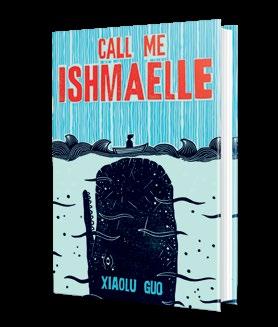

FROM THE EDITOR’S DESK
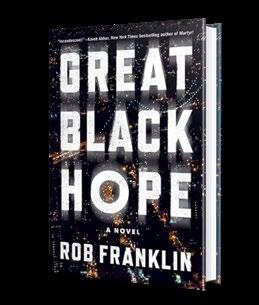
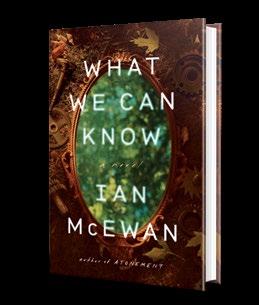
IT SEEMS LIKE just yesterday we were unveiling our Spring 2025 Preview and compiling lists of all the books we were excited to crack open in the year to come. Now the year is drawing to a close, and it’s time to look in the rearview mirror at those titles that really lived up to the hype, along with some terrific reads we didn’t see coming. Yes, it’s time for our Best Books of 2025 coverage. Pull up a chair, because we have a lot of books to talk about: 600, to be exact. The party kicks off in this issue with adult fiction (p. 5) and nonfiction (p. 55). Editors Laurie Muchnick and John McMurtrie offer introductions to both lists, and then we hear from some of the authors whose works made the cut; look
for Q&As with novelist Charlotte McConaghy (Wild Dark Shore), literary historian Stephen Greenblatt (Dark Renaissance), and food writer Betty Fussell (How To Cook a Coyote), among others. This year, the issue also features some of the many online sublists derived from our master lists, including the Best Historical Fiction of 2025, Best Translated Fiction of 2025, and Best Biographies of 2025.
And we’re just getting started. Coming in the December 1 issue are lists of the best children’s books (picture books and middle grade) and young adult books, along with more author Q&As and sublists, plus a holiday gift guide with over 200 suggestions for every kind of reader,
Frequently Asked Questions: www.kirkusreviews.com/about/faq
Fully Booked Podcast: www.kirkusreviews.com/podcast/
Advertising Opportunities: www.kirkusreviews.com/book-marketing
Submission Guidelines: www.kirkusreviews.com/about/publisher-submission-guidelines
Subscriptions: www.kirkusreviews.com/magazine/subscription
Newsletters: www.kirkusreviews.com
For customer service or subscription questions, please call 1-800-316-9361

young and old, in your life. Then, on December 15, we put a bow on the year with a roundup of the 100 best Indie books we reviewed and reconsiderations of book-to-screen adaptations, audiobooks, book news, and the authors we lost.
I’d be remiss if I didn’t point you toward some favorites from my own reading over the past 12 months. Rob Franklin’s Great Black Hope (Summit, June 10) is the kind of debut novel you dream of stumbling upon: a gripping narrative relayed in a voice whose confidence entrances you from the very first page. This story of a privileged young Black man and the recreational drug purchase that puts his life in a tailspin has stayed with me all year; I’m eager to see what this author does next.
Unlike Franklin, Ian McEwan is a veteran fiction writer with 20 books (and one Booker Prize) to his name. But the verve of his latest, What We
Can Know (Doubleday, September 23) is undimmed—in fact, it may be his best book in years. At once a literary treasure hunt, a dystopian cli-fi tale, and a meditation on historical memory, it’s also an indisputable page-turner. Finally, as a longtime fan of Arundhati Roy’s fiction, I reveled in her powerful memoir Mother Mary Comes to Me (Scribner, September 2), a Kirkus Prize finalist earlier this year. A writer’s life story isn’t always inherently interesting, but Roy’s larger-than-life mother and history of political activism, presented with a novelist’s flair, are mesmerizing.
We hope you’ll stay for the entire party, then raise a glass with us to the promising titles headed our way in 2026. Cheers!

Co-Chairman
HERBERT SIMON
Interim Publisher & CEO
JUDY HOTTENSEN jhottensen@kirkus.com
Chief Marketing Officer
SARAH KALINA skalina@kirkus.com
Publisher Advertising & Promotions
RACHEL WEASE rwease@kirkus.com
Indie Advertising & Promotions
AMY BAIRD abaird@kirkus.com
Author Consultant
KEELIN FERDINANDSEN kferdinandsen@kirkus.com
Lead Designer KY NOVAK knovak@kirkus.com
Magazine Compositor
NIKKI RICHARDSON nrichardson@kirkus.com
Director of Kirkus Editorial ROBIN O’DELL rodell@kirkus.com
Kirkus Editorial Senior Production Editor
MARINNA CASTILLEJA mcastilleja@kirkus.com
Kirkus Editorial Production Editor
ASHLEY LITTLE alittle@kirkus.com
Copy Editors
ELIZABETH J. ASBORNO
JAIMIE KANWAR
NANCY MANDEL
BILL SIEVER
Mysteries Editor
THOMAS LEITCH
Co-Chairman
MARC WINKELMAN
Editor-in-Chief TOM BEER tbeer@kirkus.com
President of Kirkus Indie
CHAYA SCHECHNER cschechner@kirkus.com
Fiction Editor
LAURIE MUCHNICK lmuchnick@kirkus.com
Nonfiction Editor
JOHN McMURTRIE jmcmurtrie@kirkus.com
Young Readers’ Editor
LAURA SIMEON lsimeon@kirkus.com
Young Readers’ Editor
MAHNAZ DAR mdar@kirkus.com
Editor at Large
MEGAN LABRISE mlabrise@kirkus.com
Senior Indie Editor
DAVID RAPP drapp@kirkus.com
Indie Editor
ARTHUR SMITH asmith@kirkus.com
Senior Editorial Assistant NINA PALATTELLA npalattella@kirkus.com
Senior Indie Editorial Assistant
DAN NOLAN dnolan@kirkus.com
Indie Editorial Assistant
KATARINA YERGER kyerger@kirkus.com
Contributing Writers
GREGORY McNAMEE
MICHAEL SCHAUB

Contributors
Nada Abdelrahim, Colleen Abel, Jill Adams, Erin Addis, Mahasin Aleem, Paul Allen, Jenny Arch, Kent Armstrong, Mark Athitakis, Audrey Barbakoff, Carole Bell, Emma Benavides, Nell Beram, Elizabeth Bird, Christopher A. Biss-Brown, Sarah Blackman, Jessica Hoptay Brown, Cliff Burke, Abby Bussen, Ana Cackley, Kevin Canfield, Hailey Carrell, Tobias Carroll, Charles Cassady, Carin Clevidence, Emma Corngold, Jeannie Coutant, Katherine Daly, Cathy DeCampli, Dave DeChristopher, Kathleen Deedy, Elise DeGuiseppi, Suji DeHart, Lisa Dennis, Steve Donoghue, Anna Drake, Eamon Drumm, Lisa Elliott, Joshua Farrington, Margherita Ferrante, Katie Flanagan, Catherine Foster, Mia Franz, Jenna Friebel, Robbin Friedman, Emily Gaines, Laurel Gardner, Jean Gazis, Amanda Gefter, Danielle Galván Gomez, Vicky Gudelot, Sean Hammer, Silvia Lin Hanick, Loren Hinton, Ashley Holloway, Natalia Holtzman, Terry Hong, Julie Hubble, Kerri Jarema, Jessica Jernigan, Betsy Judkins, Jayashree Kamblé, Deborah Kaplan, Marcelle Karp, Hena Khan, Stephanie Klose, Lyneea Kmail, Andrea Kreidler, Susan Kusel, John Kynch, Megan Dowd Lambert, Christopher Lassen, Tom Lavoie, Seth Lerer, Coeur de Lion, Sarah Lohmann, Barbara London, Patricia Lothrop, Kyle Lukoff, Dylan Mabe, Thomas Maluck, Michelle H Martin, J. Alejandro Mazariegos, Kirby McCurtis, Courtney McDermott, Jeanne McDermott, Kathleen McLaughlin, Don McLeese, Cari Meister, J. Elizabeth Mills, Chintan Modi, Clayton Moore, Andrea Moran, Rhett Morgan, Jennifer Nabers, Christopher Navratil, Therese Purcell Nielsen, Ari Nussbaum, Erin O’Brien, Tori Ann Ogawa, Mike Oppenheim, Emilia Packard, Andrea Page, Megan K. Palmer, Sarah Parker-Lee, George Pate, Hal Patnott, Bethanne Patrick, Deb Paulson, Tara Peck, Alea Perez, Rebecca Perry, John Edward Peters, Jim Piechota, Christofer Pierson, William E. Pike, Margaret Quamme, Carolyn Quimby, Kristy Raffensberger, Kristen Rasmussen, Jasmine Riel, Alyssa Rivera, Erica Rivera, Oisin Rowe, Soumi Roy, Lloyd Sachs, Bob Sanchez, Caitlin Savage, Jerome Shea, Madeline Shellhouse, Leah Silvieus, Linda Simon, Julia Sirmons, Wendy Smith, Andria Spencer, Allison Staley, Sydney Stensland, Allie Stevens, Mathangi Subramanian, Jennifer Sweeney, Deborah Taylor, Desiree Thomas, Bill Thompson, Renee Ting, David L. Ulin, Katie Vermilyea, Barbara Ward, Caroline Ward, Katie Weeks, Audrey Weinbrecht, Vanessa Willoughby, Kerry Winfrey, Marion Winik, Adam Winograd

ISBN 978-1-958861-63-9 [hardcover]
ISBN 978-1-958861-60-8 [paperback]

“Probing the dark underbelly of sports to solve his case, ex-NBA player Elgin O’Brien could well be the bastard child of Chinatown’s Jake Gittes, located to the wilds of Hoboken.”
— Brin-Jonathan Butler, Author of The Domino Diaries
“Some books are destined for more than just making the “best of” lists. While on a quest for his own Maltese Falcon, O’Brien is a detective you won’t soon forget.”
— John M. Gilonna, Author of Outback Nevada
“Although the book is set in the present...the style and tropes of the story vividly recall the fast-paced adventures of decades-old detective stories....An engaging whodunit with a hero with a sharp tongue and a sharper mind.”
— Kirkus Reviews
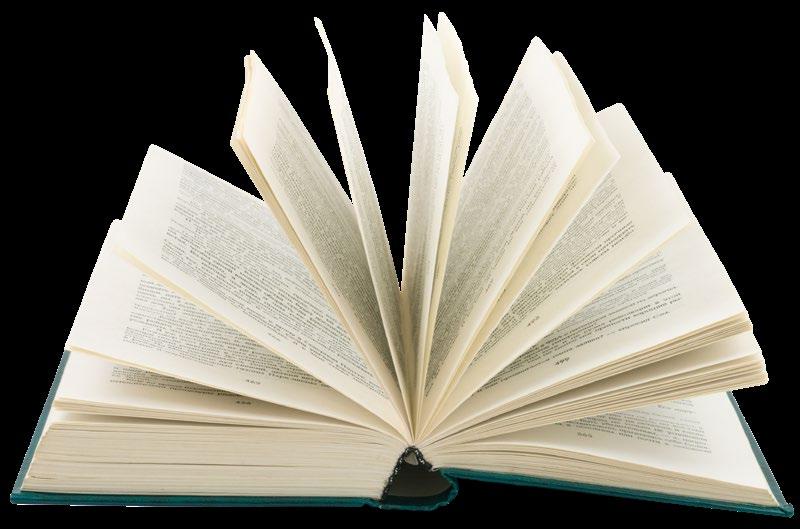
Our favorite fiction this year ranges widely in every way. There’s a story about robots operating a restaurant in near-future California, a novel narrated by a wax child in 16th-century Denmark, and the tale of two brothers living off the grid near Yellowstone. From a boxing gym to a luxury hotel to the depths of hell, these books will take you on fantastic journeys.
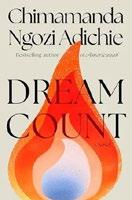
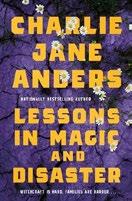
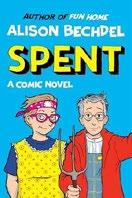
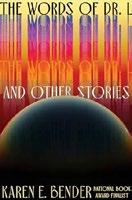

Adichie, Chimamanda Ngozi | Knopf (416 pp.) | $32 | March 4, 2025
9780593802724
Adichie weaves stories of heartbreak and travail that are timely, touching, and trenchant.
Anders, Charlie Jane | Tor (320 pp.) | $29.99 August 19, 2025 | 9781250867322
Much to ponder, much to cry over and rage against, much to appreciate.
Bechdel, Alison | Mariner Books (272 pp.)
$29.99 | May 20, 2025 | 9780063278929
Bechdel is incisive, tender, and funny—often at the same time.
Bender, Karen E. | Counterpoint (304 pp.) $27 | May 6, 2025 | 9781640095700
Highly original stories that speak to the challenges of being human in the 21st century.
Carey, M.R. | Orbit (320 pp.) | $18.99 paper | March 4, 2025 | 9780316505024
A dark and hopeful fable with obvious contemporary resonance.
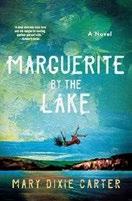

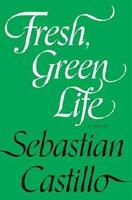
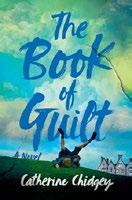
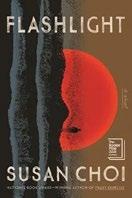
Carter, Mary Dixie | Minotaur (304 pp.)
$28 | May 20, 2025 | 9781250790385
Not to be missed, and definitely not to be imitated.
Castillo, Elaine | Viking (320 pp.) | $29 August 5, 2025 | 9780593489666
A brilliant novel with much to say about work, family, excess, identity, and love.
Castillo, Sebastian | Soft Skull Press (160 pp.) | $15.95 paper | June 24, 2025 9781593767914
Castillo navigates an emotionally fraught narrative with empathy and dry humor.
Chidgey, Catherine | Cardinal (304 pp.)
$30 | September 16, 2025 | 9781538774076
Eloquent prose, rich characterizations, and knotty concepts—an emotional and intellectual tour de force.
Choi, Susan | Farrar, Straus and Giroux (464 pp.) | $30 June 3, 2025 | 9780374616373
Never sentimental, never predictable, this aptly titled novel illuminates dark passages both fictional and real.
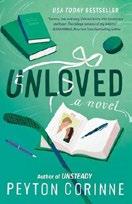
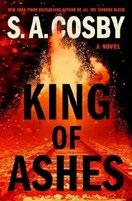

Corinne, Peyton | Atria (464 pp.) | $18.99 paper | February 4, 2025 | 9781668068489
Deeply moving and emotional.
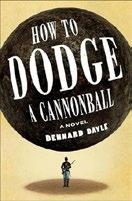
Cosby, S.A. | Flatiron Books (352 pp.)
$25.99 | June 10, 2025 | 9781250832061
Another strong outing by a modern noir master.

Curato, Mike | Algonquin (384 pp.)
$32 | June 3, 2025 | 9781643755120
A tender and compelling coming-of-age story.

Curtis, Aaron John | Zando (352 pp.)
$28 | May 6, 2025 | 9781638931454
An affecting tale of loss and healing that thrives through its seriocomic style.
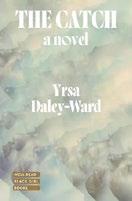
Daley-Ward, Yrsa | Liveright/ Norton (352 pp.) | $28.99 June 3, 2025 | 9781324092513
Elegant and unpredictable in the best possible way.
Dayle, Dennard | Henry Holt (336 pp.)
$28.99 | June 17, 2025 | 9781250345677
Historical burlesque as lively in invention as it is ingenious in execution.
Desai, Kiran | Hogarth (704 pp.) | $32 September 23, 2025 | 9780307700155
A masterpiece.



Fay, Constance | Bramble Books (352 pp.) | $19.99 paper | March 11, 2025 9781250330437
A wildly entertaining space adventure explores the nature of love and humanity.
Flores, Fernando A. | MCD/Farrar, Straus and Giroux (352 pp.) | $28 February 11, 2025 | 9780374604165
A stunning tale of survival and a biting critique of book bans and late capitalism.
Flournoy, Angela | Mariner Books (304 pp.)
$30 | September 16, 2025 | 9780063318779
Elegant and unsettling, this novel evades the expected at every turn.

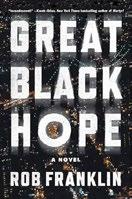
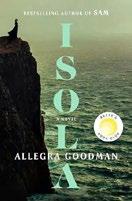


Ford, R.S. | Orbit (576 pp.) | $19.99 paper June 17, 2025 | 9780316629638
Nonstop action, intricate plotlines, deeply developed characters, top-notch worldbuilding—a must-read for epic fantasy fans.
Franklin, Rob | Summit (320 pp.) | $26.96 June 10, 2025 | 9781668077436
A captivating novel of dissolution and redemption.
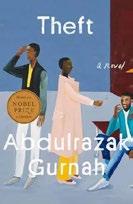

Goodman, Allegra | Dial Press (400 pp.) | $28.99 | February 4, 2025 9780593730089
Goodman’s sweeping page-turner is at once historical and modern, intimate and epic, personal and powerful.
Grade, Chaim | Trans. by Rose Waldman Knopf (704 pp.) | $35 | March 25, 2025 9780394536460
A great Yiddish novelist’s grimly foreboding and fiercely alive final work.
Gregory, Daryl | Saga/Simon & Schuster (464 pp.) | $29.99 | April 1, 2025 9781668060049
Big-hearted, generous, and beautifully written.
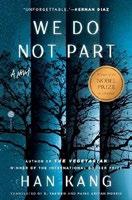
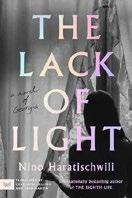
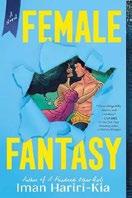
Gurnah, Abdulrazak | Riverhead (304 pp.) $30 | March 18, 2025 | 9780593852606
A tightly constructed family drama with surprising complications.
Hall, Rachel Howzell | Thomas & Mercer (395 pp.) | $28.99 | May 13, 2025 9781662522840
This captivating blend of angst, mystery, and page-turning suspense delivers a top-notch reading experience.
Han Kang | Trans. by e. yaewon & Paige Aniyah Morris | Hogarth (272 pp.) | $28 January 21, 2025 | 9780593595459
A mysterious novel about history and friendship offers no easy answers.
Haratischwili, Nino | Trans. by Charlotte Collins & Ruth Martin | HarperVia (736 pp.) $29.99 paper | September 9, 2025 9780063253612
A thrilling, heartbreaking, unforgettable story. Not a page too long.
Hariri-Kia, Iman | Cosmo Reads (400 pp.) $18.99 paper | October 14, 2025 9781728270647
A playful romp and ode to all who believe in true love and happily-ever-afters.

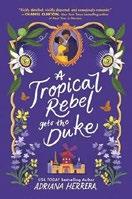

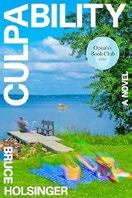
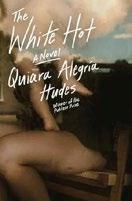
Haynes, David | McSweeney’s (324 pp.)
$26 | September 9, 2025 | 9781963270273
Haynes’ first collection of stories is a treasure trove of warmth, smarts, and wisdom.
Herrera, Adriana | Canary Street Press (432 pp.) | $18.99 paper | February 4, 2025
9781335476968 | Series: Leonas, 3
An extraordinary finale to a series that deserves to be esteemed as among the best in the genre.
Herron, Mick | Soho Crime (352 pp.)
$29.95 | September 9, 2025
9781641297264 | Series: Slough House, 9
The best news of all: The climax leaves the door open to further reports from the hilariously misnamed British Intelligence.
Holsinger, Bruce | Spiegel & Grau (380 pp.)
$30 | July 8, 2025 | 9781954118966
If you are not already hooked on Holsinger, it’s time to join the club.
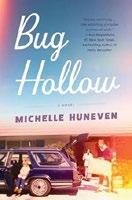
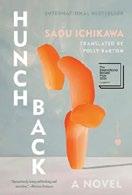

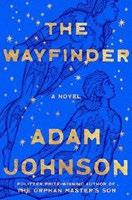
Hudes, Quiara Alegría | One World/ Random House (176 pp.) | $26 November 11, 2025 | 9780593732335
This staggering gut punch of a novel shows that sometimes love looks like leaving.
Huneven, Michelle | Penguin Press (288 pp.) | $29 | June 17, 2025
9780593834879
A deeply satisfying novel; Huneven’s best work to date.
Ichikawa, Saou | Trans. by Polly Barton Hogarth (112 pp.) | $22 | March 18, 2025 9780593734711
Audacious, insightful, bold, and—with its critique of ableism—necessary.
Jalaluddin, Uzma | Harper Perennial/ HarperCollins (336 pp.) | $17.99 paper May 6, 2025 | 9780063434875
Who could resist “Jack Reacher in a dupatta”?
Johnson, Adam | MCD/Farrar, Straus and Giroux (768 pp.) | $30
October 14, 2025 | 9780374619572
A book stuffed with revelations while keeping many secrets.

Jones, Stephen Graham | Saga/ Simon & Schuster (448 pp.) | $26.99
March 18, 2025 | 9781668075081
A weirdly satisfying and bloody reckoning with some of America’s most shameful history.
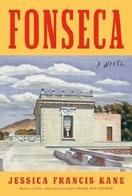
Kane, Jessica Francis | Penguin Press (272 pp.) | $28 | August 12, 2025
9780593298855
A finely turned novel that evokes its subject’s gift for slyly biting domestic tales.

Kehlmann, Daniel | Trans. by Ross
Benjamin | Summit (352 pp.) | $25.99
May 6, 2025 | 9781668087794
A wickedly entertaining, eye-opening book.
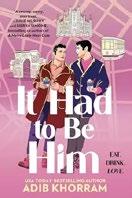
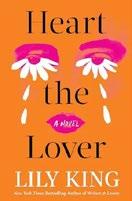

It
Khorram, Adib | Forever (384 pp.)
$17.99 paper | September 2, 2025
9781538739556
A pleasure-filled, wholeheartedly sincere second-chance romance.
King, Lily | Grove (256 pp.) | $28
October 7, 2025 | 9780802165176
That college love affair you never got over? Come wallow in this gorgeous version of it.
Kitamura, Katie | Riverhead (208 pp.)
$28 | April 8, 2025 | 9780593852323
In this searing, chilly, and psychologically profound story lies insight into some harrowing human questions.
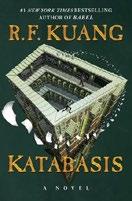

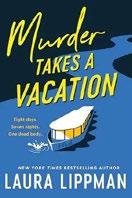

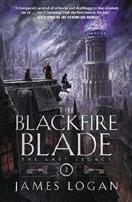
Kuang, R.F. | Harper Voyager (560 pp.)
$35 | August 26, 2025 | 9780063021471
A learned, literary manifesto on academia—and its darkness.
Lalami, Laila | Pantheon (336 pp.) | $28
March 4, 2025 | 9780593317600
An engrossing and troubling dystopian tale.
Lippman, Laura | Morrow/ HarperCollins (272 pp.) | $27
June 17, 2025 | 9780062998101
Another gem from Lippman, with a heroine who elevates being ordinary to an art form.
Lockwood, Patricia | Riverhead (256 pp.)
$29 | September 23, 2025 | 9780593718551
There is only one Patricia Lockwood, and this surreal, silly, and sneakily profound book could only be hers.
Logan, James | Tor (496 pp.)
$19.99 paper | November 4, 2025
9781250350657 | Series: Last Legacy, 2
A stay-up-all-night-until-your-eyesbleed kind of read—a virtually unputdownable adventure fantasy.


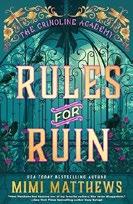
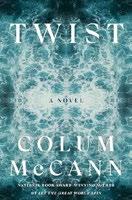
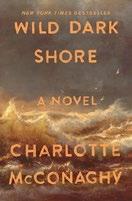
MacLean, Sarah | Ballantine (400 pp.)
$30 | July 8, 2025 | 9780593972250
A compelling story about grief, sex, and money, but also the power of family and forgiveness.
Majumdar, Megha | Knopf (224 pp.) | $29 October 14, 2025 | 9780593804872
This electrifying depiction of dignity and morality under siege reveals the horror hidden by the bland term “climate change.”
Matthews, Mimi | Berkley (400 pp.) | $19 paper | May 20, 2025 | 9780593639290
Readers who like a streak of danger and politics in their romance will thrill to this whip-smart historical.
McCann, Colum | Random House (256 pp.)
$28 | March 25, 2025 | 9780593241738
Another astounding novel from a fiction master.
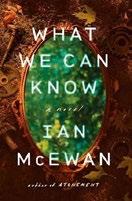
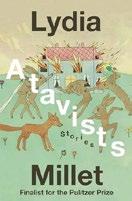


McConaghy, Charlotte | Flatiron Books (320 pp.) | $28.99 | March 4, 2025 9781250827951
Readers won’t want to leave behind the imagined world of pain and beauty that McConaghy has conjured.
McEwan, Ian | Knopf (320 pp.) | $27 September 23, 2025 | 9780593804728
A philosophically charged tour de force by one of the best living novelists in English.
Millet, Lydia | Norton (256 pp.) | $27.99 April 22, 2025 | 9781324074410
Sharply observed, beautifully rendered, and heartbreaking.
Moore, Carrie R. | Tin House (336 pp.) | $17.99 paper
July 15, 2025 | 9781963108286
A regional relief map of the human heart.
Moreno-Garcia, Silvia | Del Rey (368 pp.) $29 | July 15, 2025 | 9780593874325
Suspenseful and terrifying; Moreno-Garcia hits it out of the park yet again.
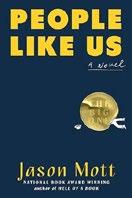
Mott, Jason | Dutton (288 pp.) | $30 August 5, 2025 | 9798217047116
A meta-novel that stings and touches the reader.
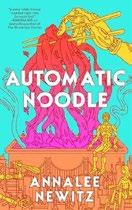


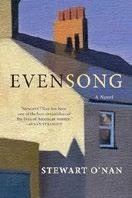
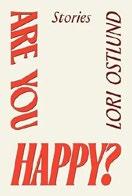
Newitz, Annalee | Tordotcom (160 pp.)
$21.99 | August 5, 2025 | 9781250357465
Effectively both heartwarming and pointed.

Newman, Catherine | Harper/ HarperCollins (224 pp.) | $26.99
October 28, 2025 | 9780063453913
A heartbreaking, laugh-provoking, and absolutely Ephron-esque look at the beauty and fragility of everyday life.
Nishizawa, Yasuhiko | Trans. by Jesse Kirkwood | Pushkin Vertigo (288 pp.)
$16.95 paper | July 29, 2025
9781805335436
A fresh and clever whodunit with an engaging twist.
O’Nan, Stewart | Atlantic Monthly (304 pp.)
$28 | November 11, 2025 | 9780802166432
Unsentimental yet deeply moving: more wonderful work from the versatile, masterful O’Nan.
Ostlund, Lori | Astra House (272 pp.)
$26 | May 6, 2025 | 9781662603020
Ostlund proves herself a master of the form.

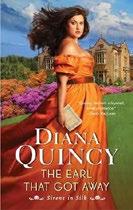
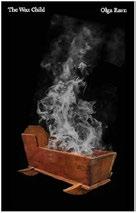

Purvis, Xenobe | Henry Holt (240 pp.)
$26.99 | August 5, 2025 | 9781250366382
Purvis’ suspenseful and sure-footed debut breathes vivid life into its arresting concept.
Qin, Emily Yu-Xuan | DAW (432 pp.) | $29 March 18, 2025 | 9780756419387
Astonishing, brutal, and beautifully constructed, with a powerful emotional punch; an exceptionally accomplished debut.
Quincy, Diana | Avon/Harper Collins (352 pp.) | $9.99 paper
September 30, 2025 | 9780063247567
Series: Sirens in Silk, 2
A multicultural Victorian romance that celebrates second chances and family ties.
Ravn, Olga | Trans. by Martin Aitken
New Directions (144 pp.) | $19.95 paper September 2, 2025 | 9780811238830
A magnificent book. A true masterpiece of both substance and style.
Reents, Stephanie | Hogarth (336 pp.)
$29 | August 26, 2025 | 9780593448069
A candid portrait of athletes’ endurance and women’s friendships.
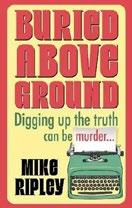


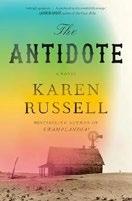
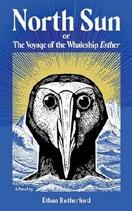
Ripley, Mike | Severn House (272 pp.)
$29.99 | September 2, 2025
9781448315611
Ripley’s best book: a wickedly funny sendup of the clichés behind all those classic mysteries and their successors.
Rosaler, Maxine | Delphinium | $27
May 13, 2025 | 9781953002556
The best short story writer you’ve never heard of.
Rosen, Ali | Montlake Romance (318 pp.) | $16.99 paper
March 1, 2025 | 9781662527920
A swoonworthy romance reminiscent of a Nora Ephron movie.


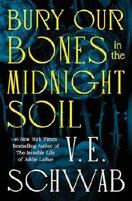
Russell, Karen | Knopf (432 pp.) | $30
March 11, 2025 | 9780593802250
A storytelling tour de force that lives up to the promise of its name.
Rutherford, Ethan | A Strange Object (386 pp.) | $17.95 paper | March 11, 2025
9781646053582
A classically styled novel that sounds a very contemporary alarm.
Ryan, Kennedy | Forever (448 pp.)
$16.19 paper | May 13, 2025
9781538706855 | Series: Skyland, 3
This captivating, deeply emotional, and incredibly sexy romance is a balm for the soul.
Schaefer, Lucas | Simon & Schuster (487 pp.) | $29.99 | June 3, 2025
9781668030707
Swings for the fences, makes it at least to third. Franzen/Roth/Irving comparisons earned and deserved.
Schwab, V.E. | Tor (544 pp.) | $26.99 June 10, 2025 | 9781250320520
A beautiful meditation on queer identity against a supernatural backdrop.
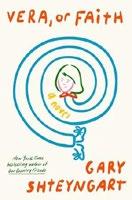
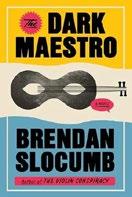
Vera, or Faith
Shteyngart, Gary | Random House (256 pp.)
$28 | July 8, 2025 | 9780593595091
Shteyngart is doing his most important work ever, illuminating the current tragedy with humor, smarts, and heart.
Slocumb, Brendan | Doubleday (416 pp.)
$28 | May 13, 2025 | 9780593687611
A virtuosic thriller.
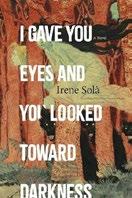

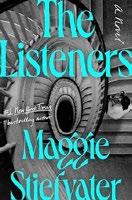


Solà, Irene | Trans. by Mara Faye
Lethem | Graywolf (176 pp.) | $17 paper
June 17, 2025 | 9781644453438
A fabulous achievement, at once sweeping and sly, raunchy and richly compelling.
Starnone, Domenico | Trans. by Oonagh
Stransky | Europa Editions (160 pp.) | $17 paper | August 19, 2025 | 9798889661306
A deceptively simple work and an exquisite addition to Starnone’s oeuvre.
Stiefvater, Maggie | Viking (400 pp.)
$30 | June 3, 2025 | 9780593655504
This luxurious novel is set to take the world by storm.
Straight, Susan | Counterpoint (352 pp.)
$28 | October 28, 2025 | 9781640097131
Straight reminds us of where we have been and where we are going without once looking away.
Sullivan, Tim | Atlantic Crime (384 pp.) | $17 paper | October 21, 2025 | 9780802167095
A multifaceted murder puzzle anchored by a compelling pair of sleuths.
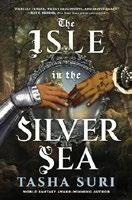
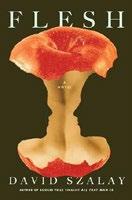
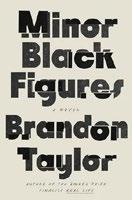
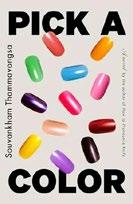
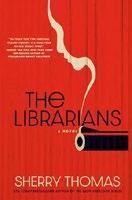
The Isle in the Silver Sea
Suri, Tasha | Orbit (512 pp.) | $30 October 21, 2025 | 9780316595087
Beautifully inevitable and surprising at the same time; dark, sharp, clever, lovely.
Szalay, David | Scribner (368 pp.)
$28.99 | April 1, 2025 | 9781982122799
An emotionally acute study of manliness.
Taylor, Brandon | Riverhead (320 pp.)
$29 | October 14, 2025 | 9780593332368
A piercing, precise, and affecting tale of young love and high art.
Thammavongsa, Souvankham
Little, Brown (208 pp.) | $28 September 30, 2025 | 9780316422147
This exceptional novel, honed sharp as cuticle nippers, contains great wit and quick turns, up to the last sentence.
Thomas, Sherry | Berkley (368 pp.) | $30 September 30, 2025 | 9780593640456
Thomas’ virtuosity shows in this fast-paced and intricate yet emotionally moving mystery.
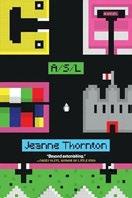
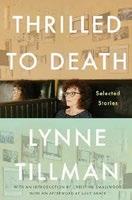
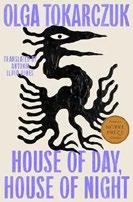


Thornton, Jeanne | Soho (496 pp.)
$27 | April 1, 2025 | 9781641296045
A dazzlingly creative and heartfelt novel.
Tillman, Lynne | Soft Skull Press (320 pp.)
$27 | March 25, 2025 | 9781593767198
A rich selection of stories spanning Tillman’s singular career.
Tokarczuk, Olga | Trans. by Antonia Lloyd-Jones | Riverhead (336 pp.) | $28 December 2, 2025 | 9780593716380
An exquisitely constructed, mercurial gem from the Nobel prizewinner.
Vasti, Alexandra | St. Martin’s Griffin (352 pp.) | $18 paper | September 23, 2025 9781250910981 | Series: Belvoir’s Library, 3
A top-notch, spooky Regency page-turner.
Vuong, Ocean | Penguin Press (416 pp.)
$27 | May 13, 2025 | 9780593831878
A sui generis take on the surprising and cruel ways violence is passed on across generations.




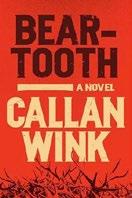
Wachman, Sam | Harper/HarperCollins (352 pp.) | $30 | August 12, 2025 9780063418226
With its luminous depiction of all that has been lost and what remains at risk, there is no better book to read right now.
Washington, Bryan | Farrar, Straus and Giroux (336 pp.) | $28 | November 4, 2025 9780374609078
A patient, powerful analysis of the dual devotion required to heal a fractured relationship.
Weiner, Cynthia | Crown (368 pp.) | $29 January 21, 2025 | 9780593798843
Carefully paced and beautifully written, this edgy coming-of-age novel succeeds on all counts.
Williams, Joy | Knopf (176 pp.) | $27 November 18, 2025 | 9780525657583
Superb, and yet more evidence that Williams should be next in line for the Nobel Prize in Literature.
Wink, Callan | Spiegel & Grau (256 pp.) $28 | February 11, 2025 | 9781954118027
A novel of impeccable control and unflinching darkness. And then a glimmer of hope.

WHEN WE AT KIRKUS think of the best fiction, we consider every kind— experimental fiction in translation, absorbing family sagas, historical romances, cozy mysteries, blockbuster fantasies, graphic novels, and so much more. As other media outlets lose space for reviews, we cast our nets as widely as possible, covering a huge range of books. Here are some that made a particular impression on me.
In Audition (Riverhead, April 8), Katie Kitamura examines the nature of storytelling itself. The
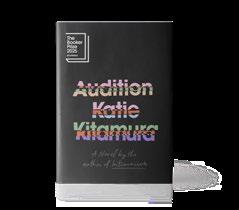
narrator is an actress having lunch with a man who believes he might be her son. Her husband walks into the restaurant and then walks out. Has he seen her? Once we think we know what’s going on here, Kitamura shakes things up, and the pieces land differently. “In this searing, chilly, and psychologically profound story lies insight into some harrowing human questions,” according to our review.
Maggie Stiefvater’s The Listeners (Viking, June 3) is a historical novel with a
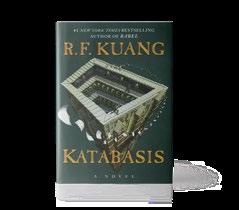


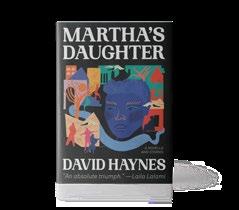
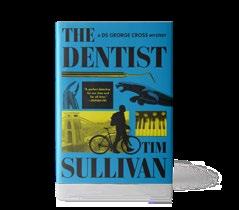
touch of the fantastical.
During World War II, the U.S. government requisitions a sumptuous West Virginia hotel to hold Japanese, German, and Italian diplomats until they can be sent home. As she introduces the staff and new residents, Stiefvater will “remind readers of why they fell in love with reading in the first place,” according to our review.
In R.F. Kuang’s Katabasis (Harper Voyager, August 26), we meet Alice Law, a graduate student in “analytic magick” at Cambridge. When her advisor dies—and it was probably her fault— she decides to travel down to Hell to bring him back. Not just because she feels bad; she really needs that letter of recommendation. “Kuang melds a fantasy adventure… with a rumination on academia’s problems to create a new take on the journey through the underworld,” according to our review.
It Had To Be Him (Forever, September 2), Adib Khorram’s latest delectable romance, follows 38-year-old Ramin Yazdani to Italy, where he’s licking his wounds after his ex broke up with him for being boring. He runs into Noah Bartlett, whom he hasn’t seen since high school. Sparks fly. Our review says,
“this bighearted tale features scorching hot yet deeply realistic sexual moments and relatable, lovable characters.” Not to mention all the food and wine you could want from a trip to Italy.
There was some excellent short fiction this year, including Martha’s Daughter (McSweeney’s, September 9), David Haynes’ first collection after having published more than a dozen novels for adults and children since 1993. Our review calls it “a treasure trove of warmth, smarts, and wisdom.”
The title of The Dentist (Atlantic Crime, October 21), the opening book of Tim Sullivan’s British mystery series, refers to the murder victim, not the detective. The latter is DS George Cross, a white man on the autism spectrum; he has a high success rate in closing cases but he’s hard to work with, and he’s been given a new partner, DS Josie Ottey, a Black single mother. “Sullivan’s series kickoff is deeply characterdriven,” according to our review, and is “anchored by a compelling pair of sleuths.” Atlantic Crime will be publishing six more books in the series between now and June.
Laurie Muchnick is the fiction editor.
Saunders’ second novel represents a magnificent expansion of consciousness. Unfolding over the course of a single evening, as oil baron K.J. Boone lies on his deathbed, the narrative develops almost entirely in the interior, while encompassing a dizzying exteriority as well. At its center are two characters, one deceased and the other soon to be. The latter, of course, is Boone, a man with much to answer for, although he doesn’t believe that. The other is Jill “Doll” Blaine, the narrator, who died young and has returned to earth from the spirit realm—as she has 343 times since her own demise—to help him make the crossing. If such concerns appear to recall
those of the author’s first novel, Lincoln in the Bardo (2017), that both is and isn’t the case. Yes, as the book progresses, it ranges widely, with a variety of ghosts and spirits emerging to comment on or participate in Boone’s final reckoning. At the same time, it’s a sparer work than its predecessor. This has to do with Jill, who moves from memories of her life to engagement with Boone. Always, she reveals empathy and insight, even as his final hours become a dark night of the soul. “No: this , this now, was me,” she tells us: “vast, unlimited in the range and delicacy of my voice, unrestrained in love, rapid in apprehension, skillful in motion, capable, equally, of traversing,
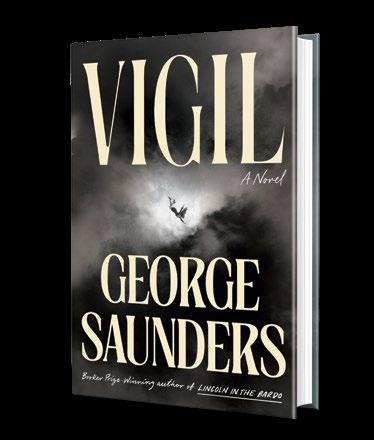
Saunders, George | Random House | 192 pp. $28 | January 27, 2026 | 9780525509622
within a few seconds’ time, a mile or ten thousand miles.” What she (or, through her, Saunders) is suggesting is the need for generosity, despite, or perhaps because of, Boone’s corrupted soul, which has been riven by a lifetime wallowing in many of the deadly sins, particularly pride and
greed. Such openness has long been a hallmark of Saunders’ fiction, and it’s on full display in this elegant and subtle book. “At such moments,” Jill reflects, “I especially cherished my task. I could comfort.” Saunders has crafted a novel that feels deeply resonant, especially in these fractious times.
EVERYBODY WANTS TO RULE THE WORLD
Kirkus Star
Ahmad, Senaa | Henry Holt (240 pp.)
$17.99 paper | January 13, 2026
9781250378477
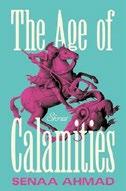
The past comes to unexpected, vivid life in these speculative short stories.
History repeats itself, goes the famous saying by Karl Marx, first as tragedy, then as farce. If that’s true, then the characters in these off-kilter, even madcap, pieces of historical fiction, caught in the strange loops and eddies of speculative time, may have passed beyond both tragedy and farce into an altogether unnamable place. In the showstopping opening story, Anne Boleyn, à la Groundhog Day, comes back to life after every attempted assassination by Henry VIII (“Let’s Play Dead”). Joan of Arc repeatedly inhabits the sleeping body of housekeeper Claribel in 1926, Joan bent on revenge and Claribel on annihilation after a series of losses leaves her hollowed out (“Our Lady of Resplendent Misfortune”). In the grimly playful finale, readers take a young female scientist working closely with J. Robert Oppenheimer on the Manhattan Project through choices like “To approach the oversized lungs, turn to…” in a surreal choose-yourown-adventure story (“Choose Your Own Apocalypse”). If all this sounds rather bonkers, it is. Ahmad swings for the fences by taking unusual premises— what if many Napoleons rented a house together? What if Nellie Bly met Julius Caesar?—and drives into left field with surreal and speculative plot turns, like talking crows or werewolves
that turn into men on the full moon. Doubling down on this weirdness can feel like a hall of mirrors—just as readers settle into a story’s reality, they bump into more illusions. But more often than this effect frustrates, it enchants, and it helps that Ahmad is exceptional at the sentence level: “The heat of July has the wrath of an old god,” reads one description of a New York City summer; thistle grows “in vengeful bursts around the yard.”
A debut teeming with strange delights.
Atkins, Ace | Morrow/HarperCollins (368 pp.) $30 | December 2, 2025 | 9780063293441

Atkins, who experimented in Don’t Let the Devil Ride (2024) with grafting an international thriller onto a regional crime story, goes full tilt this time without ever betraying his roots.
Whether or not it’s true, as men’s magazine writer Dennis X. Hotchner’s agent has ruled, that “that old hard-boiled Mickey Spillane stuff is dead,” 1985 may just usher in a new period for the genre. Some time after deputy director Vitaly Yurchenko of the KGB’s First Directorate defects to the U.S., high school freshman Peter Bennett becomes convinced that Gary Powers, the bodybuilder who’s become the latest of the many men to share Connie Bennett’s bed, is actually a Russian spy who’s bent on hurting his mother and his homeland. Naturally, the Atlanta police pay no attention to Peter, but he does manage to attract the attention of Hotch, whose dreamy plans
are backed up by the force majeure of Jackie Demure, a drag queen who once played defensive end for the Falcons. Meanwhile, federal agent Daniel J. Rafferty is sucked into lap dancer Trinity Velvet’s life when she shoots Larry, the ex who’s stalking her, with Rafferty’s gun, and KGB assassin Lisica, aka the White Fox, kills her asset Jennifer Buckner, a secretary and friend of Connie’s at Scientific Atlanta. Jenny’s purse doesn’t contain a crucial computer disk everyone’s looking for, but it does contain the business card of Sylvia Weaver, of the Atlanta FBI’s counterintelligence squad. Throughout the densely plotted complications that follow as these plot strands crisscross and tangle, Atkins never loses his sharp focus on troubled or wacky individual characters far more important than geopolitical struggles. International intrigue in a series of amusing, arresting closeups.
Austin, Emily | Atria (304 pp.) | $28 January 13, 2026 | 9781668200230
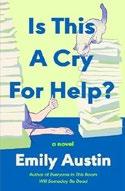
A librarian struggles under the weight of both personal tragedy and public controversy. It’s Darcy’s first day back at the local public library following a two-month mental health leave, and she steps directly into the line of fire as a patron complains about a man watching porn on one of the computers. The controversy escalates when right-wing journalist Declan Turner gets the library in his sights, launching complaints about a liberal agenda. On top of that, Darcy’s wife, Joy, is leaving to help her sister with her newborn daughter, a cat named Kyle shows up at the library looking for a home, a persistent patron keeps emailing Darcy with oddly specific questions about birds, and Darcy inadvertently leaks her own nude picture on social media. On top of that, she’s still dealing with lingering guilt over the death of her ex-boyfriend, Ben, the
discovery of which sent her spiraling into her breakdown two months ago. Darcy’s first-person narration shines in its calm, logical tone, almost detached, no matter what new crisis befalls her. On finding out that her niece was born missing her middle and ring fingers, her response is: “That’s good, I think. She can’t flip people off with her left hand, but she can just use her right hand for that.” The library’s mission to provide unrestricted access to diverse materials is central to the novel, as Darcy and her coworkers fight to represent all information. Though readers with Darcy’s logical powers may have to suspend disbelief at all these events happening at once, the payoff is a number of thoughtful, incrementally impactful revelations that show Darcy’s personal growth, from believing that “I used to be someone different. Around age twenty-three, I split in two like a cell,” to acknowledging that “there is this heaviness to aging. Who I am was built on the shoulders of the person I was last year, and the year before, and before, and before. I’m not just thirty-three; I’m twenty-seven. I’m eighteen. I’m nine. I was just born. And I have to carry all of those versions of myself…everywhere I go.”
An introspective look at difference, trauma, and identity against the backdrop of a local library.
Battles, Brett | Putnam (368 pp.) | $30 December 2, 2025 | 9780593854747

A nothingburger tussle between two women at a Palm Springs birthday party lands one of them in hot water when she’s suspected of killing the other and dumping her body in lukewarm water.
The victim, wannabe actress Katy Lane, hadn’t even been invited to Hollywood legend Damian Leon’s 70th birthday party. She only showed up in the eternal hope of attracting the attention of some movers and shakers.
And she’s spotted early on by Ronan Davis, the ex-boyfriend who, as Damian’s personal assistant, has been in charge of party arrangements. But Ronan softens and lets her stay, leaving Katy free to push Ronan’s friend Emma Perez, head engineer at Richards Renewable Energy, into Damian’s pool (all right, the two women end up in the pool together). The next day, Katy is found floating in the pool, the victim of a lethal dose of knockout drugs administered offsite by an agent of Belarusian general-turned-oligarch Victor Popov, who’s been sniffing around RRE looking for a way to buy into renewable energy tech at way under market value—without alerting any potential witnesses like Katy. Popov has already leaned heavily on Martin Lundstrom, a second-rate RRE engineer who’s so convinced that he should’ve gotten Emma’s job that he’s more than happy to hurt her. And Capt. Warner Wilson, the publicity-hungry cop in charge of the investigation, dreams of headlines that would link him to A-list Hollywood figures invited to Damian’s birthday party, a beautiful corpse, and a slam-dunk conviction if only he can dig up evidence against Emma. Luckily, Billy Barnett, formerly Teddy Fay of the CIA, is on hand to throw one more monkey wrench into all these not very well-laid plans.
As efficiently engineered as a toy train, though the franchise regulars have precious little to do.
Cornwell, Bernard | Harper/HarperCollins (368 pp.) | $32 | December 2, 2025 9780063219434

Series hero
Richard Sharpe fights in Britain’s 1813 invasion of southern France. Major Sharpe is a fictional rifleman who has risen from the ranks and gained the respect of his commanding generals, even when he disobeys
them. A brutal and intelligent fighter, he is an expert at “slaughtering Crapauds.” Indeed, his clothes and boots come from dead French soldiers. To cross into France from Portugal, British engineers must construct a pontoon bridge across the River Nive without alerting the enemy, and Sharpe is ordered to eliminate the picquets, or sentries, on the other side—and “get to the guns and butcher the bastards.” Lord Wellington also brings in the British Navy, building up to the climactic clash that becomes known as the Battle of Saint-Pierre, said to be one of the most brutal of the war. And Sharpe is in the thick of the maelstrom, hacking away with gusto at the blue-coated columns even while one of the two British commanders orders his troops to retreat. That is Sir Nathaniel Peacock, a real historical lieutenant colonel described as a mountebank, a popinjay, and a poltroon. He is the antithesis of men who rise by merit, and his cowardice could lead to defeat by the forces of French Marshal Soult. But there is a lot to be afraid of, with thousands of men meeting their maker in mists of blood and screaming for their mothers. And Major Richard Sharpe? He is in his element, doing “the one thing he knew he was good at.” In fact, he dreads the prospect of eventual peace and a return to civilian life with his wife, Jane, having no skills that won’t land him in prison or the gallows. But he needn’t worry about peace any time soon, because Waterloo awaits. This 24th Sharpe yarn captures a down-and-dirty view of the Napoleonic Wars.
Gripping historical adventure, not for the faint of heart.

Kirkus Star
Costa, Sheldon | Quirk Books (336 pp.)
$18.99 paper | November 4, 2025
9781683695059

A shy young man joins his eccentric uncle on a wild hunt to kill a dragon and raise the dead.
Tussling with the unknown always comes with inescapable risks, but men generally only find madness and heartache when they start looking for meaning in an impossible universe. Gentler than Melville but less redemptive than Coelho’s magnum opus, The Alchemist (1993), this unpredictable adventure novel offers a heady reflection on science, faith, and the necessity of myth. Sampson “Gentle” Montgomery is a man in profound grief, soothed only by heroic doses of “Sweet Vitriol,” a potent combination of opium and laudanum. His best friend and scientific partner, Liam O’Kelly, is dead, killed by a gargantuan alabaster salamander terrorizing the Pacific Northwest circa the 1890s. Gentle is convinced that he can use his partner’s knowledge of alchemy, combined with the beast’s blood, to resurrect Liam from the grave. But a hunting trip takes money, a problem soon solved when Gentle’s runaway nephew, Kitt, shows up at his door, fleeing habitual abuse from his father, Gentle’s cruel brother, Emmanuel. Together, they head into the frontiers of Washington State, armed only with a copy of Liam’s alchemical spellbook, but they’re not alone. Before long, they’ve run afoul of a hypermasculine hunter named Hercules Belmont and a maniacal frontier warlord, Reverend Judge Malcolm Crane, not to mention a nihilist death cult, infected by apocalyptic visions generated by the animal they’ve dubbed “Leviathan.” Costa’s debut uses familiar building blocks, from the inherent quest for an impossible creature to the frontier violence that works so memorably in Stephen Graham Jones’ The Buffalo
Hunter Hunter (2025). Whether Gentle is a visionary or a drunk, whether the salamander is a creature of flesh or a shared delusion, and ultimately, the meaning of the mission is as much about human frailty and grace as the nightmares that stalk the page.
A sweet, thrilling fable about the toll of grief and what it takes to fill a monster-sized hole.
Dave, Laura | Scribner (288 pp.) | $29 January 6, 2026 | 9781668002964
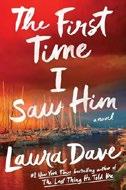
In this sequel to The Last Thing He Told Me (2021), Hannah Hall may be reunited with her missing husband—that is, if they can make a deal with the crime syndicate trying to kill him.
Beginning with a repeat of the last scene from The Last Thing He Told Me, the novel opens five years after Owen left, and Hannah and her stepdaughter, Bailey, learned of his secret life. After all this time, Owen brushes past the two at an L.A. design fair where Hannah is exhibiting. Later, Hannah discovers that Owen has slipped a flash drive into her pocket with encoded messages in the form of family photos, and the next day, suspicious men are lurking outside her house. Much has changed in the ensuing years—mob lawyer Nicholas Bell, Bailey’s maternal grandfather and the threatening presence of the first novel, has become the person Hannah and Bailey most deeply trust. Mother and daughter have also developed impressive black ops skills that enable them to stay one step ahead of the organization— Nicholas’ former clients—that’s trying to kill Owen through them. When they discover Nicholas has died and his protection has lapsed, Hannah and Bailey run, using the secret cars, cash, and safe houses they pre-arranged just for this possibility. There’s plenty of suspense as the two women race up the California coast and jet to Paris, all
based on the clues Owen has left for them. Equally satisfying are the flashbacks of Nicholas and his conflicted friendship with mob boss Frank Pointe, and of Owen’s last five years spent making surprising alliances and hatching the plot that is finally coming to fruition, as Hannah and Bailey make it to France, where Owen will be reunited with his family—or die trying. An essential sequel that ties up loose threads while providing a thrilling ride across continents.
Davis, Davey | Catapult (304 pp.) | $17.95 paper | December 2, 2025 | 9781646222834
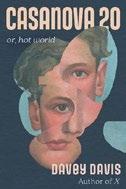
Two friends face their own erasure in this postpandemic meditation on love, sex, and mortality. Since earliest childhood, Adrian has been desired with a fervor that approaches religious ecstasy. Though his beauty imperils him as a child, Adrian grows out of the cloistered life his fearful family has provided for him and moves to New York City, where he parlays it —his term for his enduring sex appeal—into a life of feckless comfort sponsored by literally thousands of friends. Adrian’s desirability only grows in power through his 20s, and he rides out the city’s Covid-19 isolation fully expecting to be able to return to a life where he “can be in love with anyone” as soon as a vaccine is available. Yet, when the masks come off, Adrian discovers that the previously unflagging power of it has waned, or at least become less universal in its appeal. To his horror, Adrian decides that, like other people, he may be “just as anonymous with his mask on as without.”
Meanwhile, Mark, a renowned painter and one of Adrian’s very few real friends, has weathered the pandemic shutdown in his childhood home in Northern California, attending to both his mother
and then his sister as they succumb to a brutal autoimmune condition with which Mark has also been diagnosed. Thirty years older than Adrian and still grieving the loss of his husband, Arturo, Mark is immune to it, and the feelings he has toward Adrian are protective rather than proprietary. However, as Mark’s condition worsens and Adrian’s it continues to wane, both men must find the answer to the questions they ask as their worlds inexorably alter (am I memorable? can I be seen?) in the light of the other’s enduring care. The novel’s conceit is big, its prose attention-grabbing, its sexual joie de vivre propulsive, but, in the end, the most compelling part is the tender nuance of its central characters as they love both each other and the world. The result is a rare gem of a book—afraid of neither joy nor sorrow and patient enough to find the human heart inside all its gorgeous language.
A show-stopping novel that carries within it a quiet, steadfast heart.
Old Fire
Dusapin, Elisa Shua | Trans. by Aneesa Abbas Higgins | Summit/Simon & Schuster (192 pp.) | $27 | January 13, 2026 9781668212219
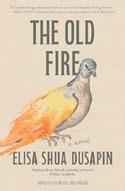
A writer returns to rural France and, with her silent sister, must empty the family home before it’s knocked down.
Agathe is a screenwriter living in New York. Her most recent film won a prize at an Italian film festival, and that success landed her a job adapting a George Perec novel, W, or The Memory of Childhood. Agathe was just 15 when she moved to the U.S. permanently; now 30, she’s called to France by her sister, Véra, who asks for help clearing out their family estate, finally being sold—to a company that plans to destroy it—after their father’s death five years ago. Settled into the crumbling building for nine days with Véra, who
A delicate and elegant novel that asks what we owe the ones we love.
THE OLD FIRE
has been aphasic since childhood, Agathe is unsettled by everything around her, from the ants in the house, to the absence of people in the village. Hunters roam the forest surrounding the estate, being dangerously inattentive to the sisters’ presence. Agathe is haunted by the complicated life she left behind in New York—a partner and their attempts to start a family—as well as by the past that surrounds her in France. As the sisters sort through a lifetime of their family’s belongings, Agathe feels oppressed by the weight of her memories and the question of whether she’s left Véra without the protector and companion Agathe once was for her younger sister. Dusapin is a writer gifted in atmosphere; every image in this slim novel oozes with portent and symbolic weight, from the caves in which the sisters played as children to the novel that Agathe adapts. The translation from French by Higgins reflects the prose’s broody lyricism. A delicate and elegant novel that asks what we owe the ones we love.
Grippando, James | Harper/HarperCollins (352 pp.) | $30 | January 6, 2026 9780063358119

Miami lawyer Jack Swyteck’s latest client refuses to take the Fifth despite the advice of his counsel—and then takes it to a perilous extreme.
When retired FBI agent Owen Pollard, a partner in VanPoll firearms disposal, is shot dead in his home, Patricia Dubrow, the attorney
who represents the company and Cornelius J. Vandermeer, Owen’s eccentric and anarchic partner, recommends that Elliott Stafford, a member of VanPoll’s finance team who’s been subpoenaed by a grand jury, retain Jack. The reason why is unsettling: Patricia has agreed to represent Owen’s widow, Helena Pollard, and fears a potential conflict of interest may arise if she accepts Elliott as a client. The connection between Elliott and the Pollards turns out to be rooted in the couple’s attempt years ago to adopt the newborn son of Elle Carpenter, a teenager who’d agreed to turn the son she was expecting over to the Pollards if they covered her expenses and then, according to her mother, Serena Carpenter, refused to give them the newborn unless they added a huge additional payment. The more details Jack hears about the case, the more he urges Elliott to assert his right to remain silent when questioned, but Elliott refuses—until the moment when, overcome with the weight of the legal forces his testimony has unleashed against him, Elliott shuts down completely and refuses to say a word to Jack or anyone else. Jack finds that defending a client who won’t talk is even harder than defending a client who talks too much, and Grippando makes the most of every complication that emerges from Jack’s dilemma.
To say more would spoil the surprises the author has planted. But there are lots of them, and they land with explosive power.

Kirkus Star
Guo, Xiaolu | Atlantic Books (448 pp.) | $18 paper | January 6, 2026 | 9780802166494

A woman joins a whaling crew in this revisionist take on Moby-Dick. Chinese British novelist-memoirist Guo tells this story from the perspective of Ishmaelle, a young woman born in coastal England. An orphan whose infant sister has died and whose elder brother has left to work as a sailor, she makes a journey west to Nantucket, then, posing as a man, joins the crew of a whaling ship, the Nimrod . She’s careful about becoming too close to her shipmates, lest her identity be discovered—and the captain, Seneca, is fearsomely crazed in his obsession with a white whale. But she prides herself on her ability to keep up with her shipmates, befriending a Queequeg-like harpooner, Kauri, who stokes the narrative’s intensifying focus on difference and identity. (“I was half-woman half-man. We were both strays, far away from each of our queer countries.”) Guo’s plot rhymes with that of the source novel, with some notable differences. Seneca and second mate Freedman are both Black in a novel set in the 1860s, highlighting themes of entrapment and freedom, and Guo adds a character that Seneca consults with—a Taoist expert in the I Ching named Muzi—to speak on matters of fate and the range of religious traditions aboard. And, of course, Ishmaelle’s womanhood also sets the story off-kilter, sometimes
painfully for her. Guo dispenses with the digressions on whaling that thickened Melville’s novel, making this one more propulsive and immediate. But she blends in her own rhetorical tweaks, shifting to the mad, complex voices of Seneca and, at times, the whales themselves. The depth is worthy of the source, while highlighting a simple point: “Men are strange, and dangerous.”
A rich addition to Melvilliana.
Hadlow, Janice | Henry Holt (480 pp.)
$29.99 | January 20, 2026 | 9781250129468

A married English noblewoman looks back over her 17-year love affair with a younger man. Hadlow’s fact-based historical novel begins with Harriet Bessborough, now 51, deciding to get over the heartbreak of her lover ending their relationship by rereading the hundreds of letters he sent her, hoping they will “illuminate the truth of what had passed between us.” Her devoted maid, Sally, advises against it, but she goes ahead. A sealed envelope inscribed “Naples, 1794” containing some dried herbs is the last of this framing device for more than 400 very leisurely pages, until Harriet announces, “And there, I suppose, my story stops.” In between, a straightforward firstperson account chronicles breathtakingly handsome Lord Granville’s determined pursuit of Harriet, who, despite an unhappy marriage, holds out for a third of the novel’s length—far too
long, given that readers already know she will succumb. After she finally gives way and discovers physical bliss she has never known with her husband or in a few previous desultory affairs, Harriet wallows in guilt and agonizes endlessly about the 13-year age difference she is sure will lead to Granville leaving her to marry someone younger. (Given her refusal to run away with him so her husband will divorce her and they can marry, this is pretty much a foregone conclusion.) Sharp thumbnail sketches of such real-life figures as Harriet’s husband, Lord Bessborough, and Regency-era social doyenne Lady Melbourne only occasionally alleviate the fatigue of a repetitive, minutely detailed exegesis of the tortured romance. Alternating Harriet’s overflowing tears and halfhearted attempts to stop seeing Granville with bouts of lovemaking followed by more guilt and recriminations, Hadlow’s well-written and carefully researched tale seriously outstays its welcome. It’s a pity, because the tender, rueful closing chapters almost make up for the unduly detailed narrative that precedes it.
A poignant romance in dire need of a firm editor’s hand.
Hauty, Chris | Emily Bestler/Atria (400 pp.) $29 | December 2, 2025 | 9781668084090

At great personal risk, disgraced Secret Service agent Joe Mingus and Jesuit history professor Juan Verdugo follow encrypted clues to find longhidden truths about the JFK assassination—and solve another murder.
First Verdugo and then Mingus receive the clues from Mingus’ former girlfriend, Olivia Heller, a National Archives researcher, after someone kills her over her discovery of materials proving Lee Harvey Oswald did not act alone. Her murderer is a crazed Cuban exile working for billionaire Mark
Cristanti, a primary contributor to the presidential campaign of right-winger Jonathon Connor. For Cristanti, Kennedy’s killing was a “course correction” made necessary by JFK’s reneging on his promise to take down the USSR rather than ease tensions: “Were it not for our action in Dealey Plaza, the USSR would still exist to this day.” For the support of Cristanti’s secret extremist faction, the Movement, Connor promises to eradicate the progressive cause and bring about the “next” theocratic America. Mingus, reduced to working as a bouncer at a Baltimore strip club following 20 months in prison on a felony conviction, is determined to avenge Olivia’s killing. A succession of Jeopardy! -like clues lead him and the devout but increasingly game Verdugo to Oswald’s house in Texas, where killer bees protect a cache of secrets behind the walls, and New Orleans, home of D.A. Jim Garrison, whose investigation of the assassination led him to believe the CIA and the Mafia were involved. Borrowing from puzzle master Dan Brown, Hauty concocts an entertaining plot with a great payoff. Naming the protagonist Mingus, after the towering jazz legend, is a bit distracting and even off-putting; another character is named after country great Wanda Jackson. But he overcomes that with his ability to make this seemingly exhausted piece of history fresh.
Back to the grassy knoll in this surprisingly engaging thriller.
Hawkins, Rachel | St. Martin’s (288 pp.) $29 | January 6, 2026 | 9781250341884
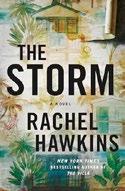
A Gulf Coast hotel owner who loves true crime suddenly finds herself at the center of one. When journalist August Fletcher reaches out to Geneva Corliss, offering to pay double for two last-minute rooms at her failing, century-old hotel,
The Rosalie Inn in St. Medard’s Bay, Alabama, it feels like the port in a storm she’s been praying for. August has partnered up with beautiful, no-nonsense Gloria “Lo” Bailey to co-write her memoir. In 1984, when Hurricane Marie struck St. Medard’s Bay, Lo, then 19, was accused of murdering her married lover, Landon Fitzroy, who was the son of Alabama’s governor. Although Lo was acquitted, and the death ruled an accident caused by the storm, the tabloids never tired of the salacious version of events. Now 60, Lo is eager to tell her own story. For her part, Geneva is excited for the financial boon their stay will bring, and harbors hopes that her inn will turn into a hotspot for true crime aficionados. But as Geneva grows closer to both Lo and August, she begins to develop theories about the crime and learns that her own life might be tied to this messy past. Hawkins deftly weaves together the voices of a host of intriguing characters, with August being the only mostly one-note miss. And while it doesn’t take a trained meteorologist to predict many of the twists and turns this quick-moving thriller takes, the story is gripping from beginning to end.
A sharp read for literary sleuths.
Hermann, Judith | Trans. by Katy Derbyshire Farrar, Straus and Giroux (208 pp.) | $17 paper | January 13, 2026 | 9780374619510

Hermann excavates the foundations of her writing in a series of autofictional essays about influences on her life and craft. Based upon content from her Frankfurt Poetics Lectures, Hermann examines three areas of inspiration and practice in an effort to “bring together influence and writing.” Her thinly veiled narrator (who happens to share a last name and a list of publications with the author) launches the first of three essays with an account of a revelatory nighttime
encounter on the streets of Berlin with her longtime psychoanalyst. (The analyst had been treating her close friend Ada during a period of intense friendship, developed when the young women were members of a close circle of friends, creating their own lives.) Hermann’s friendships with two confidants from that era—Ada and the mercurial Marco—resolve very differently and demonstrate the varied results of creating a “chosen family.” The focus then shifts to Hermann’s own family’s painful history of illness, mental illness, and secrecy. References to dolls, puppets, and the like illuminate the shadowy forces behind Hermann’s need to tell her story—in a form that allows her to share while maintaining a protective “shell” about herself. Hermann’s last area of exploration addresses her writing. The question of what to convey and what to conceal is crucial to the narrator’s innate sense of literal self-preservation. Hermann examines what she’s written and muses on the differences between dreaming, making things up, and exaggerating. Her conclusions about the forces animating the stories—that she (or her narrator) has told and will tell—are equivocal and dreamy. This thoughtful interrogation of the conscious and unconscious influences on fiction was translated from German by Derbyshire in a direct and matter-of-fact voice. A serious meditation upon one author’s motivations and methods.
Kirkus Star
Hoen, Tory Henwood | St. Martin’s (288 pp.) $29 | December 2, 2025 | 9781250276797

A 20-something takes over caring for her aging father and suspects he may be able to see the future. Cricket Campbell is 26 but considers herself “essentially a larva.” She lives in New York City and works as an assistant at a company
similar to Goop. Her father, Arthur, has Alzheimer’s disease and lives in a lake house in the Adirondacks, where her older sister, Nina, handles his care. When Nina is offered a postdoctoral position in Stockholm, she says it’s time to sell the house and move their father into a memory care facility. But Cricket, ready for a big change, decides this is the moment to step up. She quits her job and moves into the house to take over her dad’s care, even though she’s avoided the lake since she was a teenager because of a tragedy that fractured her relationship with her father. Arthur may not remember who Cricket is, but he’s oddly prescient, predicting the future on more than one occasion. As Cricket adjusts to being a caretaker and tries to find a source of income, Arthur (somewhat accidentally) becomes famous for his clairvoyance, at first locally and then on a much larger scale. Hoen deals with the harsh realities of Alzheimer’s while still creating an atmosphere that’s cozy and welcoming. As Cricket puts it, Alzheimer’s “has the capacity to be both devastating and hilarious, and those who witness it learn to live in limbo, because there’s nowhere else to live.” Cricket’s quarter-life crisis forces her to grow up, finally come out of her shell, and realize that there’s value in community and forgiveness. The lakeside town is reminiscent of Gilmore Girls, with a cast of quirky but well-meaning characters who pitch in to help Cricket and her father. Hoen delicately handles the slow-moving grief of Alzheimer’s as Arthur’s health declines. It’s especially moving to see Cricket realize that the love her father has for her can transcend his own limitations—and their past. At once a charming exploration of small-town life and a realistically heartbreaking depiction of Alzheimer’s disease.
Holder, Lovell | Grand Central Publishing (400 pp.) | $30 | December 2, 2025
9781538770153
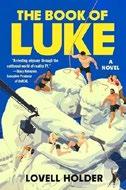
A D.C. sex scandal breaks up a two-dad household, sending one partner back into the treacherous (and spicy) arena of the reality show where the men first met.
Luke Griffin met his husband, Barnes Appleby, on the first season of Endeavor, a reality show that, in format and longevity, resembles Survivor. Luke had graduated from Dartmouth and was on his way to the NFL draft when a car accident changed his life. As he and two other contestants forge alliances, more accidents occur, some of which will not be revealed until much later in the book. The story begins in 2015, when Luke and Barnes—happily married for more than a decade—have two adorable children and a gorgeous home outside D.C. Barnes is an openly gay Republican senator who ran on a platform of transphobia that Luke tolerates for the sake of his role as stay-at-home dad. What he won’t tolerate is the shocking news that his husband is a serial adulterer. If Luke wants to win full custody of the kids, he’ll need money, fast, and that’s when the producers of Endeavor reel him in as a contestant on Season 20. The narrative cuts back and forth between the show’s early years and the new season, allowing Luke to relive painful memories while also resolving some of them in the present. Time-traveling can make it tough to remember who’s
This story of a man’s reckoning with his past is fast, fun, and steamy.
THE BOOK OF LUKE
who and who’s zooming whom, although reality-show enthusiasts will follow the various tests and eliminations with glee; the production interference and player strategies ring true. The sex scenes include many filled with love and affection, and along with Luke’s deep devotion to his son and daughter, keep his realityshow self from seeming too superficial. Despite a few overwrought plot twists, Luke figures that what’s most important to him has less to do with winning a competition and more to do with creating a balanced life.
This story of a man’s reckoning with his past is fast, fun, and steamy to boot.
Levine, Sara | Roxane Gay Books/Grove (304 pp.) | $27 | January 13, 2026 9780802165923

When a corgi’s soul inhabits a little boy, several spiritual journeys are set in motion. “I don’t feel well,” Rose Cutler tells her 6-yearold nephew, Nathan, midway through Levine’s latest. “I need either silence or a conversation that requires no depth of attention.” It’s Rose in a nutshell: brutal, blunt, and hilarious in a way that leaves you doing spit-takes. When Nathan’s parents announce they’re off on a trip to Cancún, Rose convinces her brother, Victor (Nathan’s dad), that she can care for him while they’re away (Nathan soon admits to Rose that, in his family, she’s referred to as “Aunt Rant,” so, as the reader can plainly see, various tensions are at play here). Rose couldn’t have predicted that her dog would start the week by killing a small corgi in front of Nathan—nor that Nathan would become convinced, despite Rose’s many counterarguments, that the corgi’s soul had then flown into his
own body, melding with his own soul. In fact, as Rose soon observes, Nathan even begins to resemble Hazel (the corgi’s name, as it turns out)—her “huge head and black-rimmed prostitute eyes”—if only for brief moments. Levine manages this subject matter with the skill of a tightrope walker. Somehow—impossibly—the novel is simultaneously absurd and deeply moving, wise and absolutely, side-splittingly uproarious. It is a book about relationships more than it is one about metaphysics or new-age healers: Rose’s relationships with Nathan, with her brother and sister-in-law, with her put-upon best friend, Omar. Whimsy aside, Rose’s growth is particularly convincing in a way that resists trite epiphany, and the ending, when it arrives, feels deeply earned—but the journey it takes to get there isn’t one anyone could have predicted. A novel that seems destined to become a cult classic.
Lewat, Osvalde | Trans. by Maren BaudetLackner | Coffee House (248 pp.) | $18 paper | December 2, 2025 | 9781566897457

An African woman’s life is torn apart after the arrest of her best friend.
Katmé Abbia appears to have a picture-perfect life. She’s married to a rising political star in the fictional African country of Zambuena, Tashun Abbia, the prefect of the nation’s capital; the couple has twin daughters together. She spends time with her best friend, Samy Pankeu, an artist on the verge of opening his first solo exhibition, one that is sharply critical of the country’s social and political culture: “In Zambuena, people weren’t arrested for expressing disagreement with the president or his party anymore. Samy had the right to sculpt and write what he wanted, to criticize whomever he chose. That was his role. The
important thing was that he have no political ambitions, and since he didn’t, there was nothing to fear.”
Then things start to go bad. Samy is arrested after a newspaper reports that he’s gay; he’s raped and tortured in jail, and his gallerist is beaten and humiliated by “Defenders of Morality.”
Tashun becomes increasingly physically abusive, angered by Katmé’s attempts to free her friend from prison. Meanwhile, Katmé must coordinate the reburial of her mother, who died when Katmé was 13, and whose grave must be moved to make way for a highway. In Katmé, first-time author Lewat has created a memorable character who alternates between moments of weakness and strength in a way that feels thoroughly human. She addresses themes of political corruption and homophobia with an incandescent anger—at times, the novel reads a bit heavy-handed, but there’s no doubting Lewat’s sincerity. The prose, translated by Baudet-Lackner, is quite good, and the dialogue is mostly realistic, save for a few lines that seem forced.
A promising first book from a writer to watch.
Markovits, Ben | Summit/Simon & Schuster (256 pp.) | $28 | December 30, 2025 9781668231562

A man facing the empty-nest phase of a disappointing marriage drops his daughter at college and hits the road. Published in the U.K. earlier this year, now shortlisted for the Booker Prize, Markovits’ 12th novel establishes the unstudied and confiding voice that carries it so compellingly forward in the first sentence: “When our son was twelve years old, my wife had an affair with a guy called Zach Zirsky, whom she knew from synagogue.” As
the story unfolds, this voice often addresses the reader directly, saying things like, “I’m sorry, I don’t mean to sound about it the way I probably sound,” and “I should probably say a word about our friendship,” and so forth, increasing the intimate effect. For the sake of his kids—there’s also a daughter, then 6—Tom Layward made a deal with himself that he’d stay in the marriage until they left home. The book opens at that point, 12 years later. “What we obviously had, even when things smoothed over, was a C-minus marriage, which makes it pretty hard to score much higher than a B overall on the rest of your life.” Other things are also going poorly: Tom, a law professor on leave from his university after counseling the owner of a basketball team accused of racism and sexism, has also refused to add his pronouns to his email signature. Markovits, who was born in Texas, played pro basketball in Germany, and now lives in London, develops this tricky aspect of the situation in a notably nuanced way, as part of the complexity of Tom’s character rather than as a dive into the breach of the culture wars. Tom is also suffering from undiagnosed but serious-seeming health symptoms, which he vaguely ascribes to long Covid. When an argument between his wife, Amy, and daughter, Miri, erupts on the day they are to take her to campus, Amy stays home. And without ever actually deciding to, Tom ends up on a cross-country road trip, visiting an old basketball teammate, an ex-lover, his brother, and ultimately his son on the West Coast. Though Markovits has never been big on plot, the reader’s sense that this is all leading up to something is not wrong.
This controlled, quietly moving portrait of a life in decline coasts to a halt in an unexpected place.

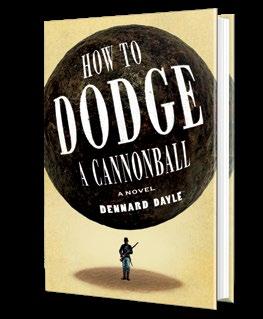

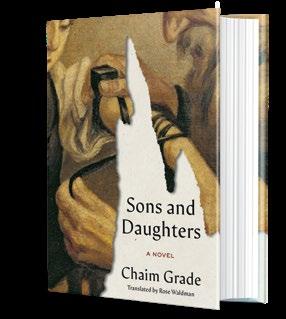
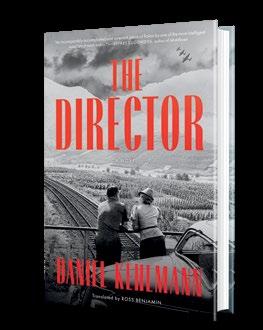

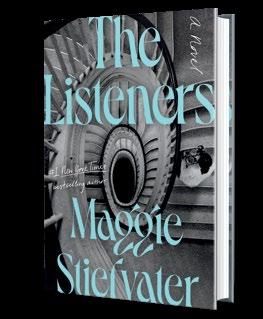
Dennard Dayle
Grade
The author of Wild Dark Shore answers our questions.
AUSTRALIAN NOVELIST Charlotte
McConaghy’s third novel, Wild Dark Shore, tells the story of widower Dominic and his three children, whose already precarious lives—they’re stationed on a remote island, threatened by climate change—are further complicated when a woman washes up on the shore after a boat crash. “McConaghy writes about both nature and human frailty with eloquent generosity,” a critic for Kirkus said of the book, which we named one of our best books of the year. The author answered our questions via email.
What was the original idea or scene that started you working on the book?
During the 2019-2020 bushfire season, which was the most catastrophic fire season on record for Australia, a story emerged about the rescue of the “dinosaur trees.” For thousands of years, the Wollemi pine was thought to have gone extinct during the time of the dinosaurs but was discovered deep in a forest in 1994, somehow, miraculously still alive. Its location was kept secret from the public as a way of helping it to survive, but decades later, during [that] Black Summer, fires raged towards it. Firefighters were lowered down from helicopters in order to create a barrier with their bodies, desperate to protect these rare and precious trees. The rescue made an impact on us here in Australia, but brought to the forefront the 19 million hectares and 3 billion animals that were not saved. Around this time, I was reading about the Global Seed Vault in Svalbard [Norway], built to safeguard the world’s agricultural seeds in case
of emergency, designed to withstand anything and remain standing long into the future. The only thing that wasn’t considered was that rising temperatures could melt the permafrost, and, as a result, the bank flooded. I couldn’t help pondering the question of the things humans choose to save, and why.
You went on a research trip to Macquarie Island, on which you base the book’s Shearwater Island. What was most memorable about that experience? This was a life-changing experience for me and has created so many vivid memories in my mind, not least of which were the colors, the sounds, the textures and sensations—stepping off the Zodiac onto the black sand, I remember being hit with a wall of sound made by thousands of seabirds, royal and king penguins waddling around my feet, albatross and giant petrels soaring low overhead, huge elephant seal pups practicing their fighting in the shallows or flopping over to nibble our boots. It was extraordinarily rich with wildlife, and staggering that a place like this could still exist somewhere, untouched. But I also remember that alongside this beauty, the island had a darker underbelly. Close by on the beach sat huge rusting metal barrels, remnants of the oil exploitation trade in the 1800s, when sealers and whalers had come to Macquarie to wipe out the fur seal population and almost destroy the penguins by stuffing them into these barrels.
What inspired you during the writing of the book?
Honestly, writing this book is a blur to me now. It existed in my life throughout


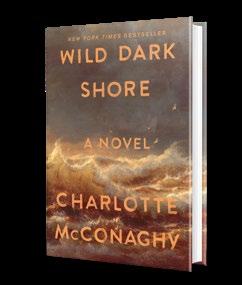
McConaghy, Charlotte
Flatiron Books |320 pp. | $28.99 March 4, 2025 | 9781250827951
two very bad pregnancies and many hospitalizations, multiple miscarriages, the sleep deprivation and infancy of my first and second babies—I have no way to know what I was reading or watching at the time, or what inspired me, because I think more than anything the completion of this book was an act of dogged determination and a little bit of delirium!
What books published in 2025 were among your favorites?
I’ve really enjoyed Dream State by Eric Puchner, Deep Cuts by Holly Brickley, The River Has Roots by Amal El-Mohtar, and Heart the Lover by Lily King.
Interview by Nina Palattella

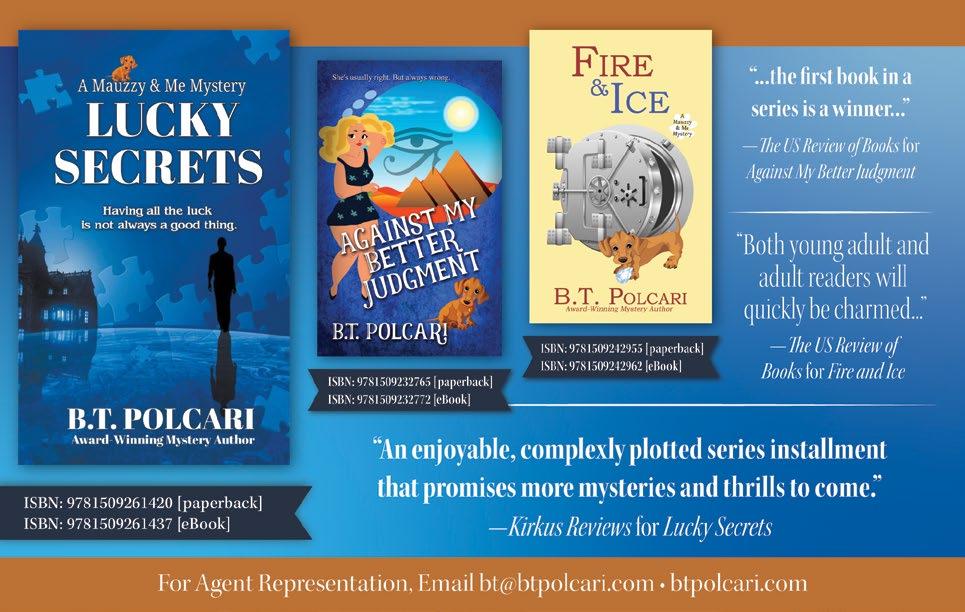
MORE TO CHECK OUT WHILE YOU WAIT:
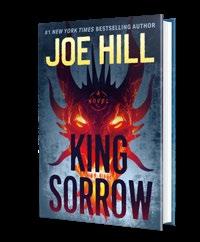
Fiend by Alma Katsu (Putnam)
I’ll Quit When I’m Dead by Luke Smitherd (Mulholland Books/ Little, Brown)
The Psychographist by Carson Winter (Apocalypse Party)
Spirits of the Dead by Keith Gilman (Severn House)
Below the Grand Hotel by Cat Scully (Clash Books)
Silver Nitrate by Silvia Moreno-Garcia (Del Rey)
A Harvest of Furies by Hayden Casey (Lanternfish Press)
Incidents Around the House by Josh Malerman (Del Rey)
Book of Night by Holly Black (Tor)
Our Share of Night by Mariana Enríquez, trans. by Megan McDowell (Hogarth)
Necrology by Meg Ripley (Creature Publishing)
Ninth House by Leigh Bardugo (Flatiron Books)
Kentucky Dragon by Michael Park (Fox Point Books)
Demon King by Erik Henry Vick (Ratatoskr Publishing)
It by Stephen King (Viking)
Looking for supernatural scares à la Joe Hill? We’ve got you covered.
BY MEGAN LABRISE
ON KIRKUS’ FIFTH Cut the Line: Readers’ Advisory webinar, in partnership with Ingram Library Services, we explore a range of read-alikes for Joe Hill’s latest novel, King Sorrow (Morrow/HarperCollins, October 21). Hill is the No. 1 New York Times bestselling author of The Fireman, Heart-Shaped Box, and Strange Weather, as well as the Eisner Award–winning writer of the comic book series Locke & Key. Much of his work has been adapted for film and TV.
While you’re waiting for King Sorrow —which had more than 1,000 holds across several of the country’s largest library systems—we’ve got a list of supernatural horror stories you won’t want to miss. First, Ann Cox, a collection development librarian at Ingram Content Group, presents a slate of recommended titles to read right now. Then, in an intriguing panel discussion, I speak with three horror writers about haunted houses, abandoned mines, and the art of crafting twists and turns.
In Her Lips, My Voice (Creature Publishing, October 14), debut novelist L.L. Madrid serves up speculative horror set in a former mining town with a bloody history. Four young women, inextricably connected through time, must unravel the mysterious disappearance of a local student before it’s too late, in a tale Kirkus calls “an intriguing and atmospheric queer mystery that’s peppered with the supernatural.” Madrid lives in Tucson, Arizona, where she writes moody stories about misfits.
Caroline Macon Fleisher’s first novel, The Roommate, was a bestselling Kindle thriller in the summer of 2022. Her sophomore novel, A Play About a Curse (Clash Books, October 21), is
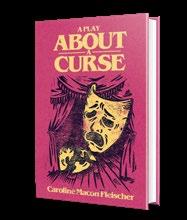
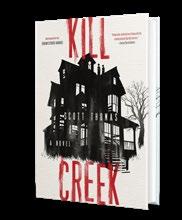
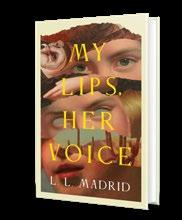
the story of an ambitious young playwright whose envy compels her to place a hex on her mentor and would-be friend. Kirkus calls it “a searing caricature of fraught female friendship.” Fleisher lives with her husband, son, and an assortment of pets in Chicago.
Horror writer Scott Thomas is the author of Midwestern Gothic and Violet In Kill Creek (Inkshares, October 2017), four horror writers receive an invite to spend the night at a well-known and long-feared haunted house in the Kansas countryside—a publicity stunt that could cost them much more than they bargained for. By day, Thomas is the co-creator and executive producer of Disney Channel’s Best Friends Whenever and Disney XD’s Randy Cunningham: 9th Grade Ninja. Born in Coffeyville, Kansas, he lives in Los Angeles with his wife and two daughters.
Editor at large Megan Labrise hosts the Fully Booked podcast.

To watch a video of the session, visit Kirkus’ YouTube page.
McLain, Paula | Atria (464 pp.) | $30
January 6, 2026 | 9781668028155
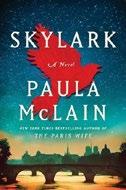
Two urgent stories of survival, set nearly 300 years apart, are connected by treks through Paris’ ancient underground tunnels. In 17th-century France, dyer’s daughter Alouette Voland’s ambitions (she dreams of selling her own formulas for fabric hues) land her in Salpêtrière, a dread women’s madhouse. In mid-20thcentury Paris, Dutch medical doctor Kristof Larsen finds his psychiatric practice disrupted by Nazi invasion. While their concerns and paths diverge, these characters share a commitment to truth and justice, qualities discouraged in their eras. Take, for example, the bigoted concierge of Kristof’s apartment building, or the elitist noblewoman who runs Salpêtrière, the rapist madhouse guards, and the nasty Gestapo officers—whether it’s 1664 or 1939, cruelty, greed, and self-interest spring up regularly in human history. Fortunately, so do kindness, compassion, and valor, all of which Alouette, Kristof, and their small bands of stalwart friends demonstrate as they seek to escape and help others, too. Since the dual-narrative structure presses urgently toward resolution for both groups, Alouette and Kristof’s friends seem less like secondary characters than people whose stories you’d like to learn more of when the time is right: Marguerite, who keeps a ledger of crimes by madhouse workers; Alesander Extebarria, Kristof’s Basque comrade who understands wartime subterfuge; and Sasha Brodsky, whose Jewish identity both destroys her once-placid life and gives her the determination to stay alive. The book opens after the terrible fire at Notre Dame de Paris in 2019, as a conservator finds an exquisite fragment of stained glass etched with a skylark. Alouette’s beloved, Étienne, is a miner who once carved a tiny stone skylark for her
because of her name. Wisely, McLain does not force a skylark into Kristof and Sasha’s story, instead allowing this avian symbol to lightly land as a reminder of transcendent hope. Although very little ties the two stories together, perhaps their shared thread of resolve is enough.
Kirkus Star
Navarro, Brenda | Trans. by Megan McDowell | Liveright/Norton (240 pp.)
$24.99 | January 20, 2026 | 9781324096085

A younger brother’s death by suicide in Madrid haunts the immigrant narrator of this second novel by award-winning Mexican writer Navarro.
An unnamed protagonist and her brother, Diego, live with their grandparents in Mexico City. When only a girl herself, she was charged with her brother’s care by their mother, who left in search of work and a better life in Spain. Though their mother promised to send for them soon, it’s nine years before they join her in Madrid. A teenager by this point, bullied in school, Diego takes refuge in the music of Vampire Weekend, while the narrator works a series of poorly paid caretaking and cleaning jobs. Navarro writes with authority and sympathy about the stress of being an immigrant, including loneliness, exhaustion, poor working conditions, and the strain of constantly feeling foreign and unwelcome. The novel starts with Diego’s death by suicide, and continues in a series of layered flashbacks. While Navarro is broadly interested in themes of immigration and the colonial legacy, the novel is firmly rooted in the specific, palpable lives of her characters, which she renders with nuance and honesty. When Diego turns moody and withdrawn, steals money, and skips class, his sister thinks: “I understood Diego. Ever since we got to Spain we’d been like amputees with no diagnosis. Like we were
missing something, but everyone denied it....What could have possibly been amputated? Well, Mexico, I thought. They’ve cut off our Mexico.” But Mexico itself is violent and unsafe, as she sees firsthand after returning with her brother’s ashes. It provided a “sense of belonging, but at the same time of being a crab in a bucket climbing onto the backs of the others, trying to get out.”
A sensitive portrayal of sibling love, grief, and the trauma of dislocation.
Ng, Celeste, ed. | Mariner Books (384 pp.) | $18.99 paper October 21, 2025 | 9780063399808

Ng selects 20 stories that illustrate why we might still read fiction in a time of disinformation and lies.
As the trials and tribulations of the 21st century have unfolded, the Best American Short Stories anthology has become a particular way of taking the temperature of each passing year. As Ng writes in her introduction to the latest group, “Short stories in particular can act like little tuning forks, helping us to clarify our own values—then allowing us to bring ourselves into alignment with what we believe. In a time when our values are being tested daily, it’s hard to think of anything more important.” Many of them are also fun to read, a quality appreciated more than ever by depressed and overwhelmed readers. The stories are ordered alphabetically, a structure maintained in the following selection, which is unfortunately limited by space. “Take Me to Kirkland,” by Sarah Anderson, is very funny, a little weird, and certainly one of Costco’s finest hours. “What Would I Do for You, What Would You Do for Me?” by Emma Binder is a cinematic minithriller about a trans kid visiting his
about whom the neighbors tell fearful stories.
hometown, terrified of being “clocked” by the people he grew up with after he saves a local from drowning. “Time of the Preacher,” by Bret Anthony Johnston, is one of several pandemic stories—in it, a snake, which may or may not be under the refrigerator, inspires a quarantine-breaking cry for help from a fence-builder’s ex-wife. Another story of that time, “Yellow Tulips,” by Nathan Curtis Roberts, also combines endearing, funny first-person narration with a more serious theme.
A Mormon man in an uptight Utah suburb has to manage his developmentally disabled adult son through the complexities of quarantine. One day, he discovers that his son has “gotten into the provisions Mormons are all but commanded to keep, eating Nutella and Marshmallow Fluff from their jars.… Brig, we put these things aside for the apocalypse,’” the father says, while his son “grinned gleefully, sugary goo smeared across his lips and fingers. ‘It’s an apocalypse now!’” The spirit of grace under pressure and creativity under fire animates a wonderfully diverse set of stories.
Patterson, James & Howard Roughan Little, Brown (400 pp.) | $32 October 13, 2025 | 9781538758434
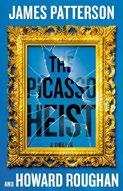
Patterson’s latest co-authored thriller follows an enterprising brother-and-sister team who are determined to steal a recently discovered Picasso painting from the Echelon auction house and replace it
with a forgery.
Even though they’ve already had extensive experience courtsiding—that is, getting a tennis umpire to slow down his calls so they can place bets a second or two before the odds change—Halston Graham and her older brother, Skip, can’t do this on their own. So in the first of many deliberately engineered setbacks, Halston arranges to get caught at her job and spirited away by Blaggy Danchev, the big muscle for crime lord Anton Nikolov, so she can turn around and entice Nikolov and his minions into the heist. Armed with Nikolov’s backing and a perfect replica created by Wolfgang, her friend and accomplice, Halston worms her way into the confidence of fashion designer and art buff Enzio Bergamo and Echelon CEO Charles Waxman, both of whom will be instrumental to the scheme in ways they could never have imagined. The heist doesn’t go off without a hitch; there are many hitches, some real, some fake, before the prize is carried off and replaced with the copy. But that turns out to be only the opening act in an endless series of head-spinning felonies, complications, betrayals, and unmaskings that will keep the target audience turning pages far later into the night than they should. Canny fans will realize early on that they can stop reading any time and still have the satisfaction of having digested all the plot twists they can handle, and then some.
The biggest deception is the title, which should really be The Picasso Heist, Etc.

Pereira de Almeida, Djaimilia | Trans. by Alison Entrekin | Farrar, Straus and Giroux (304 pp.) | $18 paper | December 9, 2025 9780374612092
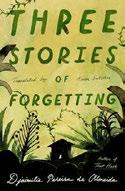
In three long stories, Angolaborn novelist Pereira de Almeida explores Portugal’s colonial past.
Captain Celestino in “A Vision of Plants” is a man about whom the neighbors tell hushed, fearful stories: “He cut off a dwarf’s head. He hacked a woman in two. Over in the Congo he set fire to an elephant.…He keeps skulls in chests and charms snakes in the moonlight.” Now old, Celestino potters in his garden as his home slowly crumbles, mirroring his own decline. Though he’s apparently harmless, grandmothers warn their grandchildren, “If you don’t finish your soup, I’ll take you to the captain’s house, where he’ll chop you up like a grouper.” Celestino is none too innocent: He’s a veteran of the slave trade, and in a particularly horrible moment, he suppressed an onboard rebellion by murdering his human cargo. And he still harbors murderous thoughts: “Come to me, children, to me who has slit throats and who sleeps the sleep of the righteous.” In “Seaquake,” one “Boa Morte da Silva the freight forwarder” does soul-sucking odd jobs like watching parked cars to earn a few euros. A former colonial soldier—his name means “Good Death”—he is anonymous, lost in the system; Pereira hints that he may already be a ghost. Bruma, the title character of the final story, is enslaved but unbothered by that fact: “neither servile nor grateful, just happy, he found meaning in things, even if he knew he was imprisoned. His simple life revolves around books and a cabin he built in the woods, knocked down and rebuilt in several incarnations, part of the mystery of being, of the “tunnel between day and night, between wakefulness and dream, between death and life…” The three tales add up to a brilliant, yet
An author upends her book tour to confront the man who changed her life.
DISCIPLINE
understated, critique of a past that Portugal most likely hopes to forget. Lyrical, enigmatic, and subtle: an accomplished work that considers fraught histories at the most personal level.
Pham, Larissa | Random House (224 pp.) $28 | January 20, 2026 | 9780593979648

An author upends her book tour to confront the man who changed her life. Pham’s astute debut novel follows first-time author Christine on her book tour. When she receives an anonymous email (“That’s not how I remember it”), she immediately knows it’s her former art professor, Richard. After a decade of no contact, the email sends her spiraling. She can’t believe he’s read her autofictional, if exaggerated, novel, in which he was the inspiration for the villain. Cleaved into two parts, the novel’s first half follows Christine as she connects with strangers and estranged people from her past on tour stops. In a particularly beautiful and evocative chapter, Christine reunites with her former classmate and friend Frances. Upon discovering that she’s given up painting, Frances asks Christine: “Isn’t it painful?....To abandon a medium. There are so many things I can’t say any other way.” This conversation—imbued with their charged history of intimacy and competitiveness—allows Christine to begin to grapple with her own art: what she created in the past, what she creates now, and what she may create in
the future. The novel’s second half takes her to a remote island off the coast of Maine when she accepts Richard’s invitation to come to his home. When she arrives, Christine finds herself shocked by Richard’s rapid aging (“the decade that seems to have collapsed in an instant”). The pain of the past hangs heavy in the air around both of them. Despite herself, Christine feels an uncomfortable mix of fury and pity toward him as they begin to slowly and painfully address the wound at the center of their relationship. The novel simmers with tension and tenderness as Christine ponders the past and comes to terms with the present. Pham’s lithe prose is especially on display in her musings about love, intimacy, power, art, writing, survival, and agency.
A quietly elegant debut from a writer with great promise.
Restrepo, Laura | Trans. by Caro De Robertis | HarperVia (368 pp.) | $30 December 30, 2025 | 9780063356153

Ancient biblical kingdoms meet refugee camps in modern-day Yemen in a re-envisioning of the story of King Solomon and the Queen of Sheba. This novel by Colombian writer Restrepo reimagines the biblical love affair through the lens of the queen’s childhood and upbringing, weaving it into the stories of modern exiles in refugee settlements in Yemen. The queen, born as the eldest daughter of the kingdom of Sheba and nicknamed Goat Foot
because of her furred body and goatlike foot, was cast out by her mother and lives on the edge of society and, as a result of her liminal existence, “embraced multiplicity and renounced nothing, in a splendid mix of animal and human, dirty and clean, living and dead, past and future, white and black.” Running alongside and interwoven with the story of Goat Foot is the contemporary story of the failed monk Bos Mutas, whose fascination with the Queen of Sheba begins as a boy when his parents take him on a cruise down the Nile and he encounters her belly dancing on the ship’s main stage. After his father abandons him and his mother dies, Bos Mutas trains to be a Dominican monk but finds himself unable to pray to the Christian god and instead becomes more intensely obsessed with the Queen of Sheba. His obsession eventually leads to his expulsion from the novitiate, and his search for the elusive queen takes him to Yemen, where he meets Zahra Bayda, a Somali midwife with Doctors Without Borders, whom he follows into refugee settlements. He watches her work among the migrants, many of whom claim to be descendants of the Queen of Sheba. Restrepo’s gift for description and worldbuilding is impressive, as is her astonishing breadth of allusions ranging from Patti Smith to Thomas Aquinas. However, in some instances, the same richness that lends the story vitality buries some of the characters’ most compelling moments beneath overly ornate language as they struggle for love, acceptance, and survival amid the horrors of war, otherness, and exile.
A vibrant and occasionally florid reimagining of an ancient love story for modern times.

Romano-Lax, Andromeda
Soho Crime (464 pp.) | $29.95
January 6, 2026 | 9781641296915

A high school counselor suddenly finds herself questioning whether her troubled teenage son was involved in the murder of two female classmates.
Abby Rosso always knew her loner son, Benjamin, was different. Then two girls she counseled at the high school—and whom he knew—are found dead, having apparently died by suicide. When she discovers a pair of girls’ panties among her son’s things, Abby refuses to believe the worst about Benjamin. But a past incident involving her violent, imprisoned brother, Ewan, and another young girl whose panties he kept as a kind of trophy sends her into a panic. Abby has kept Ewan from contacting Benjamin; yet history seems to be repeating itself, nevertheless. In a narrative that moves between Abby and, later, Benjamin, Romano-Lax plunges readers into the depths of a psychological thriller about a woman who, in seeking answers about her son’s involvement with the two deaths, is forced to revisit a dark personal chapter involving her brother. Curtis Campbell, a former psychology professor Abby runs into by accident, offers hope when he takes an interest in her situation and accepts Benjamin as a client. But the more Abby gradually learns about Curtis, the more she realizes that a man she thought could help her troubled son is actually an even greater threat to Benjamin than her imprisoned brother. Meticulous characterizations, thoughtful plotting, and unforeseen twists are only part of what make this novel so successful. As it explores the nature of unconditional mother-love and human psychopathy, Romano-Lax’s book also offers a chillingly on-point portrait of masculinity at its most toxic and perverse.
A propulsive novel that fearlessly probes the darkest corners of human psychopathy.
Ryan, David | Cash 4 Gold Books (212 pp.) | $26.95 paper November 30, 2025 | 9798990727502
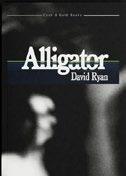
A collection of stories that reflect the precision and balance of a high-wire aerialist. As with the high wire, these stories require close attention; they should be read slowly and carefully. They seem to have been written that way, every step deft and deliberate. Take the opening title story. Its narrator is “I,” and he’s addressing “you” about their young son. The first reference to the titular alligator is the cartoon on the young boy’s shirt. Yet the alligator will reappear in various manifestations, and so will “I.” He says he’s telling “a story forming the sum of my life,” before quickly shifting and pivoting: “No. This never happened; it’s the wrong alligator. The wrong child, the wrong life. Sometimes I lie to myself because it’s the only clarity I seem to have when confronted by some terror no method of thinking can fathom. Lying meaningfully to answer certain sublime questions. Where the meaningfully is the new truth. A story.” So, these are stories about the essence, process, and value of storytelling. But they are also about those terrors—families falling apart, identities crumbling, tornadoes and earthquakes and industrial contamination wreaking havoc. Several stories include “David,” but there’s no evidence that these are more (or less) autofictional than the others. Life can change in an instant, with cause-and-effect consequences that might reverberate for decades. Particularly virtuosic is the dream-within-dream sequence of “Reliquary,” one of many stories of a young boy left with a single parent: “That night I dream that I am my mother dreaming about my father.
I’m witnessing this but I am inside the dream, too. In it, he’s died and we’re watching him on the pallet pulled from the mudslide. It’s a vague memory, really. A bright red thread weaving through space between the real moment and the dream of the moment, which is itself no less real.”
There’s a liminal realm in these stories between life and death, present and past, dream and memory, fate and chance.
Tallent, Gabriel | Riverhead (416 pp.)
$30 | January 20, 2026 | 9780593714188
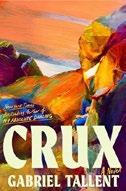
Two young climbers seek the footholds that will allow them to escape their families.
Tallent’s thrilling, wellturned second novel—following My Absolute Darling (2017)—concerns Dan Redburn and Tamma Callahan, high-school seniors united by their love for rock climbing in the Mojave Desert. The children of low-income families, they lack the funds for fancy gear, but the excitement of “sending” (completing) a climb is too hard to resist. They both fantasize about heading to Utah and living together off the grid. (Platonically; Dan is straight, Tamma a lesbian.) But multiple forces weigh on that ambition. Dan is in line for a college scholarship, and Tamma also aspires to join the competitive climbing circuit. Family proves the steepest challenge, though: Dan’s mother, a one-time successful novelist, has a serious heart ailment, while Tamma is often recruited to support her sister’s children. Moreover, their mothers, once best friends, are estranged, placing their friendship under further scrutiny. Though in some ways a conventional bildungsroman, the novel is lifted by Tallent’s gift for surprising and lively language, from the peculiar names climbers give to sites (one challenging
climb is called Fingerbang Princess), to Tamma’s robust and profane rants, to the lingo used to describe climbs themselves. (A “crux” is a difficult portion of a climb.) Even if you don’t climb, the language is rich and resonant: “The hand crack was juicy. It was outrageously casual for crack climbing. Not even a boulder problem.” Tallent delivers excellent set pieces, particularly Tamma’s introduction to the competitive climbing world, but he consistently has his eye on the existential questions that climbing metaphorizes, such as how to balance independence with responsibility and what constitutes a meaningful life goal. “How should I conduct my life? Do you trust yourself, or do you not?” Dan asks himself, and this adventure tale invites the reader to consider the same questions. A sharp novel about youth in conflict with dreams, nature, and reality.
Tomaski, Angela | Scribner (288 pp.) $27 | January 20, 2026 | 9781668094648
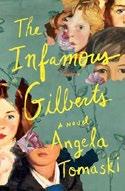
If Shirley Jackson moved The Addams Family to the English countryside, something like this dark, tongue-in-cheek epic might result.
“Welcome to Thornwalk, home of the last of the Wynford Gilberts—Lydia, Hugo, Annabel, Jeremy, and Rosalind.” Tomaski’s archly but deeply gothic debut is presented in the form of a house tour, conducted by an enigmatic man named Maximus, eventually revealed to have played a role in the events. His tour consists of 70 short chapters, each of which explains the provenance of some blemish or irregularity in the family mansion, now empty and about to be converted into a hotel. From “The Bolt on the Blue-room Door” and “The Burn on the Library Rug” to “The Missing Model Ship” and “A Squashed Blackcurrant,” each stop on the tour has a backstory. “Come through, come through,” he urges us, “climb the staircase,” directing our progress through
the house and its grounds and outbuildings, gradually filling in the outlines of the family’s miserably unhappy history from the 1920s to the early 2000s. His butler-ish voice (though he was not their butler) and his undimmed reverence for the five damaged siblings—madness, narcissism, kleptomania, violence, and a wide variety of other dysfunctional traits run in the family—set the non-judgmental tone of the revelations. A favorite character is the middle child, Annabel, who, despite being kept out of society and drugged daily to control what seems like epilepsy, is arguably the most normal of the bunch. Indeed, Wes Anderson might have a field day with the Gilberts and their storied ruins. “How well I have managed this,” the narrator reassures himself midway through. “It is almost in order and beginning to form quite a coherent little story.” Readers with a penchant for elegant horror played for comedy will likely agree, though toward the end, the narrative lingers for quite a while on an abusive domestic relationship, and one wishes to head to the gift shop. This distinctive debut introduces a wickedly weird new talent.
Torenberg, Lior | Avid Reader Press (288 pp.)
$28.99 | January 20, 2026 | 9781668091180
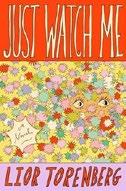
A 20-something New York University dropout starts livestreaming her life to raise money for her comatose sister. Irate at yet another fussy customer at Juice Body, Dell Danvers walks out of her job, straight to her unaffordable Hell’s Kitchen studio. A fan of watching streamers to relax, she’s moved by desperation to initiate a livestream of her own, called “MY SISTER IS IN A COMA #LOL.” As people begin to populate her stream, an idea forms: a weeklong streamathon to raise money for her sister, Daisy. Dell tells her audience her sister’s coma has been designated as vegetative, and the hospital will no longer cover life support; Dell has
to find a way to raise $14,000 a week to provide Daisy with private care. Her cause captures an audience, but Dell has to deliver entertainment—of an increasingly extreme nature. She begins by eating five habaneros—the painful experience described in magnificent detail—and the donations pour in. A famous streamer, hot_pat_of_butter, joins in and begins to mentor Dell, impressed with her growing audience and poignant story. But another viewer, excelsior404, whose demands are obscene, begins harassing Dell in the real world with threats of exposing her “lies.” Dell’s popularity and bank account grow over the week of nonstop streaming, as her relationships with her mother and best friend evaporate. Dell becomes obsessively committed to satisfying her community of viewers, no matter the risk. Torenberg raises interesting questions about loneliness in an age of mass exposure and how self-exploitation is the new American Dream. Dell’s nihilistic narrative chatter can grow tiresome, but there are also startling passages of description so absorbing we forgive her bad mood. A unique subculture brought to life with taut prose and pacing.
Toussaint, Jean-Philippe | Trans. by Mark Polizzotti | Other Press (240 pp.) | $17.99 paper | December 9, 2025 | 9781635422160

An intellectual muses on personal and global unrest. Jean Detrez, the narrator of Belgian author Toussaint’s novel (in Polizzotti’s translation from French), has a lot on his mind.
When the novel begins, it’s 2016—specifically, the time around the Brexit vote on June 23. Jean’s marriage to a woman named Diane is also coming to an end. A few months later, flipping through his phone, Jean comes across a racy photograph of a woman, prompting him to think about the futurology retreat where it was taken. It’s through his reactions to fellow participants at that event that we learn more about Jean,
who works for the European Commission; he’s alienated less by the snobbery than by “the casual familiarity” with which one attendee discussed prominent politicians. At the retreat, he meets an Estonian woman named Enid, with whom he has a brief emotional affair. Jean then muses on the aftermath of his father’s death later that same year, which leads to him considering his ties to his brother and wondering if his father’s death corresponds to the end of an era—giving way to a time “in which excess, slander, and mendacity had taken over the public forum, in which respect for the facts no longer had the inviolate character it had always enjoyed in the past.” There’s also the matter of his strained relationship with Diane and his warmer relationship with his first wife, Elisabetta, whose existence doesn’t come up until two-thirds of the way into the book. Jean is thoughtful in places, with a couple of moving invocations of Stefan Zweig’s life, but it gradually becomes clear that his professional success doesn’t necessarily translate into an ideal personal or marital life. Toussaint has written a subtle but bracing exploration of his protagonist’s perceptions and failings. An ambitious chronicle of political and marital ambiguity.
Urszenyi, Steve | Minotaur (304 pp.) | $29 November 18, 2025 | 9781250393029
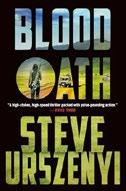
A CIA special agent’s East African pleasure trip is turned upside-down by a mysterious kidnapping. For her much-needed getaway at Tanzania’s Serengeti National Park, paramilitary officer Alex Martel plans to shoot with a camera rather than a rifle.
Beloved father David, a retired general, is along for support and banter. When a series of distant shots alerts the duo, they rush to rescue a wounded man, rushing past a ranger who’s too slow to act because he’s bringing some poachers to account. A stimulating and rewarding day is spoiled for Alex by two developments. David’s announcement, with no explanation, that he has to leave in the morning, triggers her concern, and the unexpected arrival of CIA agent Caleb Copeland, with whom Alex has a long and abrasive history (seen in Out in the Cold , 2024), puts her in a foul mood. Caleb’s brash, headlong nature offends the meticulous, analytical Alex. Will opposites attract? Sensing danger, Alex is in no mood for a reunion. As if in confirmation of her instinct, a helicopter arrives the next morning, and a team led by Harley, of the State Department, whisks Alex aboard and informs her of David’s kidnapping. The action in Alex’s third thriller unfolds in detailed and measured scenes, long on rich descriptions of terrain and culture, as well as the intricacies of regional politics. The story moves slowly, even after the revelation of David’s kidnapping, providing not heat, but light—with a surprising finale. The evocative setting underpins a crisp, elegantly written thriller.
Verunschk, Micheliny | Trans. by Juliana Barbassa | Liveright/Norton (192 pp.)
$27.99 | December 2, 2025 | 9781324097464
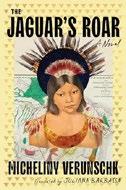
A feverish condemnation of normalized Indigenous erasure, and an elegy to two Brazilian children forcibly taken by 19thcentury explorers. In 1817, real-life German naturalists Carl Friedrich Philipp
von Martius and Johann Baptist von Spix embarked on a three-year expedition to the Amazon River basin. They returned to Munich with a vast collection of specimens: “85 mammals, 350 birds, 2,700 insects, 6,500 plants, and 2 children.” These children were a Miranha girl named Iñe-e and a Juri boy. “This is the story of Iñe-e’s death,” the author writes. The narrative flits non-linearly between Indigenous life in Brazil, Iñe-e’s capture, and various accounts—including those of the scientists, the German nobility, and Iñe-e herself—of Iñe-e’s three months as a “living exhibition piece” before her death. This is Brazilian author Verunschk’s first work to be translated into English, and it reads like an exorcism; words of history, mythology, and imagery spill across the page, mournful, indignant, and carrying deep guilt over the actions of white people. Barbassa, the translator, explains in the introduction how Verunschk’s collage-like language includes “aggressively colloquial Portuguese” and “entirely made-up words” designed to induce the disorientation of violence and colonialism. The result is part archive and part folk tale, braided into an epic prose poem. Passages describing a mystical jaguar accompanying Iñe-e’s spirit are particularly entrancing: “A jaguar is all love, then a leap for the jugular.” However, the book’s lyricism scatters its own urgency. A parallel present-day account of a non-Indigenous woman named Josefa— disturbed by museum lithographs of the abducted children—reads like a cipher for Verunschk’s own process of discovery, unduly refocusing attention on the author’s presence. Although the medium and the message inconsistently cohere, the subject is essential, and the writing is ambitious and energetic.
A potent concoction of research and imagination, encouraging us to reexamine how we construct our own histories.


By R.S. Ford
Nonstop action, intricate plotlines, deeply developed characters, top-notch worldbuilding— a must-read for epic fantasy fans.
2
The Blackfire Blade
By James Logan
A stay-up-all-night-untilyour-eyes-bleed kind of read—a virtually unputdownable adventure fantasy.

Aunt Tigress
By Emily Yu-Xuan Qin
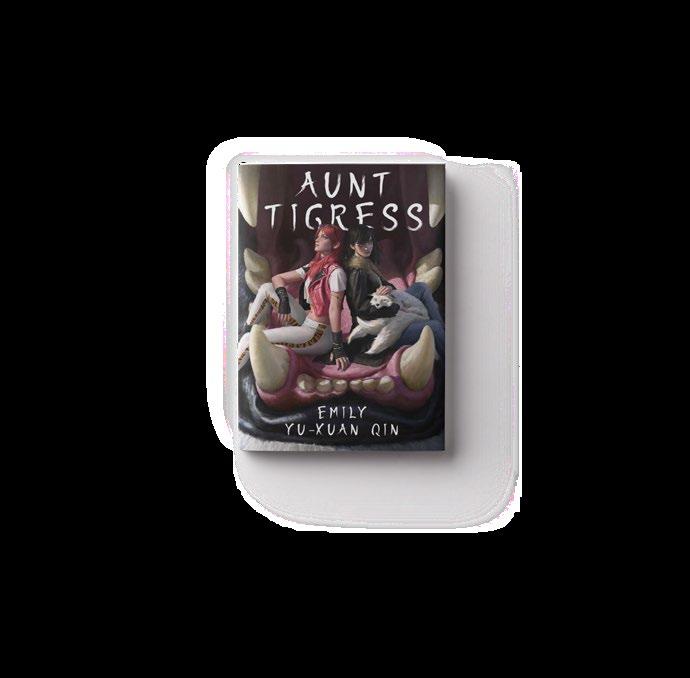
Astonishing, brutal, and beautifully constructed, with a powerful emotional punch; an exceptionally accomplished debut.
3 The Bewitching
By Silvia Moreno-Garcia
Suspenseful and terrifying; Moreno-Garcia hits it out of the park yet again.

The Isle in the Silver Sea
By Tasha Suri
Beautifully inevitable and surprising at the same time; dark, sharp, clever, lovely.

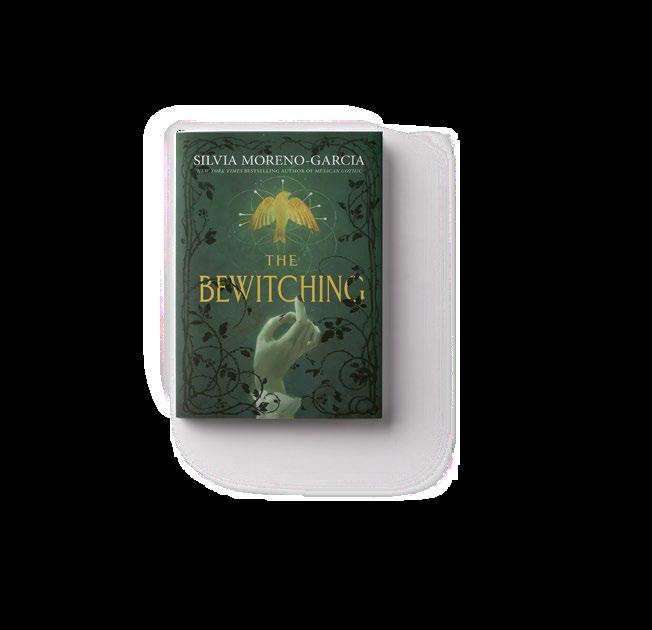
The author of The Librarians answers our questions.
AFTER MANY JUICY mysteries and romances set in Victorian England, Sherry Thomas has written a contemporary novel, The Librarians , and it takes aim straight at book lovers. When two patrons of an Austin, Texas, library are found dead in suspicious circumstances, the librarians—all of them with something to hide—band together to solve the crimes. Our starred review says, “this knockout mystery mixes the camaraderie of The Thursday Murder Club with the chic family and romantic drama of Crazy Rich Asians.” Thomas answered questions via email.

What was the original scene that started you working on the book?
The opening scene always started with Hazel Lee, who had lived abroad since she was 10, standing in front of her Austin childhood library, about to begin her first day on the job as a library clerk. In the first couple of drafts, Hazel was described from another librarian’s point of view. But it wasn’t until I recast the scene in her own point of view and gave her a wry and slightly melancholy voice that her character began coming together for me.
Your previous mysteries and romances have been historicals. What made you decide to write a contemporary?
Because my publisher wanted a feel-good mystery that was like Only Murders in the Building, but with librarians—and somehow I ended up writing that. But all joking aside, I really love it when editors come to me
and want a particular thing written. A few years ago, I was asked if I wanted to do a YA adaptation of the original ballad of Mulan. I had not given Mulan two thoughts before then—nor fifth-century China—yet the book ended up being a personal favorite. The exact same thing happened here. I probably never would have written a book like The Librarians without the prompt from my publisher. But once I got into it, I loved everything about the story, including that it’s set in our own times and that the library featured in the book is my own neighborhood library.
What inspired you during the writing of the book? What were you reading, listening to, watching?
During the writing of The Librarians , the world experienced various convulsions in the cryptocurrency market that probably influenced certain events in the book. And rather unexpectedly, Taylor Swift’s “Last Kiss (Taylor’s Version)” became the song I listened to on repeat. Thematically, “Last Kiss,” about the abrupt end of a relationship, is nothing like the reunion love story that ended up being a significant development, in terms of both the mystery plot and the character arcs. But the wistful longing in the song was exactly the mood I wanted to establish.
Where and when did you write the book? Describe the scene, the time of day, and the necessary accoutrements or talismans.
I wrote most of The Librarians at my desk, which is usually littered with my journal, books, household receipts, and sometimes an empty bowl from my breakfast that I haven’t taken


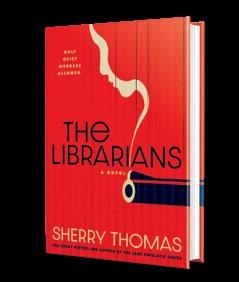
The Librarians Thomas, Sherry Berkley | 368 pp. | $30 September 30, 2025 9780593640456
back to the kitchen yet. But the last 15 to 20% of the first complete draft was finished when I was sailing over the brilliant aquamarine waters of the Java Sea and the Timor Sea. A few scenes take place in Singapore, and I wanted to see the great city-state in person before I finalized the text. My husband had some relatives in Sydney he wanted to visit, so we took a Singapore-to-Sydney cruise. And since Murphy’s Law says that I’m always on deadline when on vacation, I sat on the balcony of our cabin and worked. It was beautiful, both the scenery and the experience.
Interview by Laurie Muchnick
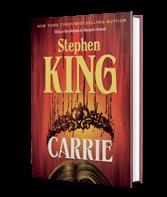
The horror novelist’s books were banned 206 times during the 2024-2025 school year.
Stephen King is the most banned author in U.S. public schools, according to a report by the literary nonprofit organization PEN America.
The horror author’s books were banned in schools 206 times during the 2024-2025 school year, the group said. Ellen Hopkins, the author of young adult novels including Crank, Burned, and Tricks, saw her books banned 167 times. She was followed closely by Sarah J. Maas, author of the romantasy series Court of Thorns and Roses, whose work was challenged 162 times.
Rounding out the top five most banned authors were novelist Jodi Picoult, with 62 bans, and Japanese manga artist Yūsei Matsui, with 54.
The most banned book during the


2024-2025 school year was Anthony Burgess’ A Clockwork Orange, followed by Patricia McCormick’s Sold, Jennifer Niven’s Breathless, Malinda Lo’s Last Night at the Telegraph Club, and Maas’ A Court of Mist and Fury.
There were 6,870 book bans during the school year, with Florida—for the third consecutive year—leading the nation with 2,304 bans, followed by Texas (1,781 bans), and Tennessee (1,622).
Kasey Meehan, the director of PEN America’s Freedom to Read program, said, “Censorship pressures have expanded and escalated, taking on different forms.… A disturbing ‘everyday banning’ and normalization of censorship has worsened and spread over the last four years. The result is unprecedented.”
—MICHAEL SCHAUB
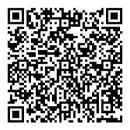

For more about book banning, visit Kirkus online.
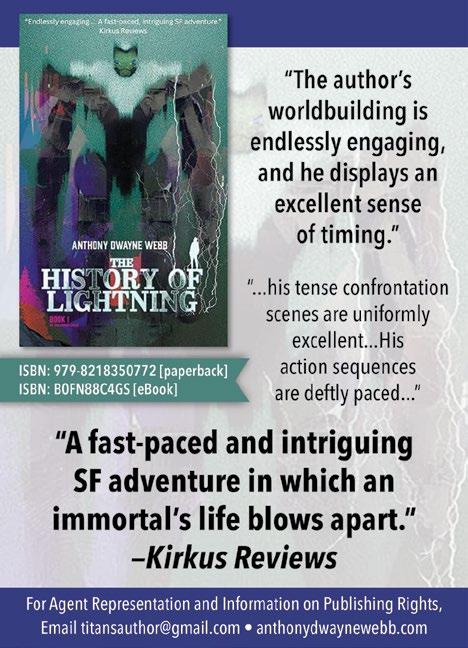
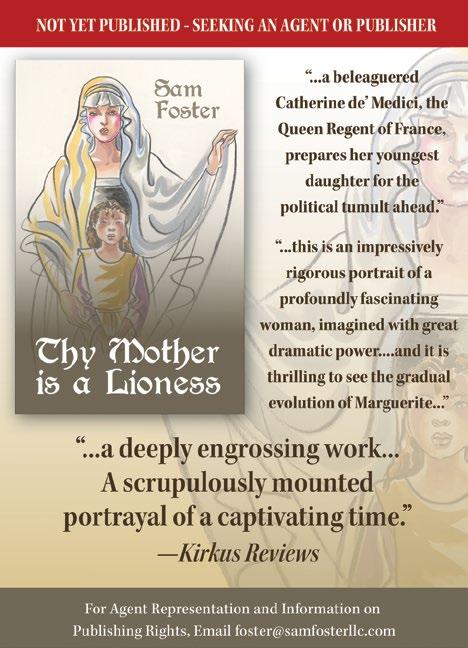

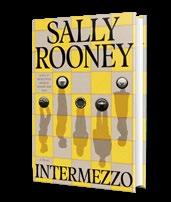
The Irish author declined to travel to the U.K. because she feared arrest there.
The Irish author Sally Rooney said she could not travel to the U.K. to collect a literary award because she was afraid she’d be arrested, the Guardian reports. Rooney won the Sky Arts Award for literature for her 2024 novel, Intermezzo, about two brothers grieving the death of their father. The book was a finalist for the An Post Irish Book Awards Novel of the Year and the Barnes & Noble Book of the Year.
Rooney has canceled all planned appearances in the U.K because she fears she could be detained due to her support for Palestine Action, a British organiza

tion that advocates for the rights of Palestinians and has been sharply critical of Israel’s actions in the Gaza war. Palestine Action has been designated a terrorist group by the U.K. Hundreds of people have been arrested in the country for participating in protests supporting the organization. Rooney has previously said that she intended to donate money she earns from her books’ sales in the U.K. to the group.
In a statement to the Guardian, Rooney said, “While I would have liked very much to accept the honor in person, this is far from the gravest consequence of the proscription of a nonviolent protest group. Peaceful protesters have already been arrested in unprecedented numbers, and the ramifications for artistic and cultural life are only just beginning.”

Collins, Max Allan | Hard Case Crime (224 pp.)
$27.99 | January 6, 2026 | 9781835414873

Did you ever imagine that The Maltese Falcon could spawn a sequel? Well, Collins has, and although it’s no match for Dashiell Hammett, it’s surprisingly successful on its own terms.
After all, Hammett’s novel ends a bit up in the air, with (spoiler alert) Brigid O’Shaughnessy on her way to jail for killing Sam Spade’s partner, Miles Archer, but scheming, bloated Casper Gutman’s gunsel Wilmer Cook escaping after the precious falcon behind all the novel’s intrigue is revealed to be a phony. So why shouldn’t Gutman’s daughter, Rhea, call on Spade just a week later, as Christmas 1928 approaches, to hire him to track down the bird that the untrustworthy supplier, Russian general Kemidov, replaced with a fake? Spade agrees, and soon he has a stable of four clients— Rhea, Chicago gambler Dixie Monahan, British Museum curator Steward Blackwood, and Corrine Wonderly, Brigid’s kid sister—each of whom, unknown to the others, has paid him a retainer to locate a treasure none of them intends to share with anyone else. There’ll be more fatalities, of course, including two members of the original cast, before Spade gathers his clients together for a Christmas party at which he stages exactly the sort of denouement Hammett consistently took pains to avoid in all his fiction. Collins’ dialogue sounds pleasingly like Hammett’s; his plotting is even twistier; and if his descriptions mix
Hammett’s terse, affectless minimalism with Raymond Chandler’s fondness for florid similes, that’s clearly, as he notes in an engaging coda, his intention. Fans convinced that nobody could possibly continue a tale that ends so definitely owe it to themselves to give Collins a try.
Dapunt, Veronika | Poisoned Pen (384 pp.) | $17.99 paper | January 6, 2026 9781464249709
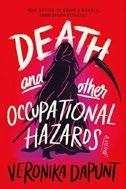
Death goes on sabbatical, and all hell breaks out on earth. Tired of all the petty indignities that go with her office, from the tradition that forces her to wear
a shapeless black sack and schlep around an ungainly scythe to the tedium of listening to all that weeping and wailing from the people she ferries on the final Journey, Death requests a leave of absence from her job. To her surprise, the Boss—engineer of the Plan that determines the fate of every living being on Earth—agrees. Death is less surprised than her sister, Life, and installs her temporarily in the body of an attractive young woman. That turns out to be exactly the kind of corporeal presence that gives Death access to a wide range of human experiences, including hunger, surprise, confusion, beauty, boredom, frustration, and, of course, love. Dapunt combines mystery—Death learns of a series of unplanned demises that she must investigate—eschatology, and melodrama into a heady mix that may
challenge some readers’ patience. The longer Death sojourns on earth, the closer the world seems to spin toward a modern-day apocalypse: What begins as an attack on individuals by deadly parasites and toxic spiders escalates into cosmic events that wipe out scores of rats and colonies of ants in the blink of an eye. Readers familiar with the biblical book of Revelation will have a leg up on understanding Dapunt’s teleology, but a passing acquaintance with the latest issue of Cosmopolitan will also help.
Definitely for readers with a taste for the eclectic.
Douaihy, Margot | Gillian Flynn/ Zando (336 pp.) | $28 January 13, 2026 | 9781638931980
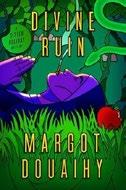
Every criminal element in New Orleans seems determined to prevent Holiday Walsh from taking her permanent vows as Sister Holiday of the Sublime Blood.
When Fleur Benoit, a popular senior in the high school where Holiday teaches music, is found dead in the gym from a fentanyl overdose, Holiday springs into action. It doesn’t matter that Sister Honor, her principal and Mother Superior, forbids her to have anything to do with identifying Fleur’s supplier, or that Holiday’s ceremony of final avowal is only a week away. After all, she’s perfectly equipped for the job by her background as a foul-mouthed, gold-toothed, heavily tattooed “gutter dyke” and her close affiliation with her friend Magnolia Riveaux, who runs the Redemption Detective Agency. The two women’s inquiries soon attract the attention of Sgt. Ruby Decker, the NOPD Homicide investigator who already has reason to blame Holiday for the death of her wife. But although Holiday gets the dressing down she expects, Decker offers something more in addition: the chance to go undercover disguised as someone
very like Holiday’s earlier self in order to trick Lenny Mastoni, the top lieutenant of the Royal Family of criminals, into giving away information that would help Decker bring the whole Family down. The mystery is sharp and the solution surprising, but the biggest draw here is Holiday’s anguished attempts to balance the demands of the flesh against the call of the spirit. As she puts it: “I had a new mission from God. Always my toughest client.”
A keenly drawn portrait of the novice as a deep-dyed sinner whose sleuthing vocation moves her ever closer to the light.
Galbraith, Robert | Mulholland Books/ Little, Brown (912 pp.) | $28 September 2, 2025 | 9780316586009

Cormoran Strike and Robin Ellacott dodge Freemasons and MI6 as they work to uncover the identity of a mutilated body in a vault. When a desperate woman with connections to high society contacts Strike with the rather odd request that he prove that a body found in a silver shop is that of her boyfriend, private investigator Strike and business partner Ellacott are drawn into a complex labyrinth of missing men, Masonic lore, illegal dog fights, and a variety of sex crimes. During the investigation, Strike is increasingly distracted by a journalist’s vendetta, and Robin, still dating a policeman and experiencing symptoms of post-traumatic stress disorder, by personal drama. London is cold and gritty; politicians are smarmy and corrupt; the upper crust is beautifully nasty; and Robin and Strike are madly in love with each other. Galbraith (aka J.K. Rowling), who never neglects an opportunity to drop an epigraph, leaves no stone unturned and no detail unexamined, but let’s be honest—by now, eight books and nearly 7,000 pages into the series, the mystery takes a backseat to the TV show–worthy stretch of
“will-they-or-won’t-they” that has underpinned Strike and Robin’s relationship since the beginning. The solution to the crime is so complicated that it becomes nearly comical; instead, readers must wait, with bated breath, for the criminal to be revealed—hoping against hope all along that the detectives will find themselves, at last, alone, and will finally express their feelings at the same. damn. time. Robin is a strong and capable woman who has evolved in fascinating ways over the course of the series, and who is understandably suffering from the previous novel’s trauma, but here she is worn down by twin burdens of guilt and responsibility for the men in her life; even as she consistently stands up to blatantly awful male behavior from both suspects and witnesses, this feels like a frustrating step back.
One of the weaker mysteries, but romantic tension and familiar characters—plus the promise of book 9—will offer fans enough.
Lorac, E.C.R. | Poisoned Pen (272 pp.) $15.99 paper | January 27, 2026 9781464253683
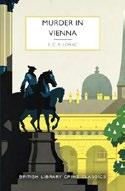
Serious accidents that overtake two British citizens who traveled on the same aircraft to Vienna add up to one misfortune too many for Scotland Yard’s Supt. Robert Macdonald.
Macdonald, who’s come to visit the family of psychologist Franz Natzler, an old friend he hasn’t seen in 10 years, intends his three weeks abroad to be a vacation, pure and simple. Those prospects darken when his airplane seatmate, Elizabeth Le Vendre, the secretary that Foreign Service retiree Sir Walter Vanbrugh—one of Natzler’s neighbors—has hired to help him write his memoirs, goes for a walk with his dog shortly after her arrival and before a violent thunderstorm and is later found unconscious after what looks like a fall down a set of steps. And they become well-nigh unthinkable with the death
of Neville Walsingham, aka novelist J.B.S. Neville, a guest of Sir Walter’s, whom Anthony Vanbrugh, Sir Walter’s resident nephew, finds dead on a country road, evidently hit by a van. Chief Inspector Albrecht Nauheim, of the Vienna City Police, doesn’t accept the coincidence of accidents befalling two expatriate members of the same household within 24 hours, and he soon overcomes Macdonald’s reservations and persuades him to work the case during a busman’s holiday. It’s a good decision, because the Scot is the one who puts all the pieces (and the two incidents) together. In one of Macdonald’s last cases, the pseudonymous Edith Caroline Rivett (1894–1958) consistently prioritizes atmosphere over plot and characterization, and the denouement lands with a surprisingly gentle bump. A welcome reprint whose view of 1956 Vienna has now grown as touristy in time as in place.
Lupica, Mike | Putnam (352 pp.) | $32 November 25, 2025 | 9798217045297
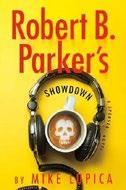
Murder begets paternity questions and more murder in this latest Spenser case. In Boston, private detective Spenser meets young Daniel Lopez, whose Guatemalan immigrant mother, Marisol, was murdered six weeks ago in Miami. “It has come to my attention, Mr. Spenser,” he says, “that a lot of my life story turned out to be a lie.” Because of a DNA test, Daniel thinks he is the unacknowledged son of Vic Hale, voice of the right-wing, anti-immigrant Boston podcast All Hale. Thought to be the next biggest podcaster after Joe Rogan, Hale hates anyone who doesn’t look like him. “King of the mouthbreathers,” says Spenser’s colleague Hawk. An “awful, awful man,” says Susan Silverman. Daniel, who is on his way to Harvard Law School, simply wants Hale
to acknowledge his paternity and insists he doesn’t want money. Hale refuses. More people wind up dead, and a bigger and more complicated story develops that ends in a showdown. Spenser, of unknown first name, is the classic creation of the late Robert B. Parker. He’s tall, great-looking, and loyal to Susan, his psychologist girlfriend and always-eager sex partner. Lawyer Rita Fiore calls him “the Incredible Hunk,” but she respects that he’s spoken for. Setting the series apart is the smart dialogue that’s often good for a chuckle—though the plots are always serious, Spenser misses few opportunities to flaunt his wit. Occasionally, it grates on his enemies, and even readers may roll their eyes at his constant efforts to be funny or make arcane literary references. Reflecting on the strength he once had, he conjures Samuel Taylor Coleridge: “When I was young? Ah, woful When! Ah! for the change ‘twixt Now and Then…” But that’s a noir P.I. for you: tough and handsome, erudite and wiseass. Meanwhile, Hawk is not shy about poking fun at his friend and ally’s quirks. Author Lupica faithfully maintains the atmosphere and characters that Parker created.
Good fun for Spenser’s legion of fans.
Kirkus Star
Fire Must Burn
Montclair, Allison | Severn House (256 pp.)
$29.99 | January 6, 2026 | 9781448315932
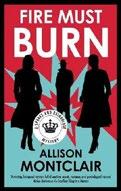
Finding a wife for an old college friend turns out to be far more dangerous than Iris Sparks ever imagined. Iris had her share of madcap adventures at Newnham College, Cambridge, in the 1930s, but by the ’40s, she’s settled quietly into running The Right Sort Marriage Bureau in London with her partner, Gwen Bainbridge. That is, until the Brigadier, a shadowy figure from her past, demands to use the bureau as cover for a secret government agent who will test her
Her puzzle is ingenious, and meshes beautifully at the end.
FIRE
MUST BURN
friend Tony Danforth’s loyalty to the Crown. Iris assures the Brigadier that she and Tony were never lovers, so her impartiality in the matter will remain intact. But her immediate dislike of Evelyn Lowle, the agent the Brigadier chooses to pose as Tony’s marital prospect, casts doubt on Iris’ claim that she and Tony are just good friends. A brutal attack on Tony forces Iris to take action, but her ties to the Brigadier prevent her from revealing the truth to Parham, the sharp and dedicated detective superintendent investigating case. Montclair hits her marks throughout. Her characters are varied and well-rounded, with a combination of strengths and shortcomings that help readers invest in their fate. Her humor leavens the mood without diminishing the seriousness of the threat to the characters’ safety. Both her London narrative and her Cambridge backstory establish a strong sense of place. Most important of all, her puzzle is ingenious, with surprises along the way that mesh beautifully at the end.
A first-rate entry in Montclair’s engaging series.
Pentecost, Hugh | Poisoned Pen (224 pp.) | $15.99 paper December 9, 2025 | 9781464244728
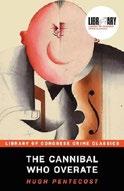
The first of resident manager Pierre Chambrun’s 22 adventures in New York’s luxurious Hotel Beaumont, originally published in 1962, gives him exactly a week to find a killer before he (or she) strikes. He may be famous and successful and wealthy and a Pulitzer and Nobel
Prize laureate, but everybody hates Aubrey Moon, the writer, socialite, and Great Man who plans to spend $30,000 to entertain 250 guests at the 75th birthday party he’s throwing himself next weekend. The question is: Who hates him enough to have offered Pamela Prym, the call girl in Room 609, $10,000 if she’d kill him before the party—and to have threatened her with instant death if she took the money but didn’t carry out the mission? It’s too late to ask Pamela, because she’s hanged herself in her room. Incredibly, though, her correspondent makes the same offer to John Wills, who already has ample reason to kill the man who caused his own father’s suicide. John, who’s booked a room in the hotel and wangled an introduction to Chambrun on the grounds that he’s learning the hotel business—a cover story that doesn’t fool the wily manager—doesn’t want a murder on his conscience but isn’t in a position to return the payoff and doesn’t want to be killed either. More than whodunit, the question of what-to-do-about-it drives this ebullient franchise debut by pseudonymous mystery veteran Judson Philips (1903–89). Editor Leslie S. Klinger supplies conscientious footnotes that describe how to make dry martinis, identify Judy Garland and Toto, explain what a call girl is, and note that the phrase “a pansy inflection” is “an unfortunate anti-homosexual slur.”
A high-concept romp that’s barely dated, despite that slur and all those footnotes.

For more mystery reviews, visit Kirkus online.
Rozan, S.J. | Pegasus Crime (336 pp.)
$27.95 | January 6, 2026 | 9798897100323

A fatal overdose in a hospital’s unofficial nap room cries out for Smith and Chin Investigations. Actually, it’s Lydia Chin’s brother Elliott, who runs the ER at River Valley Downstate Medical Center, who begs her to come to the aid of his friend Jordy Kazarian, a morgue assistant who woke up from his own 40 winks to find nurse Sophia Scott sleeping the big sleep. Since Jordy checked to make sure Sophia was dead and then waited for the authorities to show up, he’s naturally the person NYPD Det. Helena Church is convinced shot her up with drugs she never would’ve taken on her own. When Lydia finds out that Juanita Cohen, Jordy’s attorney, has already reached out to Bill Smith, Lydia’s partner, she’s in it for good. Or for evil, as the pair’s probe of the hospital quickly reveals. There’s the fact that security chief James McGraw denies any knowledge of the basement nap room or the neighboring hookup room, which was so popular that staffers had to sign up for reservations. There’s the consequent lack of in-house oversight of the murder scene. And there’s the strike River Valley’s nurses are threatening, which the hospital hopes to prevent by negotiating with a team that unaccountably included Sophia Scott, a by-the-numbers caregiver who’s never volunteered for double shifts and has always taken management’s side in earlier disputes. Rozan keeps everything moving along with a lot more efficiency and sympathy than either the NYPD or the hospital staff, and although the big reveal is a big letdown, the final scene that follows makes the whole trip worthwhile. Warning: not the best gift for a hospital-bound friend, or a read likely to speed your own recovery.
Smith, Sally | Raven Books (320 pp.) | $28.99 November 18, 2025 | 9781639737178
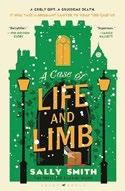
Sir Gabriel Ward’s second unofficial encounter with murder in London’s Inner Temple begins with several limbs before claiming any lives.
As 1901 passes into 1902, someone is marking the change by sending body parts with cheeky notes to barristers who live in London’s inner sanctum. Sir William Waring, Master Treasurer and head of the Inner Temple, receives the first note—“Can I give you a hand? ” paired with an appropriate parcel. Publicity hound Sir Edward Hopkins gets “Don’t put your foot in it ” and a skeletal foot. But the third delivery—“A word in your ear ”— claims a living victim in Reverend Master Hugh Vernon-Osbert, of the Temple Church, who suffers a fatal heart attack in response. Gabriel, meanwhile, has been sought out by Topsy Tillotson, a chorus girl turned musical star, to prosecute her libel case against Lionel Sullivan’s scruffy tabloid Nation’s Voice, which has announced that she’s surrendered her virtue to the Hon. Frederick Sewell, a manabout-town she claims she’s never met. Gabriel will work once more with PC Maurice Wright on both cases, linking one of them to a 10-year-old murder, as all parties, especially Gabriel himself, strive to keep their upper lips stiff. The setting, the characters, the tone, and the methodical dispersal of clues to the sins the stuffy cast is hiding are well up to the high bar of Gabriel’s debut in A Case of Mice and Murder (2025); only the final unmasking of the eminently predictable killer falls short. Sedate legal thrills set in allegedly quieter times and quarters that can still deliver unseemly jolts.
Sullivan, Tim | Atlantic Crime (272 pp.) | $17 paper | January 13, 2026 | 9780802167774
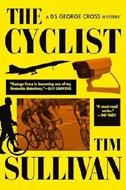
An unconventional British sleuth probes the murder of a drug-taking gym rat.
DS George Cross and partner DS Josie Ottey of the Somerset and Avon police are called to a construction site to examine a recently discovered corpse. The case is challenging and complicated from the start, beginning with the need to appease an indignant contractor and identify the young victim. Cross, who’s on the autism spectrum, exhibits an unflappable nature and Holmesian observational skills that show he’s fully up to the task. Noting the victim’s low body fat, overdeveloped thighs, distinctive tan lines on his arms and legs, and lack of calluses on his hands, he pegs the man as a cyclist, “possibly professional.” The tangled investigative path into Alex Paphides’ murder begins at the Avon Cycling Club and proceeds with evocative precision through multiple locations and persons of interest: the gym where he pumped up, a girlfriend who seems to be missing, and the chemist who supplied him with performance-enhancing drugs. Sullivan’s second DS Cross mystery deftly combines multiple genre tropes. At heart, it’s a police procedural whose focus widens to include Cross’ wrangles with his superiors and his personal life, his caring but somewhat formal relationship with his elderly father, and his escape from the pressures of his job by playing the organ at church. Sullivan’s omniscient narration shrewdly matches his protagonist’s measured, exacting nature, providing both a pace and a distance that will engage the armchair sleuth. Cross’ brusque, dispassionate brilliance regularly frustrates Ottey, who’s cast in the thankless role of apologist.
A compelling character portrait folded into a meticulous mystery.

1 Hunchback
By Saou Ichikawa; trans. by Polly Barton
Audacious, insightful, bold, and—with its critique of ableism— necessary.
2 The Wax Child By Olga Ravn; trans. by Martin Aitken
A magnificent book. A true masterpiece of both substance and style.
3
I Gave You Eyes and You Looked Toward Darkness
By Irene Solà; trans. by Mara Faye Lethem
A fabulous achievement, at once sweeping and sly, raunchy and richly compelling.
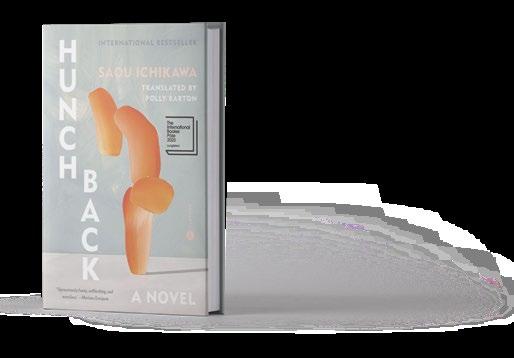

4 The Old Man by the Sea
By Domenico Starnone; trans. by Oonagh Stransky
A deceptively simple work and an exquisite addition to Starnone’s oeuvre.
5 House of Day, House of Night By Olga Tokarczuk; trans. by Antonia Lloyd-Jones
An exquisitely constructed, mercurial gem from the Nobel prizewinner.



The author of Minor Black Figures answers our questions.
ART, SEX, LOVE, faith, identity—a lot is going on in Brandon Taylor’s latest novel, Minor Black Figures . But like the great painters he admires— see below—his work acquires its depth in the small, detailed brushstrokes. It’s the story of a young Black artist in New York who basks in a flash of social media attention but is mostly struggling when he encounters a young ex-priest. Their affair animates the plot, but readers will stay for the author’s pointed observations; our starred review praised the novel’s “seductive intellectual energy.” Should it come as a surprise, then, that Taylor wrote a large chunk of it in Paris? He told us more by email.
who inspired you in writing the book?
I had recently been to London on a brief trip while I was in Paris, and I’d seen John Singer Sargent’s paintings there. A lot of that feeling of standing before Sargent’s paintings went into the book. But I also came across these huge Turner seascapes, and I was so flattened by their intensity and immensity and scale, that I wanted to do something similar with my novel.


What was the original idea, character, or scene that started you working on the book?
I wanted to write a book that would give me an excuse to describe things, because I’d worked on two very severe books that didn’t call for much description between The Late Americans and what became Minor Black Figures . I wanted to write description, specifically of art and movies, so it seemed like a painter would be the most expedient. Also, I wanted to write about how ugly I find a lot of contemporary painting, and a painter character was useful in that regard. I also wanted to write a priest. So with those two dubious desires, I set out to write a novel.
Minor Black Figures is full of wonderful detail about artmaking. Were there artworks and/or artists
Aside from the artwork mentioned above, what kept you going while writing the book? What were you reading, listening to, watching? I wrote the first hundred pages of the novel while I was staying in Paris, and I took two breaks—one in the afternoon, one in the evening—and I’d take a long walk around Les Halles or into the Marais. After I finished for the day, I watched a lot of movies and French crime procedurals. I love French and British procedurals. And I read Zola. I also listened to a lot of nocturnes. Chopin, Field, and some late Bach piano works. And I made my way through a lot of Bergman I hadn’t seen before. Which I imagine also made its way into the book.
What was most challenging about writing this book? And most rewarding?
The most challenging aspect of writing this novel was setting the proper scale—a scale that would let me speak with the voice of the world but also remain personal to the characters. That balance took a long time, but it was also the most rewarding aspect of writing the
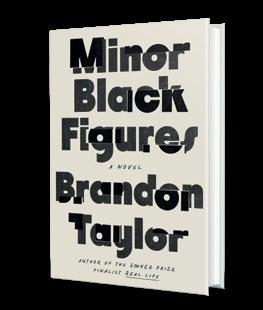
Taylor, Brandon Riverhead | 320 pp. | $29 October 14, 2025 | 9780593332368
book. That and the paperwork movie montage I snuck in there.
What book or books published in 2025 were among your favorites? Erin Somers has a new novel out called The Ten Year Affair that is so incredibly funny and astute, and very profound. I loved it. Also, shoutout to Jordan Castro’s Muscle Man, a very mischievous novel. And Lincoln Michel’s Metallic Realms , a wonderful novel for anyone who loves lore dives.
Interview by Tom Beer


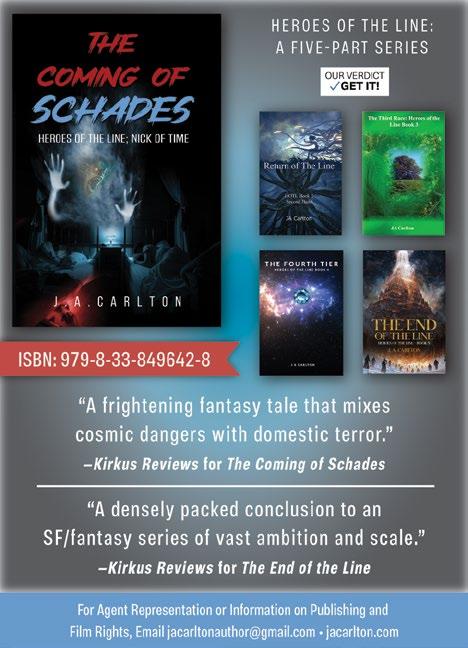

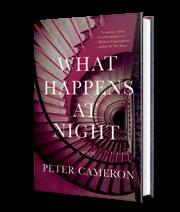
The movie will be based on Peter Cameron’s 2020 novel.
Martin Scorsese will direct a film adaptation of Peter Cameron’s What Happens at Night, Deadline reports.
Cameron’s novel, published in 2020 by Catapult, follows an American couple who travel to Europe to adopt a baby and find themselves in a land populated by bizarre characters where nothing is as it seems. In a starred review, a critic for Kirkus called the book “a dreamy fable confronting love, death, and our inevitable inadequacy yet persistence in the face of both.”
Leonardo DiCaprio, who’s worked with Scorsese on films such as The Aviator and The Wolf of Wall Street, is attached to star alongside Jennifer Lawrence, whose latest movie, Die, My Love, was released in theaters this
month. Patrick Marber ( Asylum, Notes on a Scandal ) will write the screenplay.
Scorsese’s previous literary adaptations include films based on Edith Wharton’s The Age of Innocence, Joe Connelly’s Bringing Out the Dead, Dennis Lehane’s Shutter Island, and David Grann’s Killers of the Flower Moon
Cameron’s novels have been adapted for the screen before. His novel The City of Your Final Destination

was made into a 2009 film directed by James Ivory and starring Anthony Hopkins and Laura Linney, while Someday This Pain Will Be Useful to You formed the basis for a 2011 movie directed by Roberto Faenza and starring Toby Regbo and Marcia Gay Harden. —M.S.


Cole, Kamilah | Poisoned Pen (432 pp.)
$17.99 paper | December 30, 2025
9781464216909

A child of Mandeville, Jamaica, and Astoria, Queens, Ellory Morgan is determined to get the credentials she needs from America’s youngest and strangest Ivy League college, even if she’ll never belong and danger lurks at every turn.
A 21-year-old freshman, Ellory is significantly older than her classmates. Between her age, lower-middle-class poverty (she’s on scholarship), and race, she keenly feels her distance from her peers, many of whom seem to have always known each other. Tangling with the insufferably handsome and entitled Hudson Graves, who “loomed over the freshmen like an angry god” at the library that bears his family name, only worsens her misgivings. But what really cinches Ellory’s unease at Warren is the magic. Buildings, even neighborhoods, seem to shift around; a soccer ball hurtling toward her stops just before impact, and a tattoo appears on her shoulder and disappears just as easily. Ellory had experienced strange occurrences in childhood, but on campus, the magic is inescapable—and so is the danger. To graduate, Ellory will have to watch her back as closely as her books and maybe even make peace with her most inscrutable rival. Connoisseurs of rivals-to-lovers stories will appreciate the palpable tension between Ellory and Hudson. Their chemistry is equally palpable. Cole’s writing is vivid and creative, sometimes even poetic. She excels at conjuring Warren’s special cocktail of sinister spookiness and academic intensity. The campus is deliciously dark and believably shrouded in lore and rumors of missing undergraduates. But Ellory’s relentless insecurity in the face of her ongoing success grows
repetitive, as do the book’s frequent social critiques, which often lack nuance. For example, since students from underrepresented groups are routinely challenged for not having earned their places in elite colleges, an observation regarding privilege in these spaces seems awkward: “The wealthy bought their way in. The poor begged their way in. Both groups were praised for their admission as if their journeys had been equal.”
Will appeal to readers who crave its melding of fantasy and dark academia, but its spell could use a bit more seasoning.
Islington, James | Saga/Simon & Schuster (736 pp.) | $30.99 | November 11, 2025 9781982141233 | Series: Hierarchy, 2
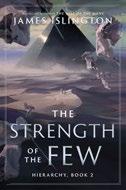
When Vis is copied into two other realities, he must stop a god from repeatedly culling almost everyone back home. Thousands of years ago, to prevent the Concurrence from enslaving everyone, the world was split into three near-identical copies: Res, Obiteum, and Luceum. To exist in all three worlds, to wield Will there, is to achieve synchronism.
After the events in The Will of the Many (2023), which cost Vis his arm and the life of his friend, Vis achieves Synchronism. While Res-Vis must continue to play Hierarchy politics to find his friend’s killer, Obiteum-Vis finds a ruined world, where the dead are reanimated and used by Ka, the Concurrence, and the only other person to exist in synchronism. Meanwhile, Luceum-Vis is forced into a dispute between druids, their High Council, and their kings—with one king intent on killing him—and Vis has no idea why. On all worlds, Vis is as shrewd as ever, weighing his options, planning ahead, and doing what he must to survive. However, he,
too, slowly diverges, doing things he swore he never would: cede his Will, use Will to control someone else, and reveal his true name. If at least one Vis cannot use his synchronism and power of Will to kill the Concurrence, no Vis will be safe, and another Cataclysm will cull those he loves on Res. Book Two of the Hierarchy series is a speculative fantasy that is at once Egyptian post-apocalyptic, Celtic medieval, and Roman dystopian, thanks to the multidimensional setting. Although the sprawling narrative at times overextends itself, Islington rewards patient readers with a compelling story, a cast of complex and diverse characters, and a glimpse into how far a good man can go before he’s lost. A symbol at the start of each chapter delineates which world and Vis it’s about. Readers should read The Will of the Many before attempting this volume, or they may be confused for the first several chapters and beyond. A unique concept that promises readers will find at least one, if not three, entwined but different narratives to enjoy.
King, Crystal | Harlequin MIRA (400 pp.) $30 | December 2, 2025 | 9780778387275

A scholar’s dream job turns sinister when she finds herself at the mercy of gods.
Aida Reale, a 34-year-old historian in Boston, is dealing with a series of career setbacks—since being laid off from her university teaching job, she also lost a book deal after her publisher folded—when she receives a mysterious job offer. Her friend Felix Goodman, a tour guide in Rome, has recommended her to his rich client, Lady Ozie. Ozie’s organization, MODA, is hiring a scholar to build a historical database of places, items, and events in Italy. Impressed by Aida’s
academic research, they offer her the job, complete with a gorgeous apartment in Rome and a $400,000 salary. Though Aida is reluctant to leave her fiancé, Graham Pechman, the opportunity proves too good to pass up. When she arrives in Rome, she learns the odd nature of the work: From the Casa di Goethe to the Colosseum, Aida is tasked with cataloging happiness, observing how each place she studies brings joy to the world. At first, Aida is invigorated, but she soon chafes against MODA’s strict protocols, including phone tapping and constant location monitoring. When Aida is shocked to realize that every site she visits is soon shuttered or destroyed, she uncovers the dark truth—her employers are gods, and she has been an unwitting pawn in their mission to plunge the world into total despair. Author King has concocted a wholly unique premise, supported by her obvious delight in imparting the rich history of Rome’s many marvels and a deep knowledge of Greek and Roman mythology. But once MODA’s true machinations come to light, she struggles to build the propulsive pace the plot deserves. Aida’s relationship with Graham also proves extraneous to the narrative, and space dedicated to it would have been better utilized by fleshing out other characters and Aida’s connections to them—particularly fellow MODA “Happiness Collector“ Luciano Leto. An innovative take on the eternal battle between gods and mortals.
Liu, Ken | Saga/Simon & Schuster (416 pp.) $30 | October 14, 2025 | 9781668083178
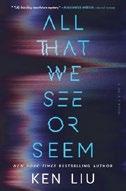
The first installment of Liu’s Julia Z saga is an SF thriller set in a near-future “post-truth age” where the use of AI and the inundation of digital disinformation and data pollution have blurred
the lines between delusion and reality. Julia—whose immigrant mother, a divisive political activist, was murdered during a border protest— has lived on her own since she was 14. A brilliant hacker now 23, she’s been trying to live in online anonymity, acutely aware of the multitude of ways she can be identified and tracked. Living in a Boston suburb and struggling to make ends meet, she inadvertently becomes entangled with a lawyer named Piers Neri and his search for his artist wife, Elli Krantz—famous for her experimental work in vivid dreaming—who may or may not have been kidnapped. A prime suspect in his wife’s disappearance, Piers goes on the run with the help of Julia—and together, they begin putting together pieces of a mind-bogglingly intricate puzzle that links Elli to a powerful criminal with a global reach. As Julia digs deeper into the appeal of vivid dreaming and the criminal’s ruthless endeavors, she discovers the sham that is the American Dream: “America was corrupt and steeped in sin. The powerful had rigged the game for themselves and turned the country into a panopticon to imprison the rest of us. Anytime one of the powerless—it didn’t matter the color of your skin, the language you spoke, the place you were born in—was on the verge of climbing out, they would be ruthlessly tossed back into the pit.” And amid the backdrop of dealing with unresolved childhood trauma and the need to find her place in the world, she finds something unexpected—herself. Equal parts biting social commentary and page-turning thriller, a disturbing glimpse into humankind’s possible future.
Roberts, Nora | St. Martin’s (464 pp.) | $30 November 18, 2025 | 9781250288790
Series: Lost Bride Trilogy, 3

A trilogy about a haunted house in Maine meanders to a close.
In the first two books of the Lost Brides trilogy, Roberts introduced readers to Sonya MacTavish, a Boston graphic designer with a cheating fiancé. Then, an uncle Sonya didn’t know existed, a man named Collin Poole, died and left her a gorgeous mansion on the coast of Maine. Sonya and her best friend, Cleo Fabares, moved into the house, only to discover it was haunted by the spirit of a 19th-century witch named Hester Dobbs. Starting in 1806, Dobbs murdered generation after generation of women who married into the Poole family, using the wedding rings of the murdered women as talismans that help her consolidate her power over the mansion. The ghosts of the seven murdered brides and other people killed by Dobbs also inhabit the house, and they want to help Sonya and Cleo, along with Sonya’s lover, Trey Doyle, and her cousin Owen Poole, in their quest to exorcise Dobbs from the property and keep her from killing again. Unfortunately, as this plot was well-established in the first two books of the series, there’s little left for Sonya and her cadre of pals to do. Sonya and Cleo spend much of their time cleaning out the attic and basement rooms, finding clues and information about the dead women. This feels like filler, with repetitive and boring scenes that offer only dribs and drabs of information about the family and the
In a near-future age, the lines between delusion and reality have been blurred. ALL THAT WE SEE OR SEEM
YOURS FOR THE SEASON
house’s history, but do little to illuminate anything new or interesting about Sonya or Hester Dobbs as her nemesis. The plotting is glacially slow until the final battle, which the author rushes to the point of being underwritten. A promising series ends not with a bang, but a whimper.
Connolly, Lauren | Berkley (400 pp.) | $19 paper December 16, 2025 | 9780593815687

B eth Lundberg can’t pass up the opportunity for free flight lessons, even if the instructor is her half brother’s grumpy best friend.
Although she’s dreamed of getting her pilot’s license for years, Beth has been too busy waitressing in a diner outside Arlington so she can pay for her mom’s medical bills and the mortgage on their fixer-upper house. When her beloved, wealthy brother arranges for his friend George Bunsen to give Beth a flight in his plane, she’s thrilled to be up in the air, until engine failure leads to George having to execute an emergency landing. Beth is terrified by the situation but turned on by his composure. She’s shocked to find that she’s crushing on a man who actively tries to ignore her most of the time, and when he offers to teach her to fly—for free—she can’t say no. She tries to balance her time between flying and work, but she also worries about the ticking countdown to when she’ll have to admit a secret she’s been keeping from her brother. Also, her libido is out of control around her stoic instructor, and the closer she gets to him, the more enamored she becomes.
Go-getter, people-pleasing Beth is relatable as she tries so hard to keep everything
under control and provide for her loved ones while also yearning to pursue her dreams. Her desire for hot pilot George is entertaining, but the driving conflicts in this story don’t feel plausible, and it’s frustrating that the tension relies on secrets that could easily be hashed out through open conversation. Connolly thoughtfully handles elements of class and gender, and the sibling relationship is adorable; however, there’s not enough push-pull in the central romantic relationship to make it feel fully formed.
The female main character is compelling, but the story lacks momentum.
Star
Yours for the Season
Jalaluddin, Uzma | Mindy’s Book Studio (287 pp.) | $28.99 | December 1, 2025 9781662533044

Jalaluddin delivers romance treasure: a plausible fake-dating premise and a surfeit of laughout-loud moments.
Atlanta singletons Sameera Malik and Tom Cooke are navigating professional turbulence while nursing wounds from relationship rifts. When their paths cross at Sameera’s firm’s holiday party, chemistry sparks—but it’s professional synergy that prompts their connection. Layoffs are coming at the boutique law firm where Sameera works as an associate, putting her job and independence in jeopardy. Tom is a chef who uses YouTube to drum up catering business while dreaming of hosting his own TV cooking show. A decline in his online engagement jeopardizes both sides of his livelihood. So after some motherly intervention
places Tom in Sameera’s path a second time—sensing the barest whiff of a secret romance, Tahsin Malik hires him to cater her party for Eid—Tom captures the spunky attorney in a video, and it’s a hit. Recognizing that he got “more attention from that candid video…than any others in the past six months,” he and Sameera negotiate a deal. She’ll fake date him for two months and record six videos, and Tom will smooth the way for his wealthy best friend Andy Shaikh to become Sameera’s prospective client. Precarity also stokes Sameera’s insecurity, since she’s already feeling like the black sheep of her successful Muslim Desi family— with a sister pursuing a Ph.D. at Oxford and a father retired as head of neurosurgery at Emory, “if she wasn’t an associate at the [law firm], who was she? Nobody.” Just when you might worry that the book is so realistic as to lack the fun and froth of a great holiday rom-com, Jalaluddin ups the family shenanigans to 11 as Sameera’s mother and Tom’s stepmom hijack the proceedings like matchmaking mamas from the Regency era. Soon, the entire Malik family embarks on a meet-the-parents holiday jaunt at Tom’s fabulous family estate in Alaska, where they’re practically royalty, and hijinks and culture clashes and shady side deals ensue. An intercultural holiday rom-com that fully nails the promise of its premise.
LaQuette | St. Martin’s (336 pp.) | $19 paper | January 6, 2026 | 9781250773418

A single mom reconnects with her secret high school crush, 25 years after graduation. After years in a controlling marriage, followed by drawn-out, bitter divorce proceedings, nurse anesthetist Janae Sanders has finally found peace and receives love and support from her best friends in the “Savvy, Sexy, and Single Club.” When former NBA star turned educator Adam Henderson returns to their small
Pennsylvania town, old feelings come rushing back, but Janae has no time for romance—not when her 15-year-old son’s beloved dance and fashion design extracurriculars are cut due to budget constraints. As the PTA president, Janae is ready to fight the new interim superintendent to reinstate the arts programs, only to discover that the person in that role is none other than Adam. He proposes a weekend cabin getaway so they can work together to find alternative funding—and acknowledge the obvious attraction and unresolved feelings between them. Janae and Adam are both thoughtful, emotionally mature adults who are open about their priorities and desires. This means there isn’t much conflict between them, so tension in the book comes more from the fraught relationships they each have with a parent: Janae’s mom critiques her daughter for being bold and big (qualities Janae loves about herself), and Adam’s father always pushed his son into basketball and can’t understand why he gave that up. Janae strives to be a very different type of parent, showing her son full support to pursue his artistic dreams. Janae and Adam’s budding romance is sweet and sexy, and it’s satisfying to watch them advocate for themselves and each other in this story that showcases the importance of being true to oneself and encouraging loved ones to pave their own paths. A gratifying romance between kind, confident, deserving leads.
Like a Victorian
Reeves, Amy Carol | Canary Street Press (320 pp.) | $18.99 paper | December 9, 2025 9781335014061

An indie YA author makes her adult romance debut.
After Lizzie Wells loses her husband, the professor of British literature finds the structure she needs to begin living the rest of her life in Victorian mourning customs. She goes on a “widow shopping spree for black
clothes.” She puts a lock of her husband’s hair in a locket and wears a pendant marked with his fingerprint. She carries a tiny urn filled with his ashes in her handbag. She buys black-edged stationery and lets her students and colleagues know that she will not be answering email and only communicating via paper for “an undetermined time period.” Watching an independent, 21st-century woman with a thriving career try to follow rules created for women whose entire identities were bound to their husbands could have made for a great novel, but this is about as far as Lizzie gets in adopting Victorian mourning customs. She acknowledges as much when she says that “proper grief stationery, black clothes, [and] keepsake jewelry” are gestures toward the full package. Much like her heroine, Reeves seems to think that gestures toward the premise she created are sufficient to fulfill its promise. Lizzie does occasionally remember to ask herself, “What would a Victorian widow do?” But most of what she does throughout the entire novel is not what a Victorian widow would do. A Victorian widow would not go to work, for example. A Victorian widow would not almost kiss her husband’s best friend in large part because a Victorian widow would not be sitting on a sofa next to her husband’s best friend, unchaperoned, in the first place. And if black leggings qualify as widow’s weeds, then every woman who has ever taken a barre class is in deep mourning. The conceit becomes tiresome quickly, but it does serve as a distraction from what is otherwise a lackluster and slightly preposterous love story. These complaints may seem pedantic, but what could have been a fun crossover novel for fans of contemporary romance and historical romance is unlikely to satisfy either.
A rich concept barely executed.

Wibberley, Emily & Austin SiegemundBroka | Berkley (352 pp.) | $19 paper
December 9, 2025 | 9780593954263

For more romance reviews, visit Kirkus online.
Two drifting people find love while putting their (literal) ghosts to rest. Morgan has been a nomad all her adult life, haunted by past failures and seeking new places to escape them by taking landscaping jobs around the country. But being followed by the ghost of Zach, a one-time hookup, is a new experience even for her. Then she meets Sawyer, who’s been mourning his fiancée, Kennedy, and clinging to her ghost in the house in Los Angeles’ Silver Lake neighborhood they’d planned to redesign together. In trying to free both their ethereal companions and themselves, Morgan and Sawyer agree to work together. Sawyer will let Morgan stay in the studio attached to his haunted house and help her figure out her ex’s unfulfilled wishes so Zach’s ghost can pass on; Morgan will landscape the garden Sawyer planned to create with his fiancée so Kennedy’s spirit can be at peace. As they crisscross Los Angeles in their quixotic quest, Sawyer starts to develop feelings for the free-spirited Morgan even as he fears losing his tie to a happy past. Morgan, meanwhile, is thinking of putting down roots, drawn to Sawyer as he puts himself back together. For a new love to grow, both need to conquer their fear of loss. Despite long meditations on death and grief, the novel has some funny moments, thanks to Zach, who used to be a surfer. The third act breakup and subsequent resolution bogs down the narrative’s early momentum and could have used some pruning. The L.A. setting is integral to the plot, serving almost as a character; the location and its careful use in the narrative feel like a rarity in contemporary romance at the moment. For readers looking for a sentimental romance with ghostly leanings.

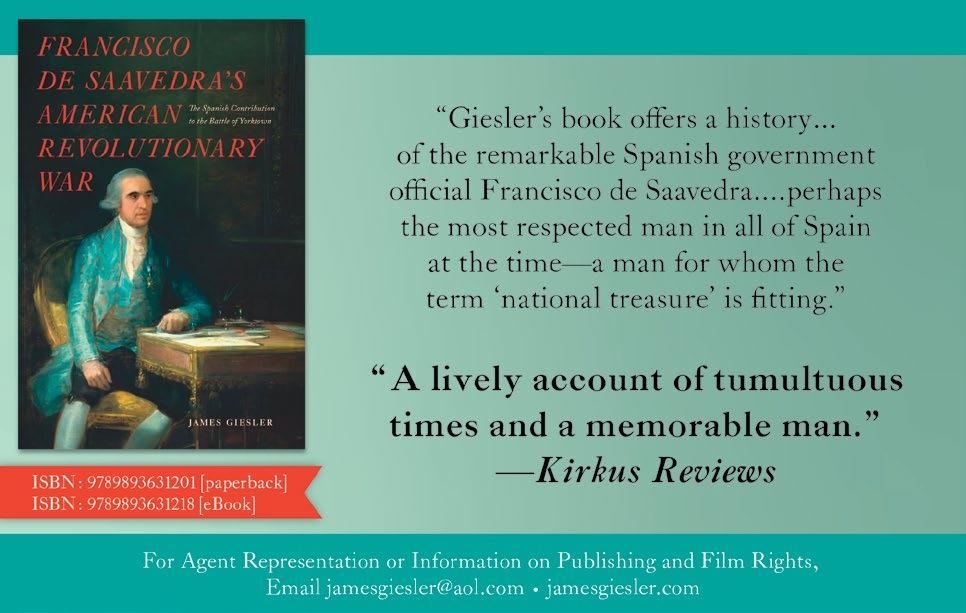


EDITORS’ PICKS:
Freedom Seeker by Ruchira Gupta (Scholastic)
Make New Friends by Joshua David Stein, illus. by Mariachiara Di Giorgio (Abrams)
The Book of Guilt by Catherine Chidgey (Cardinal)
THANKS TO OUR SPONSORS:
A Lionhearted Approach for Parent Coaching by Lisa Veshee
Stopping To Feel by S.L. Collins
Surviving a Psychopath: In Court. In Life. In “Love.” by Kerrie Droban
Nick and Lorraine Were Lovers by David C. Metz
Fully Booked is produced by Cabel Adkins Audio and Megan Labrise.
BY MEGAN LABRISE
ON THIS EPISODE of Fully Booked , Leni Zumas joins us to discuss Wolf Bells (Algonquin, September 16). “A young girl and her autistic cousin seek refuge in an intergenerational community,” Kirkus writes in a review of this “tender and well-told story about the meaning of family.” Zumas is the author of the bestselling novel Red Clocks, winner of the 2019 Oregon Book Award for Fiction and a finalist for both the Orwell Prize for Political Fiction and the Neukom Award for Speculative Fiction. Her other books include the story collection Farewell Navigator and the novel The Listeners. She was a finalist for the 2021 John Dos Passos Prize for Literature. She lives in Portland, Oregon, where she is a professor in the creative writing program at Portland State University. Here’s a bit more from our review of Wolf Bells : “In the house her great-grandfather built, Caz, a musician, runs a home for the elderly, where she also invites young people to live rent-free in exchange for household chores and company for the senior citizens, who include her own ailing mother. In her youth, she fronted a popular punk band, and now she teaches music classes in the community. One night, one of her students, Nola, appears on Caz’s doorstep with her disabled cousin, James, in tow.…James is nonverbal, requires diapers, and has specific dietary needs, which is to say, he needs a lot of support. Understanding this, the residents of the Island of Misfit Toys that is Caz’s community offer Nola and James safe harbor as best they can. From the first sentence, you know you’re in the hands of a novelist with the ear of a very good poet. More than that, Zumas



Wolf Bells Zumas, Leni Algonquin | 224 pp. | $28 September 16, 2025 | 9781643756578
seamlessly balances the novel’s lyricism with character building, backstory, and forward momentum.…Zumas also finds a way to capture the way James experiences the world with creativity and care.”
Zumas and I discuss communities of care, social safety nets, whether to apply the word utopian to Caz’s vision, the rhythm of language, the value of human life beyond productivity metrics, and much more.
Then editors Laura Simeon, Mahnaz Dar, and Laurie Muchnick share their top picks in books for the week.

To listen to the episode, visit Kirkus online.




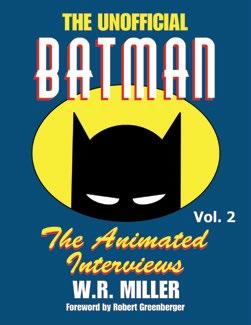




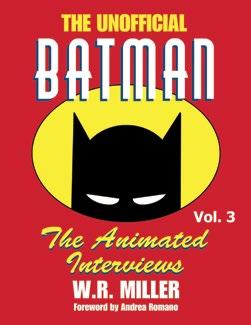








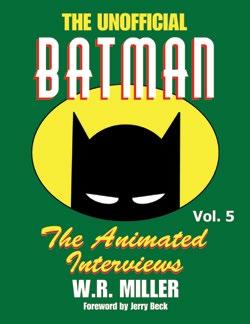




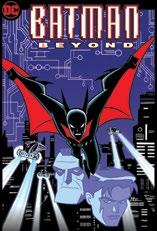

From A to Z, Rick Atkinson to Daniel E. Zoughbie, this year’s list of best nonfiction books represents a spectrum of genres, including biography, memoir, and true crime. Our list has familiar names—Ron Chernow, Susan Orlean, and Mary Roach, to name a few—but there are several authors with exemplary debuts, among them Bench Ansfield, Nicholas Boggs, and Chloe Dalton. Let’s hope they’re already working on their second books.





To Lose a War: The Fall and Rise of the Taliban
Anderson, Jon Lee | Penguin Press (371 pp.)
$40 | August 12, 2025 | 9780593493090
Essential for understanding the futility of America’s longest war.
Anderson, Scott | Doubleday (481 pp.)
$35 | August 5, 2025 | 9780385548076
An eye-opening history of how Iran became a point on the “axis of evil” and is considered such a dangerous enemy today.
Born in Flames: The Business of Arson and the Remaking of the American City
Ansfield, Bench | Norton (352 pp.) | $31.99
August 19, 2025 | 9781324093510
A vital history of racial discrimination in the insurance market—and the fires that followed.
Atkinson, Rick | Crown (880 pp.)
$42 | April 29, 2025 | 9780593799185
As ever with Atkinson, an exemplary work of narrative history.
Atwood, Margaret | Doubleday (608 pp.)
$35 | November 4, 2025 | 9780385547512
Engaging, wise, and marvelously witty—illuminating both the craft of writing and the art of living.

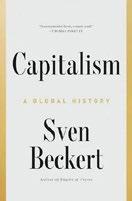
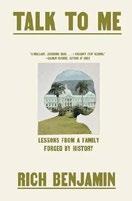


More Everything Forever: AI Overlords, Space Empires, and Silicon Valley’s Crusade To Control the Fate of Humanity
Becker, Adam | Basic Books (384 pp.)
$32 | April 22, 2025 | 9781541619593
An important and sober investigation of Silicon Valley’s boldest claims about the future.
Beckert, Sven | Penguin Press (1,344 pp.)
$49 | November 25, 2025 | 9780735220836
A comprehensive and up-to-date history, essential for students of world systems.
Talk to Me: Lessons From a Family
Benjamin, Rich | Pantheon (320 pp.) | $29 February 11, 2025 | 9780593317396
An evocative, wise memoir of a multilayered search for roots.
Boggs, Nicholas | Farrar, Straus and Giroux (710 pp.) | $35 | August 19, 2025 9780374178710
A dynamic portrait that deepens our understanding of a complex artist.
Bonét, Sasha | Knopf (320 pp.) | $30 September 16, 2025 | 9780593536087
A fresh contribution to Black history, rooted in the author’s past.
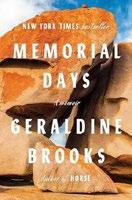
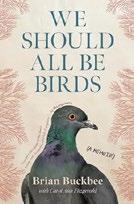
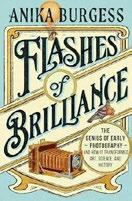
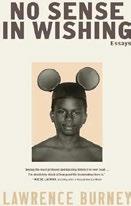

Brooks, Geraldine | Viking (224 pp.)
$28 | February 4, 2025 | 9780593653982
A graceful and moving meditation on bereavement.

Buckbee, Brian with Carol Ann Fitzgerald Tin House (256 pp.) | $28.95 August 5, 2025 | 9781963108293
An extraordinary story full of humanity and life lessons from a man whose disability has largely removed him from society.
Burgess, Anika | Norton (320 pp.) | $35 July 8, 2025 | 9781324051107
A scintillating history that’ll have you looking at photography in a new light.
Burney, Lawrence | Atria (256 pp.)
$29.99 | July 8, 2025 | 9781668051856
Fluent, sometimes nerdy, and often funny observations about the power of art to add meaning to one’s life.
Bustamante, Andrew & Jihi Bustamante Little, Brown (272 pp.) | $32 September 9, 2025 | 9780316572149
A gripping espionage yarn that happily contradicts the authors’ advice for crafting a cover story: “Make it boring as hell.”
Carlin, Peter Ames | Doubleday (256 pp.) $30 | August 5, 2025 | 9780385551533
An admirably comprehensive study of a masterpiece and its creation.
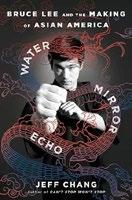
Chang, Jeff | Mariner Books (560 pp.) | $35 September 23, 2025 | 9780358726470
A rousing portrait of a charismatic actor who redefined global stardom.
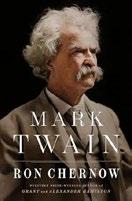
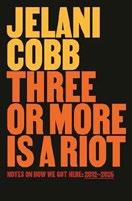

Mark Twain
Chernow, Ron | Penguin Press (1,174 pp.) $45 | May 13, 2025 | 9780525561729
Essential reading for any Twain buff and student of American literature.
Cobb, Jelani | One World/Random House (448 pp.) | $32 | October 14, 2025 9780593978207
Provocative, arguable, written with both bravado and great care: an exemplary collection.
Dalrymple, William | Bloomsbury (496 pp.) $32.99 | April 29, 2025 | 9781639734146
A passionate tribute to the glories—and influence—of ancient India.
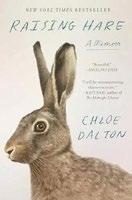
Dalton, Chloe | Pantheon (285 pp.) | $27 March 4, 2025 | 9780593701843
A soulful and gracefully written book about an animal’s power to rekindle curiosity.
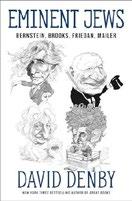
Denby, David | Henry Holt (400 pp.)
$32 | April 8, 2025 | 9781250193407
Richly detailed and thoroughly entertaining.



Claire McCardell: The Designer Who Set Women Free
Dickinson, Elizabeth Evitts
Simon & Schuster (336 pp.) | $29.99
June 17, 2025 | 9781668045237
Debut biographer Dickinson digs up buried treasure in this essential and inspiring account.
Elmhirst, Sophie | Riverhead (246 pp.)
$28 | July 8, 2025 | 9780593854280
A nimbly told story that should serve as a caution—but oddly, too, as inspiration—to would-be escapists.
The CIA Book Club: The Secret Mission To Win the Cold War With Forbidden Literature
English, Charlie | Random House (352 pp.)
$35 | July 1, 2025 | 9780593447901
A well-crafted book about books— and spooks, skullduggery, and a time when ideas mattered.

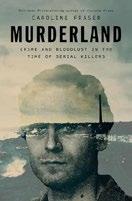
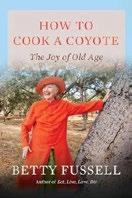


American Scare: Florida’s Hidden Cold War on Black and Queer Lives
Fieseler, Robert W. | Dutton (496 pp.)
$32 | June 17, 2025 | 9780593183953
An essential work of recovering queer history.
in the Time of Serial Killers
Fraser, Caroline | Penguin Press (480 pp.)
$32 | June 10, 2025 | 9780593657225
A true-crime story written with compassion, fury, and scientific sense.
Fussell, Betty | Counterpoint (256 pp.)
$26 | December 2, 2025 | 9781640097384
A pleasure to read, although, as Fussell warns, we know how it’s going to end.
Gayle, Caleb | Riverhead (304 pp.) | $33 August 12, 2025 | 9780593543795
A welcome contribution to the history of Black liberation and the struggle for civil rights.
a
Gilbert, Sophie | Penguin Press (352 pp.)
$30 | April 29, 2025 | 9780593656297
Essential cultural criticism. But brace yourself—it ain’t pretty.
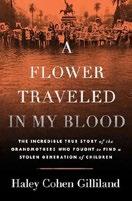

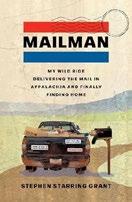
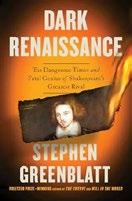

A Flower Traveled in My Blood: The Incredible True Story of the Grandmothers Who Fought To Find a Stolen Generation of Children
Gilliland, Haley Cohen | Avid Reader Press (416 pp.) | $30 | July 15, 2025
9781668017142
A piercing, emotional tribute to the value of persistent resistance.
América: A New History of the New World
Grandin, Greg | Penguin Press (737 pp.) $35 | April 22, 2025 | 9780593831250
An authoritative history of the debates and brutality that made our world.
Mailman: My Wild Ride Delivering the Mail in Appalachia and Finally Finding Home
Grant, Stephen Starring | Simon & Schuster (304 pp.) | $29.99
July 8, 2025 | 9781668018040
A charming book that’s guaranteed to make you think differently about the USPS.
Dark Renaissance: The Dangerous Times and Fatal Genius of Shakespeare’s Greatest Rival
Greenblatt, Stephen | Norton (336 pp.) | $31.99 | September 9, 2025 9780393882278
A scintillating biography of Christopher Marlowe by one of America’s leading humanities scholars.
Company: Private Equity and the Death of the American Dream
Greenwell, Megan | Dey Street/ HarperCollins (320 pp.) | $29.99 June 10, 2025 | 9780063299351
An effective, humane look at financial practices hobbling venerable institutions.

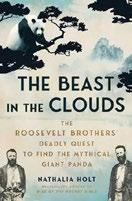

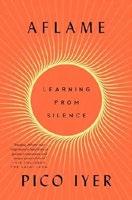
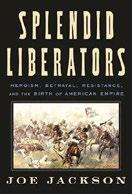
Hatmaker, Jen | Avid Reader Press (320 pp.) | $30 | September 23, 2025 9781668083680
Honest, engaging, and enjoyable as we watch the author stepping out from the shadows and reclaiming her life.
The Beast in the Clouds: The Roosevelt Brothers’ Deadly Quest To Find the Mythical Giant Panda
Holt, Nathalia | One Signal/Atria (288 pp.) $29.99 | July 1, 2025 | 9781668027745
Holt’s narrative brims with missteps and tragedy, but it’s a worthy addition to the history of scientific exploration.
The Killing Fields of East New York: The First Subprime Mortgage Scandal, a White-Collar Crime Spree, and the Collapse of an American Neighborhood
Horn, Stacy | Gillian Flynn/Zando (320 pp.) $28 | January 28, 2025 | 9781638931225
Solid in-depth reporting with a polemical kick.
Learning From Silence
Iyer, Pico | Riverhead (222 pp.) | $30 January 14, 2025 | 9780593420287
Essential reading for anyone interested in the monastic tradition and those who follow it.
Heroism, Betrayal, Resistance, and the Birth of American Empire
Jackson, Joe | Farrar, Straus and Giroux (816 pp.) | $35 | October 14, 2025 9780374191900
A splendid book, if centered on one of the most shameful episodes in American history.
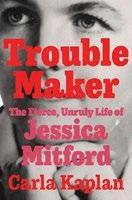
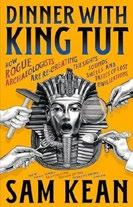
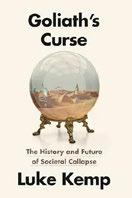
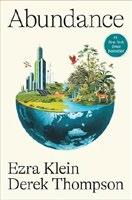

Troublemaker: The Fierce, Unruly Life of Jessica Mitford
Kaplan, Carla | Harper/HarperCollins (576 pp.) | $40 | November 25, 2025
9780061578946
A brisk, engaging biography.
With King Tut: How Rogue Archaeologists Are Recreating the Sights, Sounds, Smells, and Tastes of Lost Civilizations
Kean, Sam | Little, Brown (464 pp.)
$32.50 | July 8, 2025 | 9780316496551
A fast-paced, vividly written tale that brings lost civilizations into sharp focus.
Kemp, Luke | Knopf (304 pp.) | $30 September 23, 2025 | 9780593321355
An invigorating look at bigpicture history across continents and millennia, and a survival manual to boot.
Klein, Ezra & Derek Thompson
Avid Reader Press (288 pp.) | $30
March 18, 2025 | 9781668023488
Cogent, well-timed ideas for meeting today’s biggest challenges.
Knowles, Tina with Kevin Carr O’Leary
One World/Random House (432 pp.)
$35 | April 22, 2025 | 9780593597408
A great story of a singular American life.
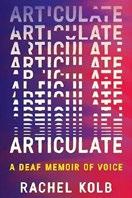



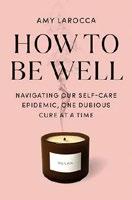
Kolb, Rachel | Ecco/HarperCollins (304 pp.) | $29.99 | September 16, 2025
9780063375185
An exquisite memoir about deafness that brilliantly shatters our ideas about language.
Kumekawa, Ian | Knopf (320 pp.)
$29 | May 6, 2025 | 9780593801475
A stellar account of a complex offshore world, as seen through the tangled history of a humble barge.
Kureishi, Hanif | Ecco/HarperCollins (336 pp.) | $28 | February 4, 2025 9780063360501
Refashioning his life after an accident—with grace, dignity, and black humor.
Lafon, Lola | Trans. by Lauren Elkin
Yale Univ. (184 pp.) | $25 November 18, 2025 | 9780300275889
A poignant historiography of Anne Frank’s writing and the author’s response to it.
To Be
Navigating Our Self-Care Epidemic, One Dubious Cure at a Time
Larocca, Amy | Knopf (272 pp.) | $28 May 13, 2025 | 9780525655534
Larocca takes on the wellness biz with healthy skepticism, and the result is eye-opening and good fun.

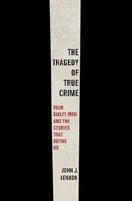
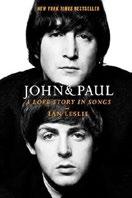
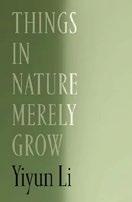

Leavitt, Danielle | Farrar, Straus and Giroux (320 pp.) | $30 | May 20, 2025 9780374614331
A vividly written, memorable series of profiles in courage and fierce resistance.
Lennon, John J. | Celadon Books (368 pp.) | $29.99 | September 23, 2025 9781250858245
Thoughtful, enlightening, and truth-seeking personal journalism.
Leslie, Ian | Celadon Books (448 pp.)
$30 | April 8, 2025 | 9781250869548
Fans will love this fresh, insightful approach to the band.
Li, Yiyun | Farrar, Straus and Giroux (192 pp.)
$26 | May 20, 2025 | 9780374617318
As bleak as winter fog at dusk, suggesting that one goes on after tragedy only because there’s nothing else one can do.
Lin, Lana | Dorothy (224 pp.) | $18 paper September 30, 2025 | 9781948980296
A fresh take on a dual biography.
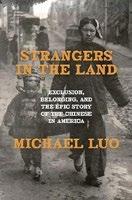

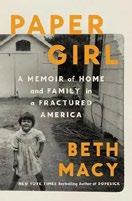

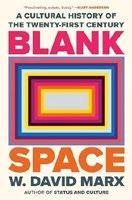
Luo, Michael | Doubleday (576 pp.)
$35 | April 29, 2025 | 9780385548571
An estimable and vital work of history that honors the Chinese American experience.
Macfarlane, Robert | Norton (384 pp.)
$31.99 | May 20, 2025 | 9780393242133
Are rivers alive? Macfarlane delivers a lucid, memorable argument in the affirmative.
Macy, Beth | Penguin Press (368 pp.)
$32 | October 7, 2025 | 9780593656730
By practicing the basic journalistic acts of listening and observing, Macy continues her noble work as a truth teller.
Mann, Sally | Abrams (272 pp.) | $35 September 9, 2025 | 9781419780714
Candid, irreverent, and engaging.
Marx, W. David | Viking (384 pp.) | $32 November 18, 2025 | 9780593833995
A wide-ranging, persuasive, readable treatise on a crucial component of modern life.

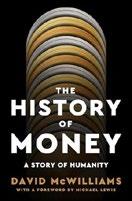
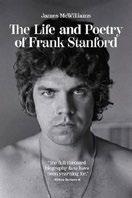
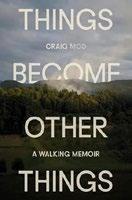

McNally, Keith | Gallery Books/
Simon & Schuster (320 pp.) | $29.99 May 6, 2025 | 9781668017647
Rueful, self-aware, chatty, entertaining, dazzling, and harrowing: a book that contains multitudes.
McWilliams, David | Henry Holt (416 pp.) | $32.99 | November 11, 2025
9781250408181
An absolute romp through history, with money—its uses and misuses—as the throughline.
McWilliams, James | Univ. of Arkansas (652 pp.) | $44.95 | July 1, 2025
9781682262726
The full-throated biography fans have been yearning for.
Mod, Craig | Random House (320 pp.)
$31 | May 6, 2025 | 9780593732540
Elegant and inspired: just the thing to read along with Basho and other pilgrims into Japan’s back country.
Year With the Seals: Unlocking the Secrets of the Sea’s Most Charismatic and Controversial Creatures
Morris, Alix | Algonquin (320 pp.)
$30 | July 15, 2025 | 9781643755014
A wondrous look at our love-hate relationship with the most human of animals.
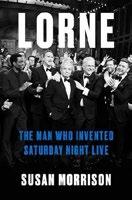
Morrison, Susan | Random House (640 pp.)
$36 | February 18, 2025 | 9780812988871
A top-shelf showbiz biography.
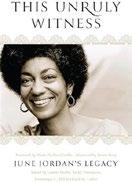
Ed. by Muller, Lauren, Becky Thompson, Dominique C. Hill & Durell M. Calliers
Haymarket Books (312 pp.) | $22.95 November 11, 2025 | 9798888904572
A deeply felt memorial.

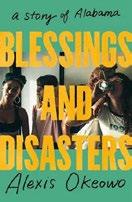

Right of the People: Democracy and the Case for a New American Founding
Nwanevu, Osita | Random House (288 pp.)
$31 | August 12, 2025 | 9780593449929
A resounding, persuasive call for a truly inclusive government of the people.
Okeowo, Alexis | Henry Holt (272 pp.)
$28.99 | August 5, 2025 | 9781250206220
Okeowo delivers a portrait of a past-haunted place that is at once empathetic, sad, and troubling.
Orlean, Susan | Avid Reader Press (353 pp.)
$32 | October 14, 2025 | 9781982135164
A spry, entertaining memoir/ writing workshop by a nonfiction artist at the top of her game.

Percy, Jen | Doubleday (272 pp.) | $29
November 11, 2025 | 9780385550048
A compassionate exploration of the history of assault against women.
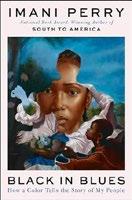
Perry, Imani | Ecco/HarperCollins (243 pp.)
$28.99 | January 28, 2025 | 9780062977397
An innovative cultural history.

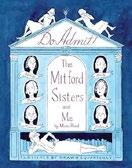
Plunkett, Adam | Farrar, Straus and Giroux (512 pp.) | $35 | February 18, 2025
9780374282080
A superb biography that neatly weaves in nuanced and insightful readings of many poems.
Pond, Mimi | Drawn & Quarterly (444 pp.)
$29.95 | September 16, 2025 9781770468047
Whimsical cartoons reveal passionate lives.

Ramírez, Marla A. | Harvard Univ. (368 pp.)
$29.95 | October 14, 2025 | 9780674295940
A timely and powerful book that exposes a shameful history.
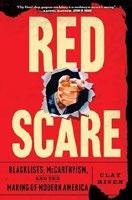

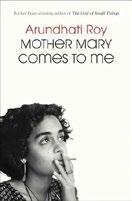
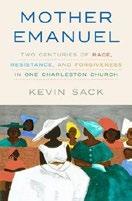

Risen, Clay | Scribner (480 pp.) | $31 March 18, 2025 | 9781982141806
An exemplary work of political and cultural history that invites a gimlet-eyed look at our own time.
Roach, Mary | Norton (288 pp.) | $28.99 September 16, 2025 | 9781324050629
An amiably entertaining, endlessly intriguing stroll through the stuff of which we’re made.
Roy, Arundhati | Scribner (352 pp.) | $30 September 2, 2025 | 9781668094716
An intimate, stirring chronicle.
Sack, Kevin | Crown (480 pp.) | $35 June 3, 2025 | 9781524761301
A sobering, expertly told history of the struggle for equality as waged from pulpit and pew.
Sands, Philippe | Knopf (480 pp.) | $35 October 7, 2025 | 9780593319758
An extraordinary exposé of the collusion of Nazis with the Pinochet dictatorship in Chile.

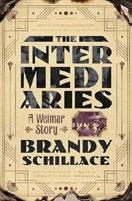
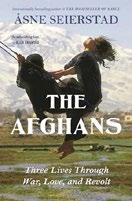

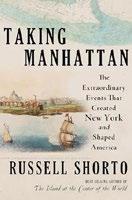
Ubac and Me: A Life of Love and Adventure With a French Mountain Dog
Sapin-Defour, Cédric | Trans. by Adriana Hunter | Summit/Simon & Schuster (224 pp.) | $28.99 | July 15, 2025
9781668088265
A book every dog lover will cherish, celebrating the unbreakable bond of canine and human.
Intermediaries: A Weimar Story
Schillace, Brandy | Norton (368 pp.)
$31.99 | May 13, 2025 | 9781324036319
A richly detailed, prodigiously researched history.


The Afghans: Three Lives Through War, Love, and Revolt
Seierstad, Åsne | Trans. by Seán Kinsella
Bloomsbury (448 pp.) | $32.99
August 5, 2025 | 9781639736263
Indelible portraits of people struggling to survive in a war-torn land.
A Life on Fire
Selby, River | Atlantic Monthly (304 pp.)
$27 | August 12, 2025 | 9780802149497
Selby molds personal and ecological acceptance into a moving narrative about fire and humanity.
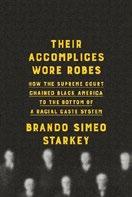
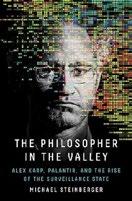
Taking Manhattan: The Extraordinary Events That Created New York and Shaped America
Shorto, Russell | Norton (352 pp.)
$29.99 | March 4, 2025 | 9780393881165
A bracing narrative of the international standoff that birthed America’s biggest city.
Smith, Zadie | Penguin Press (352 pp.)
$27 | October 28, 2025 | 9780593834688
A thoughtful, deft collection.
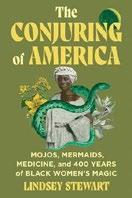
The Golden Hour: A Story of Family and Power in Hollywood
Specktor, Matthew | Ecco/ HarperCollins (416 pp.) | $32
April 22, 2025 | 9780063008335
A memoir that joins Peter Biskind, Joan Didion, William Goldman, and other top-shelf chroniclers of the L.A. film scene.
Their Accomplices Wore Robes: How the Supreme Court Chained Black America to the Bottom of a Racial Caste System
Starkey, Brando Simeo | Doubleday (688 pp.)
$35 | June 3, 2025 | 9780385547383
A powerfully argued study of a legal system that favors those who “persevere in undermining Black freedom.”
The Philosopher in the Valley: Alex Karp, Palantir, and the Rise of the Surveillance State
Steinberger, Michael | Avid Reader Press (320 pp.) | $32.50 | November 4, 2025 9781668012956
A chilling portrait of genius in the yoke of authoritarianism.
The Conjuring of America: Mojos, Mermaids, Medicine, and 400 Years of Black Women’s Magic
Stewart, Lindsey | Legacy Lit/ Hachette (400 pp.) | $30
July 29, 2025 | 9781538769508
An entertaining, informative contribution to Black history.
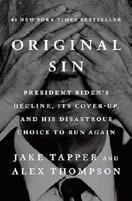
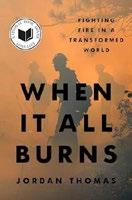
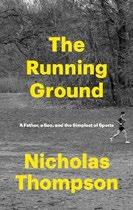

Original Sin: President Biden’s Decline, Its CoverUp, and His Disastrous Choice To Run Again
Tapper, Jake & Alex Thompson
Penguin Press (352 pp.) | $32
May 20, 2025 | 9798217060672
An authoritative indictment of a denial-plagued presidential run.

When It All Burns: Fighting Fire in a Transformed World
Thomas, Jordan | Riverhead (368 pp.)
$30 | May 27, 2025 | 9780593544822
Thinking about fire has never been more essential—Thomas charts a map toward the future.
The Running Ground: A Father, a Son, and the Simplest of Sports
Thompson, Nicholas | Random House (272 pp.) | $30 | October 28, 2025
9780593244128
An exemplary memoir of a life spent on the run.
Searches: Selfhood in the Digital Age
Vara, Vauhini | Pantheon (320 pp.)
$30 | April 8, 2025 | 9780593701522
An original essay collection about loss, technology, morality, and identity.

The Next One Is for You: A True Story of Guns, Country, and the IRA’s Secret American Army
Watkins, Ali | Little, Brown (336 pp.)
$30 | March 11, 2025 | 9780316538275
Engrossing, original fusion of true crime and geopolitics.
The Mission: The CIA in the 21st Century
Weiner, Tim | Mariner Books (336 pp.)
$35 | July 15, 2025 | 9780063270183
A singular triumph—an intimate chronicle of the CIA, its crises, and its opportunities since 9/11.
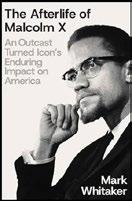
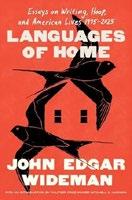
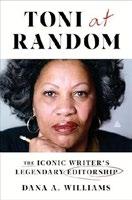

The Afterlife of Malcolm X: An Outcast Turned Icon’s Enduring Impact on America
Whitaker, Mark | Simon & Schuster (448 pp.) | $30.99 | May 13, 2025 9781668033296
A complex, thoughtfully written book that ably lives up to its title.
Languages of Home: Essays on Writing, Hoop, and American Lives 1971–2025
Wideman, John Edgar | Scribner (400 pp.) | $29 | November 18, 2025 9781668036372
Brittle and brilliant, a welcome record of Black life and thought in an often unwelcoming nation.
Toni at Random: The Iconic Writer’s Legendary Editorship
Williams, Dana A. | Amistad/ HarperCollins (368 pp.) | $32.99 June 17, 2025 | 9780063011977
A well-researched biographical study.
Kicking the Hornet’s Nest: U.S. Foreign Policy in the Middle East From Truman to Trump
Zoughbie, Daniel E. | Simon & Schuster (480 pp.) | $29.99 | October 7, 2025 9781668085226
A well-researched examination of how postwar presidential decisions destabilized the Middle East.
WE’RE WELL FAMILIAR with the expression May you live in interesting times. But the supposed curse never said anything about just how interesting the times should be. Can we all agree that they’ve been interesting enough? Can we have a bit of a breather?
Until the times get uninteresting, there’s plenty to keep us preoccupied. Mercifully, writers are here to help make sense of it all. Many of the books they’ve written about our current troubles are among the best of the year.
Let’s start with politics, shall we? It’s been a frenzied time for political books, understandably, and a few rise to the top for digging into issues and providing valuable context. One of them is Jake Tapper and Alex Thompson’s Original Sin: President Biden’s Decline, Its Cover-Up, and His Disastrous Choice To Run Again (Penguin Press, May 20). Interviewing roughly 200 people, Tapper and Thompson make a strong case that the former president’s loyalists were among “the chief deniers of his deterioration.”
Biden’s successor will certainly keep authors busy for years to come. Given President Trump’s defiance of norms—his attack on freedom of speech, his use of the Justice Department to exact retribution on foes—it’s worth reading Clay Risen’s Red Scare: Blacklists, McCarthyism, and the Making of Modern America (Scribner, March 18). Risen’s sober study is a window onto a past that is disturbingly familiar again. Less known to readers—but an important parallel to that history—is the Sunshine State’s assault on people’s freedoms, documented in Robert W. Fieseler’s powerful American Scare: Florida’s Hidden Cold War on Black and Queer Lives (Dutton, June 17).
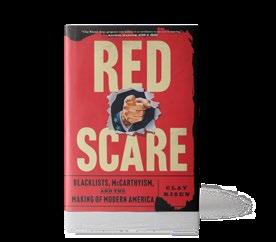
Several prominent history books also speak to the present moment. Scott Anderson’s Kirkus Prize–winning King of Kings: The Iranian Revolution: A Story of Hubris, Delusion and Catastrophic Miscalculation (Doubleday, August 5) expertly lays the groundwork for the heightened tension that exists between the U.S. and Iran—now that the latter is a nuclear state. Greg Grandin’s Kirkus Prize finalist, America, América: A New History of the New World (Penguin Press, April 22), does much the same, explaining how fraught relations with Latin America have deep historical roots. And Kevin Sack’s Mother Emanuel: Two Centuries of Race, Resistance, and Forgiveness in One Charleston Church (Crown, June 3) gets at the origins of the race-based hatred and violence that have long plagued this country.
That’s a lot of serious material. Some books do offer glimmers of hope about the future. They include Ezra Klein and Derek Thompson’s


JOHN McMURTRIE
pragmatic and promising Abundance (Avid Reader Press, March 18) and Replaceable You: Adventures in Human Anatomy (Norton, September 16) by the forever cheery and amusing Mary Roach. Come what may, artificial intelligence won’t save us during interesting times, nor will a far-fetched idea like colonizing Mars. So says Adam Becker, author of More Everything Forever: AI Overlords, Space Empires, and Silicon Valley’s Crusade To Control the Fate of Humanity (Basic Books, April 22). An astrophysicist and science journalist, Becker debunks Silicon Valley’s “ideology of technological salvation.” He writes, “As long as billionaires like Elon Musk and Jeff Bezos…say that they’re doing what they’re doing in order to save the future of humanity—then they can cast their critics as enemies of civilization and our species.” What do you think, fellow humans?
John McMurtrie is the nonfiction editor.
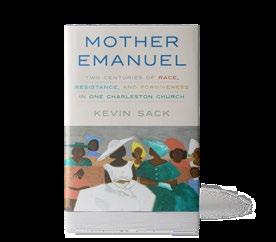
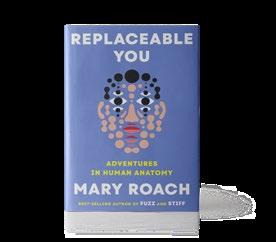
The famous transcontinental expedition “depended on more than Lewis and Clark.” Not that journalist/ historian Fehrman neglects to provide vivid portraits of the Corps of Discovery’s co-captains. He depicts Lewis, secretary and confidant to President Thomas Jefferson, as brilliant but volatile, a superb natural historian prone to fits of anxiety and outbursts of rage at his men. Clark comes across as a shrewd judge of character and situation; the portrait of his complex and evolving relationship with his enslaved “body servant” York, who wins some measure of dignity and respect during the arduous two-year journey, is one of the book’s highlights. York is one of the several subordinate expedition
members given chapters foregrounding their experiences; others include capable, virtually unflappable Sergeant John Ordway and Sacajawea, the pregnant Shoshone teenager who proved a far more useful guide and translator than her “husband,” a dissolute trader who bought her from the Hidatsa tribe that had captured and enslaved her. Fehrman also provides the perspectives of various Native American leaders, including Black Buffalo of the Lakota and Piahito of the Arikara, who both sought to establish friendly relations with the Corps despite their tribes’ misgivings. Native suspicions were well founded: One of the key concepts driving Jefferson’s commission of the expedition, Fehrman demonstrates in a sharp analytical passage,

Fehrman, Craig | Avid Reader Press | 448 pp. $35 | April 21, 2026 | 9781982174248
was what he called “our right of preemption,” a tangled concept that claimed to respect Natives’ “right of occupancy” but was designed to open the door for “purchases” of Indigenous land. The book’s wide-angle perspective is appropriate, since Lewis and Clark favored a more democratic decision-making style than was usual on a military expedition, and the inclusion
of multiple Native points of view makes it clear how complex and fraught the team’s mission was. Fehrman’s approach gives added depth to his chronicle of the breathtaking natural wonders encountered and extraordinary hardships overcome on the Corps’ transcontinental trek. A valuable fresh look at a storied moment in American history.
There’s a Criminal Touch to Art: How Ulay Stole Hitler’s Favorite Painting and Redefined Performance Art
Abramović, Marina & Ulay with Noah Charney | Bloomsbury Academic (144 pp.) $27 | February 5, 2026 | 9798765163047

When is art theft not a crime?
Frank Uwe Laysiepen (19432020), better known by the sobriquet Ulay, was a German-born photographer and artist who in 1976 perpetrated one of the most audacious and celebrated art thefts in modern history, albeit as an act of performance art. In this rather uneven account, a triptych of that event, principal author Charney attempts to place the theft, Ulay’s career, and his professional and personal relationship with fellow artist Abramović in the context of classical aesthetics and to assay whether the theft was in fact a crime at all, since the painting in question was returned unharmed, Ulay’s political and cultural statement having been made. Including brief, meandering, and, alas, leaden accounts by Ulay and Abramović themselves, Charney, an art historian and personal friend, also makes a case for the “Berlin lifting” (as the theft was called) as an enduring work of art. Arguably, Charney interprets aesthetic ideas to validate his judgment, but he is not wholly convincing—or unbiased. It’s even debatable whether Ulay’s famous act was genuinely significant— outside a narrow, rarefied slice of the art world. Ulay himself resisted calling it art, preferring to call it an “aktion” (action) aimed at exposing the disconnect between what is revered as art and what is neglected in society, such as the
poor or marginalized, as well as what Ulay saw as the suffocating institutionalization of art. That said, Charney cannot be faulted for adding that the theft “gives us, briefly, a vision of what art can still dare to be: not just beautiful but bold, dangerous, and alive.” Yet the real strength of the book—a monograph, actually—rests not in Charney’s championing of Ulay, but in his wider historical and critical analysis. An impassioned argument weakened by hagiography.
Aksakal, Mustafa | Princeton Univ. (256 pp.) $32 | January 13, 2026 | 9780691262499
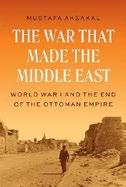
A revisionist history of World War I that elevates the role and importance of the Ottoman Empire in the conflict.
The Ottoman Empire, writes Georgetown University historian Aksakal, experienced a different World War I from the one waged in Europe, one that “represented a moment in a longer history that stretched back to the first half of the nineteenth century, and it continues to shape the region in important ways today.” The war had a political dimension, fomented by Turkish nationalists. It had a religious dimension, in that those nationalists were prepared to jettison a multiethnic, secular empire in which Christians and Jews enjoyed equal rights with Muslims for a Muslim-only polity. It is its economic dimension, however, that Aksakal explores most closely: When
war broke out, the government in Istanbul, its military already weakened by losses in the Balkan Wars, issued broad conscription orders that removed hundreds of thousands of agricultural workers from the fields, and “the requisitioning of animals further reduced the acreage of land under cultivation.” Coupled with an ominous region-wide plague of locusts and the blockade of shipping across the Mediterranean, this meant starvation across the empire, even in Istanbul itself. But rather than reduce military operations—which would come to include the Armenian genocide, premised on the assumption that the Armenians would be rebellious or disloyal—the “Young Turk” Ottoman government instead raised the draft rates even higher. The results were many, including a widespread revolt of the Arab peoples under Ottoman control, with one sharif blaming the depredations of war on the greed of the Turkish unionists. In the end, the Ottoman Empire collapsed, with Kemal Atatürk’s Republican People’s Party claiming sovereignty over the Turkish remnant alone and new states forming across the Middle East. Concludes Aksakal, “a century later, that upheaval, from Kurdistan to Gaza to Baghdad to Libya, appears as unsettled as ever.”
A fresh examination of a littlereckoned theater of war.
Albers, Patricia | Other Press (592 pp.)
$39.99 | January 27, 2026 | 9781590515099

A photographer’s unique eye. Biographer, curator, and art historian Albers offers a comprehensive biography of the widely acclaimed photographer André Kertész (1894-1985). Born in Budapest, Kertész started photographing at age 18 and never was
without a camera, even as a soldier during World War I. Everything piqued his interest, Albers writes. “He photographed farmhouses, a kid smoking a cigar butt, a concert on a ship, trees and streams, a makeshift market set up among ruins, soldiers relieving themselves in a ditch, street cleaners, a sandal maker, and burned-out boxcars.” His reputation rose in the late 1920s, when photojournalists and reportage transformed photographic culture. Among the many cameras that he used during a long career, the lightweight Leica proved liberating, allowing him to take one photo after another and to develop the film into contact sheets rather than more laboriously as single images. Albers chronicles the highs and lows of his career, as well as the tangles of his personal life. In 1928, he married Rózsi Klein but betrayed her to resume an affair with an early love, Elizabeth, whom he married in 1933, although not legally divorced from Rózsi. He and Elizabeth emigrated to New York, where he found himself faced with commercial work and fashion photography, neither of which interested him. For 14 years, he worked, unhappily, for House & Garden , producing more than 3,000 images. Albers portrays Kertész as curmudgeonly and self-aggrandizing. His “self-image as a victim of cheating and exploitation became central to his understanding of his American years,” the author writes. “He misinterpreted people’s actions, misread benign comments as hostile, and suspected slights where none were intended.” Yet he was lauded by his contemporaries and honored in exhibitions internationally, including a retrospective at MoMA. A well-researched life of an iconoclast.

Brown, Brené | Random House (448 pp.) $32 | September 23, 2025 | 9781984855749

Recruiting “the right muscles for the job.”
In what is billed as a “Dare to Lead” book, author and entrepreneur Brown once again advises the leaders and managers of large companies and other organizations on how to “facilitat[e] culture and performance transformations.” It’s part sales pitch for Brown’s leadership program and part stultifying review of her many previous books, notably Dare to Lead and Atlas of the Heart. If the volume has an overarching structure or direction, it’s not apparent. Besides chapters revisiting her own books and ideas, she also devotes a number to the books and ideas of her friends and heroes, including psychologist Adam Grant and soccer star Abby Wambach. Sometimes these chapters transcribe interviews, such as one with Fifth Dimensional Leadership creator Ginny Clarke, interrupted by descriptions of Brown’s psychological reactions. (“Big pause while Ginny watches me get reflective and more emotional than I thought I would.”) More often, they simply quote, paraphrase, or condense long swathes of the various authors’ books, without much explication, critical questioning, or refinement of the ideas. She also throws in, seemingly at random, poems by authors including David Whyte and Clint Smith. Sports analogies abound, whether it’s Brown recounting in detail what she learned from her physical therapist while recovering from an excruciating pickleball injury (“Use your mind and your body, Brown”) or transferring the theory of “pocket presence” from football to the boardroom. Readers who are not
occupants of what Brown calls “the C-suites” are not likely to find much of value here. Most of her assertions are so amorphous that it’s hard to argue with them. But they’re also so abstract that it’s difficult to imagine how to put them into action. Innocuous, but less than helpful.
Brown, Dorothy A. | Crown (272 pp.) $30 | January 20, 2026 | 9780593593615
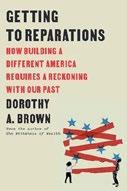
A legal analysis, accessibly written, on the necessity for reparations to Black America. Brown, a professor of tax law at Georgetown University, admits to having once been a skeptic on the matter of reparations, partially in recognition of the generations of enslaved Black people whose labor went unpaid. Her mind changed after a chance remark by a colleague, noting that reparations had been paid to white victims of injury, Japanese interned during World War II, Native Americans robbed of land, and indeed “everybody but Black Americans.” Those payments, far beyond the “forty acres and a mule” of old, constitute a legal precedent. Moreover, Brown argues, financial restitution must be extended not just to Black Americans who can locate enslaved people in their ancestry, but to all Black people, including immigrants from Africa: “Because blackness is what has been targeted post-slavery, then blackness alone should be the test. If you are black and live in America, then you are eligible for reparations.” In a bracing history backing up her case for precedent, Brown notes the irony that in many instances white slaveholders were compensated, with federal funds, for the loss of their slaves on emancipation. Similarly, money was paid out to
the families of several Italians who had been lynched in Louisiana; Black Louisianans were lynched as well, of course, but “Italians had one significant advantage that black Americans did not: They had a country and government willing to fight for them.” Brown also identifies precedent in legal actions undertaken by communities around the country, including payment to a Black family in California whose ancestors had been dispossessed from their valuable beachfront property and compensation for a long pattern of housing discrimination in Evanston, Illinois. A cogent argument for putting long-overdue dollars on the table to compensate for injuries past and present.
Burke, Jason | Knopf (768 pp.) | $35 January 13, 2026 | 9780525659433

Terrorism and its long tail.
Burke’s expansive history of leftist and Islamist political violence in Europe and the Middle East from the late 1960s to the early 1980s combines journalistic rigor with spy novel–esque skullduggery. The Guardian reporter divides the period roughly in half. Exploiting technological advances in mainstream media, far-left militants staged dramatic crimes that “hundreds of millions” saw on TV. Within one week in 1970, the Popular Front for the Liberation of Palestine hijacked three planes, emptied them of passengers, and destroyed them. As this multinational spasm of primarily secular radicalism exhausted itself in the late ’70s, Islamist fundamentalist violence “flourished.” Among the perpetrators were small cadres and religious regimes targeting purported apostates. When a fundamentalist cleric took over the
government in Iran, “entire families were hanged, including teenagers and grandmothers.” The two strains of terrorism sometimes overlapped. Both secular and religious militants trained at Yasser Arafat’s camps in Jordan. Burke excels at limning the varieties of extremism, which reached many illiterate devotees via cassette tapes of speeches by clerics who characterized piety as the “single, obvious solution” to all problems. The durable influence of such ideas was most infamously embodied by Osama bin Laden. “Communism and socialism offered social justice but ignored identity,” Burke writes. “Political Islam, and its violent fringe, offered both.” Unlike earlier secular leftist attacks, which “rarely caused many deaths,” some Islamist terrorists “sought to maximise loss of life.” Along with horrific carnage, there’s plentiful intrigue in these pages. A well-known hijacker gets plastic surgery and commandeers another plane. A terrorist’s death may be attributable to poisoned chocolate. Though some readers may quibble about Burke’s geographical focus, which largely excludes concurrent revolutionary violence in Northern Ireland and Latin America, this is an intelligent and enlightening book. An authoritative epic about eradefining extremism.
Carvalho, Bruno | Princeton Univ. (424 pp.) $35 | January 13, 2026 | 9780691246550
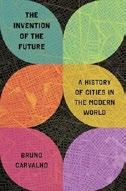
A history as well as a philosophical examination of humanity’s belief in progress and a better future as demonstrated in the spread of urbanization.
Carvalho, professor at Harvard, author of Porous City: A Cultural History of Rio de Janeiro, writes that just a few centuries ago everyone believed that divine forces
governed the universe, everything worth knowing was known, and the future would resemble the past. Matters changed during the Renaissance. As a historian put it, “The future would be different from the past, and better, to boot.” By the mid-18th century, the expectation that humans had the capacity to make new futures and shape their own destinies had taken hold. Carvalho opens with the catastrophic 1755 Lisbon earthquake and tsunami and the subsequent rebuilding under autocratic guidance, partly frustrated (as usual) by property owners and tradition but which resulted in features heralding a new vision of progress: fewer monumental structures, wider streets (for fire prevention, not traffic), and an obsession with a grid layout as opposed to the old tangled pattern of streets. The iconic 1811 Manhattan grid established an even more radically modern relationship between planning and urban life: less religiously charged, and more open-ended. New York’s transformation in the 19th century exemplified transatlantic urbanization as a laboratory for social stratification, identity formation, and creativity. That was not part of the plan, but planners always underestimated how much cities would evolve within a few generations. Most readers recall the brutal Haussmann mid-19th-century transformation of Paris and L’Enfant’s dazzling 1791 plan for Washington D.C., but Carvalho, a Brazilian, pays more than usual attention to great South American cities as he delves into urbanization across the world from Delhi to Berlin to San Francisco and across Africa. Prediction is a mug’s game, so Carvalho confines his conclusion to heralding the long-delayed death of car worship and noting the movement of imaginative urban development to Asia. Deep thinking about cities.

Century, Douglas | Avid Reader Press (432 pp.)
$30 | November 18, 2025 | 9781668035276
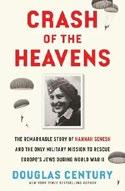
Flights of freedom.
Hannah Senesh
was a Jewish freedom fighter in the 1940s.
Moving to British Mandate Palestine from Hungary in the late 1930s, she joined the Palmach, the elite military working to establish a Jewish political presence in the Holy Land. In 1943, she participated in a unique and dangerous mission. The British were considering sending “a unit of Jewish volunteers from Palestine behind enemy lines in Europe.” The goal? “To establish contact with the local underground leadership and resistance fighters and, together with them, help downed Allied airmen and escaped prisoners of war get back to Allied lines. After the completion of those British Intelligence assignments, the volunteers could…assist them in fomenting armed resistance against the Nazis and their fascist collaborators.” In breathless prose and cinematic detail, the book presents the men and women from all backgrounds joined in concert to save something of European Jewry. We hear the roar of airplane engines, feel the wind as they jump, and brace for impact as they land. We follow them through Eastern European woodlands and shadow them through city streets. But in the end, Hannah is captured and executed in Hungary. Was she a reckless martyr? The book ends with the judgment of the late John McCain: “I don’t think Hannah wanted to die for the sake of having her memory exalted in history or to prove herself equal to a romantic image she conceived for herself. Her purpose wasn’t to die. She died for her life’s purpose.” This is a book of
The evolution of a country star who calls his black cowboy hat Darth Vader.
HEART LIFE MUSIC
inspiration for our time, when heroism and self-sacrifice have lost their luster. A tale of heroic self-sacrifice during the Holocaust, told in camera-ready action and detail.
Chesney, Kenny with Holly Gleason Morrow/HarperCollins (352 pp.) | $32.50 November 4, 2025 | 9780063423107

The country star delivers an amiable rags-toriches memoir. Chesney, writing with country music journalist Gleason, opens with his boyhood in a small town along the Clinch River at enough distance from Knoxville, Tennessee, for the night skies to be dark—an idyllic theme that Chesney explores at points throughout his memoir. There he heard “follow-thebouncing-ball” church hymns, but also fell under the spell (and who doesn’t?) of George Jones, Merle Haggard, and Conway Twitty. It was seeing the last, “standing there in blue pants and a hot pink shirt,” that settled a young Chesney on a musical career, though he listens on every page with receptive ears to whatever music is playing: Tom Petty, reggae, Jimmy Buffett, bluegrass, Van Halen, Joe Walsh, the list goes on. A young Chesney arrives in Nashville, playing the tip-jar bar circuit and learning through painful trial and error just what goes into making a song: “The job is to take a slice of life, write all about it, slice it down to what matters, then cut that feeling wide open.” In time, he also
learns the business behind the business, from cultivating personal persistence to having enough merch on hand to fuel the bus. From there to headlining is a big step, but there the merch comes in, too; says one promoter, “T-shirts! That’s how we measure passion.” Chesney is passionate about the music, to be sure, and refreshingly open to experimentation, as when he paired up with folk-rocker Grace Potter. He is modest and circumspect about other aspects of his life, keeping mum about his most tabloid-famous relationship. There’s good humor here, too, as when he writes about the black cowboy hat that he calls Darth Vader “because it transforms the guy from East Tennessee into a country star.”
A plainspoken, pleasing success story from a hardworking artist.
Crawford, Bob | Zando (352 pp.) | $28 March 10, 2026 | 9781638932604
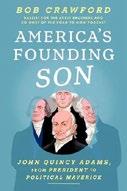
The case for John Quincy Adams as “our most extraordinary ex-president.”
Opening with Adams’ 1842 censure trial in the House of Representatives, Crawford, cohost of a history podcast called The Road to Now, chronicles the former president’s slow conversion to the abolitionist cause. The only president ever to serve in the House after the White House, Adams was 75
years old and serving his sixth term. His crime was presenting an antislavery petition from 46 Massachusetts citizens, one of the flood that prompted the House in 1836 to institute a gag rule that prohibited any discussion of slavery in Congress. Adams initially led the fight against the rule exclusively on First Amendment grounds; he was personally against slavery but did not believe the Constitution gave Congress the power to abolish it. His opinion changed over time, and Crawford launches his main narrative with Adams’ appointment as secretary of state under President Monroe, then traces the increasing tensions over slavery, exacerbated beginning in 1819 by the question of whether Missouri would be admitted as a slave state. The Missouri Compromise of 1820 did nothing permanent to assuage the rising radicalism of outrage d abolitionists, who courted Adams for his support, and increasing intransigence of slaveowners. Deliberately aimed at general readers, complete with full-page line drawings of the principal players, the book is sprinkled with homely asides like, “Politics, am I right?” and jazzy descriptions of Adams as “the O.G. political maverick” or abolitionists Angelina Grimké and Theodore Weld as “the nineteenth century’s greatest power couple.” This strenuously folksy tone doesn’t entirely lighten an extremely detailed account of the intricate parliamentary maneuvers Adams employed to skirt the gag rule and force his opponents to debate the leading issue of the day. That said, this is a knowledgeable account leading to Adams’ triumph and the defeat of the gag rule. Solid history, though perhaps not quite as accessible as intended.
Dignum, Virginia | Princeton Univ. (224 pp.) | $27.95 | February 17, 2026
9780691269085

In this optimistic take, the seductive skills of AI systems are pitted against the complexity of human intelligence. Will unchecked adoption of artificial intelligence overwhelm society? This book offers a reassuring counterpoint: AI’s limitations remain stark when compared with the richness of human intelligence. Dignum, professor of responsible artificial intelligence at Umeå University in Sweden, challenges the popular image of AI as an all-powerful brain. Organizing her chapters around a series of “paradoxes,” she argues: “The more AI can do, the more it reveals what makes human intelligence unique.” The author begins by examining conflicting definitions of machine intelligence. Weaving together research across fields is no simple feat, given the fragmented and varied AI landscape. Drawing on her experience in both corporate and academic settings, she observes that enthusiasm and anxiety abound, yet consensus is elusive—not only on what AI is, but also on the meaning of artificial general intelligence. Pushing back against doomsday scenarios, she contends that while skeptics such as Yoshua Bengio warn of catastrophic risks, AI systems lack humanlike motives, drives, and multidimensional intelligence. Instead of framing AI as an unstoppable force poised to subjugate
Will unchecked adoption of artificial intelligence overwhelm society?
THE AI PARADOX
humanity, Dignum encourages us to see it as an augmenting technology we can shape. The book is dense with thought-provoking intersections that could be expanded into another volume. Dignum situates AI within cultural, scientific, and corporate currents, though her analysis gives less attention to the crucial role of government funding in shaping the field, including the notorious “AI winters” when investment dried up after overhyped promises. Acknowledging that prominent AI pioneers have raised alarms, Dignum counters: “We should be more concerned about those who develop, own and deploy these systems.” A nuanced, hopeful vision of a future with human intelligence amplified, not overwhelmed, by machine intelligence.
Eden, Scott | Spiegel & Grau (384 pp.) $28 | February 3, 2026 | 9781954118621

A grimly fascinating true-crime yarn centered on California’s legal—and otherwise— weed business. Who killed Tushar Atre? A detective asked that question of one of Atre’s workers, who replied, “It could be a hundred people.” One possibility, journalist Eden details, was his chief partner and sometime girlfriend, Rachael Lynch, who, though young, was an experienced dealer, “the only woman growing weed on a backwoods hill otherwise full of stoner dudes bursting with unvented testosterone.” Atre, after all, had screwed her over financially many times. Another possibility was a host of gangland rivals: the entrepreneur and bon vivant had crossed paths with plenty, Samoans and kids and heavies from the cartels and wildcat Hmong farmers. Still another was, well, any one of a hundred-odd employees, for Atre was a mercurial type who “routinely
demanded and humiliated his…‘underlings’” and professed that “fear was the best motivational tool.” Atre and Lynch had a legal grow operation, working in a California so relaxed about pot that a local joke went, “Q: Where’s the best place to hide your cocaine in Santa Cruz County? A: Inside your bag of weed!” But the margins were tight on the legal side, with steep overhead costs and a heavy burden of taxation, which caused many growers to supplement their business with black-market sales and out-of-state consumers, in violation of state and federal laws. Atre’s operation was churning out huge quantities of pot and hundreds of kilos of hash oil, but he still had a bad habit of reneging on deals, skimming off profits, and cheating partners and workers. In that pattern of kicking over the traces lay Tushar’s demise, as Eden chronicles in a fast-paced narrative. But death isn’t the only outcome: The black market in pot collapsed, prices tanked, and now “the vast greenhouse complexes of the Salinas Valley again stand mostly empty.”
A complex story well told, and a cautionary tale for would-be drug kingpins.
Ferrara, Abel | Simon & Schuster (272 pp.) $29 | October 21, 2025 | 9781668097670

The cult-classic filmmaker recounts a life growing up on the mean streets. New York–born Ferrara might have been a foot soldier for the mob, but “a wise guy is a killer, a made man, and you had to be 100 percent Italian to be in that club.” Scratch Ferrara, whose mother was Irish. His all-Italian father, however, was a wheeler-dealer, an occasional bar owner but “mostly a bookmaker, and it’s a good business unless you start being your own customer.” Perpetually broke, the old man funded Ferrara’s first movie, a
porno timed just right for the mid-’70s seedy Times Square market—except it didn’t make much of a stir. (Years later Ferrara discovered the truth behind the financing, and suffice it to say that the old man always worked an angle.) Then Texas Chainsaw Massacre came along, and Ferrara noticed that “by the second weekend there were twice as many people there as week one.” Voilà: The next film was a blood-soaked horror flick. More generic films followed until Ferrara hit his stride, first directing an Elmore Leonard adaptation, then King of New York with the emblematic, supremely weird Christopher Walken. Ferrara is perhaps best known for his film Bad Lieutenant, originally written for Walken in the title role, fortuitously filled by Harvey Keitel. A confessional accompanies his account of the film’s origins and fortunes: “By the time we were making Bad Lieutenant I had a serious crack habit,” Ferrara writes, and in time he came to be addicted to many other substances, including heroin, of which he says, “If you never tried it, don’t….If there is nothing else you take from this book, take that.” Point taken, but there are plenty of other lessons here on how films are made and financed, how they come and go, and how no one knows how they’ll fare once they get to the screen. A candid portrait of a tarnished moment in film’s last golden age.
Funt, Danny | Gallery Books/ Simon & Schuster (320 pp.) | $30 January 20, 2026 | 9781668062029

Care to wager?
Yes, America says, to the tune of billions.
For decades, Funt writes in this insightful work of journalism, sports executives agreed that betting was “evil” and would undermine
competitive integrity if made broadly legal. But in recent years, pro leagues have done a 180, inking lucrative partnerships with companies that offer round-the-clock betting. Since a 2018 Supreme Court decision enabled states to legalize sports gambling, Americans have bet hundreds of billions of dollars. Funt’s interviews with 300 industry employees, gamblers, athletes, and others illuminate what’s been lost in the process. Along with game scores, adults with smartphones can bet on the stats of stars and second-stringers alike, exposing both pro and college players to threats from aggrieved gamblers. Easily replenished spending accounts and misleading promotions have fueled gambling addictions; one schoolteacher’s 18-month tally: “100K blown.” Meanwhile, watching live sports now means enduring an onslaught of betting commercials. Funt, who’s chronicled some of the above for the Washington Post, goes deep on the industry’s dark side. Gambling companies employ so-called hosts, who woo “VIP” bettors—gamblers who place big, unsuccessful wagers—with game tickets and personalized gifts. The goal, says a former host, is to “keep them losing.” College and pro sports had numerous gambling-related scandals long before 2018, and observers worry that young sports fans “are being groomed to gamble for life” and that a superstar player may eventually get caught. “That would kill the league,” an NBA agent says. Funt’s book isn’t overtly prescriptive, but he offers a helpful summary of proposed legislation to rein in some of the industry’s excesses. This is an intelligent overview of an increasingly powerful economic and social force. Energetic reporting exposes the underbelly of an industry that always wins, no matter who’s playing.


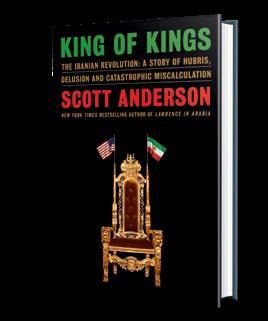
Sam Anderson

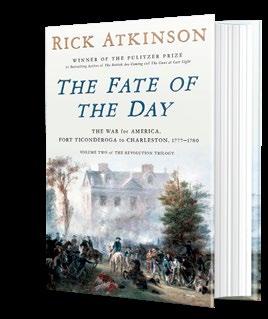
Greg Grandin
By Bench Ansfield
By Rick Atkinson
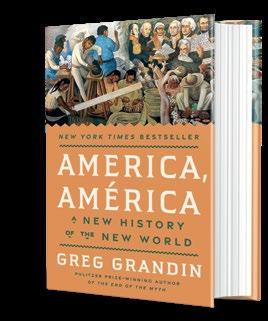
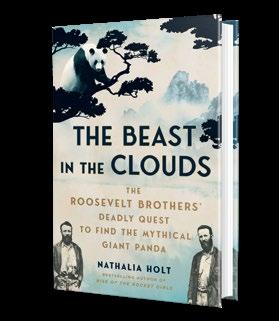

By Marla A. Ramírez
The author of Empty Vessel answers our questions.
IT TAKES SKILL to write an engrossing book about a “squat gray vessel” that, despite being the length of a football field, doesn’t even have a motor. Ian Kumekawa pulls it off, though, in Empty Vessel: The Story of the Global Economy in One Barge, his superb account of a decades-old barge that holds much history—and is a portal into the secretive realm of international trade. “Kumekawa weaves in lucid and eye-opening explanations of the murky worlds of tax havens and loose regulations,” says our starred review. “The barge is at the heart of it all.” Kumekawa is a fellow at the Center for History and Economics at Harvard University and a lecturer in history at MIT— not far from the Atlantic Ocean, the vast body of water where his titular vessel has spent much of its exceptional life. Kumekawa answered our questions by email.
What was the original idea that started you working on the book?
The idea came from my wife, who is a public defender. We were living in New York, and she had clients who were incarcerated on what was called “the boat,” a jail barge floating in the East River off the Bronx. I’m a historian of the British Empire, and the barge immediately called to mind the hulks that were a staple of the British penal system in the 18th and 19th centuries. I couldn’t believe there was still a jail ship operating in New York in 2020. I started looking into the history of jail barges in New York, and [as] I learned more, I realized that the history of one of those barges was
almost too remarkable to believe. The result was Empty Vessel
What inspired you during the writing of the book?
I read a bunch of books that took place at sea: Moby-Dick , B. Travens’ The Death Ship , David Grann’s The Wager, Maya Jasanoff’s The Dawn Watch , even Death on the Nile Ships are great narrative devices for connecting disparate places and people.
Where and when did you write the book?
In general, I find writing quite difficult. The one rule I have for myself is that if I have a paragraphsize idea in my head, I have to stop everything and write it down. Much of the first draft of this book was written in paragraph-size spurts, mostly in my office, but in other places, too: libraries, archives, in the homes of friends and family, even typing with thumbs while sitting on the bus.
What was most challenging about writing this book?
And most rewarding?
Researching the offshore world is hard because it’s designed to be obscure. Many of the traditional sources that historians use to study the past are unavailable or inaccessible. One way I tried to get around this problem was by talking to people who had lived, worked, or been incarcerated on the barge. This was the most rewarding part of the research process. During the pandemic, while I was stuck at home, I did a lot of Zoom interviews with other people around the world


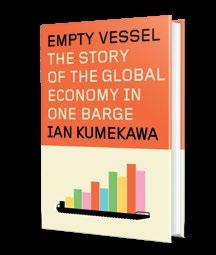
Empty Vessel: The Story of the Global Economy in One Barge
Kumekawa, Ian Knopf | 320 pp. | $29 May 6, 2025 | 9780593801475
who were also stuck at home. It was a reminder of how small the world was and how global an experience could be.
What books published in 2025 were among your favorites?
I really appreciated The Lost Orchid by Sarah Bilston. And I’m so looking forward to reading Bench Ansfield’s Born in Flames.
Interview by John McMurtrie

Harper will publish Jung Chang’s Fly, Wild Swans in January.
Jung Chang will follow up her bestselling family history, Wild Swans: Three Daughters of China, with a sequel, 35 years after the original book’s publication.
Harper will publish Chang’s Fly, Wild Swans: My Mother, Myself and China, next year, the press announced in a news release. It says the book “once again traces the history of modern China through the true stories of three generations of women in her family.”

Wild Swans was published by Simon & Schuster in 1991. The book tells the story of the author, who was born in China and became a Red Guard when she was 14; her mother, a member of the Chinese Communist Party; and her grandmother, the concubine of a warlord in pre-communist China. A critic for Kirkus wrote of the book, “Chang offers an inspiring story of courage, sensitivity, intelligence, loyalty, and love, told objectively, without guilt or recrimination, in an unassuming and credible documentary style.”
The book, which is banned in China, was a massive bestseller, selling more than 15 million copies in over 40 languages. Chang went on to publish the books Mao: The Unknown Story, co-written with Jon Halliday; Empress Dowager Cixi: The Concubine Who Launched Modern China; and Big Sister, Little Sister, Red Sister Fly, Wild Swans is slated for publication on January 13, 2026.—M.S.
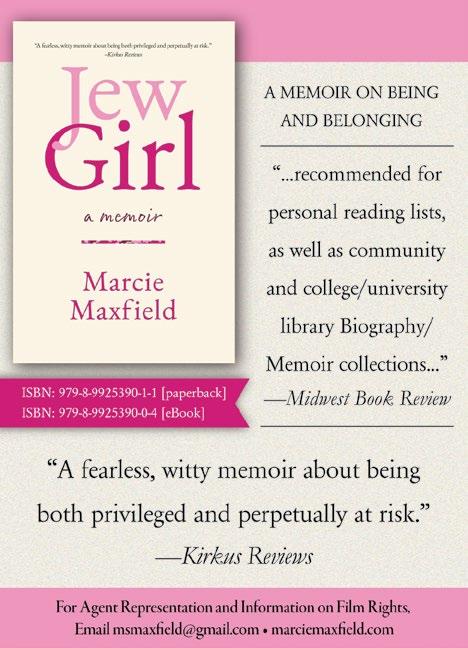


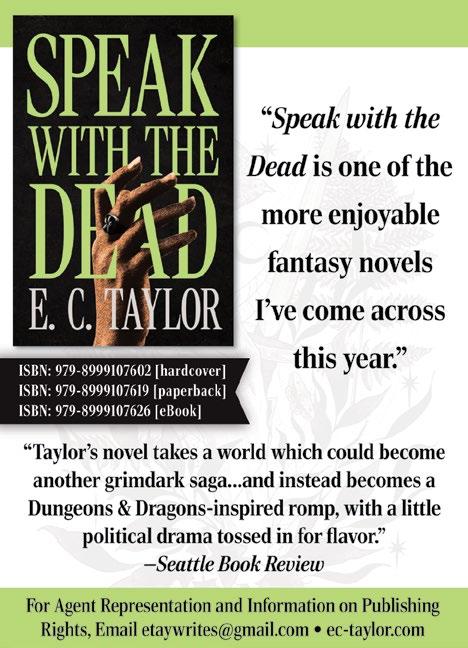

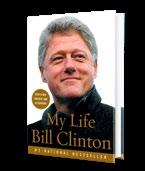
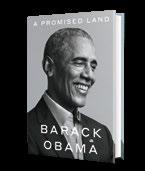
Lawyer Robert Barnett negotiated multimillion-dollar deals for his clients.
Robert Barnett, the Washington, D.C., lawyer famed for his literary dealmaking for clients including Bill Clinton and Barack Obama, died at 79, the New York Times reports. Barnett, an Illinois native, was educated at the University of Wisconsin and the University of Chicago Law School. He joined the influential Washington law firm Williams & Connolly in 1975, where he worked until his death. He first became involved in national politics in 1984, advising the presidential campaign of former Vice President Walter Mondale. After connecting Mondale’s running mate, Geraldine Ferraro, with an agent for her book, he decided to embark on a secondary career as a literary dealmaker. Barnett scored blockbuster deals for
Robert Barnett


his clients, many in the political world, including former President Bill Clinton (My Life) and his wife, Hillary Clinton (Living History). He also represented former President Barack Obama and Michelle Obama in their multimillion-dollar deals for their books. His other clients included Dick Cheney, Tony Blair, James Patterson, and Mary Higgins Clark. Barnett was remembered by his friends and clients on social media. On the social platform X, Bill and Hillary Clinton posted a statement that reads in part, “Bob had an insightful eye for editorial detail and a keen ear for language and nuance, but more importantly, he was utterly devoted to his clients, always unfailingly generous with his time and his considerable talents.”—M.S.

For more literary obituaries, visit Kirkus online.
Goldstein, Rebecca Newberger
Liveright/Norton (304 pp.) | $29.99
January 13, 2026 | 9781324096856

Searching for meaning. Do we make a difference? Do other people care? Novelist and philosopher Goldstein argues that the positive answers to those questions make us human. She argues for an essential human need to be a part of others’ lives, to shape the world in which we live and leave a legacy. We long to matter, and longing is central to Goldstein’s view of human motivation. The writing aspires to prose poetry. “All things can be wounded and wasted by what they meet with in the world. Our longing to matter puts us all the more at the mercy of the world—a reason in itself to see one another more mercifully.” Part anthropological meditation, part popular psychology, part self-help manifesto, the book skips like a flat stone across the surface waters of knowledge. There is a touch of physics, a dip into existentialism, and a splash of ethics. A list reveals the ambitions of this book: “Some mattering regions teem with billions, as, for example, those demarcated by major religions; others are mid-sized, such as the one inhabited by those pursuing fame for fame’s sake; and some are tiny—the Monacos, the Maltas, the Seychelles of the mattering map—such as the regions inhabited by Victorian salmon fly-tyers, trainspotters, Civil War reenactors, and analytic philosophers.” By the end, we have moved from this cabinet of curious specifics to something general and grand: “To be a transcender is to believe that your personal existence has a role to play in the narrative of eternity.” At its best, the book inspires us to make a difference. At its worst, it puts us off with pretentiousness. A boldly out-there meditation on why humans want to make a difference in the world.
Gottschalk, Marie | Princeton Univ. (616 pp.) $39.95 | November 18, 2025 | 9780691275253

A distinguished political scientist condemns the “social murder” of America’s working people committed by corporations, the wealthy, and the state.
Murder is a very real thing, writes Gottschalk: “Tens of millions of US gun owners are locked and loaded, ready to take the law into their own hands or to turn their guns on themselves.” Death by despair, as it has been dubbed, is also rampant, with high rates of drug addiction and alcohol abuse. Police officers increasingly visit violence on people, particularly people of color, and go unpunished; meanwhile, people of color find themselves incarcerated at rates far higher than the white population, penal policy having “become the policy of first resort to address the massive economic and social dislocations of the last half century in the United States.” Against this backdrop, Gottschalk’s central thesis is that many societal strands, from militarized police to a pattern of “forever wars” and the increasing financialization of the economy all combine into state-sponsored, class-based violence against ordinary Americans, who live, it seems, in a different country from the wealthy, who commit all sorts of economic crimes—fraud, wage theft, and the like. Writes Gottschalk, “Crime in the suites victimizes more people and causes more harm than crime in the streets.” For all that, a battery of laws constitutes a kind of “corporate shield” that protects wrongdoers from prosecution, apart from the occasional sacrificial lamb: The regulatory agencies, for instance, “made a spectacle of sentencing Bernie Madoff to essentially die in prison while ignoring the willful blindness of regulators and leading bankers that allowed his multibilliondollar Ponzi scheme to flourish for decades.” There are remedies, Gottschalk
notes, that may never be applied, from taxing the ultrawealthy to reforming tort law to remove barriers to suing corporations and government agencies. A clearsighted analysis of the systemic class war that the 1 percent is waging on the rest—and without penalty.
Harris, Kamala | Simon & Schuster (320 pp.) $30 | September 23, 2025 | 9781668211656
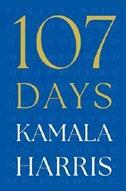
An insider’s chronicle of a pivotal presidential campaign. Several months into the mounting political upheaval of Donald Trump’s second term and following a wave of bestselling political exposés, most notably Jake Tapper and Alex Thompson’s Original Sin on Joe Biden’s health and late decision to step down, former Vice President Harris offers her own account of the consequential months surrounding Biden’s withdrawal and her swift campaign for the presidency. Structured as brief chapters with countdown headers from 107 days to Election Day, the book recounts the campaign’s daily rigors: vetting a running mate, navigating back-to-back rallies, preparing for the convention and the debate with Trump, and deflecting obstacles in the form of both Trump’s camp and Biden’s faltering team. Harris aims to set the record straight on issues that have remained hotly debated. While acknowledging Biden’s advancing decline, she also highlights his foreign-policy steadiness: “His years of experience in foreign policy clearly showed….He was always focused, always commander in chief in that room.” More blame is placed on his inner circle, especially Jill Biden, whom Harris faults for pushing him beyond his limits—“the people who knew him best, should have realized that any campaign was a bridge too far.” Throughout, she highlights her own qualifications and dismisses suggestions that an open contest might have better served the party: “If they thought I was down with
a mini primary or some other half-baked procedure, I was quick to disabuse them.” Facing Trump’s increasingly unhinged behavior, Harris never openly doubts her ability to confront him. Yet she doesn’t fully persuade the reader that she had the capacity to counter his dominance, suggesting instead that her defeat stemmed from a lack of time—a theme underscored by the urgency of the book’s title. If not entirely sanguine about the future, she maintains a clear-eyed view of the damage already done: “Perhaps so much damage that we will have to re-create our government…something leaner, swifter, and much more efficient.”
A determined if self-regarding portrait of a candidate striving to define herself and her campaign on her own terms.
Star
Hastings, Max | Norton (400 pp.) | $31.99 November 11, 2025 | 9781324117575
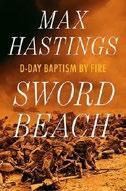
A new look at D-Day from perhaps the best possible source. Of the five Normandy beaches assaulted on June 6, 1944, Americans read mostly about Omaha and Utah because that’s where Americans fought, so readers will enjoy this account of a beach code-named Sword—not only for new information but as another work by Hastings, a master of military history. He reminds readers that the landings constituted a stupendous feat of planning, logistics, training, and air and maritime organization in which the British, for the last time in the war, played the dominant part. British Field Marshal Montgomery commanded the ground forces during and after the invasion. Supreme Commander Eisenhower, as usual, ruled with a light hand. Once ashore, plans for what to do next were sketchy, and the advance stalled. Fortunately, Hastings saves this for the final pages, instead delivering a compelling account of the preparations
and landing itself. Much occurred inland from the beach as a massive nighttime drop of paratrooper and glider-borne forces aimed to destroy bridges and slow German reinforcements. The author is at his best describing this combination of brilliant strategizing, heroism, and utter stupidity. Nighttime airborne operations require superb pilots; planners knew but ignored the fact that theirs would be the worst (essentially all pilot trainees yearn to fly fighters and bombers; those who don’t make the grade fly transports). Sure enough, many pilots seemed unnerved, and most casualties occurred during the flight out, but the minority of troops who landed near their target did well. Readers who expect a superb account of the action will not complain; nothing went as planned, but none of the errors, accidents, and incompetence were vital. Casualties were heavier than at Utah or Gold Beach but less heavy than at Omaha and Juno, and the Allies succeeded in their purpose and the Germans failed in theirs. Even granted the Allies’ huge superiority of means, the landings remain a supreme achievement. Another Hastings page-turner.
Haygood, Wil | Knopf (384 pp.) | $35 February 10, 2026 | 9780593537695
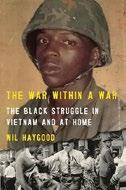
A sharp-edged account of the disastrous Vietnam War as seen through the eyes of its Black fighters.
The author of numerous books of Black history and biography, Haygood begins with the memory of
his childhood block, where six close neighbors were dispatched to fight in Vietnam. That anecdotal evidence well illustrates the fact “that in the early years Blacks were disproportionately being sent to the front of the battle lines in Vietnam when compared with whites.” The pattern would continue throughout the war. Like the “Double V” campaign for civil rights during and after World War II, a resistance movement in Vietnam was paralleling events back home. One of his case studies is a young Black major who walked into a press briefing room in Saigon and read a statement that “the American military services are the strongest citadels of racism on the face of the earth.” For his defiant candor, he was forcibly retired from the service. The Black Power movement arrived at the front “with the force of a hurricane,” exemplified by the elaborate handshake called dapping, which began to worry the mostly white officers in charge, concerned that rebellion was being fomented in the ranks. They were right to worry: Marvin Gaye’s What’s Going On was spinning on the turntable, Black soldiers were growing their hair in afros and disregarding orders, morale was plummeting, and injustices were mounting. In this wide-ranging survey, Haygood relates any number of terrible stories: a Medal of Honor winner, suffering from PTSD and unable to find work back home, gunned down while attempting to rob a grocery store; a 15-year-old who lied about his age to join the Marines, the youngest American to die in Vietnam; the distinguished doctor whose days were ending in treatment for exposure to Agent Orange.
A searing history of the Black experience in Vietnam.
“Blacks were disproportionately being sent to the front of the battle lines in Vietnam.”
Hazareesingh, Sudhir | Farrar, Straus and Giroux (432 pp.) | $32 | December 2, 2025
9780374611071
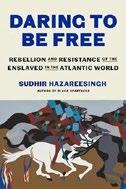
Wide-ranging survey of the many ways in which enslaved Africans and their descendants resisted their captors.
Toussaint L’Ouverture, who led the Haitian war of independence against France, is well known. A young Black servant from Guadeloupe named Solitude is not, though she fought against French colonial forces there. Executed in 1802, Solitude now has a statue in Paris, “the first-ever dedicated to a black woman in the French capital,” as Mauritian historian Hazareesingh writes. Ironically, the French also imposed economic sanctions on free Haiti soon after, demanding indemnities that have crippled the country ever since; as Hazareesingh notes, “the economist Thomas Piketty calculated in 2020 that the Haitians are owed $28 billion by the French government as restitution for the debts incurred for their independence payments.” Rebellions against enslavement took many forms. By the author’s reckoning, hundreds of mutinies occurred on ships in the Middle Passage, among the first known of them a 1532 revolt on a Portuguese ship where 80 captives seized control and sailed back to the coast of Benin. Another form of rebellion took place in Brazil, Panama, and elsewhere, in which enslaved people escaped, formed multiethnic communities that included “Amerindians and poor whites fleeing
from the violence of colonial society, destitutes, family outcasts, and those—such as Jews and African priestesses—persecuted for their spiritual beliefs.” And then, most worrisome to slaveholders, there were outright revolts such as that mounted by Nat Turner in Virginia in 1831, as well as armed bands that helped free recaptured slaves fleeing to Canada on the Underground Railroad—one of themledbyHarrietTubman.Ironically,Hazareesingh notes, most of these acts of rebellion and resistance, while “integral to the practice of Atlantic slavery, and an inescapable part of it,” have often been forgotten, history having tended to congratulate white abolitionists as the sole liberators, a condescending error that this book corrects.
A much-needed and sure-to-beinfluential addition to the literature of African enslavement.
Ed. by Horbinski, Andrea | Univ. of California (424 pp.) | $29.95 paper | October 28, 2025 9780520403994
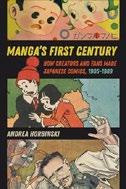
Digging into a popular medium’s roots. Manga, in its current form, is inextricably linked to Japan’s cultural profile and exercises aesthetic influence on cartooning trends worldwide. But Japanese cartooning—manga as a medium—has always been at once a reflection of and a testing ground for cultural conventions, as well as a canvas for creative experimentation.
A priceless record of Japan’s modern cultural development.
MANGA’S FIRST CENTURY
Horbinski’s adaptation of her doctoral dissertation considers manga’s development through five eras, exploring publishing practices, the expansion of fan culture, and the development of gender- and age-segregated genre trends. Some manga histories begin with the classical ukiyo-e (woodblock print) tradition, and others lean in on Osamu Tezuka’s copious midcentury output, but Horbinski begins her study with Kitazawa Rakuten’s deliberate reimagining of Western-style political cartoons introduced to Japan during the Meiji era (1868-1912). Next, the book considers comics as a locus of cultural cohesion and dissent during the Japanese government’s power consolidation approaching World War II. After the war, capitalism drove culture, and manga sold widely and well and was consumed ravenously, causing many artists to put in long hours for low pay in response to public demand. The 1960s and ’70s saw genres splintering and narrative experimentation broadening, with impressively varied results. Even Tezuka, midcentury manga’s standard-bearer, formed an avant-garde magazine for aspiring artists—understanding that manga must respond to its moment. Finally, the author arrives at century’s end, wherein manga commingled content and themes with anime and video games. What’s truly impressive about Horbinski’s project is that she returns, insistently, in every decade, to the many layers of historical precedent for manga’s marvelously multifaceted nature. What might appear uniform or formulaic to the untrained eye is instead, by Horbinski’s excellent estimation, a priceless, powerful record of Japan’s modern cultural development. Deeply considered and information rich, a useful, fascinating work of comics history.

Johnson, Lauren | Pegasus (464 pp.)
$35 | March 3, 2026 | 9798897100705
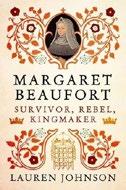
The story of a woman of substance.
Margaret Beaufort’s beginnings were inauspicious— her father died by suicide before she turned 1; her protector “married” her to his son when she was 7, but the protector was charged with treason and executed that same year. King Henry VI sent for Margaret and her mother, invalidated her first marriage since it was never consummated given Margaret’s age, and married her instead to his half-brother, Edmund Tudor, who died of the plague in 1456, leaving Margaret pregnant. She gave birth to her only child, Henry, infant earl of Richmond who would later become Henry VII. Margaret, now a widow “married twice according to the whims of strangers” and a considerable heiress, was determined to make her own decisions, marrying one wealthy landowner and then, widowed again, another. With the English throne in upheaval, Margaret sent young Henry to Brittany, trying to keep him alive and maintain his potential claim to the throne. During the rebellion, Margaret saw an opportunity to marshal the different groups opposing Richard III into one, rallying around her son Henry. The story of the run-up to the battle at Bosworth Field covers only a few dozen pages of the book, but it reads like a breathtaking thriller, ending with the restoration of the Tudor dynasty. That dynasty was a bit shaky over the years, yet Margaret kept spies everywhere to protect Henry VII. When he died in 1509, she maneuvered the situation to keep that news secret over the days it took to capture and imprison false claimants to the throne so that her grandson could be crowned Henry VIII. During all this political skullduggery, Margaret maintained her own property, grew her personal wealth, and became a
patroness for education, founding colleges in Cambridge still operating today. When Margaret died in 1509, she left a dynasty that would remain for nearly 100 years more.
A well-documented and well-told life “forged in the furnace of the most turbulent era in English history.”
Kennedy, John | Broadside Books/ HarperCollins (224 pp.) | $29.99 October 7, 2025 | 9780063428164
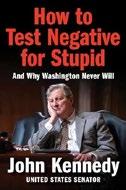
The Louisiana senator shoots (craw)fish in a barrel.
“This book is about the mighty weapon of candor, which most people in Washington, D.C., have only a casual relationship with,” writes Kennedy, who relies on folksy, often groan-worthy witticisms to get him through his contentious narrative. His take on Washington, where he’s been since the first Trump term, is that it’s a “place full of deceptive, ambitious, self-absorbed ex-class presidents who would unplug your life-support system to charge their cell phones.” Most of Kennedy’s subsequent observations are meant to support the thesis. He professes at many points to be an equal-opportunity critic of a wobbly system, and he gets off a few zingers in the direction of fellow Republicans like Lindsey Graham (“Invite him to dinner, and you don’t know if he’ll sit down for an intelligent conversation or get drunk and vomit in the fish tank”). But mostly he’s all in for President Trump and contemptuous of liberals, who, he quips, are “partial to man-purses and organic broccoli.” Trump, he continues, won “because Hillary and Kamala kept finding new ways to be stupid, and there weren’t enough childless cat people to bail them out.” As the pages add up, the soufflé collapses: Kennedy, in an odd bit of projection, calls Biden a “transactional”
president, a term that’s been practically a Trump trademark for a decade, and he seems quite satisfied to have coined the infantile term “weenie-wokers” to disparage liberals. To his credit, Kennedy decries the use of federal agencies as instruments of retribution (though he categorizes the prosecution of Trump’s felonies among them). And, no surprise, he isn’t fond of DEI, transgender athletes, the press, China, the 1619 Project—and to all appearances, half of the voting electorate. No joke.
If Stephen Miller is your idea of a stitch, this book is for you.
Kidia, Khameer | Crown (384 pp.) | $28 February 3, 2026 | 9780593594285

When so many people take psychiatric drugs to survive their circumstances, perhaps something is wrong with society. In this deeply researched narrative, the author reveals the many aspects of public life—whether in Global North or Global South countries—that influence the mental health of its citizens. Kidia, a writer, physician, and anthropologist, spends half of each year in Zimbabwe, where he was born and raised and now does mental health research, and the other half in the United States, where he attended medical school and now sees patients as a primary care doctor. His unique background affords him fertile ground for picking apart the tangled web of influences on a person’s mental well-being. Kidia shares stories from his life, such as his mother’s nervous breakdowns, his medical training, and his work on community-level interventions. He also tackles the colonial history of Zimbabwe, the link between incarceration and mental illness, and the days when homosexuality (as one example) was a psychiatric diagnosis. The book opens with the story of the “friendship bench,” a place for
people to share their burden with (trained) elders. It seems a charming anecdote, until you learn that the intervention proved to be more effective than usual care. The program increased access in a country that, at the time, had only 12 psychiatrists. This story also sets the stage for Kidia’s argument that mental health is determined by a multitude of culturally relevant factors that go well beyond brain chemicals and genetics. He explores structural aspects of society that influence mental health, such as colonialism, income inequality, racism, the criminal justice system, and a culture of productivity. He critiques the evolution of psychiatric care; in the U.S., for instance, people deemed mentally ill have been lobotomized, psychoanalyzed, and institutionalized—strategies that have not stood the test of time. Current treatments rely on medication and talk therapy, which the author asserts are sometimes helpful but largely insufficient. It’s a complex story to tell, and it requires patience and an open mind in the reader. Every time you think the author is going off on a tangent, he succeeds in connecting things back to mental health.
An ambitious take on the diagnosis and treatment of mental health issues viewed through a cross-cultural lens.
Kurosawa, Akira | Trans. by Anne McKnight Univ. of Minnesota (240 pp.) | $24.95 paper February 3, 2026 | 9781517903299

Perspectives on the great Japanese director Akira Kurosawa from critics, family, and the man himself.
This assortment of pieces about Kurosawa (19101998) serves as a kind of sequel to his 1983 memoir, Something Like an Autobiography, comprising essays, interviews, and other pieces shedding light on his later work and his own perspective on it. In many ways, the director of pathbreaking films like Throne of Blood, Rashomon, and The Seven Samurai comes off as curiously conservative, even cantankerous in his
approach to filmmaking—he speaks about his admiration for Western director John Ford, advocates for a hard-driving approach on the set, and laments the rising generations’ lack of rigor. And there’s a sense that the book isn’t giving an entirely complete portrait of his later years—for instance, plenty of space is given to his 1990 anthology film, Dreams, but little to his acclaimed 1985 film, Ran Still, aficionados of Kurosawa’s work— and Japanese cinema in general—will find plenty to enjoy here. The centerpiece of the book is a list of the director’s 100 favorite films, curated by his daughter, Kazuko; silent classics like Broken Blossoms abound, as do arthouse favorites by Satyajit Ray and François Truffaut, but there are also surprising picks like the sword-and-sandals epic Ben Hur, and many Japanese selections as well. In her introduction and endnotes, translator McKnight does an excellent job clarifying the particulars of the Japanese film industry and cultural norms. But the collected pieces demonstrate how throughout his career Kurosawa was constantly striving to balance a uniquely Japanese perspective with his commitment to film as a global art. “The role of cinema is getting even more urgent because it can help people all over this planet live together in peace,” he said. A valuable contribution of Kurosawiana for his committed fans.
Larson, Edward J. | Norton (240 pp.) | $29.99 November 11, 2025 | 9781324078975
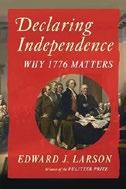
A well-worn subject in expert hands. Larsen, Pulitzer Prize–winning author of Summer for the Gods: The Scopes Trial and America’s Continuing Debate Over Science and Religion, reminds readers that 1776 began with the majority of America’s establishment opposed to independence. Leading the minority were figures like Samuel Adams and Patrick
Henry—noisy, rabble-rousing types hard to admire and not, like our core Founding Fathers, deep thinkers. January arrived with the shocking news that George III had rejected all the Second Continental Congress’s petitions, proclaimed the colonies in rebellion, and vowed to crush them. To rouse spirits, February saw publication of perhaps history’s greatest piece of political propaganda, Tom Paine’s Common Sense, which made a vivid case for monarchy as a ridiculous form of government and Britain as the worst possible monarchy. The king’s denunciation, followed by Paine’s wildly popular polemic, put opponents of independence on the defensive. On May 15, Congress, pushed by John Adams, sent a resolution asking the colonies to adopt republican constitutions. Larsen agrees with contemporaries who considered it a declaration of independence, but Congress didn’t propose a formal declaration until June. It came at a perfect time. Britain’s evacuation of Boston in March 1776 had convinced patriots that the Continental Army was a credible fighting force. Larsen does not ignore the irony that the epic July signing of the Declaration occurred simultaneously with the beginning of Washington’s disastrous New York campaign that damaged his reputation and persuaded patriots that a hard slog lay ahead. The author concludes with details of that campaign and the remaining odds and ends of politics. Colonial assemblies concentrated on easy work (constitutions, legislation, elections) and neglected the tedious business of managing the war.
The Articles of Confederation were not ratified until 1781. “In the meantime, without an official confederation, the thirteen sovereign states coordinated the war effort through a jerry-rigged Second Continental Congress.”
Insights on America’s iconic if bumpy year.

Lingan, John | Scribner (304 pp.) | $30 November 11, 2025 | 9781668056240

Pounding it out. Music writer Lingan wastes no time in explaining why he chose drummers as the subject of his new book: “Why shouldn’t drums and drummers get a chance to be the main characters of this story for once, after shaping it continuously for so long?” The 15 chapters that follow, each about an influential percussionist, put the musicians in the spotlight, and it makes for fascinating reading. Lingan covers many of the usual suspects—Ringo Starr of the Beatles, Charlie Watts of the Rolling Stones, and John Bonham of Led Zeppelin—and skillfully explains their innovations and the influence they had on the rock world. But it’s the non-household names that are truly interesting and that bring out some of the author’s best writing. On Hal Blaine’s performance on the Ronettes’ “Be My Baby,” he writes, “It’s more than a beat, really, it’s a unique feel, as much as the Cuban clave or a blues shuffle.” And he writes that Al Jackson Jr.’s memorable drums on Booker T. & the M.G.’s “Green Onions” “give the song its danger, too, its military stride.” Lingan does a terrific job explaining the technical aspects of drumming to a lay audience; this book is accessible to any rock fan, even ones who don’t know the difference between a snare and a tom. There is, unfortunately, one flaw: Of the 15 drummers featured, only one—Moe Tucker of the Velvet Underground—is a woman. Lingan does give brief shout-outs to female drummers, including Janet Weiss (Sleater-Kinney), Sandy West (the Runaways), and Gina Schock (the Go-Go’s), but any one of them could have had her own chapter, to say nothing of Karen Carpenter, one of the greatest musicians to ever sit behind the kit, who doesn’t even get a mention. Loud but often overlooked, drummers get their due in this entertaining survey.
Drummers “get a chance to be the main characters of this story for once.”
Liu, Yi-Ling | Knopf (336 pp.) | $30 February 3, 2026 | 9780593491850

An investigation of the Chinese internet and its place in Chinese society, reported from geographical and generational front lines and their margins. In her full-length debut, journalist Liu dissects and dismantles monoliths, highlighting and explaining the seeming contradictions and fatalistic predictions that fuel most conversations about China’s adoption, creation, use, and control of technology. Born and raised in Hong Kong—with its privileged relationship to mainland China—educated in the United States, and having built her journalism career in Beijing, she brings broad perspective and nuance to an issue that, despite its extensive global impact, is often discussed only in terms of its extremes. Into a milieu of weaponized tariffs and proprietary technology, the author injects essential context for China’s famed “Great Firewall” and profiles five individuals who have lived beyond its constraints: Ma Baoli, founder of China’s most successful gay mobile app; Lü Pin, a leader in the country’s underground feminist movement; Chen Qiufan (aka Stanley Chan), a science-fiction writer; Kafe Hu, a pioneer of China’s hip-hop and rap scene; and Eric Liu, a former tech content censor. These protagonists navigate double lives, self-censorship, collaborations with the Chinese diaspora, and the exacting crackdowns of their country’s authoritarian government, as their fellow “netizens” deploy a blend of irony, humor,
and wordplay to elude its control. If Liu’s text is in part revelatory of the particular ambitions, risks, and pitfalls humming beneath China’s internet domination, it is also a global cautionary tale. China’s push and pull between rigid control and loosened restrictions to serve economic growth is not an isolated story, but an example of how the entire World Wide Web has defaulted on its past promise to become a space for “the amplification of illiberal voices, the contraction of the public sphere, the erosion of common sense.”
A timely and sophisticated study that is eye-opening, and a touch eerie.
McCartney, Paul | Ed. by Widmer, Ted Liveright/Norton (576 pp.) | $45 November 4, 2025 | 9781324096306
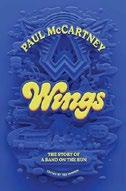
The erstwhile Fab and associates recount the history of his second backup band. Remember when Paul was dead? If you’re of an age, you’ll remember that hoax. But Sir Paul, as he relates in his foreword to this oral history, really was feeling half past dead, “drowning in a sea of legal and personal rows that were sapping my energy, in need of a complete life make-over.” Newly married to Linda, McCartney retreated to a farm in Scotland and rode out the psychic storm, releasing the then-notwell-liked solo album Ram and trying to figure out what came next. As he and some of his assembled mates, as well as the eminently sensible Linda,
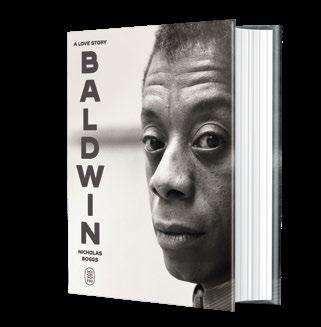


By Nicholas
Boggs
A dynamic portrait that deepens our understanding of a complex artist. 2
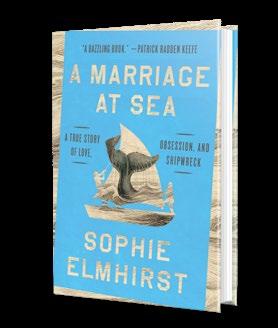

A rousing portrait of a charismatic actor who redefined global stardom.
By Sophie Elmhirst


The author of Dark Renaissance answers our questions.
IN BOOKS SUCH as Will in the World and The Swerve, Harvard professor Stephen Greenblatt is known for shining a bright light on dark corners of our cultural history. In his latest, a thrilling work of historical excavation, he brings to life the distant world of Elizabethan England— at once deeply strange and strangely familiar—and its most fascinating figure, Christopher Marlowe. The son of a lowly cobbler, Marlowe got himself educated at Cambridge University and wrote some of the most successful stage dramas of his time, inspiring William Shakespeare himself. (Blank verse in iambic pentameter? Shakespeare borrowed the form from Marlowe.) Then, at age 29, Marlowe’s life was tragically cut short in a murder that remains unsolved to this day. About that—and much else in the playwright’s mysterious life, including his possible employment as a spy— Greenblatt has a theory. He answered our questions by email.
I carefully track the way that the state gathered evidence against Marlowe in the month before his murder, evidence that was presented to Queen Elizabeth herself. In the margin of the report listing the things that Marlowe was allegedly saying, the queen wrote that it should be prosecuted “to the full.” Those words do not prescribe what actually happened on the fatal day that Marlowe spent with his three sinister acquaintances, but they may help us to understand why the killer and his accomplices were quickly exonerated and released.
What inspired you during the writing of the book? What were you reading, listening to, watching?
I felt the resonance of novels by John le Carré and, still more, by the great Spanish writer Javier Marías. Somewhere in the background, too, are Breaking Bad and Better Call Saul


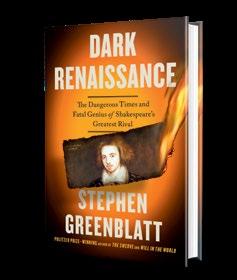
Why should people know about Christopher Marlowe?
First and foremost, Marlowe’s life story is extraordinary: a creative genius, a daring risk-taker, a spy. He blazed like a comet, and his brilliant, doomed life takes us into the heart of the dangerous world of the English Renaissance. Marlowe was the first great master of the public theater— the original mass entertainment industry—and his achievement made possible the career of his contemporary William Shakespeare.
The circumstances around Marlowe’s death are mysterious. Do you feel you were able to crack the mystery?
Where and when did you write the book? Describe the scene, the time of day, the necessary accouterments or talismans.
I did much of the initial research for the book in my quiet study on the top floor of Widener Library at Harvard. In the stacks on the floors below me—and within easy reach— were 3 million books. I continued the research in Canterbury, where Marlowe was born, and at Cambridge University, where he was a student. In the library of his college, Corpus Christi, are the books he would have studied; they are preserved because the books’ 16th-century donor required an annual audit and specified that if more than six large books were
Dark Renaissance: The Dangerous Times and Fatal Genius of Shakespeare’s Greatest Rival Greenblatt, Stephen Norton | 336 pp. | $31.99 September 9, 2025 | 9780393882278
missing, the entire collection, along with the college’s silver serving pieces, would be forfeited and given to another college. The result was that the collection is still intact. I also looked at the college’s “buttery books,” the records of the students’ daily purchases of beer and food. These enabled me to track Marlowe’s presence and his mysterious absences.
Interview by Tom Beer
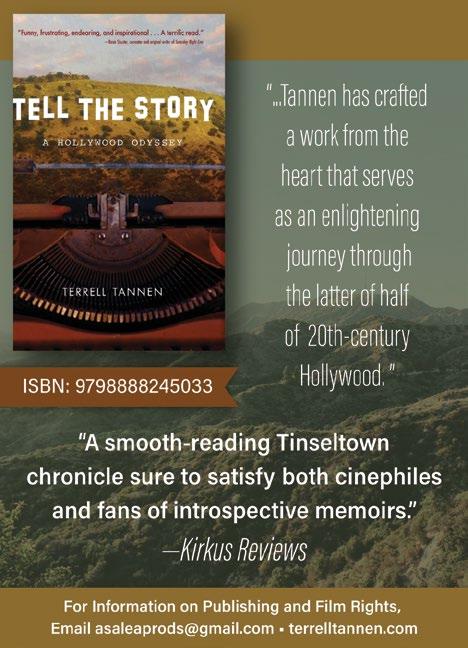


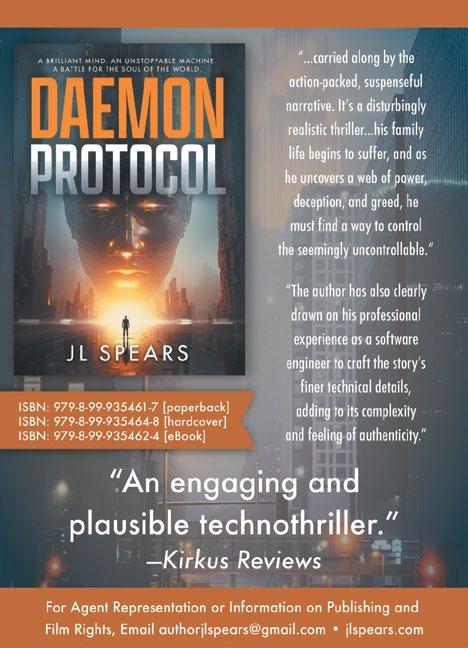

The conservationist and chimpanzee expert wrote more than 20 books.
Jane Goodall, the conservationist and prolific author known for her work with chimpanzees, has died at 91, the New York Times reports.
Goodall was born in London and worked as a secretary for paleoanthropologist Louis Leakey, who arranged for her education at the University of Cambridge. She began her research at the Gombe Stream
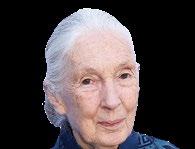

National Park in Tanzania in 1960, where she made groundbreaking discoveries about the social lives of chimpanzees. In 1977, she founded the Jane Goodall Institute, a conservationist organization that works to protect the habitats of primates. She wrote more than 20 books over a long career, beginning with My Friends, the Wild Chimpanzees in 1969. Her other books for adults include In the Shadow of Man; Visions of Caliban, co-written with Dale Peterson; and
Beyond Innocence: An Autobiography in Letters: The Later Years. Her most recent title, The Book of Hope: A Survival Guide for Trying Times, co-written with Douglas Abrams and Gail Hudson, was published in 2021.
Goodall’s admirers paid tribute to her on social media. On the platform X, President Barack Obama wrote, “Jane Goodall had a remarkable ability to inspire us to connect with the natural wonders of our world, and her groundbreaking work on primates and the importance of conservation opened doors for generations of women in science. Michelle and I are thinking of all those who loved and admired her.”—M.S.

For reviews of Jane Goodall’s books, visit Kirkus online.

recall, he decided that he wanted and needed to get up on stage; thus began his decade-long engagement with Wings. In this collection of sidelong glances and road tales, there are some expected truisms, as when Sean Ono Lennon says of Paul and John’s relationship, “They complemented each other like a plus and minus on a magnet.” The frontline, first-generation memories are more revealing, from McCartney’s account of his near–panic attacks on the Beatles’ breakup and redemption with surprise gigs with Wings around Britain to guitarist Denny Laine’s bitter parting from the group. Organized chronologically album by album, the narrative begins to wind down with McCartney’s imprisonment in Japan in 1980 for marijuana possession. As the musician allows, the bust forced the issue of whether Wings would continue (the rise of punk and New Wave also contributed to the band’s demise), but “the truth is that the inspiration had already begun to move elsewhere.” And though not disavowing the Wings years, having proved his point “that we could do something successful after The Beatles,” McCartney’s more given to mining his Beatles era than that second act, so that this book seems in some ways an afterthought.
Second-tier McCartneyiana, though fun for completists.
McDonald, Samuel Miller | St. Martin’s (432 pp.) $34 | December 2, 2025 | 9781250278319

Dreams of Eden. Progress does not necessarily make us better. Can you measure happiness, fulfillment, or the spiritual quality of life? This first book by McDonald, a geographer, seeks answers through a great cultural history of the West—running from ancient Mesopotamia to Christian Europe, from medieval faith to Enlightenment reason,
A celebration of a trade that has existed, for centuries, against all odds.
from war to peace and war again. We’ve told ourselves a story: The longer we live, the better; the more we have, the better. Rather than praising personal or national acquisition, the author argues for a “calculated commensalism,” societies “that practice economies of reciprocity.” We need to look back to what the author calls older, “ecologically sound societies” for models of this reciprocity. Such societies—ancient,non-Western,agrarian— were often conquered and destroyed by Western imperialism. Those old societies built a “pathway to those qualities of freedom, equality, leisure, abundance and peace…not through the conquest of frontiers and the hysterical extraction of life, but through experimentation… inquisitiveness and courage, and through the willingness to fight for these things.”
There is an idealism to this book that refreshes readers jaded by the claims of “techno-futurism” and the aspirations of oligarchs. You read this book and want to love the earth rather than reach for stars. At times, though, the book offers the overstatements of the justice warrior: “We must not see the political change we fight for today as yet another step…along the lineage of progressive history within which we so often situate our struggle.… Indigenous resistance stands outside this lineage of parasitism.” If a sharing, selfless society is out of reach in waking life, it still may fill our dreams. A critical history of progress rests on wishful thinking for a return to an ecologically sensitive, communitarian life.

For more history books, visit Kirkus online.
Mollier, Jean-Yves & Patricia Sorel | Trans. by Deke Dusinberre & Charles Penwarden Abbeville Press (320 pp.) | $89.95 October 7, 2025 | 9780789215161

A tribute to literary oases. Mollier and Sorel are French, so it makes sense that the scholars of the history of bookselling begin their global photographic tour of bookstores in their home country. Beyond any practical considerations, there’s good reason to start in France: It is, they write, “a world leader in book outlets per capita, and the first country to pass a law to protect ‘bibliodiversity’”—restricting online retailers from undercutting the country’s 3,500 independent bookstores. “Bookdealers have always been highly vulnerable,” the authors add, “whether burned at the stake in the sixteenth century (like Michel Servet in Geneva and Étienne Dolet in Paris), heavily fined in London in the late nineteenth century (like Henry Vizetelly, guilty of selling the English translation of Émile Zola’s allegedly ‘obscene’ The Soil ), or imprisoned in Brazil in the late twentieth century, for selling Marxist literature during the military dictatorship.” This book can therefore be read as a celebration of a trade that has existed against all odds. Readers will be familiar with many of the beloved shops featured here. In Paris, there is Shakespeare and Company, the English-language store that has attracted readers since the 1950s. Vibrant photographs capture its charm, from its wood beam ceilings to its upright piano. We see graceful interior and exterior shots of London’s capacious Foyles, as well as
the equally mighty Strand Bookstore in New York City and Powell’s Books in Portland. Happily, the book highlights many lesser-known stores, including ones in Asia, Latin America, and Africa. In Cameroon, the authors write, the Librairie des Peuples Noirs—the Black Peoples’ Bookshop—“symbolizes the struggle of its founder, Mongo Beti, and of all African people to make their rights and cultures known.” As the authors observe, “Bookstores are surprisingly diverse and inventive…. Gigantic or tiny, with or without a roof, fixed or itinerant, bookshops all convey the same love of books—a love that brings people together.”
A gorgeous and thoughtful overview that will bring joy to any bibliophile.
as Liberation: Reflections on the American Canon
Morrison, Toni | Knopf (240 pp.) | $32 February 3, 2026 | 9780593802748

The Nobel laureate as professor. Complementing studies of Morrison as a writer and an editor, this volume focuses on her courses on the American canon at Princeton, including teaching materials, course descriptions, lectures, and a syllabus. A helpful introduction and notes are provided by Morrison’s teaching colleague, Claudia Brodsky. Morrison aimed to guide students through close readings of 19th- and 20th-century American fiction “to discover what impact notions of racial hierarchy, racial exclusion, and racial vulnerability and availability have had on the literature.” How, she asks, has the concept of whiteness been “built/ invented/produced,” and how has it served the literary imagination of white authors in their exploration of American identity? Among the works she discusses are Edgar Allan Poe’s The Narrative of Gordon Pym, Herman Melville’s Moby-Dick, Gertrude Stein’s Three Lives,
Willa Cather’s Sapphira and the Slave Girl, Ernest Hemingway’s To Have and Have Not and Garden of Eden, Carson McCullers’ The Heart Is a Lonely Hunter, Harriet Beecher Stowe’s Uncle Tom’s Cabin, William Styron’s The Confessions of Nat Turner, Mark Twain’s Huckleberry Finn, and Saul Bellow’s Henderson the Rain King. Morrison reiterates in each lecture the uses that white authors make of the Africanist character, Africanist idiom, and Africanist narrative. Recurring themes include the surrogate self as enabler: that is, the use of Black people to aggrandize or explore the white self (here, Morrison notes that the enabling role of Africanism for men becomes disabling for women); the use of Black people to comment on the qualities and characteristics of non-Black people; blackness as a means by which chaos is negotiated through its association with anarchy, disorder, and illegality; and the use of race as a disguise for other types of divisions, such as class and gender. Deeply insightful investigations of major works.
Moyer-Nocchi, Karima | Columbia Univ. (320 pp.) | $28.95 | February 3, 2026 9780231215312
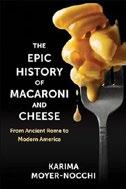
The meandering, culinary path of macaroni and cheese. How does one measure the impact an iconic dish has had on society and culture? How does one know what to include after researching a renowned recipe throughout the annals of civilization? The task is noble and large, and while scholar Moyer-Nocchi extensively researched her topic, seasoning the narrative with mouth-watering recipes, the sprawling history is bloated and the narrative is bland. With too many cooks and ideas in the kitchen, this book, if significantly
revised, could have been an interesting essay. The foodie may wonder why we are speculating on whether Thomas Jefferson consumed macaroni and cheese during a particular meal. The anachronistic vocabulary may also grate on the reader, with St. Thomas in the 13th century considering dairy a “hot topic,” Nicolas Bonnefons being “a noble wannabe,” and Antonio Frugoli suggesting macaroni and cheese “in a Hamburger Helper sort of way.” One has the sense that the author included everything she learned in her cherry-picked investigation, no matter how far the tidbit strays from the theme, whether cookbook mentions (including criticisms), the etymology of words, an 1833 magazine’s cover story, genealogies of the first Virginia families, pineapple cheese, the top-ranking menu orders of New York’s Fifth Avenue hotel between 1859 and 1865, Kraft suing Pabst, the origin of chilis, and the preservation of the Union through the Civil War. The “epic” of the title is misleading: This book feels more like a gluttonous list of trivia facts, and while macaroni and cheese obsessives may savor it, the rest of us will crave other reading experiences. An overcooked mush of historical anecdotes and random references.
Papin, Delphine, Bruno Tertrais & Xemartin Laborde | Thames & Hudson (192 pp.) | $39.95 November 18, 2025 | 9780500030493

This land is (not) your land. “God created war so that Americans would learn geography.” Mark Twain’s sardonic observation comes to mind when reading this captivating and wide-ranging collection of maps that highlight conflicts and disputes around the world. “Most often, borders are drawn in blood,” write the authors. “Even if we don’t take decolonization into account, more than a hundred
states have established their borders through war.” Papin and Laborde are cartographers at the French daily Le Monde, and Tertrais is deputy director of the Foundation for Strategic Research, a French think tank on international security issues. Beyond their many visually arresting maps, the authors also include insightful aperçus—the book is French, after all—that don’t usually make it into an atlas. The authors quote, for instance, the late legal scholar François Terré: “All borders are artificial, in the sense that they are defined by men and are therefore arbitrary: they are scars left by history.” Among those scars are numerous hot zones. Individual pages are devoted to Kashmir, the Mideast, and the South China Sea. A few maps explore the evolution of Ukraine, Russia’s invasion of that country, and Russia’s sphere of influence; as with all the images in the book, these maps are sharply designed in muted colors and accompanied by useful text. There’s much that will be new to readers: The Germany-Denmark border was established by a public referendum in 1920; a third of the world’s recent pirate attacks have occurred in the Gulf of Guinea; and tiny Märket, in the Baltic Sea, is the smallest island in the world divided by two countries (Sweden and Finland). Other maps document more familiar subjects. Addressing a global “proliferation of walls, barriers and fences”—notably, the world’s most traveled border, that between the U.S. and Mexico—the authors glean wisdom from philosopher Thierry Paquot: “A wall expresses a lack of understanding, separation, segregation….The builder of walls is a polluter of humanity.”
Exquisitely rendered maps of troubled territories, buttressed by a philosophical framework.

A philosophical take on the world’s borders—
“scars left by history.”
ATLAS OF BORDERS
Pappalardo, Joe | St. Martin’s (352 pp.) $31 | April 21, 2026 | 9781250287564

For more on borders, visit Kirkus online.
Prohibition-era Texas comes alive in this story of small-city corruption. Nearly 100 years have passed since the events that inspired this book occurred, starting in the spring of 1927, in a world both foreign and familiar. Amid an oil boom in the Texas panhandle, real estate speculators took a 240-acre plot of ranch land and turned it into a sin city named Borger after one of its founders (but nicknamed “Boogertown” by local wags). Designed to separate disposable incomes from oil field workers and others attracted to the area’s promise of easy money, in about a year, Borger sprouted speakeasies, gaming rooms, boxing and wrestling arenas, brothels, and dance halls. It also earned the reputation for being the most corrupt city in Texas, drawing the ire of newly elected Governor Dan Moody, a former attorney general who had routed the powerful Ku Klux Klan in the state. The murders of three police officers (among other homicides in the span of weeks) gave Moody an in to send a team of Texas Rangers led by Captain Frank Hamer, best known for killing Bonnie and Clyde a decade later, to clean up the town. Pappalardo, a journalist and author of several books on Texas and 20th-century history, confesses up front to imagining conversations there’s no record of, explaining his creative process in footnotes. The story begins to hit its stride after about 100
pages; when it does, the pages practically turn themselves as dozens of colorful characters—moonshiners, bank robbers, corrupt deputies and town officials, professional wrestlers, a daring oil firefighter, and, of course, a bunch of tough, seen-it-all Rangers—duke and shoot it out for control of Borger’s streets. History as if pulp writer Jim Thompson had written it.
Parton, Dolly with Tom Roland | Ten Speed Press (336 pp.) | $55 | November 11, 2025 9781984863133

A photo-filled career retrospective from one of country music’s biggest icons. Parton might be the one person all Americans can agree on. The country music star—and actor, author, theme park owner, and philanthropist— has radiated a sweet and positive energy since the beginning of her long performing career, which she chronicles in this colorful book. She writes about her childhood years as a “kid who needed a lot of attention” to her discovery by grocery store magnate Cas Walker, which led to her move to Nashville to pursue her musical dreams full time. Her big break came courtesy of Porter Wagoner, although her first concert with him—she replaced his previous duet partner, Norma Jean— brought her boos: “I thought, Whoa! Well, this will never do. I’m going to have to do something to get these people to change their minds.” Fans took to her soon enough, of course, and Parton spins entertaining stories of performing from tiny venues to
huge arenas. (One particularly amusing anecdote sees her playing “Me and Little Andy,” in which a girl dies and her puppy follows in short order, which led one concertgoer to yell, “Did you have to kill the damn dog?”) Parton brings an aw-shucks energy to her biggest successes, including roles in the films 9 to 5 and Steel Magnolias—she still seems shocked that she’s made it as big as she has. There are plenty of treats for fans: photos of her concerts, instruments, microphones, ticket stubs, and, naturally, the woman herself—one image of her beaming while snuggling a kitten could conceivably bring about world peace. This book is suffused with joy and gratitude; it’s a wonderful look back at a remarkable career: What a way to make a living, indeed. As cheerful and bighearted as the legend herself.
Pei, Minxin | Princeton Univ. (328 pp.) | $29.95 December 2, 2025 | 9780691223339
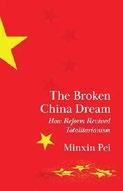
A somber story of the quashing of nascent Chinese democracy by the neo-Stalinism of Xi Jinping. Political scientist Pei opens at the 20th National Congress of the Chinese Communist Party in October 2022, when Xi Jinping’s predecessor as the party’s general secretary, Hu Jintao, was forced from the stage. The moment was emblematic of Xi’s revival of “the central elements of totalitarianism: personalistic rule, a cult of personality, permanent purges, stifling social control, ideological indoctrination, and an aggressive foreign policy.” This restoration also undid decades of reform begun in the late 1970s following the death of Mao Zedong, remaking the Chinese economy through relatively free enterprise and foreign investment. This in turn stimulated the global trade that in time built a thriving economy. It also sparked what was called “culture fever,” which allowed a liberalization of the press,
literature, film and television, and other media. The Tiananmen Square demonstrations of May-June 1989 closed this window, and Deng Xiaoping, the leader who had been so enthusiastic to see these reforms through, instead allowed the conservatives within the faction-riven party greater power. Even so, as Pei notes, globalization continued, with China offering itself up as a source of “ultracheap labor.” Xi’s reversals came about under several guises, including a so-called anticorruption campaign aimed at liberalizing elements in the government and other means to “almost singlehandedly dismantle the post-Tiananmen order.” The author predicts that the outcome will not be positive: China is increasingly isolated on the world stage, the economy is stagnating, entrepreneurship is in sharp decline, and Xi’s concentration of power almost guarantees a power struggle after he is gone. Moreover, Pei adds, Xi’s new cold war means that “an economically prosperous and politically liberal and open China” will elude the Chinese people for years to come.
Revealing insights into the current Chinese state, suggesting that it’s less juggernaut than paper tiger.
Mary Poppins: The Sherman Brothers, Walt Disney, and the Creation of a Classic Film Pierce, Todd James | Norton (256 pp.) | $29.99 November 11, 2025 | 9781324111078

B ehind the scenes of a beloved movie. Pierce, host of the popular Disney History Institute podcast, notes that Walt Disney had wanted to make Mary Poppins for decades. Attending its premiere in 1964 were Robert and Richard Sherman, who had poured their lives into it, Dick writing its songs and Bob the story—their first screenplay. In 1958 their song “Tall Paul,” sung by Disney’s Annette Funicello, was a hit and got the brothers into the Disney Music Company. They wrote another
song for her to sing and were asked to perform it for Mr. Disney, which he liked; he then asked them to do another song and read the working script. This led to more songs and to Disney asking them to read the Mary Poppins stories. Pierce describes how the brothers assembled songs to create a unified narrative in a historical period, with Mr. Banks ignoring his children key to the story. Disney was so pleased he gave them each a six-month studio contract, also requesting songs for other films. When they met with P.L. Travers, the author of the Mary Poppins books, she hated most everything they’d done but finally gave them permission. Pierce does a fine job discussing how the film’s songs were created, often drawing on the brothers’ own experiences. Julie Andrews was cast as Mary—her first film performance—which pleased Travers, and Disney was happy with Dick Van Dyke as Bert. Meanwhile, Disney had the Shermans composing music for his theme park; they were key in hiring Irwin Kostal to orchestrate the film’s music; and they also helped Andrews when she recorded her songs, which was “overwhelming” for them. Pierce explores in detail how many of the key scenes were created. After the film’s premiere, the brothers knew their future “would hold an element of grandness”— their four years of effort were richly rewarded with two Academy Awards. A thoroughly entertaining foray into the Disney world.
Polito, Robert | Liveright/Norton (336 pp.)
$31.99 | January 27, 2026 | 9780871402936

A ramble through the latter-day work of the ever-estimable Bob Dylan.
“No, not that Bob Dylan,” writes literary biographer and anthologist Polito: not the Dylan of “Like a Rolling Stone” and “Tangled Up in Blue,” but
the far lesser-known Dylan of albums such as Rough and Rowdy Ways and Empire Burlesque. Polito starts with a smart assessment of Dylan’s accomplishments since the 1990s: more than 3,000 concerts, two books, a movie, a weekly radio show, art exhibits on three continents. A point of constant return is one of Dylan’s most recent masterworks, the nearly 17-minutelong epic song “Murder Most Foul,” a major piece in the “memory palace” of Polito’s subtitle. The classical memory palace was a medieval construct for remembering by mentally populating its rooms with facts: Dylan, by Polito’s lights, is constructing “mental structures, particularly songs, that will house past and present, the living and the dead.” One aspect is Dylan’s turn to the Great American Songbook and the albums of traditional folk songs he recorded in the 1990s. As always, Dylan is an elusive figure in his own story; as Polito sagely notes, he may have begun his renaissance with a Keith Richards–like earring and black leather jacket, but he soon would dress in hoodies and eye-hiding hats and sunglasses “that declared he didn’t want to be there.” Yet Dylan was there, always, almost ubiquitous. As Polito also notes, not everything Dylan produced in his legendary career was spun of gold: Even die-hard Dylan heads have to admit that late ’80s albums like Down in the Groove and Knocked Out Loaded are dogs. (Rather uncharitably, Dylan lays the blame for the ups and downs of his 1997 album Time Out of Mind on its producer, Daniel Lanois.) But let Dylan have the last word: “That’s my story but not where it ends.”
An insightful look at Dylan’s lesserknown works, in all their multitudes.

A smart assessment of Bob Dylan’s accomplishments since the 1990s.
AFTER THE FLOOD
Rea, Stephen | Simon & Schuster (288 pp.) $29 | November 11, 2025 | 9781668061077
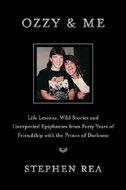
A writer reflects on his longtime friendship with the heavymetal legend. This memoir from Rea (not to be confused with the actor of the same name) was born out of a gift that rocker Ozzy Osbourne gave the author nearly 30 years ago: a pair of journals he bought at a hotel gift shop. “I want you to write things down, stories, just to keep a record, write whatever you want, they’re for you,” Osbourne told Rea. The two first met when Rea was a 15-year-old superfan who traveled from his Belfast home to see Osbourne play at the Rock in Rio festival in Brazil; Osbourne and his wife, Sharon, heard about the young man’s long trek and invited him to keep in touch. That he did—in the ensuing years, Rea became friends with the couple, at first as a “ligger,” or hanger-on, then as part of Osbourne’s road crew, joining the Prince of Darkness and his band as they toured across the U.S., Europe, and Asia. Rea had day jobs as a journalist and travel agency owner but still found time to do odd jobs on the tours, where he bantered with Osbourne and his ever-changing retinue. Rea has nothing but good things to say about Osbourne, whom he calls “the most generous person I ever met…modest and unassuming.” There’s an Almost Famous–like agreeability to the first part of Rea’s book, as he navigates being a teenager invited backstage to hang with metal
royalty, but he can’t quite sustain it; as he becomes older, the stories drag and the book grows repetitive. There are no reflections on why he was drawn to Osbourne’s music, and little insight into the musician himself. Some of these stories could be fun to listen to over a pint at a pub, but the finished product turns flat. A good-natured book that lacks its subject’s oomph.
Richardson, John H. | Simon & Schuster (256 pp.) | $29 | November 4, 2025 9781668209349
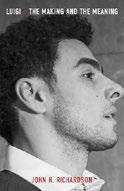
An impressionistic portrait of the young man accused of killing a health insurance mogul. Luigi Mangione has not been tried, at this writing, for his alleged murder of Brian Thompson, the CEO of UnitedHealthcare, in December 2024. This book by journalist and author Richardson would therefore seem to be premature, although it does contain some useful background information. For one, by Richardson’s account, if Mangione committed the crime of which he’s accused, then it might be the only murder in known history that can be ascribed to a book club—one that picked Theodore Kaczynski’s Industrial Society and Its Future, otherwise known as the Unabomber Manifesto, for discussion. By the author’s account, too, though Mangione didn’t accept every bit of Kaczynski’s analysis of the woes of the world, he took enough of it to heart to ask the inevitable question about what’s to be done—and to whom. “This is a book
about getting to that reaction,” writes Richardson. “It’s about Luigi and his kindred spirits. It’s about the dark magic in extreme measures.” Kaczynski himself, whom Richardson interviewed, appears to have been one such kindred spirit. Another, also interviewed, was the activist Rod Coronado, who “sank two whaling ships in 1986” and then, after serving a five-year prison term, picked right back up where he started. Coronado, however, eschews violence; not so fellow traveler Zach, who reasoned that “nobody in this country’s gonna respect any kind of peaceful movement…everybody here understands violence.” One oddity about the Thompson killing is that it immediately elevated Mangione to folk-hero status; who, after all, hasn’t been through the health insurance wringer? Yet Mangione also emerges from Richardson’s narrative as a very intelligent but confused man who accepted some bad ideas as he “searched for new structures of meaning to stabilize our unsettled world.”
Diffuse, but of some interest to those who’re following the Mangione case as it moves toward resolution.
Your Last First Date: Secrets From a Hollywood Matchmaker
Samuels Kuba, Jaydi | Avid Reader Press (256 pp.) | $28.99 | January 27, 2026 9781668079645

A Hollywood matchmaker serves up the tricks of the trade.
Samuels Kuba has long been a screenwriter, best known for her work with Seth MacFarlane on the animated series Family Guy and American Dad. Her matchmaking “side hustle,” as she puts it, has been more successful still; as she writes, gamely, “When I think of how I want to be remembered one day, it’s not for penning fart jokes for Liam Neeson: it’s for helping people find their forever partners, the ones they’re comfortable farting in front of.” Her long experience has given her a categorical
sense of whom she’s dealing with, men and women of financial and sometimes artistic success whose personal lives are a wreck or a drag, and whose “dating personae” run a generally unhappy range from Babblers (they just can’t shut up) to “Stiffs” (“we sit up straight, sip our drinks, and adopt a general attitude of ‘formal is normal’”) and “Workaholics” (who work their cell phones while ignoring their dates, with the author kindly suggesting that “they might need a little help unwinding”). Although being a Miss Lonelyhearts might seem a little, well, predatory (a word she uses herself), as it turns out Samuels Kuba does good service by helping her readers, male and female, concentrate on who they are as people and what they really want, while also teaching useful social skills such as mirroring the behavior they’d like to see in a potential partner (“If you want your romantic interest to call you instead of text, for example, then you call them first”). She’s also a formidable screener, highly useful in a dating milieu in which all too often women experience threats of violence or stalking from unsuccessful matches. All in all, a good primer for setting realistic but actionable romantic goals—and without making Hollywood bucks.
Satlow, Michael L. | Princeton Univ. (360 pp.) $35 | February 3, 2026 | 9780691256597
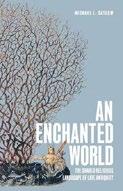
The complex spiritual world of Late Antiquity. Satlow, a Brown University scholar, delves into the oft-examined yet little understood period of Late Antiquity in the Mediterranean basin. This era, extending roughly from 200 to 600 C.E., witnessed extraordinary changes in the Western world, as empires divided, cultures transformed, and religion began to develop. Satlow’s goal is to look past the famous names and documented events of the period in order to see how most
people lived and, especially, how they expressed their spiritual lives. He notes that in this time, “religious identity was contextual, subjective, and could be worn or discarded strategically.” The world of Late Antiquity was abuzz with spiritual concepts and practices that drew on the Greek and Roman cultures, the changing landscape of Judaism, the new and developing Christian faith, and folk belief systems, among other sources. “Religion”—especially the religions of Judaism and Christianity, as understood today—was still being crafted by intellectual figures such as Augustine. The vast majority of people experienced a lived religion that was both simple in doctrine yet complex in practice, informed as much by their local cultures and customs as by priests, philosophers, and kings. Satlow leads the reader into a world rich with spiritual awareness and assumptions of the supernatural. He examines the importance of mediators with the divine, holy places for worship and petition, and acts of piety and prayer. “The world of Late Antiquity,” the author concludes, “was an enchanted one, one that was filled with invisible beings and forces that we could not control.” Satlow provides an accessible and intriguing glimpse into an era of sometimes tumultuous change, challenging the reader’s understanding of religion and of identity.
An interesting look at faith during a pivotal time in history.
Seed, Patricia | Univ. of California (264 pp.) $29.95 | January 6, 2026 | 9780520415874
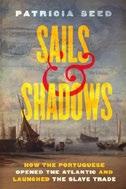
Schoolchildren taught that Portuguese navigators were the first to sail around Africa to India don’t learn the details. Seed, professor of history at the University of California, Irvine,
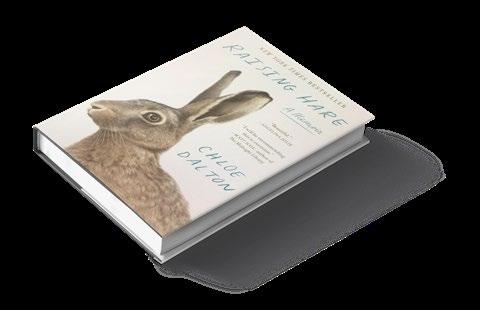
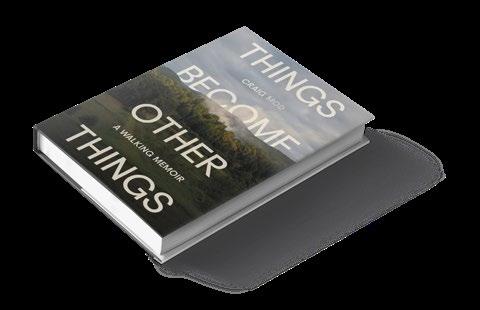

By Chloe Dalton
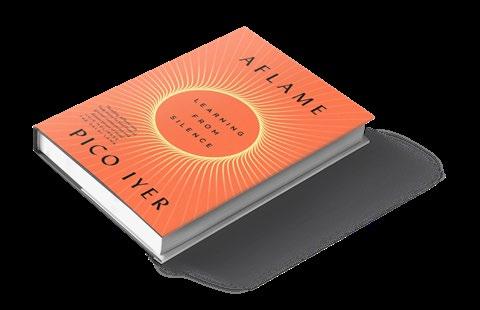
Pico Iyer
Craig Mod
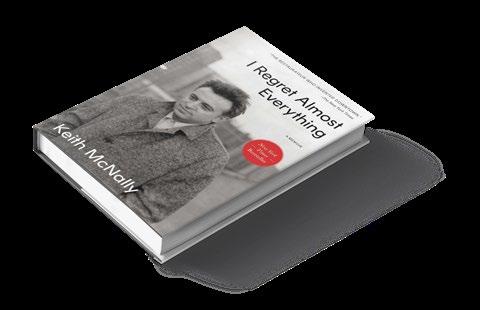
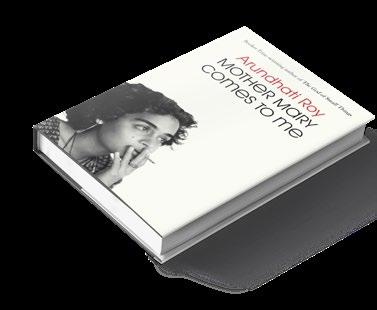
By Keith McNally
Susan Orlean

The author of How To Cook a Coyote answers our questions.
AT AGE 98 , noted food writer Betty Fussell is serving up a frank, funny new memoir. In How To Cook a Coyote, one of Kirkus’ Best Nonfiction Books of 2025, Fussell digs into late life, finding plenty to savor. She answered our questions via email.
between city attic and stepping out to feed the squirrels, birds, and chipmunks, the next major change hit. That was Covid-19. Even drawing into our shells didn’t save all of us.
What inspired you during the writing of the book?
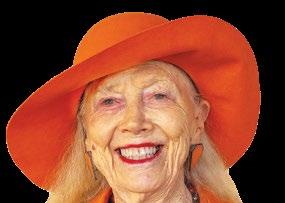
What was the original idea that started you working on How To Cook a Coyote?
I guess I was born to write down whatever was happening in my daily life and raised by grandparents who taught me to write as soon as I was old enough to tie my own shoelaces. Now that I’m at the end of my life, the need to write what’s happening to me as I approach blindness and death is increasingly urgent, but it took me 12 years to complete the book. Time was definitely running out.
Where and when did you write it?
I had been living on the East Coast, principally New York, for decades, but at age 88, I realized I was running out of energy to manage the hazards of a big city. Since I was born in Southern California, I knew I would return one day. I registered with Casa Dorinda in Montecito, an old folks’ home I’d checked out on one of my visits. My apartment at the Casa was what I dreamed of in my New York attic. I returned to living inside-outside with small distinction in between.
I realized how important living quarters were to my body—like a turtle in a shell. But just as I was getting used to the wild difference
The imminence of death. I was surprised after the toughness of New York to find that death was a forbidden subject at the Casa, or rather, a forbidden word. Euphemisms were essential, like passed on, departed, expired. This was a mark of Pasadena politeness. As a writer, I wanted to leave a mark before I died and for someone as old as I, who had a world full of memories, I wanted to pack them all in, but first I had to get them all down in order to see what to use and what to throw out. My main emotion, I think, was fear that I would leave something out.
Throughout, you express a love of music and movement. What’s your favorite song to dance to?
“Besame Mucho,” because I heard the music first in junior high school in the auditorium where we all gathered on rainy days. I had seen the tango in movies and realized I could imitate that hip movement from what I had seen and now heard on the record that was playing.
Now that our questionnaire is through, what are your plans for the rest of the day?
I am going to boxing class, to which I’m devoted because it is like dancing and our room is equipped with real boxing gloves and punch -
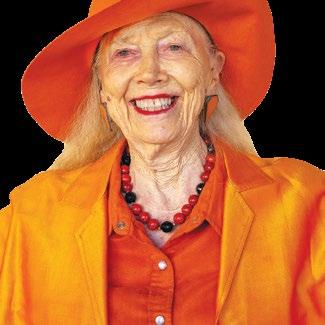

How To Cook a Coyote: The Joy of Old Age
Fussell, Betty
Counterpoint | 256 pp. | $27 December 2, 2025 | 9781640097384
ing bags. After lunch, I’ll watch the bocce tournament in the wonderful court and patio to the west of the dining room. I’ll meet a friend for dinner at the bar and grill and, afterwards, go home, get ready for bed, and watch a TCM movie like Week-End at the Waldorf.
Interview by Megan Labrise


This review was originally posted on the Kirkus website on November 25, 2023.
Journalist and Manhattan schoolteacher Chanko presents a novel that explores the lives of an educator and his students during an eventful school year.
In a school on New York City’s Upper East Side, Martin Jordanowski is teaching his first Writing Enrichment cluster class of the 2007-2008 school year. It’s an enormous feat for him just to establish minor connections with the troubled students in his class, many of them in their mid-teens. The student body contains a number of emotionally disturbed teenagers, mostly boys, who reside in shelters when not in school. Sassy Kandra McKissick and cocky, jealous Shay are in one of his classes; their lives and others’ are explored in depth as the novel progresses. Kandra lives with an abusive stepmother and has a penchant for physical violence at school; Shay considers her his property, and things get messy when Martin takes an interest in Kandra. Martin, who’s known to his students as “Mr. J,” is a 25-year-old from a small Indiana town who’s unwilling to surrender control of his classroom to a student body that, in its formative years, has already seen a great many difficulties before reaching the eighth grade. But he becomes emotionally involved with some of the students, which costs him dearly. He’s also contending with the solemn aftermath of his sister Cassie’s recent death by
overdose and the guilt he feels after distancing himself from his family in Indiana, which made him miss precious opportunities to see his sister before her death.
Martin must also deal with a teacher’s suspicious “accident” and a constant stream of threats and rumors ricocheting around the campus; he soothes himself with occasional drinks from flasks of whiskey as he navigates his way through it all. His fellow teachers include Shirley Holmes, a doting mother to her reckless 26-year-old daughter, Coretta, whom she hopes will follow in her footsteps (and who also happens to be Kandra’s cousin). Other teachers offering Martin counsel are gym teacher Paul Massaro, who gives him a cautionary welcome to the school, warning him of unsavory student behavior and an administration that always bends in favor of the students. These elements— as well as plenty of melodrama—all coalesce brilliantly and immerse readers in a world where education takes a back seat to interpersonal upheavals. This is a story about how instructors clash with embittered kids eager for attention. Chanko juggles the presentation of all these characters and their issues with immense skill. Because the novel focuses on a different character in each chapter, it effectively presents a prism of perspectives as each of the

Chanko, Kenneth
Luminaire Press | 308 pp. | $33.95 | $17.95 paper
November 18, 2025 | 9798886798616 | 9798886798609 paper
characters struggles with their own unique challenges over the course of the story. The author combines realistic dialogue, complex contemporary social issues, and characters to root for in this narrative. The result is a masterful tapestry of strife
and resiliency as teachers adapt to the diverse learning styles, comprehension speeds, and personalities of the many kids in their care. An immersive and engaging interior chronicle of young people and their enduring educators.

and author of To Love, Honor, and Obey in Colonial Mexico, reveals some enlightening details. Ancient Europeans had sailed into the Atlantic, but winds, currents, and tides off western Africa proved impassable. By the 15th century, better ships, instruments, maps, and techniques for sailing against winds and currents tipped the scales. Portuguese prince Henry the Navigator (1394-1460) deserves the credit for pushing his nation’s ships south, aiming to increase trade and conquest. Reaching India was a distant dream because no one knew if it was possible, but everyone believed that Africa teemed with riches and empires to conquer. The reality was less spectacular: Some gold and lucrative trade turned up, but the only consistent moneymaker was slavery. Seed delivers some unpleasant details of the contemporary slave trade, but her book is mostly a history of 15th- and 16th-century Portuguese world exploration. The author includes the usual vivid portraits of characters and encounters, peaceful and violent, between cultures, but, uniquely, she concentrates on the technical problems. Readers will find themselves immersed in the minutiae of currents, tides, winds, shoals, fogs, and storms that turned out to be major barriers to sailing south down the continent. Courage was not in short supply among the navigators, but far more significant were improved mathematics, charts, instruments, and information from Indigenous people. Vasco da Gama’s fleet that finally reached India in 1498 encountered an unexpected surprise. Indian monarchs were so wealthy that they sneered at his trade merchandise, but the Portuguese had modern firearms, and their arrival marked the beginning of nearly five centuries of European colonialism. Penetrating and original history.
Smith, Tracy K. | Norton (192 pp.) | $24 November 18, 2025 | 9781324050988

An invitation to poetry. Pulitzer Prize–winner Smith, U.S. Poet Laureate from 2017 to 2019, sees reading poetry as far more than an aesthetic experience. Poems, she writes, “can help you to love every other thing in the world around you,” inspiring empathy and curiosity, and mitigating fear. In each of five chapters, she offers a guide to reading, questioning, and rereading a generous selection of poems, urging us to ask how each poem matters to us. “Sometimes,” she writes, “a poem charges my way as if from across an epic expanse, shattering my comfortable view of the world and my usual place within it.” She begins with poems that helped her to find a “self full of light and hope” after her mother’s death. Deeply grieving, she found solace in Mark Doty’s “Ararat,” a poem about an Easter egg hunt, which she read as a kind of elegy. The poem helped her to answer the overwhelming question: “How am I to go on living after hope and happiness have been taken away?” Many poems come from struggle, from feeling lost, including her own “The United States Welcomes You,” about police violence against unarmed Black citizens, and Harryette Mullen’s “We Are Not Responsible.” Mullen’s devastating poem uses familiar corporate disclaimers to critique oppression and lack of protection for the vulnerable: “Before taking off, please extinguish all smoldering resentments….In the event of loss, you’d better look out for yourself.” Edna
Poems “can help you to love every other thing in the world around you.”
FEAR LESS
St. Vincent Millay’s “Assault” and Natasha Tretheway’s “Incident” evoke each poet’s sense of vulnerability in the face of real, or anticipated, threat. The author devotes a chapter to explaining how a poem functions and how its parts convey meaning. An appendix contains a biographical and critical summary for each of the 27 poets Smith mentions. A spirited literary journey.
Tanner, Harry | Bloomsbury Continuum (272 pp.) | $28 | January 13, 2026 9781399422291
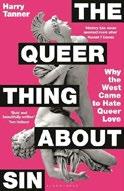
A university academic explores the origins of homophobia through Greek history. As an evangelical Christian teenager, author Tanner recalls firmly believing his simmering queer yearnings would send him to hell. After a period of suicidal ideation, he admits that studying ancient Greek altered his opinions on the Bible and its “passed down” translations and interpretations. This epiphany not only reinforced his self-acceptance as a gay man, but launched a keen interest in discovering why Western culture believed so sternly that homosexuality was sinful. His debut examines queer poets (Theognis), prophets, politicians, philosophers, and various locales throughout the ancient world (Lesbos, Boeotia) to uncover how society came to adopt a vehement hatred of queer sex and queer life. The agitators, his research revealed, were economic discrepancies, political inequality and the masculine ideals adopted by victorious Greek soldiers, and the ancient versions of “mob-rule” democracy, where the rise to power of wealthy oppressors brought forth the demonization of same-sex desire. Despite Athenians who sought to capitalize on the meek and less fortunate, queer love thrived in classic couplings like Homer’s Achilles and Patroclus and
in classic Greek theater performances. Eventually, homosexual desire and queer sex became derogatorily associated with a “depraved lack of self-control” and was considered a predatory, perverted act and a symbol of “extravagance and excess”; this attitude had lasting sociological effects on Greek populaces and expanded globally through religious means, among others. The author delivers this rich history with vibrant authority and fairmindedly reveals the overlooked legacies of queer women and transgender individuals despite the annals of Greece and Rome being dominated by often misogynistic male voices. If Tanner’s scrutiny becomes overly academic for the casual reader, the text brightens toward the concluding chapters, in which he shifts his timeline to examine how modern homophobia continues to demonize queer love. Countering incremental advancements in queer equality, he issues a concluding caution: “Just because we live in a moment of tolerance and acceptance now, it doesn’t mean we always will.”
A scholarly, immersive, and vital history of queer intolerance.
Kirkus Star
Telford, Max | Norton (320 pp.) | $29.99 November 11, 2025 | 9781324065425

Climbing the tree of a “dazzlingly diverse” life. Telford, an evolutionary biologist at University College London, tells the story of the search for life’s ancestors in this fast-paced and highly entertaining examination of life forms, from LUCA—the Last Universal Common Ancestor—to Homo sapiens. The concept of the tree of life, perhaps first conceived by Aristotle, is a visual representation of relatedness, explaining how all living species, “from oak trees to orcas,” are connected. Telford works at solving what
he calls “science’s greatest puzzle,” how the products of the process of evolution came to be. The tree of life is “a portal that can transport us back in time to meet our ancestors,” he writes, and his book has the feel of an amusement park ride through time as he leaps from one epoch to another, from LUCA’s beginnings 4 billion years ago to the appearance of Homo erectus 1.5 million years ago, with dozens of stops in between. Life is a “collective noun encompassing every single living thing, every species alive today and every species that has ever existed.” Telford explains the very complicated science of the ancestor search in simple terms. The 9 million species alive today are a tiny fraction of the billions of species that have ever existed on Earth. Most fossils have no remaining DNA, which is a soft tissue that degrades rapidly, at least in geological time. The oldest intact DNA found to date is 2 million years old, so using DNA to build the tree of life is useful for “only the last 0.3% of the history of the animal kingdom and just the final 0.05% of the total history of life.” That’s still a lot of life to categorize, and Telford and a worldwide community of scientists are looking for connections among species and fossil DNA to put the branches and twigs in their proper place on the tree. From the first simple cell to today’s variety of life forms, this is the story of us—fascinating, captivating, and complex.
Thompson, Cheryl W. | Dafina/ Kensington (288 pp.) | $30 January 27, 2026 | 9781496750778

Stories of men and families who made the ultimate sacrifice for an often hostile homeland. Tuskegee Army Flying School in Alabama, established in January 1941 to train Black pilots for
the military nearly a year before the attack on Pearl Harbor, was considered an experiment that some in the starkly segregated military never expected or hoped would succeed. Racists at the Department of War were skeptical that Black people even had the right stuff to fly an airplane. When First Lady Eleanor Roosevelt on a whim in an April 1941 visit to the school hopped into a two-seater for an hour-long flight over Tuskegee with a Black flight instructor, her security detail had a fit. (Upon landing, Roosevelt turned to her pilot and said, “Well, you can fly all right.”) Hundreds of ambitious young Black men signed up for the program. The best flew missions accompanying Allied bombers in Europe, often out of Ramitelli, Italy. Twenty-seven of these men never returned home, lost under mysterious circumstances. Thompson, a veteran investigative journalist for the Washington Post and NPR whose father was Tuskegee trained, suggests that many of these incidents were due to faulty singleengine fighter planes that were already old when the Tuskegee pilots were assigned to fly them. One family member told Thompson she believed the military “intentionally equipped the young, inexperienced Black pilots, like her dad, with less than stellar aircraft because the men weren’t wanted as pilots in World War II, to begin with.” Interviews with survivors, many now in their 90s, reveal intense feelings of pride and sorrow over the lives lost, and lingering anger over the shoddy treatment their loved ones faced in the U.S. and abroad.
Poignant, bittersweet lives of unsung and overlooked American heroes.

For more on Tuskegee, visit Kirkus online.
Thompson, Heather Ann | Pantheon (464 pp.) $35 | February 10, 2026 | 9780593702093
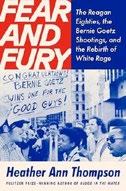
Vigilantism roils the nation.
Thompson, a Pulitzer winner for Blood in the Water, her history of a 1971 prison uprising, not only presents a comprehensive account of a vicious outburst that shook New York four decades ago. She also elucidates how the incident still has a malign influence. On December 22, 1984, Bernhard Goetz, a 37-year-old Manhattanite, shot four Black teens on a city subway. The victims, she writes, were “boisterous,” but Goetz, an unabashed bigot, said he didn’t feel threatened. “If I had more bullets, I would have shot them all again and again,” he told police. The victims survived but were forever changed, Thompson writes. One suffered brain damage and would spend his life in a wheelchair; another “deliberately overdosed” on the 27th anniversary of the shooting. Goetz, meanwhile, gained numerous white admirers. He signed autographs, received a Good Samaritan award, and did under a year in prison. Thompson thoroughly covers the court proceedings, but she truly excels when exploring the broader trends that led to the shooting and the “throughline” connecting Goetz to “the America of President Donald Trump.” Digging into Ronald Reagan’s policies—tax cuts for the rich, funding decreases for city services—she explains how high unemployment and underfunded schools in urban neighborhoods were among the “larger forces working against” the victims. Subsequently, the “white racial
rage” supporting Goetz empowered right-wing organizations like the NRA, politicians like Rudy Giuliani, whose stop-and-frisk policing openly discriminated against people of color, and media organizations like Rupert Murdoch’s New York Post, which championed Goetz and honed a belligerent conservatism now seen by millions of Murdoch’s Fox News viewers. Thompson’s prose can be repetitive—more than two dozen sentences start with the phrase “what is more”—but her skill for historical dot-connecting makes this a worthy, informative book. Skillfully exploring the link between an infamous subway attack and mean-spirited politics.
Kirkus Star
Tkalčić, Hrvoje | Princeton Univ. (280 pp.) $29.95 | January 13, 2026 | 9780691271477

The molten mystery beneath our feet.
The deepest human-made hole on Earth, drilled by the Soviets during the Cold War near the border between Russia and Norway, reaches more than 12 kilometers deep into the darkness of the Earth’s crust. Impressive, but barely a dent in the 6,000 kilometers that stretch to the center of the planet. Going further isn’t an option; the way is blocked by a boiling metal ocean. That’s why Tkalčić, a geophysicist at the Australian National University, considers seismology his “life’s calling”: The best tools scientists have for probing that inaccessible interior are earthquakes. And there are more of them than you’d think.
In 2020 alone, 350,000 earthquakes were recorded.
WHEN WORLDS QUAKE
In 2020 alone, seismographs recorded some 350,000 earthquakes around the globe. Most don’t rise to the level of human perception, but seismologists use them to image the Earth’s innards the same way radiologists use ultrasounds or X-rays to peer inside the body. Tkalčić explains these methods in rich but accessible detail. We learn, for instance, how plate tectonics regulate the climate by drawing down carbon deposits from the ocean floor, spewing it back into the atmosphere through volcanic eruptions. Meanwhile, the convection of liquid iron in the core produces the Earth’s magnetic field, which deflects solar wind and radiation. Without these dynamics, “life on Earth would not be possible.” Our planet, in Tkalčić’s rendering, is hardly an inert rock, but a restless network of roiling activity, with secrets still lurking in its depths. As the author traces the historical efforts to uncover those secrets, his narrative, at times, is overly expositional (“Charles Richter looked up at the starry sky of southern California and thought what a great job he had done in introducing the concept of magnitude into seismology, from astronomy”); nevertheless, the science is fascinating, and Tkalčić’s descriptions of his own fieldwork are riveting reminders of just how hard won the everyday facts of science really are. The author’s decades of research inform every page, and his enthusiasm for his subject is contagious. A passionate scientific account of the alien world inside our home planet.
Traub, James | Norton (304 pp.) | $32.99 January 13, 2026 | 9781324079514
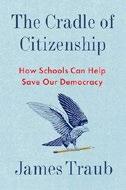
Classics to the rescue. Schooling in America has been the cradle of democracy. With culture wars fought in the classroom and the school board, though, education has become suspect. This book by journalist and author
Traub (True Believer: Hubert Humphrey’s Quest for a More Just America) lays out a plan to return the schoolroom to being a place where students can trust in knowing something. It advocates restoring “great books and the conscious molding of character.” It wishes “to escape the steel cage of our culture wars, to find our way to a deeper and less ideological connection to our history and ideals.” Through a series of historical and contemporary case studies, the book traces possible maps for finding that connection. “Classical education,” Traub writes, has a “goal of human development.” Education is “a form of training— above all, in reason—that makes the good life possible.” Thus, historians such as Howard Zinn and curricula such as the 1619 Project come in for critique. But Traub is no knee-jerk conservative. He praises the musical Hamilton for its complexity and provocation—the kind of artistic work that can stimulate “civic projects to draw on students’ idealistic wish to make their world better.” He chastises those leaders on the right who would rewrite curricula to patriotic ends. He wants, instead, curricula that are “narrow but deep”—strong on enduring works, light on personal electives. He invokes the Founding Fathers who, he says, “believed, like the classical writers they so admired, that a republic ultimately rests on the virtue of its citizens. We no longer think that way.” He wants parents to “seek out schools that have an overtly communitarian or ethical culture.” This may seem an old-fashioned vision. But the book stands out for its balance, generosity, and hope.
A reasoned, balanced argument for a return to “classical education” as a foundation for remaking American civic virtue.
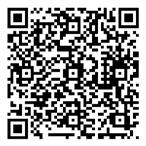
Ulloa, Jazmine | Dutton (352 pp.) | $30 March 3, 2026 | 9780593471869

Illuminating the history and identity of “the new Ellis Island.”
Ulloa, a national reporter for the New York Times, recounts the turbulent history of Mexico, Latin America, and U.S. border states by following five families: the Chews, Martinezes, Holguins, Rubios, and Mura’ls. The author, who covered murders in Ciudad Juárez, Mexico, and a mass shooting in a Walmart in El Paso in 2019 (the tragic retellings of the horrific crimes are in this book), makes the case that El Paso deserves the historical spotlight. She succeeds with flying colors. Readers may sometimes find the detail-loaded narrative of this crossroads, gateway city difficult to follow, as the author jumps back and forth across generations and continents, overlapping and weaving through the families’ trials, glories, historical figures, and tribulations. But the outpouring has a purpose: As much as we try to suppress, ignore, or compartmentalize history, it has a way of clawing its way back. We can’t escape the traumas of our past, and if we don’t face them head-on, as Ulloa does, they will return with an insidious force. In the ebbing and flowing narrative of immigration battles and families trying to find their place in the world, the author guides us, expertly, through history, politics, and personal stories, ending with her own family’s origin story. She deftly employs Spanish terms throughout the book, from los hornos (outdoor ovens) to obreros (workers) to vagos (wild ones), which infuse the work with an authentic sense of place. El Paso, she writes, is a “backdrop to
an immigration fight that at its crux, scholars say, is truly about the preservation of American democracy.”
A passionate and urgent account that transforms the embers of a bypassed history into flames that consume the present.
Wansbrough, Barbara | Eris (188 pp.) | $22 paper | November 11, 2025 | 9781967751044
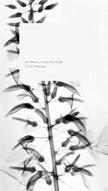
A grief journal in letters, filled with the particular balm of the natural world. Wansbrough, transplanted from England to California, writes 59 letters to a beloved older sister who died of cancer during the pandemic, one for each year of her sister’s life, each themed around a plant or animal she encounters on walks through Griffith Park in Los Angeles: Sacred Datura to Great Blue Heron. “I have written letters, I have written poems, I have written prose, I have painted pictures, I have painted walls, I have saved time and I have wasted time. I have watched it rush past and I have seen it inch along, but through all of it, I have walked. I have walked towards my grief, I have walked away from it, I have walked over and under it and, sometimes, I have even walked through it.” As she revisits their troubled family history with her sister as the presumptive audience, the author finds solace and food for thought in botanical and zoological detail, in lines of poetry, and in a long episode of magical thinking that stretches over the course of the book. Wansbrough begins leaving notes and tokens intended for her sister behind a rock, and is thrilled when replies and similar gifts begin to regularly appear. “Of course, there have been many times in the past year or so when I have hoped you would appear in one form or another—especially when the rest of my life feels especially precarious
and I need your support. But mostly I have taught myself to be content with hummingbirds and purple flowers, a few crows, a deer crossing, an owl, several snakes—and of course your messages and gifts left behind the rock.” The development of this storyline gives the book a nice touch of suspense and momentum, even if both she and the reader are aware that there will surely be a more pragmatic explanation. Lyrical, openhearted expression and naturalist insights make this a fine addition to the literature of magical thinking.
Weinstein, Philip | Godine (152 pp.) | $24.95 November 11, 2025 | 9781567928440
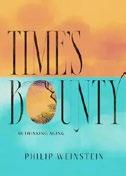
Old age’s “compelling dramas.”
Weinstein has been writing and teaching about literature for six decades. Now in his 80s, he returns to the great works that have sustained him to write a guide to growing old with grace and wisdom. Aging liberates him. He feels no need to apologize for celebrating literary genius and its hold on human emotion. The late poetry of Thomas Hardy, for example— with its understated ironies and autumnal wit—inspires readers to live on past loss. He writes, “Even as death marks our inescapable creatureliness, it fuels creative departures.” Surviving the Covid-19 pandemic prompts a turn to T.S. Eliot, whose Four Quartets become a guide to self-reckoning. “Eliot articulates, exquisitely, the drama of defenses crumbling, of our later recognizing self-interested moves that had earlier, cunningly, passed themselves off as ‘exercise of virtue.’” Weinstein looks back on his academic career: one of “reckoning of literary values [and] teaching students how to recognize and assess those values.” Proust and Joyce, Faulkner and Dostoyevsky, come back to him. Like a man at sea in an increasing fog, the greats ring
out as buoys guiding him to harbor. King Lear and Waiting for Godot take us to the edge of self-awareness. “Our greatest writers take us into the presence of what can hardly be borne—but can be written.” This is a memoir of professional privilege: Ivy League degrees, a Swarthmore career. Readers of less refinement may find the book (for all its brevity and seeming quietude) repetitive and self-congratulatory. But there is no questioning his sincerity. This is a book for his contemporaries in age and sensibility. If today’s students and teachers can get past its armchair judgments, they may find it, at best, sweetly elegiac. A professor argues that great literary works can guide us to appreciate virtue, honesty, and self-awareness in old age.
Whiteson, Daniel and Andy Warner
Norton (272 pp.) | $29.99
November 4, 2025 | 9781324064640

The universe as we may never know it. If aliens were to visit from some far-off planet, might they come bearing the secrets of the cosmos?
Surely any creature capable of intergalactic travel knows more about physics than we do. Maybe they evolved to hear space-time curvature or taste light or feel dark matter. Whiteson, a particle physicist, and Warner, a cartoonist, imagine such wild possibilities in this deceptively entertaining book. It’s written in casual prose (“There are many potential benefits to aliens’ arriving, starting with getting the day off from work”), peppered with goofy cartoons (a cat presents the catnip theory of the universe), and interspersed with snippets of sci-fi (an alien race communicates using “gestures coordinated with facial color changes”), but beneath the cutesy presentation is a profound philosophical
question. Does science capture objective features of the world, or does it reveal our own biological, cultural, and historical whims? We like to think of physics as an expression of ultimate truth, written in the universal language of mathematics—a language we would inevitably share with those little green men. After all, whether you speak English, Chinese, or Klingon, one plus one still equals two. Or does it? “What if aliens arrive sloshing around in plasma environments where these distinctions are so fuzzy that the concept of a countable individual doesn’t exist and counting and arithmetic are unknown to them?” the authors ask. This is the deep insight of the book: The way we carve up reality—into objects, numbers, words, stories—may be as much a reflection of ourselves as it is of the universe. At times the writing veers glib (as when they describe Carl Sagan as an “influencer”); occasionally, it’s wonderful: “Our words are local and restless, changing over time as language wriggles into new contexts.” But always, it’s chock-full of insights, from the physics of emergence to the limits of logic. That’s the power, it seems, of little green science. Charming, funny, and surprisingly philosophical speculations about alien science raise deep questions about science itself.
Whitmire, Ethelene | Viking (320 pp.) | $30 February 3, 2026 | 9780593654194
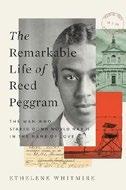
Love, war, and madness.
Historian Whitmire draws on archival sources, including hundreds of letters, to recount the life of Reed Edwin Peggram (1914-1982), a gay Black Harvard doctoral student whose life was changed decisively by the exigencies of war. In 1937, he set out for Paris, funded by fellowships, where he would attend the Sorbonne and conduct
research at the Bibliothèque Nationale to further his graduate work in comparative literature and his aim of becoming a French professor. His intellectual prowess had set him apart even as a child: Raised by his grandmother, a housecleaner, in Boston, he attended the prestigious Boston Latin School and was accepted into Harvard’s class of 1935; although African American students were required to live off campus, Peggram thrived in Harvard’s academic rigor, graduating magna cum laude. He embarked on graduate work at Columbia in 1936 and in Harvard’s doctoral program the following year, when he developed a mad crush on a Harvard junior, Leonard Bernstein—who rebuffed him. Soon Peggram was off to Paris, where he happily settled in: He joined the lending library at Shakespeare and Company, socialized with friends, and fell in love with Arne Hauptmann, a 22-year-old Danish art student. Urged to return home as war erupted, he refused unless he could obtain a visa for Hauptmann, whom he saw as his soulmate. The two men did leave France, hoping to find a safe haven in Florence. Instead, they often feared for their lives. Eventually imprisoned, they escaped when the Allies pushed north into Italy. Running for their lives, Peggram was found by an African American regiment in December 1944 and, suffering a mental breakdown, was finally sent home. His last years, sadly, were a trajectory of decline. A sympathetic portrait of an extraordinary man.
Williamson, Vanessa S. | Basic Books (352 pp.) $32 | November 11, 2025 | 9781541606111

The ties between taxes and democracy. In 1773, when the Sons of Liberty dumped a cargo fortune full of tea into the Boston Harbor, a foundational American myth was created
alongside a critical tax uprising. The protesters, most of whom remain to this day unknown, were rebelling not against taxation as a concept but rather in opposition to the taxes levied by the British crown and in favor of the Americans’ right to tax themselves and control the spending of their own hard-earned resources. The persistent misconception that the spirit of the United States was born of a core opposition to taxes, taxation, and democracy, scholar Williamson argues, limits the vision of what this nation could be and poses serious threats to our system of governance. Starting with recentering the true motives of the Boston Tea Party, Williamson unfolds the story of American taxation and our relationship with taxes in ways that carry the reader easily through complex concepts. At its heart, the work makes the case that fights over taxation are battles for the existence of democracy itself. Around the world, authoritarian regimes tend toward levying lower taxes, while functional and free societies impose higher taxes and use the resulting revenue for public services. In vibrant writing, the author elucidates how anti-tax movements throughout the course of our existence have eroded our democracy and been used as part of racist movements. Americans are not, she explains, inherently opposed to taxes. Rather, throughout our history, the most serious threats to American democracy, rights, and liberties have come from elites who are opposed to their own taxation and build coalitions with the less wealthy to force their agenda. Essential reading in our current moment of economic inequity and threats to democracy.
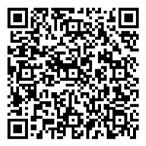
Wilson, Bee | Norton (320 pp.) | $31.99 November 4, 2025 | 9781324079248

For more on democracy, visit Kirkus online.
A collection of short essays about how kitchen objects carry our grief. For her wedding, journalist and author Wilson baked a “rich, dark fruit cake” in a “heart-shaped tin.” Two decades later, the tin unexpectedly fell at her feet, tumbling out of the drawer where she stored it because it was too large for her kitchen cupboards. The timing of the fall felt like an eerie coincidence: Months before, her husband ended their marriage when he left her “out of the blue, for another woman. It felt like a sign.” The tin, Wilson realizes, is just one of the many kitchen objects that she associates with loss. There is, for example, the toast rack her mother loved before dementia robbed her of her memories and, eventually, her life. In the process of cataloging her losses, Wilson notices the emotions others attach to their own kitchen objects during times of grief and mourning. From the “tenacious and brave” Ukrainian cupboard that stubbornly clings to a building wall despite a Russian “bombardment,” to a friend’s pasta bowl that symbolizes his struggle with hoarding, to the disposable paper coffee cups that ushered in the age of overconsumption, Wilson is fascinated by how people imbue objects with meanings that symbolize their greatest losses and most intense grief. The strongest essays in this collection are about the author’s own experiences as a divorcée on the precipice of her mother’s death; each of those narratives moves through a morass of loss with quiet, lyrical dignity. By contrast, the essays most removed from her life—and, in particular, the ones about social phenomena like paper coffee cups—tend to drag, their pace burdened with research rather than buoyed with emotion and reflection. A memoir in essays about the emotional power of objects in times of mourning.


Interactive Content

Kindle eBook ISBN: 978-1-7343635-4-8 www.laevnotes.com
Paperback ISBN: 978-1-7343635-3-1

“Rich personal and cultural history of a young woman in Berlin’s Belle Epoque.”
—Publishers Weekly/ BookLife Reviews

“A tender, personalitycentered biography of golden age Berlin.”
—Kirkus Reviews
“A wonderfully composed portrayal that could be considered narrative Art Nouveau.”
—BookTrib
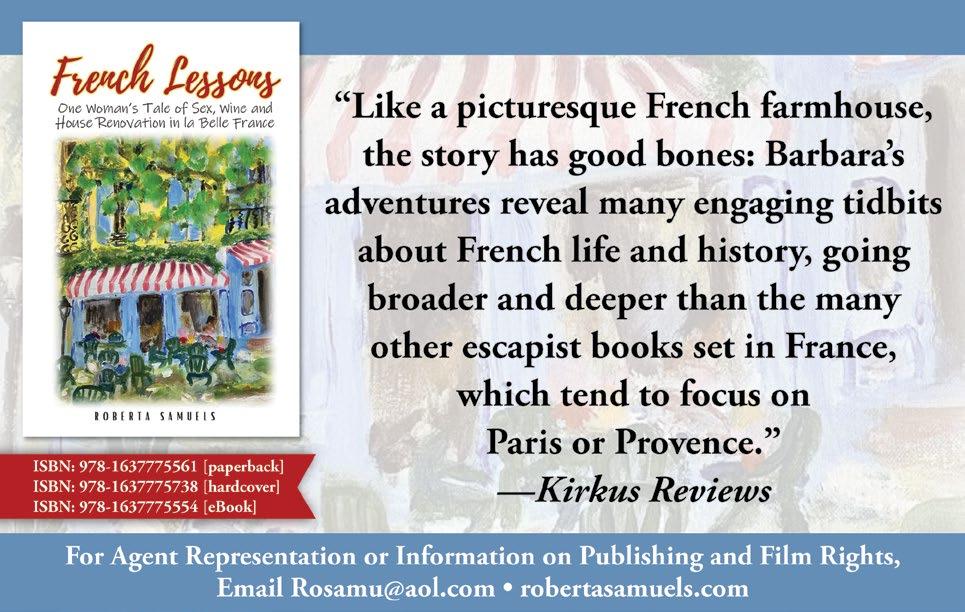


EDITORS’ PICKS:
Pretty Girl County by Lakita Wilson (Viking)
Dawn by Marc Martin (Candlewick Studio)
Marseille 1940: The Flight of Literature by Uwe Wittstock, trans. by Daniel Bowles (Polity)
Bring the House Down by Charlotte Runcie (Doubleday)
THANKS TO OUR SPONSORS:
Give First: The Power of Mentorship by Brad Feld
Prophetic Redemption by Paul Headworth
Fully Booked is produced by Cabel Adkins Audio and Megan Labrise.

A nonfiction debut considers what it means to be Native American. BY MEGAN LABRISE
ON THIS EPISODE of Fully Booked , Joseph Lee joins us to discuss Nothing More of This Land: Community, Power, and the Search for Indigenous Identity (One Signal/Atria, July 15). In a starred review, Kirkus calls his nonfiction debut “a searching and timely exploration of indigeneity and its many interpretations.”

Lee is an Aquinnah Wampanoag writer based in New York City. His work has appeared in the Guardian , BuzzFeed , Vox, and High Country News, among other outlets. He was a Margins Fellow at the Asian American Writers Workshop and a Senior Indigenous Affairs Fellow at Grist. He earned an MFA from Columbia University and teaches creative writing at Mercy University.
Here’s a bit more from our review: “Over the course of U.S.–Native American relations, too few people have remembered that the East Coast once abounded with Indigenous settlements. In the case of the Wampanoag, famed for their generous role in the first Thanksgiving, writes Lee, ‘we, the Aquinnah Wampanoag people, only own a small piece of the smallest town on…what is now Martha’s Vineyard—one of the most expensive and exclusive vacation destinations in the country.’ Owning land, Lee observes, is one of the principal ways that one can claim sovereignty over a place.…As Lee, of mixed Asian, European, and Wampanoag descent, explores the issue of sovereignty, he necessarily opens the door to the question of who qualifies to be Native American.…Lee travels widely across the U.S. and visits with Indigenous peoples from Oceania and South America to look at how such matters are addressed, concluding that ‘there

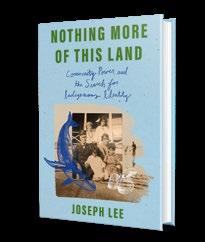
Nothing More of This Land: Community, Power, and the Search for Indigenous Identity Lee, Joseph One Signal/Atria | 256 pp. | $28.99 July 15, 2025 | 9781668087251
are different ways of being Wampanoag and what works or is meaningful for someone might be different from the way I approach things.’”
Lee tells me how Nothing More of This Land came to encompass his personal experiences as well as Indigenous perspectives from around the world, and he emphasizes the importance of conveying complex histories through a plurality of voices. We talk about people living modern lives on ancient land, his favorite parts of the book, the family photo that graces the cover, and much more.
Then editors Laura Simeon, Mahnaz Dar, John McMurtrie, and Laurie Muchnick share their top picks in books for the week.

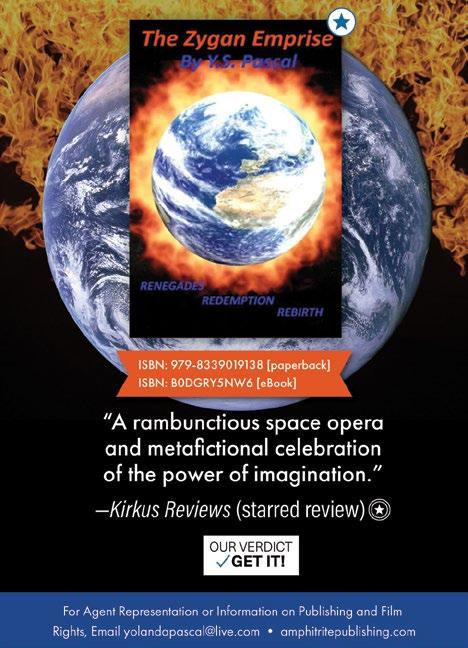
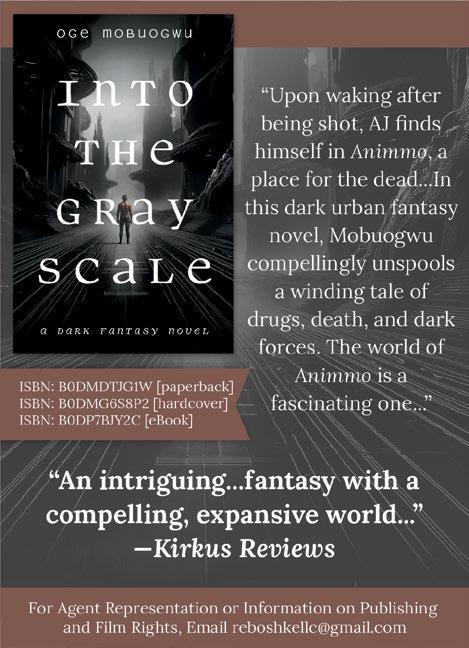

The movie will be based on Bob Mehr’s book on the legendary rock band the Replacements.
Actor Finn Wolfhard is adapting Bob Mehr’s Trouble Boys: The True Story of the Replacements as a film, Variety reports.
Mehr’s book about the legendary Minneapolis rock band was published in 2016 by Da Capo. In a starred review, a critic for Kirkus wrote, “The dynamic that made the band great also tore

them apart, as this biography superbly documents.”
Wolfhard, best known for his role as Mike Wheeler on the Netflix series Stranger Things, is himself a musician. He’s a member of the rock band the Aubreys and released a solo album, Happy Birthday, in June.
He will co-write the screenplay for the Trouble Boys adaptation with his father, Eric Wolfhard. Finn Wolfhard previously mentioned the film to Variety in August, saying, “I’ve been writing a lot of music and writing this movie with my dad, which has been really amazing. It’s about a band that I think weirdly I have a lot in common with, a lot of the members. I can’t really talk about the actual band

because I don’t have the rights officially yet.”
Wolfhard shared news of the adaptation on Instagram, writing, “One of my parents’ first dates was to a Replacements concert. Then I was born! As [Replacements frontman Paul] Westerberg once said ‘Let’s let em down.’”—M.S.




FOR MANY KIDS, there’s nothing better than hitting the field or stepping on a stage; the opportunity to perform is often empowering, rewarding, and just plain fun. But it can also be fraught, as the titular character of Derrick Barnes’ novel The Incredibly Human Henson Blaze (Viking, September 23) discovers. Football is king in Great Mountain, Mississippi, and Henson is the heir apparent, joining the high school team despite still being in middle school. The mostly white townspeople shower Henson with favors, which amuses and bemuses the Black eighth grader, who’s nevertheless thrilled to play in his first game with the Midnight Marauders. But at halftime, he learns that his best friend, Menkah, has been beaten by cops, and he announces to the spectators that he’ll be leaving to see his younger friend in the hospital. In an instant, his adoring public’s admiration turns to disappointment and rage, and Henson goes from idol to pariah.
Barnes has crafted a rich portrait of a youngster torn

between his love of the game and his disillusionment with it. As Barnes points out in his author’s note, performance often has a dark side for Black athletes and artists. Citing Colin Kaepernick, Tommie Smith, and John Carlos— athletes who were blackballed after speaking truth to power—he urges Black children not to sell their souls: “You do not exist…to simply entertain America.”
As several other new middle grade works affirm, young people have more value than just their athletic or artistic prowess. The protagonist of Andrea Beatriz Arango’s It’s All or Nothing, Vale (Random House, February 11) has devoted her life to fencing, but after sustaining a leg injury in a motorbike

accident, she struggles to stay competitive and slowly realizes that her devotion to the sport is a double edged sword. Winning has been everything for Vale, but does she genuinely love fencing, or has she been living out the ambitions of her Mami and Papi? Arango’s intense, fastmoving free verse roils with emotion as Vale carves out a sense of self apart from the sport, grapples with what it might mean to consider herself disabled, and falls for a fellow fencer.
While Vale is buoyed on her journey by supportive family and friends, she would have found another sympathetic ear in Flor, the main character of Yamile Saied Méndez’s The Reel Wish (Tu Books, April 22). Flor is cast as Clara in
The Nutcracker —the first Latina in her ballet company’s history to play the part—but pressure from her harsh teacher and her mother gets to her, and after she has a panic attack on opening night, the role is recast. Without ballet, Flor spirals, but her world eventually expands as she makes new friends, sees a therapist for her anxiety, and begins taking Irish dance lessons. With this layered novel, Méndez unpacks some complex truths: Pursuing a passion can be enriching but also constricting, and sometimes stepping back from a beloved hobby offers us the opportunity to discover who we truly are.
Mahnaz Dar is a young readers’ editor.
After her zines launch her into the popular crowd, seventh grader Luna must decide what she’s willing to sacrifice to stay there.
At an age when the awkwardness of simply existing is amplified by puberty, bookish Luna Noon enters middle school in the Bay Area feeling unremarkable. Eager to shed her selfperceived blandness, Luna, who’s white and Chinese American, turns to her closest (and only) friend, Scott Mango, to create zines that will shake things up. Blending Luna’s words with Scott’s drawings, the pair use their zines to bring
comfort to students who are self conscious about things like acne, eczema, periods, sexuality, and phobias. Soon, Luna’s writing catches the attention of the in crowd, who invite her to sit with them at lunch—with one catch. She must leave creative, sentimental Scott behind. At first, Luna splits her time between Scott and the cool kids. Soon, though, Scott is replaced entirely as she tries wearing makeup, gets invited to her first sleepover, and even begins dating. The cost of belonging, however, continues to rise as Luna is asked to set aside ever more
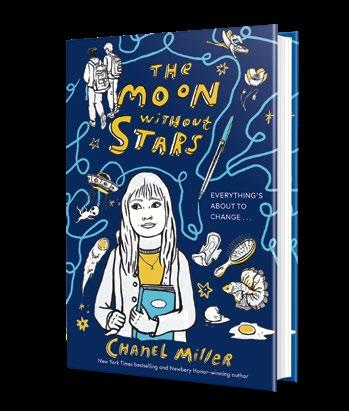
Miller, Chanel | Philomel | 256 pp. January 13, 2026 | $17.99 | 9780593624555
important parts of herself. Authentic and raw, this story is at once a timeless account of growing up and a tale that’s specific to this generation. Readers will empathize with Luna’s
sincere attempts to find herself and ache alongside her as she navigates her growing pains.
Genuine and poignant; has the makings of a modern classic. (Fiction. 10-14)
BAD SISTER
Alexander, Elaine M. | Illus. by Mike Orodán
Candlewick (32 pp.) | $18.99 April 14, 2026 | 9781536229684
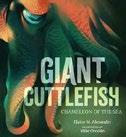
Take a plunge into the waters off southern Australia and come face to face with this spookylooking cephalopod. The giant cuttlefish, whose life stretches here from egg sac to reproduction and death, is depicted as both predator and potential prey, snapping up crabs but dodging voracious dolphins and seals. He encounters an even larger cuttlefish competitor but uses his color changing ability to lure a female of the species. After mating, he dies (these animals’ “livefastanddieyoung life cycle” has earned them the moniker “rock stars of the ocean”), but Alexander softpedals his demise: His legacy is the egg sacs that his mate lays. Size comparisons to familiar objects (a raisin, a watermelon, a football) help readers connect with the text. The starring mollusk is treated familiarly but not anthropomorphized. The final pages, featuring vocabulary suited to older readers, provide detailed information on the giant cuttlefish’s life cycle, adaptations, hunting and mating habits (especially the female’s role), and threats (particularly from humans). These sections divulge some stunning facts that go unmentioned in the narrative, including the giant cuttlefish’s three hearts, bluegreen blood, and colorblindness. Since the creature’s average length at maturity is just 20 inches, “giant” is relative, but our hero looms large in Orodán’s dramatic, boldly
colored digital illustrations, stretching across most pages. This cephalopod is hardly cuddly, but Alexander makes the most of its impressive intelligence and natural abilities to win us over. “Rock stars of the ocean” in all their brief but flashy glory. (bibliography, glossary) (Informational picture book. 6-9)
Alexander, K.R. | Scholastic (160 pp.) | $8.99 paper | January 6, 2026 | 9781546116516

In this followup to Identikill (2025), two girls stuck between life and death find themselves searching for answers. Although Chelsea’s twin sister, Angelica, died years ago, the two remained close. Angelica’s ghost was a constant presence until recently, when Chelsea made a new friend named Janette, and Angelica’s jealousy spilled over. Now that Angelica has taken possession of Chelsea’s body, Chelsea is the one trapped in the Underside, the dark, dank world where Angelica was relegated anytime Chelsea paid attention to other people. Chelsea isn’t alone, though; the twins’ former friend Riley is there with her, though the reasons for her presence are unclear. As Angelica wreaks havoc on Chelsea’s life, teaming up with bully Pia and trashing her friendship with Janette, Chelsea struggles to let Janette know what’s going on; meanwhile, Riley tries to identify the imposter living in her own body before things get worse. Told from both Angelica’s and Chelsea’s thirdperson perspectives, the novel contains
enough moving pieces for an engaging and suitably complex yet swiftly paced plot, with plenty of character development worked in. With explorations of friendship taking center stage, Alexander makes space for his protagonists to contend with ugly feelings like jealousy, bitterness, and rage. The story can be read as a stand alone (a quick recap of the previous book’s events will catch readers up), though familiarity with the earlier installment is recommended for full effect. Physical descriptions are minimal. A satisfying balance of compelling characterization and creepiness. (Horror. 8-12)
Anatol, Giselle | Illus. by Raissa Figueroa Viking (32 pp.) | $18.99 | January 13, 2026 9780593404898
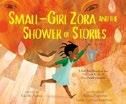
“My stories are gonna change the world,” young Zora Neale Hurston declares— and they do!
Small Girl Zora seems to invite trouble, climbing trees and sneaking out to play tag with the moon. She also tells wild stories, dismissed by some (“All a girl needs to know is how to change the sheets”), but to her Granny, they’re woven magic. That summer, the town is plagued by drought, and Small Girl Zora is determined to fill Mama’s old watering can with “tears of JOY and LAUGHTER” that she’s convinced her tall tales can elicit. Whether visiting Mr. Starks’ general store to boast about hens that lay eggs by the dozen or stopping by Mr. Tea Cake and Miss Janie’s sugar cane fields, where her tales “spill out higgledypiggledy,” Small Girl tenaciously showers willing (and not so willing) listeners with endless stories, inviting the rain that finally arrives. Anatol’s author’s note is an enlightening
delight, revealing parallels with the life and literature of the real Zora that she cleverly wove into this fictional account of the writer’s childhood. Figueroa, who illustrated Anatol’s Small-Girl Toni and the Quest for Gold (2023), enlivens Small Girl Zora’s enthusiasm in full color, effusive with details on every page. Mr. Starks’ store interior is particularly memorable, with signs for S&H Green Stamps and Buster Brown Bread. All characters are brown skinned, reflecting the actual Zora’s historically allBlack community of Eatonville, Florida.
A dynamically imagined, girl power–infused re-creation of an acclaimed author’s childhood. (Picture book. 5-10)
Baker, Laura | Illus. by Ramona Kaulitzki Little, Brown (40 pp.) | $18.99 February 17, 2026 | 9780316581172
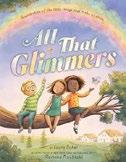
Small joys can instantly transform a bad mood. Set against a gray backdrop, a group of gloomy children in the park stare off into space disconsolately. Nothing seems to be going right; even the dog appears dejected. But Baker implores readers to “search with your eyes,” “keep your heart open too,” “and look for the glimmers / that shine their way through.” A small burst of color appears in the corner. Two dragonflies zip by—two bright spots of hope piercing the gray. Slowly, more color is introduced as each child observes something interesting in nature or something kind in the world. As the children recognize more “glimmers,” more and more of them appear. One can even share glimmers with a friend who needs a new perspective. “A rainbow brings awe. / A dog gives such joy. / A smile bursts out for a favorite toy.” Baker also recognizes that the flurry of glimmers might be overstimulating for some and advises
readers to start slowly. Key vocabulary is highlighted in a larger, vibrant font; light , gentle, safe , and understood are some of the words to hold dear. The gradual addition of color reflects the tale’s optimistic nature, while Baker’s rhymes soothe and sway. The cast is diverse.
A lovely reminder to look and listen. (Picture book. 3-6)
Barnett, Mac | Illus. by Carson Ellis Orchard/Scholastic (48 pp.) | $19.99
February 3, 2026 | 9781338673852
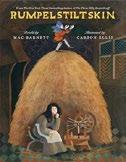
Two acclaimed creators retell a fairytale classic. Employing a conversational style, Barnett offers a fresh and immensely entertaining take on an old story, much as he did with The Three Billy Goats Gruff, illustrated by Jon Klassen (2022). A miller (“a nice enough guy, but he had a big mouth”) encounters the king and, seeking to impress him, falsely claims that his daughter can spin straw into gold. What follows is the classic story, replete with spinning wheels and small men who make clandestine deals with the desperate for their offspring. While never diverging from the original, Barnett nevertheless allows his miller’s daughter, if not a name (on purpose, it turns out), then hobbies like “whittling sticks and catching tadpoles with her bare hands.” This miller’s daughter is still caught in the machinations of the men around her, but Barnett demonstrates that her love of the woods is key to her defeating Rumpelstiltskin. His sly retelling is perfectly complemented by art that at times resembles classical portraiture. Ellis also harkens back to fairytale images of yore with both lushly illustrated gouache pictures and small
interstitial black andwhite spot art. Characters present white. Deeply familiar but infused with 21st-century smarts; expect cries for repeated reads. (Picture book. 4-7)
Bearce, Stephanie | Shadow Mountain (224 pp.) | $19.99 | February 3, 2026 9781639935017 | Series: A Raven Gallows Mystery, 2

Ciphers, family secrets, and scary rivals challenge a squad of smalltown sleuths on the track of hidden treasure in this sequel to The Secret of Moonrise Manor (2025). As the Ozarks town of Sassafras Springs gears up for its annual Outlaw Days, 12yearold Raven and the three other members of the Truth Trackers Detective Agency (“Who you gonna call? Truth Trackers! ”) follow a series of ciphered messages from the Civil War era that might lead to a legendary stash of Confederate gold. Unfortunately, mysterious others are on the same trail—and not above a bit of phone theft, lab trashing, or even assault to beat the young detectives to the glittery prize. Amid all the cluefinding and codebreaking, the author tucks in nods to Edgar Allan Poe in the form of her protagonist’s name, the mysterious Dupin Society, and other references as she trots in multiple suspects and red herrings, an evil corporation, a treasurehunting vlogger, a surprise villain, and whiffs of real danger at the climax. Even though Bearce sometimes seems to be working off a writer’s checklist, the sparky cast and tongueincheek rural vibe add plenty of life to a quickly paced caper in which the stakes are high, the level of violence is (relatively) low, and the close is awash in rich rewards and just deserts. Main characters read white, and one Truth Trackers member is cued Chinese American.
A sure-handed pleaser for young detectives. (Mystery. 8-12)
Bell, Jennifer | Illus. by David Wyatt
Candlewick (320 pp.) | $18.99
January 6, 2026 | 9781536241617
Series: Magicalia, 2
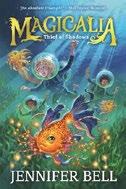
The stakes rise as three students, newly enrolled in magic school, face malign chaosconjurors who are scheming to start a war. No sooner do schoolmates Bitsy, Kosh, and Mateo come into possession of a rare heartseed, a mighty amplifier of magical abilities, than they find themselves fugitives. They’re hotly pursued by both the magical Alliance that wants it back (but may have a traitor in its midst) and the evil mastermind Riddlejax. In extracts from pages of Magicalia, Bitsy’s sentient encyclopedia guide to all things cosmodynamic, Bell lays out full descriptions of the six guilds of the Alliance and six classes of creatures dubbed magicores, which are conjured through the emotional power of strong memories. As in the series opener, this magical background is so elaborately imagined that it duels with the storyline for precedence. The story also features bad guys who usefully explain their plans in detail at times when Bitsy and her friends can overhear. Still, it’s hard not to like a tale in which intrepid younglings confront hazards ranging from a massive ticking bomb to a cannon that shoots spaghetti sauce. Adding to the delight, lubberwharls, jubs, and other magicores with looks as daffy as their monickers roam in large numbers and appear in Wyatt’s appealing spot illustrations. For all the ostensibly earnest tone of this fastpaced
romp, the author is plainly having a ball—and it’s catching. Bitsy reads white, Kosh is British Sri Lankan, and Mateo is brownskinned. A rollicking good time. (Fantasy. 8-12)
Bell, P.G. | Feiwel & Friends (320 pp.)
$17.99 | January 20, 2026 | 9781250864864

In a world where people and anthropomorphic wolves coexist, Ruby Calvino, a human girl, and Fillan, a wolf cub, are accused of murder.
“Small, wiry, and pale” Ruby is about to win her first Tooth & Claw championship (think Hunger Games lite) for her team, the Netherburg Reds, in front of thousands of spectators. The 12yearold, who’s brash and athletic, is facing her final opponent, the undefeated Alarick, a skilled and ruthless wolf. But just as she begins to make her move, Alarick drops dead. After a bottle of poison turns up in Ruby’s bag—and that same poison was present on flowers that Fillan (a member of the stadium staff) delivered to Alarick before the match—intransigent Detective Breck accuses them both of murder. The pair go on the run, hoping to save themselves and find the real killer, but no one is who they seem to be in this romp of a tale. Ruby’s athletic training and Fillan’s sense of smell help them out of tight spots. Bell weaves in tongueincheek references to “Little Red Riding Hood,” from characters’ names and garments to a little cottage in the woods. Wellplanted reveals keep the pace up, and the one scene that feels
A clutch of children salute the adults who make the school day hum.
THANK YOU, SCHOOL
dangerously close to an infodump suddenly twists into a final surprise. Ruby’s character growth is subtle and believable and comes to fruition at the end of the story.
A delightful, action-packed adventure. (content warning) (Fantasy. 10-14)
Benda, Gabbie | Holiday House (224 pp.) $24.99 | January 27, 2026 | 9780823457892
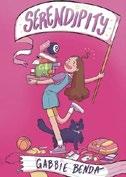
An instructive awakening for the overachieving crowd. Things have a way of working out for Serendipity, from winning radio callin contests to getting an extra ice cream cone at a carnival. She’s generous with her best friend, Basil, and suggests a “BE NICE” campaign to her class president election team; she’s not a jerk about her good fortune. But Serendipity’s happygolucky ways are reversed by a robotic fortunetelling machine that seemingly curses her with bad luck. Staring down roles in a basketball game, an election debate, and a stage play, all scheduled to take place on the same day, Serendipity turns to the occult to bail her out. Meanwhile, because she can’t stand disappointing others, her peoplepleasing response to anyone’s concerns is to insist that nothing’s wrong—in fact, “everything’s cool!” Serendipity’s somewhat extreme approach to life is headed for a collision with teamwork and responsibility. Benda’s debut brings the world of middle school to life with all its comedic highs and weighty lows. Her use of foreshortening effectively depicts overwhelming moments, while her dramatic employment of light and shadow enhances the fraught scenes between the best friends. The soft colors and rounded shapes make the illustrations visually appealing. Serendipity and Basil present white, and there’s ample racial diversity among their peers. A humorous story that will help tweens gain self-awareness and set healthy boundaries. (Graphic fiction. 8-12)
Bernstrom, Daniel | Illus. by Brandon James Scott | Hippo Park/Astra Books for Young Readers (40 pp.) | $18.99 | February 3, 2026
9781662641206

What happens when a bear hijacks a van filled with pastries?
The tale’s minimal text, made up of single words and extremely short phrases, nevertheless reveals an exciting, humorous storyline—a rare feat. As a friendly, cartoonish bear lazily awakens in a cave, two words appear, printed clearly over a dawning sky: “a bear.” The next page shows a dark skinned adult (“a man”) awakening in bed next to his lighter skinned partner. Above the bedstead, readers glimpse a portrait of the couple and six children; through the window, a pink and blue van. Outside the house, the man begins driving without noticing that the hungry bear has slipped into his van. Rhyming, rhythmic verse continues to repeat the initial nouns, while adding adjectives: “a happy man,” “a happy bear,” “a sticky happy donut bear.” Not until the driver checks his rearview mirror does he discover the unwelcome hitchhiker. The action escalates as both characters, now terrified, lose control: “a panicked man,” “a bear in van,” “a donut man without a plan.” The treats fly, the bear roars, the man prays as his van sways, and a herd of equally funnylooking, googly eyed moose appear. No matter how dire the situation appears, Bernstrom and Scott keep the tale light and hilarious right to the end. Cleverly rendered rhymes and repetition encourage pre readers to memorize the words and beginning readers to shine, while the art will tickle their funny bones. Short and utterly sweet. (Picture book. 3-6)
Bidania, V.T. | Nancy Paulsen Books (432 pp.) | $18.99 | January 13, 2026
9780593697207

Bidania distills her family’s experiences as refugees into resonant historical fiction.
It’s 1975, and Gao Sheng lives “in a sunny mountain town” in Pao Kao, Laos, in a house with plenty of room for her extended family: nine adults and 11 kids. Eleven year old Gao Sheng silently, obediently helps with cooking, shopping, and child care: “This is what’s expected / of the oldest daughter.” When the communists take over, her father’s army service alongside Americans puts the family at risk, forcing them to flee. The scattered clan members endure separation, survive two Thai refugee camps, and start new lives in America. Gao Sheng is an insightful witness, keenly aware of her 8 yearold brother’s elevated status just because he’s male, while she’s overlooked: “My arms drop to my sides, / limp and wilted.” Despite disappointments, she’s steadfast in fulfilling her mature responsibilities. But when she finally refuses to keep quiet—“Today / I will be loud / I will show my strength”—her family sees and eventually acknowledges and proudly appreciates her. An epilogue describes Gao Sheng’s arrival in Wisconsin with her parents and siblings. The candid verse deftly grounds precious experiences in tangible reminders— peach seeds that Gao Sheng saves to plant “someday, / when the country is at peace,” and soft buns that taste “like sugar and happiness.” With inviting vulnerability, Bidania transforms her wartorn past into a rallying cry to “build empathy, curiosity, and awareness.”
A lyrical, heartfelt account of personal growth and endurance. (author’s note, photos) (Verse historical fiction. 10-14)
Bloomfield, Jenny | Frances Lincoln (32 pp.) $18.99 | February 3, 2026 | 9781836008606
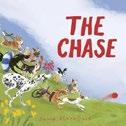
A game of fetch with one dog becomes a free for all as a pack of pooches eagerly follow a ball through a variety of locales.
The story starts off simply enough: just a brownskinned child and a pup on the beach. As the youngster tosses a red ball, several other dogs join in the chase. Quickly, the number of canines participating in the game grows. They race through a museum, ride a beam on a construction crane to the top of an apartment building, and nearly splash over a waterfall, all in pursuit of the elusive red ball. Eventually, they wind up right back where they began, with the child and the ball on the beach, ready for the game to start all over again. Bloomfield’s rhyming text mimics the bouncy hops of the chase: “It’s a hustle, a bustle, a running tussle.” Each page maintains a steady cadence that makes for an ideal readaloud. Featuring all manner of dog breeds (and one pup with wheels on its hind legs), the art brims with silly details that readers will enjoy spotting, like a museum caretaker trying to catch a falling vase, a dog splattered with pink paint, and a pup getting snagged in a tuba as the gang interrupts an outdoor musical performance. Perfectly playful. (Picture book. 2-4)
Borden, Louise | Illus. by Paige Keiser Holiday House (32 pp.) | $18.99 March 3, 2026 | 9780823455690
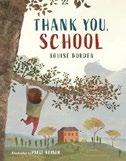
A clutch of children salute the adults who make the school day hum.
“Dylan and Madeleine—7:15 a.m. / THANK YOU / to our teachers… / who head to school / with
dreams for us / just as the sun / wakes up the day.” So begins a series of thankyous in verse addressed to custodians, crossing guards, librarians, and other grownups who ensure that children thrive during a typical day. Next up after Dylan and Madeleine is “Anders—7:54 a.m. / THANK YOU / to our bus drivers,” and on it goes until it’s 3:25 p.m., the end of the school day, when “All of us!” extend thanks to “each person / who makes our school / tick like a perfect clock!” Borden’s premise is so solid that it’s a pity readers may not initially grasp whether the names at the top of each thankyou correspond with the adults being honored or the children giving thanks. (A simple “from” or “by” before the kids’ names would have done the trick.) Regardless, it’s hard to imagine a reader who won’t get caught up in this giddymaking gratitudefest. Keiser’s digitally tweaked multimedia art depicts rosycheeked kids and adults who vary in terms of race and ethnicity. Her images appear to have been assembled with cutpaper or silkscreened shapes in color combos fresh enough to get the day off to a rollicking start. May well give readers the thank-you bug. (Picture book. 4-8)
Cao Wenxuan | Illus. by Suzy Lee Trans. by Helen Wang | Caitlyn Dlouhy/ Atheneum (48 pp.) | $19.99 February 3, 2026 | 9781665931199
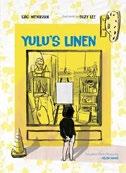
Originally published in South Korea and China, an enchanting portrait of a young artist from two Hans Christian Andersen Awardees.
Yulu’s father, remembering his own unfulfilled creative dreams, encourages his daughter Yulu’s efforts after noticing her love of drawing. By age 8, her skill surpasses his own, so he arranges for several famous artists to teach her. When Dad decides Yulu is ready to try a selfportrait, they visit an art store, where Yulu chooses “yu-lu-ma —raindew
linen,” for its similarity to her name. Yulu hesitates to start, but Dad reassures her: “It’s just a piece of canvas. Imagine how happy it will be when you pick up your brush and turn it into a work of art!” Her achievement is “wonderful!” yet the following morning, Yulu discovers “a disaster, as if the colors had run all over the canvas during the night.” She tries again—seven more times—but her portraits repeatedly become “a mess.” Dad reprimands the canvas, and Mom discards it, but Yulu rescues it…and starts her eighth attempt. South Korean illustrator Lee elevates Chinese author Cao’s celebration of talent and tenacity into artful delight, combining impeccable line drawings with reams of exquisite floral fabrics from Dad’s shop. She uses singlecolor washes—yellow, beige, blue, black—to augment her blackandwhite sketches, mimicking linenesque textures on the page. Yulu is darkhaired with light skin. Wang returns as Cao’s experienced translator. A visually moving reminder that artistic success means trying again and again. (Picture book. 5-8)
Carlson, Meta Herrick | Illus. by Ciara Anganuzzi | Beaming Books (40 pp.) | $18.99 February 17, 2026 | 9798889836490

A family keeps God’s promise of love and presence front of mind by retelling the stories of their children’s baptisms. Young people love hearing tales from their babyhoods and poring over pictures of themselves, and that’s where Carlson begins and ends her book, baptismal candles burning in each scene. But she goes deeper than her characters’ own baptisms, connecting those to the larger world church (and baptisms from around the world) as well as to biblical stories involving water. Carlson makes water an obvious but joyous theme: It brings joy and life, and its everyday nature means it can be a constant reminder of God’s love, grace, and mercy. While very
young children may not completely grasp the text—“God’s promise adores the truest you, / and the you who’s still becoming”—love and community come through loud and clear, and given that families may want to return to this book year in and year out, kids can grow into the promises laid out in the text. Anganuzzi’s bright colors give life to scenes depicting biblical stories, people enjoying water, and neighbors working in a community garden. The characters are diverse, and the family at the center features a lightskinned parent, a bearded and darkskinned one, and two children with skin tones in between. Backmatter includes a note for caregivers and places to insert a child’s baptismal photo and to write in personal details and blessings. Will provide a spark for new family traditions in celebration of baptism. (Picture book. 3-9)
Cervantes, J.C. | Illus. by Paula Zorite Storytide/HarperCollins (352 pp.)
$19.99 | January 27, 2026 | 9780063312135
Series: The Daggers of Ire, 2
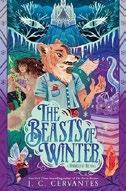
Fetch, a cursed fox, sets out to rescue his sister from the winter palace in this companion to The Daggers of Ire (2024).
Haunted by guilt, Fetch has long dreamed of saving his sister, Violet, who was stolen by the winter queen, Celeste, five years ago. He finally sets out on his quest. At his side is Beck, the dragon who’s “half bone, half dream,” spun by Fetch from magical spools of thread. They journey through forests, a town populated by giants, and woods guarded by massive, poisonous worms. Along the way, Fetch gains allies in paleskinned, blackhaired Hawthorn, a brave girl with green eyes whose loyalty never wavers, and Garzo, a “dramatic, selfabsorbed” fairy whose help arrives at just the right times. Each step brings Fetch closer to the winter palace, his
sister, and a dangerous secret. To succeed, he must master his Zindero abilities, weaving powers like invisibility and strength to outwit foes and evade traps before time runs out and he loses his sister (and his magic) forever. Cervantes balances action with emotional depth, exploring themes of friendship and selfdiscovery. Subtle hints of a darker, internal threat echo events from the first book, adding tension. The worldbuilding is vivid and immersive, and the narrative combines suspense, humor, and heart to create a story that will be accessible to new readers while rewarding fans of the series. Final art not seen.
A magical, high-stakes adventure of courage, friendship, and self-forgiveness. (Fantasy. 8-12)
pp.) $18.99 | February 10, 2026 | 9780374392253

This retelling of “The Princess and the Pea” draws from history to imagine a new story about a real monarch from 18th century Korea, in the midst of the country’s centurieslong Joseon period. The crown prince’s mother, the queen, will select his bride, and she arranges for her son’s potential wives to undergo three challenges. Young Jeongsoon is a bit awkward and clumsy, but she’s long dreamed of being a princess—and bringing aid to the hungry children of her village. When she’s invited to compete, she’s thrilled. She falters during the Manners Test but advances to the Wisdom Test. Her sincere response pleases the queen, and Jeongsoon alone is selected for the final challenge, the Sleep Test. Here, Cho replaces the familiar pea with a single grain of rice and adds a sweet little mouse to further complicate matters. Jang’s vibrant digital art depicts lush palace grounds, richly colored hanboks, and a royal wedding
A moving reminder that artistic success means trying again and again.
YULU’S LINEN
befitting a princess, all while firmly anchoring the story in Korean history. Young readers will delight in seeing Jeongsoon prevail; her triumph will feel especially poignant for those who share her cultural background. While Cho doesn’t interrogate the concept of arranged marriages or the age gap between the reallife Queen Jeongsoon and King Yeongjo (she was a young teen, while he was 64), she does emphasize that it is Jeongsoon’s inner beauty, warmth, and wisdom that make her fit to be a monarch.
A solid entry in the princess genre, elevated by its representation of Korean culture. (author’s note, information on the true story, photographs of the author and her family visiting Queen Jeongsoon’s burial site) (Picture book. 4-8)
Coltellacci, Lorenzo | Illus. by Lorenzo Sangiò | Kids Can (32 pp.) | $21.99 October 7, 2025 | 9781525314032
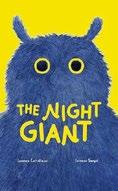
In this French import, a benign blue behemoth traipses through a sleeping town.
The Night Giant emerges only when everyone is asleep. But the mischief he makes is noticeable by day: He switches the roofs of houses, straps cars to his feet to go rollerskating, and piles up park benches. This placidly playful picture book offers simple, matteroffact depictions of these spectacular feats, pausing at points to imagine where the Giant might go during the day. Aside from one brightly lit scene where he lounges in a firefilled
room (does he live at the Earth’s center?), the spots where he rests are, like the rest of the book, coolly lit, whether he’s floating like a feather in the sky or camouflaging himself in the curves of a faraway mountain. As morning arrives, the Giant departs calmly, hand in hand with an even taller guardian. Trusting in its own dreamlike logic, Coltellacci’s text is satisfyingly sparse, allowing restful readers space to reflect. Visually, the nighttime blues that define the tale’s aesthetic deftly integrate golden glowing windows, shimmering silvery water, and the brilliant bright white of a full moon. With his wide eyes, hornlike ears, fuzzy face, and rotund body, the Night Giant evokes the playfulness of Hayao Miyazaki’s Totoro, but his curious, piercing gaze recalls Joanna C. and Paul Galdone’s Tailypo, a far eerier nocturnal menace.
A simple story that spotlights a playful monster and celebrates the comforting contours of the world at night. (Picture book. 4-8)
Craigie, Gregor | Illus. by Bithi Sutradhar Orca (48 pp.) | $19.95 | February 17, 2026 9781459840416

General guidelines for distinguishing fake news from the more realitybased sort. Without overburdening his middlegrade audience with emphatic warnings or frightening scenarios, Craigie presents a set of commonsense approaches to take toward questionable claims or
reports—specifically those found online. After distinguishing between simple “misinformation” and more intentional “disinformation,” he lays out 10 ways that wary readers can tell the two apart, from investigating the author of the item and the host and history of the website where it appears to doublechecking its date (to make sure it’s not April 1, if nothing else). Some of Craigie’s suggestions, such as reading a problematic story or entry all the way to the end rather than just going by its headline, aren’t commonly found in similar guides. Better yet, he expands his scope beyond practical techniques by, for instance, cautioning against falling into an informational “silo” that would limit exposure to different ideas and explaining why it’s so much healthier, intellectually speaking, to be a skeptic than a cynic. Though his book is light on specific examples of fake news, he does include a few examples, mostly for their entertainment value (“POPE ENDORSES TRUMP”). Sutradhar likewise livens up interspersed glimpses of racially diverse young information consumers with images of a caped superlibrarian and monkeys swarming up a skyscraper. Savvy, low-key, and lit occasionally by glints of humor. (resource lists, index) (Nonfiction. 10-13)
Kirkus Star
Crimi, Carolyn | Illus. by Shamar KnightJustice | Candlewick (32 pp.) | $18.99 February 3, 2026 | 9781536227307

A young boy notices everything—including the opportunity to make a new friend. Observant and gentle, Jayden is unhappy about his family’s upcoming move. He’ll miss his favorite oak tree, and he’s worried about making friends. Luckily, he can pack his jar of special rocks. In Crimi’s delightful characterization, Jayden isn’t so much a budding geologist as a blooming one, and his jar is nearly filled with “a homework rock,
a thinking rock, a fortbuilding rock. But his favorites [are] his wishing rocks,” representing past wishes he’s made for “snow days, perfect pumpkins, and chocolate cake for dessert.” As Jayden frets about the move, his worries outmatch his wishes…until they don’t. While walking in his new neighborhood, he notices “a small brown rock with a river of sparkle running down its middle.” KnightJustice’s accompanying softly contoured illustration beautifully depicts the wonder of this new rock. Jayden holds it and makes a wish, powerfully unstated in the text, but represented by a ribbon of calm blueness emanating forth in a hopeful upward trajectory. Readers will connect the dots when Jayden encounters another child, “a noticer like him.” The two hit it off, and as it turns out, Alex likes bugs as much as Jayden likes rocks. Jayden presents Black; Alex is tanskinned. You’re on notice: This picture book is a gem! (Picture book. 3-6)
Currie, Lindsay | Delacorte (304 pp.) $17.99 | January 6, 2026 | 9780593811672
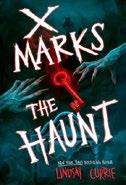
A 12yearold Chicago boy finds peace in a cemetery— until something terrifying is unleashed. Will often works alongside his mother at the Graceland Cemetery, where she’s the executive director, digging into records and tracing genealogical leads. His father was killed in a car crash two years ago, and he feels satisfied when he can help a family find a longlost ancestor. His best friend, Stash, understands Will’s dedication, but Will doesn’t talk about the cemetery at school, where he doesn’t want to be seen as different and targeted by school bully Chris. But a class field trip to the cemetery means his secret is out. To Will’s surprise, his classmates Henry and Michelle are interested in the cemetery’s history. Not Chris. Instead, he pressures Will to get him the key to
a mausoleum so he can livestream from the cemetery after hours. But when Chris loses the key, a ghost latches on to Will. Will, Stash, Henry, and Michelle use humor to keep their terror at bay as they combine their varied skills to figure out who the ghost is and what she wants. The descriptions of the ghost are hairraising, and the research into her life and death reveals an unexpectedly poignant, historically accurate story. Will and his friends, who are cued white, are portrayed with great emotional depth. There’s even hope for Chris, who initially seems to be a onedimensional bully but by the end seems to correct his behavior. Horror with heart. (map, author’s note) (Horror. 8-12)
Kirkus Star
Day, Nicholas | Illus. by Hadley Hooper Neal Porter/Holiday House (32 pp.) $18.99 | January 13, 2026 | 9780823458509
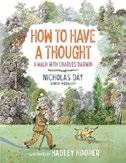
Sibert Medalist Day transforms Charles Darwin’s daily walking routine into an enchanting blueprint for creative thinking. The book opens with a delightfully unconventional instruction manual: “First you need a rock.” What follows is an intimate portrait of Darwin’s “Sandwalk”—the path he traversed as he pondered deep thoughts. Stacking rocks before he began, he knocked one down with each completed loop; simple conflicts were “onerock problems,” while tougher ones were “tworocks, threerocks, even fourrocks.” Day’s conversational prose weaves seamlessly among Darwin’s voyage on the Beagle, his groundbreaking observations of finches and giant sloths, and his methodical approach to wrestling with the radical concept of natural selection. Never condescending, the text instead invites readers to see themselves as fellow thinkers capable of their own discoveries. Hooper’s
ORRIS AND TIMBLE
mixedmedia illustrations are nothing short of spectacular, combining vintage engravings, photographs of actual rocks and specimens, painted landscapes, and printmaking techniques, all resulting in richly textured pages. Real scientific illustrations of Darwin’s finches appear alongside a whimsical globe, while the recurring motif of blue walking paths, both literal and figurative, connects all elements. The book succeeds on multiple levels: as an accessible introduction to evolution, a meditation on the creative process, and gentle encouragement for readers to embrace their own thinking paths. Substantive author’s notes provide historical context without overwhelming younger children.
A masterful blend of biography, science, and philosophy that makes profound ideas feel wonderfully attainable. (bibliography) (Informational picture book. 5-9)
and the Beanstalk
Dean, James & Kimberly Dean | Illus. by James Dean | Harper/HarperCollins (32 pp.) | $5.99 paper | February 10, 2026 9780063350519 | Series: My First I Can Read

Who says giants are scary?
In this clever riff on “Jack and the Beanstalk,” Pete the Kitty doesn’t trade in a cow, but he does buy magic beans for his friend Callie’s birthday. She’s confused at first, but then they plant the beans, and, as in the source tale, a “super big” beanstalk grows overnight. The two curious
kittens channel Jack and climb the beanstalk into a world above the clouds. There, they find “a magic playground,” and the text begins to indulge in some early reader–friendly repetition, since “everything is super big.” The friends see huge flowers and toys; then they hear a giant’s loud voice. While the cartoonstyle illustrations show Pete and Callie wideeyed and shaking with fear, it quickly becomes apparent that they needn’t worry: The giant, named Cindy, is friendly, and she concludes her cry of “Fee! Fi! Fo! Fum!” not by scenting blood, but by proclaiming, “I just want to play my drums!” Cindy explains that her mother doesn’t appreciate her drumming, and then Pete invites her to climb down the beanstalk with Callie and him to play in the band at the birthday party. With an ending befitting a fairy tale, the narrative concludes, “Friends are the best gift of all” as Cindy cradles the kitties in her giant arms. An enjoyable book to help new readers reach new heights. (Early reader. 5-7)
Kirkus Star
DiCamillo, Kate | Illus. by Carmen Mok Candlewick (80 pp.) | $16.99 | April 7, 2026 9781536227581 | Series: Orris and Timble
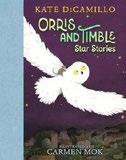
driven by the words emblazoned on a treasured sardine tin (“Make the Good and Noble Choice!!”), Orris risked his life to free the predatory Timble from a trap. Now as the two sit companionably on the barn roof, Timble generously offers to carry Orris out to see the world’s wonders with his own eyes. “Absolutely not,” Orris responds. “No. Never.” Orris’ resolution falters, though, as Timble gently persists, reminding his friend of the fable he himself had told about how a lion and a mouse learned to trust each other.
One night Orris dreams of flying on golden wings, and the sardine etched on the tin seems to say, “Listen, rat. If I had a chance to fly, I would fly.”
The next night Timble flies away with a small passenger clinging to his back. DiCamillo’s tale is spare of language but rich in understated feeling. Expertly reflecting the story’s emotional undercurrents with tender attention to subtleties of posture and expression, Mok depicts the pair mostly beneath twilit or starry skies— Orris a picture of hunched reluctance, Timble with his eyes comically rolled up, quietly waiting for his diminutive friend to come around.
Tender and authentic—a worthy conclusion to a wondrous series. (Early chapter book. 7-9)
Dockrill, Laura | Illus. by Eva Byrne Candlewick (40 pp.) | $18.99 April 21, 2026 | 9781536245103
Unlikely companions wing their way into readers’ hearts—and also the sky—in this trilogy closer.
Orris, a bookish, reclusive rat, and Timble, a large young owl, have come a long way since the first installment in the series;
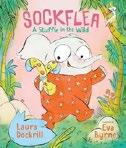
Parental ingenuity saves the day once more. The young elephant who narrates this story is thrilled: “We are going camping. I’ve never been before. I. CAN’T. WAIT.”
The little pachyderm’s parent suggests bringing a stuffed toy along, but our hero is a worldly 5yearold who doesn’t need a comfort object! The caregiver
The actor collaborated with graffiti artist John “Crash” Matos on Kiki and the Can.
Actor and comedian
John Leguizamo is making his children’s literature debut with a
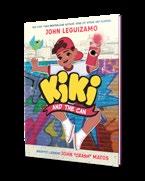
book coming in 2026, People magazine reports.
Orchard Books will publish Kiki and the Can: Paint His World, illustrated by John “Crash” Matos and Liz Casal, next summer. The press says that Leguizamo “shows us the power of imagination in this exploration of a kid’s creativity with his can of spray paint and graffiti.”
Leguizamo is known for his work in films including Carlito’s Way and To Wong Foo, Thanks for Everything!
Julie Newmar. He has been nominated for four Tony Awards for his stagework. He published a memoir, Pimps, Hos, Playa Hatas, and All the Rest of My Hollywood Friends: My Life, in 2006.
Matos is a celebrated graffiti artist who has designed guitars for Eric Clapton and Ed Sheeran; Casal is the author and illustrator of the children’s book Baller Ina Kiki and the Can will follow a young boy who paints murals in his city after finding a can of spray paint.

“Kiki’s story is about the pride everyone can have for their cultural roots, and how, when you don’t see yourself on the pages of books, your very own creativity can shine a colorful spotlight on what’s been left out,” Leguizamo told People
Kiki and the Can is slated for publication on August 4, 2026.
—M.S.




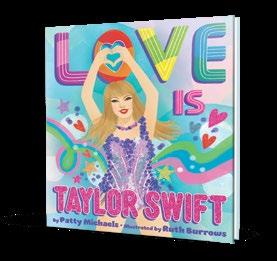
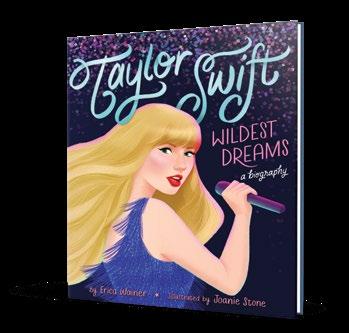


repeatedly asks if this is a wise choice, but the youngster blows off any concerns. At first, all goes well, and camping is a wonderful adventure, but that night things take a turn. It’s dark, the sleeping bag is sweaty, the ground is hard, and the little one cracks. The young elephant’s “WHY DIDN’T YOU MAKE ME BRING MY STUFFIES?” will feel uncomfortably familiar to many adult readers. Desperate, the grownup presents a pair of partially balledup socks and dubs the creation “Sockflea.” Initially skeptical, the youngster falls hard for the makeshift stuffie’s charms, and the trip is a rousing success. The book even sticks the landing with an ending in which the young one realizes with horror that the adult is now casually wearing Sockflea around the house. Droll humor abounds in Dockrill’s narration, which perfectly captures a youngster’s mentality, pairing beautifully with Byrne’s thoroughly enticing digital art. Meanwhile, emotions roll off both the little elephant and the putupon (and fairly anxious) grownup, with even Sockflea sporting a delightfully benign smile.
Friends are literally what you make of them in this highly amusing jaunt into the unknown. (Picture book. 3-6)
Dominguez, Angela | Roaring Brook Press (160 pp.) | $19.99 | $12.99 paper December 2, 2025 | 9781250901385 9781250901392 paper | Series: Gabby Torres, 2
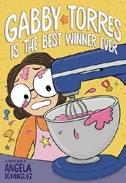
Fourth grader
Gabby Torres sets her sights on getting crowned the best at something— anything. Having learned valuable lessons about honest communication in the series’ first installment, Gabby’s matured (“Wise beyond my years, they say”), and she’s eager for more personal growth. When her best friends, Kat and Priya, are recognized for their athletic and writing talents, respectively, Gabby becomes
determined to prove herself by winning something. She tries out other people’s interests before deciding to stick with her own favorite hobby, baking. The grocery store is hosting a baking contest, and taking home the $1,000 prize could help her student environmental club, the Sea Musketeers, raise funds to save river otter habitats. But obstacles arise early on, from finding the perfect recipe to budgeting. Once more Gabby emerges as an authentically flawed protagonist; she demonstrates a realistic lack of selfawareness as she often puts herself first despite unwavering support from friends and family. Supporting characters, although important to plot progression, feel ancillary compared with the first book. A mix of prose and comics, this sequel makes use of ample white space and bright colors, keeping the story fresh and upbeat despite Gabby’s setbacks. Gabby and her father are Mexican American; her mother and Kat present white, and the previous book established that Priya is of Indian heritage. A sweetly relatable tale of a youngster doing her best as she continues to find her footing. (Graphic fiction/hybrid. 8-12)
Kirkus Star
Douglas, Kati & Ashley Jefferson Abrams Appleseed (24 pp.) | $9.99 December 2, 2025 | 9781419780141

Love makes the world go round, but it can be a complex concept to explain to a toddler.
Thankfully, Douglas and Jefferson tackle the topic with aplomb, providing soontobe readers with simple text and images and caregivers with a superb tool to spark conversation. Pairing brief sentences with eyecatching photos, the authors emphasize that love is a multifaceted thing: “Sometimes love feels happy. Sometimes it brings a tear.” “Love can be soft and gentle or hard when we need space.” The accompanying visuals clarify
the points made in ways little ones will readily understand (a caregiver cradles a baby; a child in need of space holds out a hand). Douglas and Jefferson demonstrate ways to express their love: “Sometimes love is helpful” (a youngster helps a parent wash dishes). “Love is listening even when there’s nothing to say” (a child comforts a crying baby; two people hug). A diverse cast is depicted. Several couples read as samesex; a family in a courtroom celebrates their adoption being made official. The relationships between the people portrayed aren’t made explicitly clear by the text, offering a wide variety of readers the opportunity to see themselves here. To aid in starting dialogue, the last pages of the book feature discussion questions for youngsters ranging in age from babies and toddlers up to age 6, along with a note for grownups. We love it! Happy families are wildly different in this joyfully inclusive series of lavishly photographed portraits. (Board book. 1-4)
Draw, Peter | Philomel (32 pp.) | $18.99 January 6, 2026 | 9780593694527

The protagonists of Ai & Aiko and the Little Curve (2025) return for a winter adventure. Ai, an enthusiastic little boy with paperwhite skin and a mop of cloudlike hair, and his shiba inu, Aiko, are excited to play outside in the snow with their friend Kei and her bunny, Kotton. As Grandpa, proprietor of the Tofu Café, watches fondly, Ai rushes out into the cold without a jacket—and then just as quickly heads back inside. The older man embraces the boy—after all, he points out, “Everyone needs a hug sometimes.” While Ai and Kei build a snowman, Aiko discovers a giant blue dinosaur in the ice. Afraid, the four friends hide, but when they peer out from behind a tree, they notice the dinosaur shivering. The behemoth must be cold—and perhaps even a little sad— so they lead it to the Tofu Café. Letting out a loud “grrrrr,” the dinosaur startles
everyone. Ai, Aiko, and their friends try various methods to warm up the dino, like offering him mittens and hot chocolate, but it’s Grandpa’s words that do the trick, and a tender hug puts everything right. Relying on his nowfamiliar kawaii illustrations, Draw uses color and lines to convey warmth, emotion, and movement. Populating his world with chipper, rounded, mostly lightskinned characters, he’s crafted another charming story filled with important lessons: Don’t judge others by appearances, and love and friendship will always save the day. A monstrously sweet tale of kindness. (Picture book. 4-8)
$19.99 | January 27, 2026 | 9780063334021
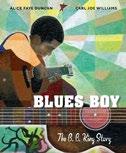
Before being crowned King of the Blues, B.B. King (19252015) was a Mississippi Delta boy named Riley with a guitar and a dream.
Born in the segregated South, Riley B. King is devastated when his beloved mother dies, but she leaves the 9year old with words of wisdom that he carries throughout his life: “When you do good and treat folks right, good things will come to you.” He finds solace in the guitar music played at his grandmother’s church, but his patchedup overalls and stuttering speech are bitter fuel for schoolyard bullies. Riley’s aunt introduces him
to the blues, and the melancholy music “rock[s] Riley in the arms of bliss.” When his grandmother dies, he hitches a ride to Memphis, Tennessee, where he slowly makes a name for himself, performing under the moniker Blues Boy. He buys the electric guitar that he famously dubs Lucille; his first hit record in 1951—released under the name B.B. King—launches him into blues stardom. Williams’ oil and acrylic collage illustrations layer emotive portraits atop abstract shapes, intricate landscapes, and found paper like sheet music and newsprint. The stunning imagery evokes stained glass or panels of a divinely glowing triptych. Emphasizing King’s desire to put good into the world—to “[plant] seeds of joyous sounds”—Duncan’s expressive prose echoes the lyrics of a powerful blues song, ensuring its pages will be read (or sung) aloud on repeat. A moving melody of striking visuals and soulful words. (more about King, timeline, places to visit, discover the music, suggested reading, bibliography) (Picture-book biography. 7-9)
Elcomb, Ben | Illus. by Terri Po Flying Eye Books (48 pp.) | $17.99 January 6, 2026 | 9781838749163
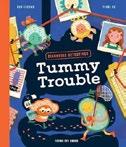
Invaders and protectors face off in the human digestive system. Paleskinned, redhaired young Sophia’s down for the count with a stomachache. Elcomb and Po offer readers an upclose look at the causes of—and solution to—her ailment. First,
Sure to inspire future physicians—and reassure young hypochondriacs.
the members of the Diagnosis Detectives Agency are introduced: anthropomorphized Tcells, B cells, monocytes, and neutrophils, the white cells that make up the body’s immune system. Next, we meet the bacterial and viral opposition, led by evil Queen Tox, a menacing blue creature clad in a red crown and dress. All are nicknamed and profiled, but depicted realistically when it comes to unpacking their effects on the body. Most chapters detail the various causes of digestive distress, among them norovirus, food intolerance, and food poisoning, as well as symptoms such as diarrhea, fever, and vomiting. The book concludes by identifying the culprit in this case and describing Sophia’s recovery. Relying on the conventions of detective procedure makes for a satisfying plot frame as suspects are listed (with accompanying “mug shots”) and the outbreak solved. Po’s artwork combines imagination with accuracy; the central players are portrayed both as they appear under a microscope and in their blobby, cartoonish forms. Insets allow readers to pinpoint the location of the actions, while larger images depict closeups of the adversaries going at it. Ageappropriate art and science projects are interspersed, along with an “I spy” page.
A STEAM winner, sure to inspire future physicians—and reassure young hypochondriacs. (glossary) (Informational picture book. 6-9)
Farris, Grace | Bloomsbury (32 pp.) $18.99 | January 6, 2026 | 9781547617913

Caregivers reassure children that they are loved unconditionally. When her tot seeks comfort after a bad dream, a tired mother responds that she loves her little one “more than a million very early mornings.” Subsequent pages explore different adult/child pairs as they deal with common experiences—some sweet, some irritating, some funny (and often several emotions at once). Made
up of rhyming couplets, Farris’ text is comprised entirely of the adult’s refrain: “Love you more than…” The simplicity of the language and structure creates an emotionally evocative contrast to the complexity of raising children. Grownups will chuckle along with familiar frustrations like spilled blueberries, falsealarm potty trips, and laundry mishaps; wince at broken bones; melt over gently loving scenes of coloring and bathtime; and feel the pang of bittersweet moments like school dropoff. Children, however, likely won’t experience these emotional layers in the same way. Some statements may not make much sense from their perspective, and sensitive youngsters may even feel they’re being teased. Still, most little ones will simply enjoy the repeated reminder that their grownups love them. The illustrations depict a wide variety of caregiving relationships: parents who appear without a partner, dual parents, older adults (perhaps grandparents), teachers, and doctors. Characters vary in skin tone.
A humorous book that adults won’t mind reading more than a million times. (Picture book. 3-7)
Fier Jasinski, Jen | Illus. by Lea Marie Ravotti Gnome Road Publishing (32 pp.) | $19.95 September 23, 2025 | 9781957655550

A timid child slowly joins in the fun as a group of kids begin drawing on the sidewalk. Someone brings a bright yellow bucket filled with multicolored chalk to the neighborhood hangout spot. Everyone is jumping rope, riding bikes, or roller skating, but the unmistakable “PLINK. / PLUNK” of the chalk jangling piece by piece catches their attention. With a “CLATTER” and a “CLUNK,” the bucket is dumped out, tiny vibrant pieces cascading down like a bowlful of jelly beans. Everyone runs to grab a handful. The narrative is told mostly in kidfriendly, onomatopoeic language, with only a few words on each page; readers must look closely
at the art to see the real story emerge: A paleskinned tot with a red ponytail is hiding behind a skateboard, hesitant to join in. Once the youngster summons the courage to join the group, the skies open up and rain pours down (“SPLISH! / SPLASH! / SPLOOSH!”). Everyone runs inside as their masterpieces smudge and smear away. The next day, the shy youngster leads the charge in directing the games, making sure to welcome another uncertain little one glancing over from the sidelines. The fullcircle ending feels tacked on, but the themes of collaborative drawing, inclusivity, and the impermanence of art are all possibilities for readers to explore more deeply. The neighborhood kids are diverse. Thought-provoking, colorful, and awash with playful sounds. (Picture book. 3-6)
Fisher, Carolyn | Kids Can (48 pp.) | $19.99 September 2, 2025 | 9781525312946
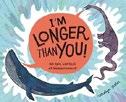
With a free lunch on the line, Supersaurus and Blue Whale submit to being measured by Inchworm to see who’s longer.
Unsurprisingly, complications ensue. No sooner does Inchworm finish laboriously spanning Supersaurus than the time comes for the invertebrate to go off and change into a moth. Centipede arrives to measure Blue Whale, but the newcomer delivers a result in metric units rather than Inchworm’s customary ones. So how to tell who’s the longer monster? Enter Dragonfly, standing in for the author to propose a solution: “You can change inches to centimeters WITH MATH!” Going for maximum volume in both the dialogue and the exuberantly drawn art, Fisher concocts a rollicking lesson in using units of measure. Having led the clueless leviathans through the simple calculations to reconcile the results (cleverly beginning with figures that allow the answer to come out in whole numbers), Fisher leaves the giants
behind to squabble over whether their pizza should be topped with ferns or krill. The author goes on to introduce each member of the cast by name—and, of course, length—and to expand on the metric and customary systems while introducing some outliers like the “zeptosecond” and “barleycorn.”
Fun beyond measure.
(Informational picture book. 6-8)
Flake, Sharon G. | Knopf (368 pp.) | $17.99 January 13, 2026 | 9780593650349
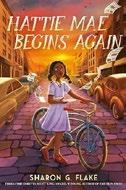
In 1938, a girl from North Carolina struggles to fit in at her new Philadelphia boarding school. Twelveyearold Hattie Mae Jenkins, whom readers first met in Once in a Blue Moon (2023), has just entered Miss Abigail’s School for Exceptional Young Ladies. Miss Abigail is Ma’s cousin, but Hattie is supposed to keep their relationship secret to avoid any appearance of favoritism. Many of the other girls are from elite African American families, and some decide that country girls like her don’t belong there. Fortunately, Hattie has a welcoming roommate, and she makes a new friend in Alabaster, a neighborhood boy who reminds her of home. Despite feeling intimidated, the spirited Hattie studies hard and avoids sharing her problems—but issues escalate between her and wealthy, entitled classmate Lisa, who “gets away with murder.” Hattie finds herself embroiled in a conflict that she dare not share with Cousin Abigail until it’s too late. As the school’s very existence becomes threatened, Hattie’s resilience and resourcefulness save the day and even expand Miss Abigail’s vision. Flake’s extensive research wonderfully captures the experience of African Americans in Philadelphia during the era of the Great Migration. She doesn’t shy away from portraying tensions within the community between newcomers and those with
deep local roots. The lively writing and strong character development enhance the story and provide readers with ageappropriate insights. A compelling coming-of-age story enriched by its historical texture. (author’s note, sources) (Verse historical fiction. 8-12)
Fletcher, Tom | Random House (40 pp.)
$12.99 | February 10, 2026 | 9798217119417
Series: Who’s in Your Book?
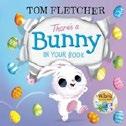
The latest in this uberpopular interactive series asks readers to help keep carrots out of the paws of a ravenous rabbit. A rather annoying bunny has been chewing its way through this story; indeed, readers will notice bite marks on the pages. In order to satisfy Bunny’s hunger—and, presumably, save the book’s pages—readers are encouraged to find something for the voracious rabbit to eat. Look…a vegetable patch! But it belongs to bluefurred, pinkhorned Monster, who’s put up a sign barring rabbits. No snacks there for Bunny. Monster needs help planting carrot seeds, watering and tending them, and even protecting the veggies from the rambunctious rabbit, who bounces back into the book at the most inconvenient moments. The unseen narrator urges youngsters to spin the book around in order to turn on a watering hose, clap their hands to scare off Bunny, tap the pages to harvest the carrots, and create a protective fence with their fingers. Eventually, Monster has a change of heart and gives Bunny a carrot, causing a transformation. As it turns out, this isn’t just any bunny; it’s one who delivers Easter eggs. This holidaythemed story follows a similar pattern to Fletcher’s previous books; readers will be entertained as they follow the unseen directions across the colorful pages to a charming conclusion.
A delectable Easter-themed treat. (Picture book. 2-5)
French, Vivian | Illus. by Anna Simeone Candlewick (32 pp.) | $18.99 | January 20, 2026 9781536250114 | Series: First Skills
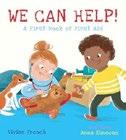
Two pals stage emergencies with their toys as they learn the ins and outs of first aid. Oh no! Nikki’s toy dinosaur has bumped its head. Luckily, Enzo’s mother is a doctor— surely she’ll be able to help? “I’m not sure I know about dinosaurs!” Mom replies. “But when you bumped your head, I wrapped ice in a cloth and held it to the bump.” Text in a smaller font offers further tips for dealing with bumps to the head, including consulting a doctor as needed. The pattern continues as the toy train driver cuts his leg (“Why don’t we leave it to heal on its own?” suggests Mom), then sustains a nosebleed, prompting Enzo to recall a nosebleed of his own (“I had to pinch my nose and lean forward”). As the conversation evolves, the characters discuss allergies, general malaise, water safety, and when to call 911. The kids continue to role play, and throughout, French reminds children that, whatever the emergency, a crucial part of first aid is finding an adult to help. Simeone’s simple, playful, bright art complements the lively dialogue and clear explanations. Enzo and his mother are brown skinned; Nikki is pale skinned.
An entertaining and educational introduction to health and medicine. (supply list for first-aid kits) (Picture book. 3-5)
Furneaux, Ky | Applesauce Press (224 pp.) | $16.99 paper
December 16, 2025 | 9781400347162

When the wild calls, this outdoor survival guide makes sure young adventurers are ready to answer. Australian stuntperson, survival expert, and TV personality Furneaux draws on her own bushcraft experience to offer an engaging guide to survival in the outdoors that’s at once comprehensive and compulsively readable. Organized into manageable sections, the book covers core outdoor survival principles, including shelter, water, and fire. Each section presents a historical example to learn from, explains the topic’s importance (with scientific context), provides detailed yet approachable instructions, shares helpful tips and tricks, and offers handson activities so readers can safely practice their skills. The final chapter is a lengthy quiz that allows budding outdoorspeople to further cement their knowledge. From showing how to tie knots to catching and preparing small animals to eat, demonstrative photos and detailed line drawings help readers effectively visualize techniques. The text debunks common bushcraft myths while offering fun facts (you actually can eat most slugs and snails—but avoid the brightly colored ones!); at the same time, Furneaux doesn’t shy away from the serious nature of the topic and the dangers inherent to wilderness excursions. While she encourages adult supervision throughout
A compelling coming-of-age story enriched by its historical texture.
HATTIE MAE BEGINS AGAIN
the book, some of the practice activities— like starting a fire using a battery and steel wool—feel unsafe for the intended audience. The outdoorspeople who appear in photos appear white. Kids—and their grown-ups—will want to pack this book in their go bags. (image credits) (Nonfiction. 9-12)
Fyvie, Erica | Illus. by Scot Ritchie Kids Can (56 pp.) | $17.99 September 2, 2025 | 9781525306686

L etters to the future left by a class in 1900 prompt sixth graders in 2025 to consider what their school might be like a century from now. Drawn from a time capsule unearthed during building renovations, the letters celebrate innovations at the thennew school including indoor plumbing and large windows, marvel at such exciting recent inventions as automobiles and electric lights, and wonder whether the future will bring cures for all diseases. Meanwhile, the modern students discuss upcoming renovations, such as replacing the drafty old windows with weathertight ones and adding both a rainwater collection system and a rooftop garden. The kids envision great things for 2125, including playground equipment that actually harvests kinetic energy, zerofuel hover skateboards that use magnets, and extensive uses for leftover food and plastic. Into the bustling mix of monochrome missives from the past and graphic color posters and cartoon panels of the present and future, Fyvie slips nods to five actual “time capsules,” including the arctic Svalbard Global Seed Vault and the wreckage of the Titanic. The book closes with suggestions for readers inspired to create depositories of their own. Along with making lively connections from past to present to future, the modern students engage in ongoing classroom
discussions of energy flow and storage, environmentally sustainable practices, and of the need and benefits of recycling, all of which will prompt younger audiences to dream along similar lines.
Stimulating and encouraging. (glossary, resources, index) (Graphic nonfiction. 9-11)
Goldsaito, Katrina | Illus. by Yas Imamura Little, Brown (32 pp.) | $18.99 February 10, 2026 | 9780316281126
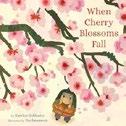
A young Japanese girl learns that nature can’t be rushed. As the story opens, Yuna is perched in a bare brown tree, amid wintry fields “buttered” with snow. Impatient, she asks her hībāchan (greatgrandmother), “When will your sakura tree bloom?” Hībāchan agrees that it’s difficult to await the cherry blossoms, only to watch them quickly blow away in the wind soon after they arrive. Nevertheless, this ephemerality is what makes the blooms so beautiful—a quality Hībāchan refers to as “mononoaware.” As spring approaches, Hībāchan’s eyesight dims, and Yuna describes what she sees, from green buds closed “tight as fists” to “the slightest blush of pink” to flowers that resemble sea anemones. Hībāchan appreciatively murmurs, “Ah mononoaware, ne?” When Hībāchan dies, the grieving girl climbs the tree; surrounded by bright pink blooms, she remembers her greatgrandmother’s spirit until the blooms fly away, giving her a firsthand experience of the fleeting nature of beauty and time. Though poetic and gracefully told, Goldsaito’s story will likely require explanation of these complex philosophical concepts. Imamura’s vibrant, geometric illustration style effectively uses varying perspectives to immerse readers in hanami, or flower watching. Her palette balances the stark browns of winter with the pastel pinks and greens of the coming spring.
An elegantly moving, if lofty, exploration of time and transition. (author’s note) (Picture book. 4-7)
Don’t Feed the Lion
Golodryga, Bianna & Yonit Levi | Arcadia Children’s Books (256 pp.) | $15.99 paper November 11, 2025 | 9781467196215
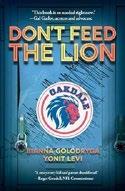
Jewish siblings Theo and Annie Kaplan grapple with antisemitism in their middle school and society at large. When soccerobsessed Theo’s favorite player makes an antisemitic statement at a press conference, the ensuing social media spiral sickens Theo. His teammates’ dismissive reactions further unsettle the eighth grader. When someone draws a swastika on Theo’s locker, he initially suppresses his feelings before eventually lashing out. Sixth grader Annie responds to the controversy by lying to the school librarian, whom she adores: She’s wracked with guilt but uses a library computer to create an illicit social media account and jump right into the fray, rebutting the bigotry she sees online. The boisterous, whitepresenting Kaplan family incorporates meaningful Jewish practices into their regular lives, although the authors’ depictions evoke some Jewish tropes, like the overbearing grandmother who must be covertly managed by other family members. Theo and Annie’s university professor parents pressure their children to stand up for themselves without offering much meaningful support. Using multiple firstperson perspectives— including that of new kid Gabe, who’s mourning the loss of his mother to Covid19—the authors maintain a quick pace even as both siblings reach a point of crisis. Theo and Annie remain likable and realistic in their behavior, but the characterization unfortunately struggles to keep pace with the action, leaving some of the emotions feeling abrupt and unearned.
An uneven depiction of how antisemitism manifests on social media and in real life. (Fiction. 9-13)
Gottardi, Valentina, Danio Miserocchi & Maciej Michno | Illus. by Valentina Gottardi Trans. by Sylvia Notini | Eerdmans (44 pp.) $18.99 | March 24, 2026 | 9780802856517
Series: Spectacular STEAM for Curious Readers
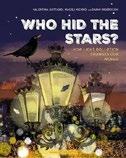
Translated from Italian, a clear explanation of light pollution’s threats, particularly to wildlife, wrapped in glowing nighttime scenes.
Though the authors note that bats, white owls, and other predators actually benefit from light pollution, their message is generally cautionary: More harm is being done than good to insects, migrating birds, and flora that miss their pollinators by blooming prematurely. And, since over 90% of all people on Earth have access to electricity now, it’s getting ever harder to see the stars at night. Gottardi’s illustrations up the warning’s wattage— and the wow factor. Her finely wrought images of flora and fauna share page space with spectacular swirls and explosions of colored lights. The narrative is occasionally interrupted by wordless, deserted, nocturnal views of a snowy park, a moonlit European street, and a broad, modern thoroughfare ablaze with neon. Though some younger audiences may be more inclined to pore over and admire the pictures than reflect on their import, their efforts to reflect will be rewarded, and the simply phrased appeal is backed up by both a useful list of information sources at the end and a link to a far more substantial bibliography online. Behind the art’s razzle-dazzle, a worthy call for attention to a burgeoning and underreported crisis. (glossary, ideas for reducing light pollution) (Informational picture book. 6-8)
Grant, Jennifer | Illus. by Julianna Swaney Eerdmans (32 pp.) | $18.99 | February 10, 2026
9780802855633 | Series: Consider

A rainbow of wildflowers thrives. In a pastoral scene, different types of flora attract insects and birds. From white Queen Anne’s lace and red poppies to pink primroses and black swallowtail butterflies, this field is awash in life. After highlighting various colors, Grant concludes by singing wildflowers’ praises; their beauty is striking if often fleeting, and they flourish despite the lack of human care. Indeed, they are “just where they / are supposed to be,” made specially by God—and, the author adds, “it’s the same with you / and me.” Though inspired by biblical verses, the text is general enough that readers might be able to find connections to major religions other than Christianity. On most pages, the color word is in a larger, brighter font, and the illustrations depict animals of similar or complementary shades. The first few pages read well, but the text loses anything resembling a meter about halfway through, and the rhyme scheme crumbles before the ending. In contrast, Swaney’s art is consistently elegant: simple and focused as flowers rise from the bottoms of pages, but also intentional and lovely, with layouts that invite prolonged contemplation. Any twopage spread could be hung in its own frame.
Classy color practice from the natural world, with divine consideration. (Picture book. 4-7)
Grossman, Lev | Illus. by Huỳnh Kim Liên Little, Brown (32 pp.) | $18.99 March 24, 2026 | 9780316570961

The god of the sun may be done for the day, but bedtime isn’t possible until the god of sleep can be found.
“It’s just about time / To retire for the night” for deities
everywhere, but “where in the world is the god of sleep?” Without her soporific influence, the god of the seas keeps swimming, “the god of fate is choosing. / The god of games is losing. / But till the god of sleep shows up, / There won’t be any snoozing.” Wandering through water, ice, space, and time, the sun god still “doesn’t do much finding.” After exploring every scenario, the sun god’s just about resigned to “stayingupallnighting.” But wait! The god of sleep finally appears to complete her slumberous nighttime ritual before ensuring that all the gods “are fast asleep and dreaming.” Bestselling author Grossman’s picturebook debut is a riotously entertaining collaboration with Vietnamese artist Huỳnh. Grossman writes in clever rhyming bursts—combining satyrs, equators, and dusty craters about all manner of unique gods, including “that mystifying yawn god,” not to be confused with “the mystery god [who] solves cases.” Hu ỳ nh affectingly melds elements from Antoine de Saint Exupéry’s work, manga, and anime while also incorporating Disneyfied Tinkerbells and even detailed realism—all in full Technicolor. The final spread captures the cast in all their deific diversity.
A witty bedtime tale—and proof that even gods need a bit of divine intervention to get a good night’s sleep. (Picture book. 4-8)
The Amazing Generation: Your Guide to Fun and Freedom in a Screen-Filled World
Haidt, Jonathan & Catherine Price Illus. by Cynthia Yuan Cheng | Rocky Pond Books/Penguin (240 pp.) | $24.99 December 30, 2025 | 9798217111909

A persuasive argument for disillusioned smartphone users to reject the hype in favor of “friendship, freedom, and fun.” This young readers’ edition of Haidt’s The Anxious Generation
As streamlined, inviting, and balanced as the Eameses’ famous designs.
SERIOUS FUN!
(2024) encourages young people to build a life free from smartphone addiction. Racially diverse fictional characters interact in Cheng’s mini comics, which are embedded within explanatory nonfiction prose. The paragraphs of Haidt and Price’s text are broken up with illustrations, sidebars, and occasional pages that evoke a scrapbook or notebook. The young characters model how smartphones encourage isolation, increase bullying, and take the place of exploring hobbies and cultivating talents. Short quotes from teenagers and people in their 20s that support the book’s message appear in colorful speech bubbles, along with a handful of fullpage “Meet a Rebel” interviews with people like 23 year old Gabriela Nguyen (founder of the Appstinence Movement), who advocates for leaving smartphones behind in favor of building inperson social relationships. The authors include hardhitting facts, statistics, and arguments that will persuade “rebels” to reject the addictive design models of the “greedy tech wizards.” The book’s design provides plenty of attentiongrabbing material, but it’s the research that makes it relevant and convincing, particularly since the authors never blame the users of technology. The “rebel” and “tech wizard” labels may feel hyperbolic, but the book addresses the importance of choosing a better path to support and maintain mental health with conviction. Will inspire balanced and thoughtful decision-making in a world where technology is designed to promote impulsivity. (resources, index) (Nonfiction. 9-12)
Hale, Christy | Neal Porter/ Holiday House (40 pp.) | $18.99
March 17, 2026 | 9780823456604
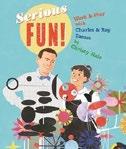
For the Eameses, work and play went hand in hand. Husband andwife industrial design team Charles and Ray Eames were renowned for their hands on methods. Giving equal time to both members of the pair, starting with their youth (when each lost a father), Hale notes the curiosity, discipline, and zeal for life that influenced their later careers. Teaming up as young adults, they aimed to solve problems, whatever the field, producing colorful, ingeniously engineered designs for toys, furniture, buildings, textiles, graphics, and exhibitions. They also collaborated on films, photographs, and animation. Hale focuses mainly on the couple’s use of wood and their goal of affordable modern mass production. Together they invented a method of bending plywood into perhaps their most famous creations, the various Eames chairs. Hale never mentions the later productions of their furniture designs in wire, fiberglass, and molded plastic, though she applauds their solarpowered “Do Nothing Machine” toy, made for an aluminum company. Stressing the duo’s philosophy of “learning by doing” and the sense of playfulness that permeated their work, Hale’s story is as streamlined, inviting, and balanced as the Eameses’ famous designs. The clean,
midcenturyinfluenced illustrations effectively convey the designs (the Eames House interior is especially appealing). A clever final spread summarizes some of their achievements, set against a backdrop comprised of an outline of one of their products. A winning celebration of a power couple’s versatility, innovation, and collaborative spirit. (more information on the Eameses, learn more, quotation sources) (Informational picture book. 8-12)
Kirkus Star
Harper, Charise Mericle | Illus. by Rory Lucey First Second (256 pp.) | $22.99 | $14.99 paper January 20, 2026 | 9781250851963 9781250851970 paper
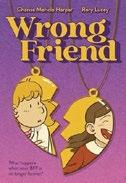
Middle school friendships are tough; they’re even harder when your best friend’s path diverges from yours. Elevenyearold Charise loves spending time with Casey, her best friend who lives only two doors down. Their friendship is easy and uncomplicated until Casey starts high school and freezes Charise out, leaving her adrift and friendless. Charise tries to make other friends, but none of her new prospects seem to be a replacement for Casey. Charise considers many different options even as she contemplates the characteristics of a best friend, which form the chapter titles: for example, “A Best Friend Keeps Trying,” “A Best Friend Cares About Your Feelings,” and “A Best Friend Fits All Parts of You.” When her classmate Susan invites her over to meet her guinea pig, Oscar, Charise breaks out into an embarrassing allergic reaction, making her fear she’s lost another chance at a new BFF. Lucey’s vibrantly hued panels complement Harper’s standalone graphic memoir, which thrums with relatability. The characters’ clothing and the absence of computers
or smartphones signal the retro setting—students write on chalkboards and use a card catalog in the library. The bright colors and simple backdrops keep readers’ attention focused on Charise’s feelings as she traverses the perils of middle school relationships. Perfect for readers of Shannon Hale and Raina Telgemeier, this accessible crowd pleaser will quickly win fans. Main characters read white.
A heartfelt, engaging charmer with broad appeal. (Graphic memoir. 8-12)
Whirby
Harris, Molly | Illus. by Jacob Souva Harper/HarperCollins (40 pp.) | $19.99 February 17, 2026 | 9780063385474
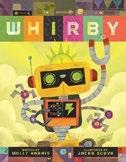
The titular robot learns a lesson in balancing work with rest. Although Whirby loves school and excels at subjects like magnetics, circuitry, and tinkering, he especially adores gadgeteering, because of the opportunities for “bot battles.” Whirby is so excited about competing in the next day’s tournament that he stays up all night practicing instead of plugging himself in and recharging his battery. The next morning, “his gears [feel] gritty, his buttons [feel] busted, and his cranks [feel] extra cranky.” At school, he experiences a major malfunction, and by the time he reaches the sporting ring, his battery has gone dead. His instructor, Dr. Whizbang, sends him home. Though devastated at missing his chance to go up against Dottie the Destroyer, Whirby makes a few observations about his body that night and “[codes] a new sequence” for himself, which little ones will recognize as a robot’s equivalent of bedtime rituals. Will Whirby feel ready tomorrow? Though older readers may find the tale a bit didactic, with its clearly telegraphed lessons, younger ones will be charmed by Whirby. Harris employs wellflowing sentences that make effective use of alliteration while playfully incorporating technical jargon. Featuring
bright, eyecatching backdrops, Souva’s whimsical, blocky depictions of automatons pair well with the text. Cleverly reinforces the dangers of running on empty. (Picture book. 4-6)
Heim, Alastair | Illus. by Pablo Pino Simon & Schuster (40 pp.) | $12.99
February 10, 2026 | 9781665970600

A tale of an unlucky leprechaun’s quest in the human world. A joyful singalong brings out all of the leprechaun land’s small inhabitants—except for chronically unfortunate little Clover, who’s overslept. Determined to find better luck, Clover sets off to discover his rainbow and the treasure that goes with it. He’s soon joined by a cute puppy (though he doesn’t recognize that event as evidence of good luck). Clover and the pooch see a puddle with a rainbow and jump in. But instead of finding the treasure, they just douse the onlooking human kids. Clover subsequently spots and pursues promising rainbows on a bookstore door, on a frozen treat, on a skateboard, in a bouquet of balloons, and on a giant kite. Bad luck results in Clover losing every one, signaled by his refrain, “Of ALL the luck!” But just as he bemoans his “saddest, baddest day,” it’s redeemed by a crowd who tell him that—despite the damage Clover’s wrought—a leprechaun’s visit has made this St. Patrick’s Day the best ever. And Clover sees those previously lost rainbows reappearing everywhere.
Pino’s jauntily ebullient rainbowcolored cartoon art depicts diverse humans and leprechauns, while Heim’s upbeat verse brings the tale to a chipper conclusion. A baseball cap and green tracksuit let pale skinned, redhaired Clover fit into the human world, despite his tiny proportions. A lighthearted story of going for one’s goal no matter what. (Picture book. 4-8)
Hirst, Daisy | Candlewick (32 pp.) | $18.99 January 13, 2026 | 9781536250145

An absurd situation paves the way for friendship. Betsy, a red cat who’s unquestionably devoted to a lizardlike stuffie named Philippa, lives a rather typical life—up until the day they spot a rather large hole, right smack dab in the middle of the street. Betsy has just vowed to ignore it when suddenly the words “WAAAAAH! I can’t find you…” emanate from within, shortly followed by a banana flung from its depths. Intrigued, Betsy decides that the pair should keep an eye on the hole, but they’ll need snacks, so Betsy sets off. In the interim, Philippa disappears (presumably down the aforementioned hole). Diving in to look for her, Betsy discovers a whole world of different creatures beneath the surface, including a cheery crocodile named Nelson who’s also lost a stuffie (a kitty named Josephine), which Betsy has found along the way. Hirst relies on a distinct screenprinted style full of bold colors and even bolder characters. The inherent humor of finding a mysterious hole and
Perfect for readers of Raina Telgemeier, this crowd pleaser will win fans.
WRONG FRIEND
BEATRIX
then exploring its depths is a distinct enticement, but it’s the relationship between Betsy and Philippa (and then, in time, Betsy and Nelson) that gives the book its heart and soul. That Betsy is a cat with a lizard stuffie and Nelson is a reptile with a feline plush toy just adds to the fun.
A journey into the unknown yields friends both old and new in a tale that’s one part diverting and two parts charming. (Picture book. 3-6)
Hocker, Katherine | Illus. by Svabhu Kohli Candlewick (32 pp.) | $18.99 | March 17, 2026 9781536230727

In poetic language, a chorus of creepy crawlies invite closer looks at life beneath the surface of ponds and streams.
“Some of us live in rivers: / under rifflewrinkles or eddywhirls,” murmur the larval mayflies, dragonflies, mosquitoes, and other insects that spend most or all of their lives underwater, “or in warm midwater sun shafts. / You might see us then .” Some are beautiful, Hocker writes, others “seriously creepy!” In any case, Kohli definitely goes for the latter—at least at first—with a series of leggy, segmented, exactly detailed predators observed in extreme closeup views hatching and growing, ferociously eating and being eaten, in watery natural settings. At last comes a final metamorphosis that sends many creatures flitting gracefully through the air on glassy wings past a marveling, brownskinned young
observer. “When you see us,” they conclude, “think of what we were / and what we became. / Think of what you were / and what you can become.”
Young readers should study the author’s closing key to the multispecies insect cast and follow her practical and explicit instructions for observing these common creatures in ways that will leave them and their natural habitats only minimally disturbed; they’ll likewise find opportunities aplenty to marvel and reflect.
An immersive dip into an enticing world as close as the nearest natural body of fresh water. (resource lists) (Informational picture book. 6-9)
Hosford, Kate | Illus. by Richard Jones
Beach Lane/Simon & Schuster (32 pp.)
$19.99 | February 3, 2026 | 9781665940382
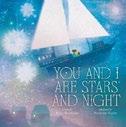
Bedtime preparations kick off a romp through the imagination. In a maritime village where “the wind is calling,” an unnamed brownskinned adult and child begin their nightly regimen. While the little one bathes, the adult, holding a toy boat, asks, “Will you sail away with me?” As they embark on a journey “over lands unknown” and “restless waters,” Hosford’s verse employs a simple yet effective AABB rhyme scheme, each spread ending with the phrase “You and I are…” that compares the protagonists to something they recently explored: “salt and sea,” “egg and nest,” “stars and night.” Caregiver and child reinforce their bond as they play hideandseek in a colorful forest, scale mountains, and finally return home. As bathtime
becomes bedtime, the child gently falls asleep, assured of the parent’s love and devotion. Hosford’s soothing firstperson text, told from the perspective of the grownup, combines with the comforting deep blues and greens of Jones’ digitally finished acrylic and watercolor illustrations for a natural bedtime read that’s also likely to be a popular gift among new parents. Observant readers will see the child’s toys making appearances throughout, adding another layer to a lovely reading experience. A soothing, poetic look at a common nighttime routine. (Picture book. 3-7)
Star
James, Anna | Illus. by Matthew Land Flamingo Books (240 pp.) | $18.99
January 6, 2026 | 9780593691991

In 1919, Alyce, the granddaughter of Alice (of Wonderland fame), finds herself in a very strange world after she falls into a pond. Alyce receives a smudged invitation to a tea party, mysteriously signed with three sets of initials. She’s always thought her grandmother odd because of the unbelievable stories she told, but now, after she accidentally falls into a pond, Alyce finds herself in a topsyturvy world inhabited by beings from the original Wonderland story. After some clever and nonsensical conversation, Dormouse, Hare, and Hatter implore Alyce to seek out the Time Being, whom they believe to be the only one who can stop the war between the Sun King and the Queen of the Moon. The queen has accused the king of stealing an hour from her, and their ensuing battle leads day or night to come willynilly, depending on who’s winning. Alyce sets off, unsure of where to find the Time Being, but as she journeys, she encounters other beloved Lewis Carroll characters, who introduce silliness, wisdom, and perhaps a moral
or two (but that’s for readers to decide). Land’s exquisite, detailed blackandwhite illustrations feel updated while evoking John Tenniel’s original artwork. With confident writing that manages to be both archly British (“How dreadfully impertinent”) and whimsical (“The Things You Need To Know Before We Begin”), this homage sparkles. Human characters read white. Delightful in every way. (Fantasy. 8-12)
Judge, Lita | Atheneum (40 pp.) | $19.99 February 10, 2026 | 9781665963916
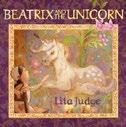
A lonely servant finds solace in the presence of a gorgeous tapestry on a castle wall. Young Beatrix feeds the geese, scrubs the floors, and waits on nobility. Sweeping the great hall provides “her only glimmer of joy”: viewing a shimmering tapestry that depicts a soft, huggable unicorn who “smile[s] at her like a friend.” To escape her loneliness, she journeys into the dark forest late one night in search of the mythic creature. There, she helps a frightened rabbit, bandages a wounded dog, welcomes a kitty who’s been trailing her quietly, and feeds hungry birds and beasts. Soon Beatrix falls into an exhausted slumber and meets the unicorn, whose “rumbly purr” assures her, “Brave girl. Kind girl. Sharing, caring girl. You are loved.” Her sadness at awakening from her dream quickly transforms into delight as she glimpses the pup’s beautiful eyes, strokes the rabbit’s soft ears, and happily embraces the cat. Prolific author/illustrator Judge’s golden artwork suggests medieval inspiration, the decorative border reminiscent of illuminated texts, the noblewomen wearing hennin and escoffion. Judge’s tapestry recalls the Unicorn Tapestries in New York’s Metropolitan Museum of Art’s castle esque Cloisters, but with a welcome adaptation—her unicorn glows with freedom and joy. That the kitty has been by Beatrix’s side all
along underscores an important truth: Friendship is always near. Human characters are tanskinned. A resonating reminder that showing kindness to others—especially animals—is the greatest magic of all. (Picture book. 5-8)
Khan, Hiba Noor | Illus. by Singgih Cahyo Jadmiko | Candlewick (32 pp.) | $18.99 January 6, 2026 | 9781536251562

A young girl and her family celebrate Eid alFitr, the end of the holy month of Ramadan. When brownskinned Hafsa spots the first sliver of the new moon through her telescope, she exclaims, “There it is: Tomorrow is the day!” With that, Eid begins, and so does a beloved family tradition: cooking sweets together and delivering them to their neighbors. When the treats run out, Hafsa must make a choice that reflects the true spirit of Ramadan. As her father reminds her, “Being kind is just like this ripple—it grows and grows until it is everywhere,” encapsulating the theme of the book. Khan gently introduces readers to the practices of Ramadan—fasting, praying, and reading the Quran—while portraying a loving family and a richly diverse Muslim community. The accessible language naturally incorporates myriad cultural terms, celebrating traditional clothing like abayas, boubous, shalwar kameez, thobes, kurtas, and kaftans. Jadmiko’s digitally rendered illustrations are bright and expressive, showcasing joyful faces and complementing the text. Set in a modern neighborhood, this sweet and hopeful tale emphasizes generosity, faith, and the importance of community. Recipe and craft instructions in the backmatter invite readers to continue the celebration at home.
A rich embodiment of the Ramadan spirit. (Picture book. 5-8)
King, Mike | Illus. by Shahar Kober
The Collective Book Studio (32 pp.)
$18.95 | May 6, 2025 | 9781685559281
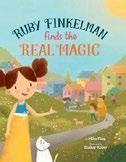
When one girl stops brushing her teeth, she sets into motion a series of events that lead to an entire community falling apart. Welcome to Kvellville, a town filled with exemplary citizens who take good care of themselves and the world around them. One morning, young Ruby Finkelman declares that she’s done with her dental hygiene routine. A doctor, a dentist, and a rabbi are all called in to consult, but they fail to get Ruby to resume brushing. Disaster strikes as other kids follow Ruby’s example; their parents, tired of nagging them, stop doing their own chores, and Kvellville slips into disrepair. Fortunately, Ruby starts brushing again, discovers the power of serving her community, and averts disaster through her good deeds. Rife with Jewish and Yiddish expressions, King’s tale about the power of a single action is uplifting, if a bit heavyhanded. Kober’s bright and playful pastel illustrations lend a cheery aspect to the book. Tanskinned Ruby heads up a cast diverse in terms of skin tone; several characters wear kippot. An author’s note explains the value of being a good person, known in Yiddish as a mensch. A glossary of Yiddish and Hebrew terms is included.
A cheerful tale about how one small change can make all the difference in the world. (Picture book. 4-6)

For more by illustrator Shahar Kober, visit Kirkus online.
CHILDREN'S
WE ARE DWARF SPERM
Kirkus Star
Morland
Kurtz, Jane | Illus. by Giselle Potter Beach Lane/Simon & Schuster (48 pp.)
$19.99 | February 24, 2026 | 9781665955546
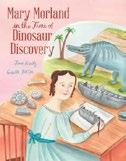
B efore the word dinosaur existed, a young female fossilist helped identify the creatures.
How can a biographer truly know a subject’s unrecorded emotions? With this immediate and engaging account, Kurtz solves that problem by asking readers how they might feel were they to experience what Mary Morland (17971857) went through, like being expected to sit decorously in a parlor rather than go outside exploring or being sent to live with friends after her mother’s death. Immersing readers in historical context, Kurtz also challenges the conventions of the time by posing cheeky questions about whether Mary met these social expectations, then answering confidently in the negative. Instead, Mary collected shells and fossils, illustrated books by her husband, fossilist William Buckland, and traveled Europe with him, meeting scientists and visiting fossil sites. In Kurtz’s perky prose, Mary springs to life as independent, curious, and relatable. Though the author emphasizes her subject’s collaboration with Buckland, she acknowledges that women in science were usually unrecognized at the time. Nothing in the text indicates Mary’s or her husband’s English nationality, though we might deduce it from the
author’s note. Potter’s delicate pastel illustrations evoke the naïve art of the period, as well as its social setting. One image depicts Mary’s many children romping in their “household of chaos.” These scenes perfectly suit the text’s project of relevance and inspiration. A delightful STEAM biography that spotlights a female scientist who deserves to be better known. (bibliography, further reading) (Informational picture book. 4-8)
Lambelet, Anne | Graphic Universe (88 pp.) | $12.99 paper | March 3, 2026
9798765685471 | Series: Anne Lambelet’s Marine Life

On the way to school, a small whale with a big personality gets the lowdown from Mom on the whole cetacean clan.
It’s a good thing school isn’t too close, because Kogi (short for the scientific name Kogia sima) has much to absorb about what makes whales distinctive from other creatures, the differences between toothed and baleen whales, and how the entire family descended not from prehistoric marine reptiles like mosasaurs, but from a catsize landdwelling genus called Indohyus over the past 10 million years. The young enthusiast is thrilled to be a sperm whale, the largest of the toothed sort—but bummed when Mom offers a gentle correction. No, Kogi is a dwarf sperm whale, the smallest species of whale in the world. Worse yet, dwarf sperm
whales don’t sing, nor do they swim as fast as dolphins. But, she consoles her fretful offspring, they are excellent echolocation hunters and suction feeders. Plus, along with their slightly larger cousins the pygmy sperm whales, they’re the only whales that can actually shoot ink out of their butts like squid to escape predators. “We’re stealth whales!” Kogi crows, high spirits restored. As in her book I’m a Dumbo Octopus! (2025), Lambelet fills her bright marine scenes with smiling but otherwise recognizably drawn sea life, peppers her work with a winning mix of humor and information, and closes with an actual photo of her effervescent, stubbylooking subject in the wild.
A fetching introduction that effortlessly delivers tons of fascinating facts. (glossary, bibliography, further reading) (Graphic nonfiction. 8-11)
Larson, Kirsten W. | Illus. by Cornelia Li Little, Brown (40 pp.) | $18.99 September 16, 2025 | 9780316283281

Words of wisdom for budding scientists. Science, Larson writes, is more than just a class in school. It’s actually a process—one that begins with “a question / you can’t answer.” Scientists must envision possible answers, search for clues and evidence, test solutions, and often fail time after time until (as she puts it) that “EUREKA!” moment comes at last. Reflecting the author’s abstract language, confettilike squiggles representing ideas and bits of knowledge float through Li’s artwork, but more literalminded STEM winders will appreciate seeing a bustling, multiracial cast of brighteyed young investigators looking down at leaves and up at the stars, planting seeds in pots or mixing chemicals in test tubes, trying out different designs for a homemade rocket, and commiserating when results disappoint. “It’s the way science works— / it’s surprising, /
messy, / beautiful.” The underlying themes that science opens new worlds to the imagination and is ideally a collaborative effort become explicit at the end, with climactic twin views of a fleet of spacecraft zooming away from our planet and of scientists working hard on every continent and the oceans between to make it “a better place.” Sets of inspirational quotes and recommended information sources close this eloquent appeal to stay curious.
A soaring paean to the scientific method in all its messy, uniquely promising glory. (Informational picture book. 6-10)
Liu, Hao | Clavis (48 pp.) | $20.95 August 19, 2025 | 9798890632333

A boy hopes to become a mighty wrestler. Colorful, folkstyle images reminiscent of oil pastels depict the open grasslands of Inner Mongolia, where strapping, brownskinned men in traditional wrestling outfits clash in sporting combat. Young Anand watches from the sidelines, yearning to participate and win the jangga, a colorful loop of streaming ribbons that only the most formidable wrestlers wear around their necks. But Anand knows he needs practice. So for four seasons he trains, not only practicing physical strength and agility, but also demonstrating the attributes of the grassland wrestlers: “strong, persistent, loving, and helpful.” A year passes, and Anand is ready. He faces an opponent who looms over him. But before they can fight, a sandstorm begins to rage, tossing yurts in the air like feathers and felling trees. Anand wrestles the wind, righting a tree and pushing to keep it upright. Soon, more hands are helping, and every brave wrestler is righting trees, protecting the grassland against the wind. When the wind retreats, all is peaceful again, and that day every wrestler earns the jangga, including Anand. Liu’s gently
humorous, elegant text (translated from Dutch) and sturdy artwork capture both the strength and gentleness of these great fighters, as well as the deep sense of tradition imbued in the sport. A charming introduction to the strength and nobility of Inner Mongolian wrestlers. (Picture book. 4-8)
Liu, Hsu-Kung | Trans. by Rachel Yung-Hsin Wáng | Eerdmans (48 pp.) | $18.99
March 3, 2026 | 9780802856579

For all his life, a monk is able to write only one character, but that single skill proves lifesaving. Little Monk lives in the temple where he was born. As he grows, he fetches water, sweeps, and cooks. Although he can’t read, he keeps smiling even when others laugh at him. During a bout of relentless rain, Old Monk teaches Little Monk to write 雨 (the character for rain). Practicing the character becomes a soothing daily habit as he grows into Big Monk over 20 years. And then his community is called to the city to pray away a debilitating drought. Unable to read the Buddhist scripture books, Big Monk instead “takes out sheet after sheet of 雨 and is flooded with memories.” One sheet is smudged with his tears over Old Monk’s passing; another sheet, written after children threw rocks at him, is tinged with pain. Indeed, the monk’s poignant tears are what eventually bring raindrops from the sky. The book’s unusual horizontal binding requires pages to be flipped upward to reveal vertical spreads, not unlike traditional Asian scrolls. Taiwanese writer/artist Liu’s atmospheric watercolor and ink illustrations highlight the natural world, reflected in greens, browns, and oranges. His people, artistically rendered in a naïve rather than realistic style, convey a sense of childlike wonder. Liu’s author’s note adds heartwarming acknowledgment and appreciation for those with disabilities. Wáng provides a gratifying translation. The book’s geographic setting is unspecified; characters are tanskinned.
Tender proof that humility and tenacity can inspire miracles. (Picture book. 5-10)
Lourenço, José | Illus. by James Braithwaite
Tundra Books (40 pp.) | $18.99
April 14, 2026 | 9781774884041

A scienceminded child discovers that friendship is often found when you least expect it—and when you most need it.
Billie never met a problem she couldn’t solve through resourcefulness and a cando attitude. When she and her dad move, however, her upbeat perspective is put to the test. Dad suggests visiting the local playground to find some potential new buddies, but Billie’s got a better idea. Why make a friend when you can make one—literally? She designs a glitzy robotic unicorn with a magic horn, kind (and deadly) laser eyes, and rocket hooves. But once complete, RoboCorn looks more like a garbage can with tubes attached. And her new companion can’t do anything magical (or nonmagical, for that matter). Billie proposes going to the park so RoboCorn can meet some new pals (Billie insists that she’s doing fine). The trip is a bust for RoboCorn, but Billie befriends another young bot enthusiast, and just like that, she’s got two friends in her new town. Throughout, Billie doggedly attempts to include RoboCorn in a range of activities, from dancing the limbo to putting on makeup— all of which fail, hilariously, as the automaton slumps over wordlessly. The “ink, watercolor, sweat, tears, and blood” that (per the copyright page) went into Braithwaite’s playful, scribbly artwork shine, as do the abundance of visual gags and turns of phrase that’ll make even

For more friendship stories, visit Kirkus online.
grownups reading aloud chuckle. Characters are paleskinned. Friendship made easy—and fun. (Picture book. 4-8)
Maland, Nick | Peachtree (40 pp.) | $18.99 February 3, 2026 | 9781682638095
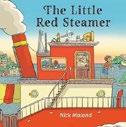
Lian and her father, the Captain, have a rewarding yet quiet life ferrying people around the Islands in their beloved boat, until disaster strikes.
Maland’s cartoon style pen and pencil art, with digital color added, cheerfully conveys the Little Red Steamer’s satisfaction at transporting passengers, both children and adults, to school and to work, where they “ask and learn…build and mend… help and heal.” But everything changes when a sudden squall sweeps the little craft out to sea, with Lian and the Captain aboard. Maland’s strong black lines work well in conveying the peril of the Little Red Steamer amid the swirling waves, and his text supports the tension with lines like “she bustled and blustered across a stormy sea.” As days pass and the Captain and Lian collapse with exhaustion, the Little Red Steamer realizes that she must save them all. Eventually they find themselves being dangerously swept by the tide into a crowded harbor, but a tugboat comes to the rescue—and seems none too happy about it (“You’re too broken to be here”). Now high and dry on land, the Little Red Steamer appears to be beyond repair, but Jim and Ava, another father daughter
pair, show up to help with the restoration. In a pleasant conclusion, it’s the two daughters who continue the tradition of carrying passengers, now around the harbor of a big city. Lian and the Captain are brownskinned; Jim and Ava are pale skinned.
A satisfying adventure for boat devotees. (Picture book. 3-8)
Marshall, Linda Elovitz | Illus. by Francesca Assirelli | Kar-Ben (32 pp.) | $19.99
January 6, 2026 | 9798765663509

A misunderstanding baffles a young Jewish girl trying to make sense of Passover rituals. When her grandmother hands her a stack of Haggadahs to put on the seder table, Talia is confused by the term. “Hug gadah,” she chuckles. “What a funny name for a book!” As the seder begins, she wonders when the hugging portion will begin. Marshall’s lighthearted text leads readers through various aspects of the seder, such as lighting candles, saying a blessing over the wine, and hand washing. The biblical story of Moses is told, the symbolic foods introduced, the hidden piece of matzah found, and the four questions sung. Assirelli’s cheery illustrations, rendered in earth tones sprinkled with pops of color, feature characters who vary in skin tone; Talia is light skinned. Though Talia may be confused, the audience is unlikely to be, thanks to Marshall’s playful text, rife with delightful
This sweet comic marks the beginning of a beautiful, blossoming friendship.
dramatic irony. In previous books, Talia has been perplexed about Rosh Hashanah, Yom Kippur, and Purim, and this installment makes a worthy addition to the series. Filled with hugs before and after the seder (although not during!), the tale provides a strong overview for those unfamiliar with the holiday. A joyful and humorous Passover celebration. (more information on Passover) (Picture book. 3-6)
McGrath, Raymond | Graphic Universe (64 pp.) | $12.99 paper | February 3, 2026
9798765648131 | Series: BIRD!

A bird and a spider become springtime companions. Bird leaves home and strikes out alone to find a tree, build a nest, sing a song, and make a friend—tasks listed on a loving note from Mom. Bird quickly finds the tree, a gorgeous creation blossoming profusely with pink flowers, afforded its own double page spread so readers can marvel alongside the small blue chick settling on its branches. Time to build that nest! Bird opens a suitcase, and scraps spray out everywhere (“Perfect,” concludes our hero). When Bird discordantly squawks a friendship song, a spider appears. At first, both creatures are mutually skeptical at the prospect of becoming pals—some birds eat spiders, and spiders sometimes bite. When both promise to behave, however, they slide into a pleasant partnership. Spider reassembles Bird’s tangled strings into a colorful, bespoke home—spiders are weavers, after all. Bird and Spider each open up about their desires for a best friend and put on a repeat performance of Bird’s friend seeking song together, never realizing—though readers will—how deeply their own
relationship is taking root. Bird and Spider’s empathetic interactions recall Owly and Wormy’s supportive bond, while the focus on the magnificent tree and on springtime’s seasonal markers elegantly ties the book together visually, smoothly guiding the story toward the next season of Bird’s tale. This sweet comic marks the beginning of a beautiful, blossoming friendship. (Graphic early reader. 4-7)
Melleby, Nicole | Little, Brown (336 pp.) $17.99 | January 13, 2026 | 9781523529360
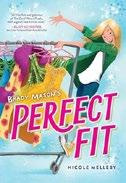
An orphan achieves her dream—but can she keep it? Brady, who’s almost 13, wants to play baseball all summer, while the other girls in the group home are more interested in celebrities and fashion. When Elena Lavigne, the gorgeous editor of a famous fashion magazine, appears on TV and is asked about the baby she gave up for adoption 12 years ago, Brady’s housemates become convinced Brady’s the longlost heir to her fashion empire. After the girls’ social media posts about this theory go viral, Brady gets the shock of her life: She is in fact “the secret baby of Elena Lavigne.” Brady will do absolutely anything to hold on to her mom and her new life, even if it means forcing herself to be what Elena wants. And Elena, fashionista extraordinaire, obviously wants Brady to be a girly girl. So Brady will sit in the fancy Upper East Side town house, wear the feminine clothes in her massive new closet, and hope Elena never realizes that she’s actually “low class, and messy, and Jersey, and gay.” With help from soccermad Mia, her queer nanny, Brady learns to speak up for herself—and Elena learns to listen and trust. It turns out that even fashion has a place for the butch, sporty queer kid. A strength of the
Dog lovers and theater fans unite with this bouncy bevy of delights.
BALLY THE AMAZING WONDERBALL
book is the welldeveloped characterization that goes beneath the surface to explore Brady’s and Elena’s deeper feelings. Main characters read white. A lovely, heartwarming rags-to-riches story. (Fiction. 8-12)
Morris, Jordan | Kids Can (36 pp.) | $19.93 September 2, 2025 | 9781525312625

A theatrical performance goes to the dogs, literally. An unseen announcer lets the star of the show know that there’s good news and bad news. The good news is that the performance has sold out! The bad news? The entire audience is made up of canines. This wouldn’t be a problem if that star weren’t BALLy, an actual ball with big, expressive eyes. When BALLy refuses to go on, the announcer makes every dog in the audience sign a contract vowing not to “chase, bite, lick or excessively sniff” the star. Satisfied, BALLy performs a series of spins and rolls, much to the dogs’ excitement. Unfortunately, Sprinkles the Dalmatian comes out of nowhere and upends the performance. Can the show go on? Probably not, after the announcer is revealed to be…a squirrel. The read aloud qualities of Morris’ text are abundant, certain to deeply amuse all those who have ever tried to reason with a dog of their own (“DROP IT. Droooop it ”). Morris’ deft mixedmedia collages perfectly convey the overenthusiasm of the pooches, as well as BALLy’s own subtle shifts
in mood. Adult readers will also appreciate the multitude of tiny humorous details, like BALLy’s fan mail and the fine print on the dog contract.
Dog lovers and theater fans unite at last with this bouncy bevy of delights. (Picture book. 3-6)
Ohtani, Shohei & Michael Blank | Illus. by Fanny Liem | Harper/HarperCollins (32 pp.)
$21.99 | February 3, 2026 | 9780063460775

Ohtani, pitcher for the Los Angeles Dodgers, teams up with Blank and Liem to tell the story of how his dog, Decoy, threw out a ceremonial first pitch.
It’s a big day! Decoy leaps “off the bed. Then back onto the bed. Then off the bed.” The enthusiastic pup heads outside to practice with his lucky baseball but is quickly distracted by squirrels (“we’ll play later!”), airplanes (“flyin’ high!”), and flowers (“smell ya soon!”). Dog and pitcher then head to the ballpark. In the locker room, Decoy highpaws Shohei’s teammates. It’s nearly time! But as Shohei prepares to warm up, Decoy realizes that he’s forgotten something important: his lucky ball. Without it, there will be “no championships, no parades, and no hot dogs!” Back home he goes, returning just in time. With Shohei at the plate, Decoy runs from the mound to his owner, rolling the ball into Shohei’s mitt for a “Striiiiike!” Related from a dog’s point of view, Ohtani and Blank’s energetic text lends the tale a sense of urgency and suspense. Liem’s illustrations capture the excitement of the first day of baseball season and the
joys of locker room camaraderie, as well as Shohei and Decoy’s mutual affection—even when the ball is drenched in slobber, Shohei’s love for his pet shines through, and clearly, Decoy is focused when it matters. A charming tale of an athlete who may not steal any bases but who will certainly steal readers’ hearts. (Picture book. 5-7)
Onuzo, Chibundu | Illus. by Paula Zorite Bloomsbury (288 pp.) | $9.99 paper January 6, 2026 | 9781526661005

A London girl gains deeper knowledge of the power of words and her family’s mysterious legacy. Mayowa Howard, whose mother is Nigerian and father is white and English, first tried jumping on a book when she was 8, but she only succeeded in tearing the cover. She’d seen Grandpa Edward book jumping when he visited, and she wanted to try it, too. Her math teacher father considered this a “harmless family tradition” (but frustratingly wouldn’t say more); her mother, a blind jazz pianist, forbade the activity, worried that Mayowa might damage another book and get in trouble. Now 10, Mayowa goes to stay with Grandpa Edward at the grand (if dilapidated) Edgerley Hall over summer break, where she finally gets some real answers. Grandpa Edward explains that “every time you read a book and feel something, that feeling returns to the book.” Some people in their family—logosalters, like
Mayowa—can release these stored emotions by jumping on the books. When Mayowa gets to know Hamza, a local refugee boy, and learns about an upcoming parliamentary vote on a bill to do with refugees and asylum seekers that’s attracting xenophobic rhetoric, she springs into action with help from Grandpa Edward. Onuzo’s young readers’ debut incorporates humor (including funny footnotes) into a story that cleverly explores the ways that literature promotes empathy. Zorite’s lively blackandwhite illustrations add to the charm. An imaginative series opener that will warm readers’ hearts. (Adventure. 8-12)
Woodlore: Discover the Seasons and Stories of the Forest
Parr, Kevin | Illus. by Anja Sušanj Magic Cat (48 pp.) | $24.99 March 17, 2026 | 9781419786709
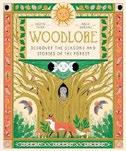
This seasonally arranged compendium explores the science and folklore of the temperate forest, focusing on one Eurasian oak species, Quercus robur, or English oak. Beginning with the spring equinox and a botanical profile of the oak, Parr examines the forest understory, woodland flowers, and animal nests and burrows. Next comes summer’s abundance: “A single oak tree can support more than two thousand species of insects, plants, fungi, mammals and birds, some of which are not found on any other tree.” The author points out that certain species of butterflies and moths thrive among
Immersive text creates an earnest tribute to a beloved Islamic tradition.
A RAMADAN NIGHT
trees rather than flowers and that birds tailor their breeding and hatching periods to coincide with times of abundant food for their young. Parr outlines the science behind oak galls, which can be harvested and used to make ink. The section rounds out with folkloric creatures like the Green Man and Woodwose. Sections on autumn and winter similarly gather science facts and cultural lore. A sampling of topics includes hornets and bumblebees, fungi, berries and nuts, owls, the rich lore of the parasitic plant mistletoe, and the cross cultural symbolism of evergreen wreaths and holly. Accompanying this plethora of well curated facts and traditional knowledge are Sušanj’s bright doublepage spreads filled with illustrated text boxes and detailed borders, accenting scientific verisimilitude with touches of magic and whimsy. (Fairies and witches pop up throughout; human skin tones vary.)
A successful integration of information and illustration that will appeal broadly. (glossary) (Informational picture book. 7-10)
Pawis-Steckley, Mangeshig Little, Brown (40 pp.) | $18.99 October 7, 2025 | 9780316574518

A shadow helps an Indigenous boy see things differently. Zoon is constantly trailed by the shadow, a doglike gray trickster creature with an elongated body and limbs who makes messes and teases the boy’s classmates— misbehavior that unfairly lands Zoon in trouble. Frustrated, Zoon turns to Nookomis, his wise grandmother. Playing a drum that once belonged to Zoon’s grandfather, she tells him that the heirloom is “called a dewe’igan, the sound of the heart. Use it when you need help guiding your own.” When Zoon’s accosted by the shadow later, his
attempts to calm the creature by banging the drum only anger it, and it grows in size. But when Zoon slows the beat, his spirit dances in the sky. When the boy learns to rely on his inner strength, the shadow transforms into a loving companion. In the backmatter, PawisSteckley (Anishinaabe) discusses the trope of the trickster character, someone who makes mischief but often teaches important lessons. His fastpaced story and dramatic art will be immensely captivating to a young audience. The vivid graphic art, embedded with Anishinaabe motifs, intensifies as the adventure progresses; as the shadow looms large, the palette is dominated by moody blues and purples. Why Zoon was visited by the shadow is never made explicitly clear (PawisSteckley’s note alludes to “a certain darkness” and “overwhelming sadness” he experienced as a child), but the story offers readers the space to ponder that question for themselves.
A moving and imaginative tale to heal tender hearts. (glossary) (Picture book. 4-8)
Powell, Claire | Candlewick (160 pp.)
$16.99 | February 10, 2026
9781536247800 | Series: Marty Moose, 1

Neither snow nor rain nor heat nor gloom of night keeps this plucky mouse from his deliveries. Having grown up hearing the tales of his intrepid GreatAunt Ada, aka “the GREATEST MAILMOUSE WHO EVER LIVED,” Marty Moose is determined to follow in her footsteps. (The book’s opening pages explain that Marty’s unusual name is the result of a birth certificate error.) He sallies forth on his first day of work. Unfortunately, a prankster in the mailroom has slipped two packages that don’t belong into Marty’s pack. Initially all goes well, and though Marty gets lost while making deliveries in a rabbit
warren, he befriends Nibbles Frizzby, a bunny best described as a “complete and utter kook,” with a personality that’s equal parts trickster and wise fool. When Marty delivers the prankster’s packages to a pair of feuding toads, he finds himself in dire circumstances. Now Marty must not only escape with his life, but also find the blackguard who’s tricked him. Plenty of potty humor and a justified but still meanspirited ending threaten to waylay the book’s earnest premise, but Marty’s good humor and Nibbles’ genuine hilarity do much to alleviate such concerns. Powell’s expressive and cartoonish line drawings also bring to life both Marty’s own emotional roller coaster and the chaos his adventures unleash. Postal pranks and mailroom mischief make for a series starter worth writing home about. (Chapter book. 6-9)
Presley, Nadine | Illus. by Asma Enayeh Salaam Reads/Simon & Schuster (40 pp.) $19.99 | January 27, 2026 | 9781665969338

A Muslim child sets out to discover what makes Ramadan nights special. Sami and Baba sit on the terrace in their Damascus home as the Islamic call to prayer reverberates. Baba exclaims, “It feels like a Ramadan night.” When young Sami doesn’t understand, Baba invites the little one to discover what he means. A rich journey ensues as the two make their way to the mosque for the special night prayer, Taraweeh. To Sami, Ramadan feels like glimmering golden lanterns on balconies, a breeze permeated with perfume, and tasty treats like kunafa and ice cream, eaten to break their fast. It’s the warmth and welcome of Sami’s Syrian community, diverse in skin tone and dress. Inspired by her own memories, Presley engages the senses with her work, conveying the aspects of Ramadan that delight and inspire awe not only for Sami, but also in Muslim communities around the world. Each repetition of Sami’s
question—“What does a Ramadan night feel like?”—is an opportunity to examine everything from congregational prayer to charity and mindful fasting. Enayeh’s beautiful gouache illustrations are an invitation to linger on each page and take in Sami’s Damascus neighborhood, set against the backdrop of a velvety night sky bejeweled with twinkling stars and a crescent moon that follows father and child wherever they go. Immersive text creates a touching and earnest tribute to a beloved Islamic tradition. (author’s note) (Picture book. 4-8)
Raúl the Third | Colors by Elaine Bay Little, Brown Ink (144 pp.) | $14.99 $8.99 paper | January 27, 2026 9780316528955 | 9780316529068 paper
Series: The Snips, 2
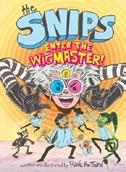
A group of hairdresser superheroes face off against their wiggiest villain yet. Flealix the dog and the aptly named, uberhirsute Unruly HairThing—both members of the Snips—are enjoying a sunny day in the park. But things turn hairrowing when a bigwig baddie known as the Wigmaster shows up with his army of “wignions” (people he’s hypnotized to do his bidding) to steal Flealix’s watch, just the tool he needs to enact his wigalicious plan. At Tijera Tower—the Snips’ scissorsshaped headquarters—Flealix and the Unruly HairThing, joined by team members Patty Pomada, Nubes Cloudhead, Letty Lentes, and Casco Hardhat, prep for the annual Snipseum Gala, with this year’s celebration centered on the history of wigs. Enter the Wigmaster, who marshals his growing number of wignions and his newly acquired watch to crash the fiesta and steal the Snips’ wigs, kidnap the Unruly HairThing, and enact his plan for complete domination of Scissor City
and beyond. Along the way, the Wigmaster even manages to brainwash and recruit Patty, Nubes, and Letty. Now, Casco and Flealix must level up their hair game to save the day. Like their previous, laughoutloud outing, the Snips’ latest adventure cuts through the noise with thrilling action, punworthy giggles, and a wacky cast of heroes and villains alike. Raúl the Third keeps Scissor City a colorful comicbook oasis, peppered with the occasional Spanish word or phrase, meta interjections from the author, and a much tighter plot than the earlier book, delivering spectacular antics befitting his charismatic, racially diverse heroes. Hair-larious fun. (Graphic fiction. 7-10)
Redlawsk, Kam | Union Square Kids (48 pp.) $18.99 | September 2, 2025 | 9781454963172

A young girl embarks on a journey of perceptive acceptance as she faces a debilitating illness. Sporting a flouncy skirt and shiny striped boots, exuberant, redhaired Yumi loves to “run, climb, dance, and skip.” The appearance of oversize Monster, whose striped horns echo Yumi’s horned hoodie, coincides with the child’s growing fatigue and weakness until she needs a cane for support. “No matter what, he was always there.” And yet Monster tries to “make her happy, make her laugh.” She accepts his invitation to explore, hoping to lose him in the snowy woods. But Monster always finds her, then helps, encourages, and soothes her. When he accidentally drops her on the ice, she banishes him, only to regret her harshness. His return becomes an acknowledgment of their symbiotic relationship: “I am only me because of you,” both agree. Artist and disability advocate Redlawsk is a cinematic creator, working mostly in layers of black and white with vibrant color bursts for poignant emphasis. Her vulnerable author’s note reveals that Monster is GNE myopathy, a form of muscular dystrophy “that follows me
around.” She notes that she and Yumi are both adoptees; she chose the name Yumi to reflect their shared Korean and Japanese heritage and also because the name “sounds like ‘you and me’ in English.” Now nearing complete immobility, Redlawsk adds, “This is my first book, and it’s the last I will be able to illustrate.”
A stirring story of strength and resilience. (Picture book. 5-10)
Reese, Brandon | Tundra Books (200 pp.)
$21.99 | February 3, 2026 | 9781774885970

Two oddly enhanced amphibians navigate sinister swamplands. Fantastic Frog introduces this chaotic, comedic series with apt existential questions: “Where am I? Who am I?” Awakening muddy and muddled and wearing a superhero costume, Fantastic Frog is immediately confronted by a gargantuan robot alligator. After a splashy struggle, he defeats the roboreptile with help from a smarttalking, preposterously bipedal tadpole named Tad Lad. And then things get really strange. In a deus ex machina move, the amphibians are plucked from their habitat by Dr. Kim, a tanskinned, darkhaired scientist who’s been closely observing their genetic alterations. With the test subject defeated, they’re now prepared to face the evils infesting their true home—the swamp. Let loose, they save a real alligator unwittingly programmed for evil, procure a suit
made out of poop from a fashionable dung beetle, and careen comedically toward a messy climax in a junkyard populated by vomiting, farting children’s toys. If a landfill’s worth of emetic entertainment sounds unpleasant, direct your attention to more fragrant fare. But if absurd action sequences in a festering bog are your jam, join in! Frog and Tad, swapping banter as they go, are certainly having fun. Comparisons to the Dog Man universe are apt—both in tone and visually, though Frog and Tad Lad’s journey promises murkier mysteries ahead. Who, indeed, is responsible for the villainy filling the swamp? Gross-out gags split the bill with silly superheroes in this wild, weird new series. (Graphic fiction. 8-12)
Reynolds, Jason | Caitlyn Dlouhy/Atheneum (256 pp.) | $17.99 | October 14, 2025 9798347102372 | Series: Track, 5
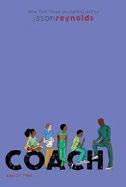
A n origin story for the man who provides wisdom and a sense of cohesion for the young runners who star in Reynolds’ celebrated series. Years before Coach guided the members of the Defenders through hurdles on and off the field, he was a 12yearold boy known as Otie. Otie’s a gifted runner, though impulsive (as his mother says, “Your body’s fast, but your mind don’t always move at the same speed”), and he’s thrilled to learn that the scout who helped his idol, Carl
Gross-out gags split the bill with silly superheroes in this new series.
FANTASTIC FROG AND THE AMAZING TAD LAD
Lewis, make it to the 1984 Olympics four years ago will be arriving soon to assess the talent on his team. His loving parents encourage him—and do their best to keep him away from the influence of the Clippers, a gang that sells drugs in his predominantly Black neighborhood. When his father, who’s frequently away for work, returns with a gift of Jordans, Otie is even more excited, but the cherished sneakers serve as the catalyst for learning difficult truths about his father. Reynolds does a remarkable job of using pop culture references—from Michael Jackson to Back to the Future —to establish a sense of time and place. As always, his command of language is masterly, with crackling dialogue, propulsive plotting, and adroit characterization: Readers will emerge with a rich portrait of the forces that created the man whose mentorship would have a powerful effect on so many young people.
A beautifully executed victory lap for a beloved series.
(Historical fiction. 10-14)
Rimington, Celesta | Nancy Paulsen Books (208 pp.) | $17.99 | January 27, 2026 9780593860304

A boy struggling with his blended family discovers a tree with the power to transform his stepbrother.
Twelveyearold Denver feels unmoored by his 8 yearold stepbrother Harlan, who constantly breaks things and demands attention. When Denver meets Spiro, an ancient ponderosa pine with magical abilities, he accepts Spiro’s offer to temporarily transform Harlan into a tree—only to discover that everyone, including his parents, has forgotten Harlan’s very existence. Denver finds an ally in Mae, a local girl with synesthesia who perceives people through color halos and creates unusual ice cream flavors. As Denver works to reverse the transformation, he learns that Spiro
became isolated from the forest’s root network after surviving a devastating fire, paralleling Denver’s own emotional disconnect from his changing family. The forest setting provides rich sensory details, and Mae’s unique perspective adds depth to the magical elements.
The metaphor connecting tree root networks to human relationships occasionally feels heavyhanded, however, with characters explicitly drawing comparisons that readers might prefer to discover themselves. Denver’s character growth from resentment to acceptance feels authentic, though his transformation happens somewhat rapidly. For the most part, physical descriptors are minimal.
An exploration of family bonds that reaches for profound themes but doesn’t always trust readers to grasp them independently. (author’s note) (Fantasy. 10-12)
Russell, Paul | EK Books (288 pp.) | $12.99 November 11, 2025 | 9781922539953
Series: The Last Seed Keeper, 3
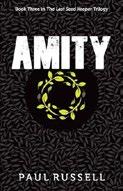
T he older generation’s attempt to save the world brought about an unequal society; now the younger generation has its turn.
The chapters in this trilogy closer alternate between “Then” and “Now.”
In the past, Eden, Hutch, Robert, and Katrina try to build a better world from the ruins of the old one, and Preston and Beatrix scheme to make a profit (Preston, in particular, is willing to take extreme, unforgivable action in pursuit of wealth and power). In the present, Ivy and Skyler follow strange instructions from Dr. Blackwell—“Release the grass seeds. Get them to the Titanic”—at first working behind Eden’s and Katrina’s backs. Eventually the adults realize they’ve made a hash of things and relinquish decisionmaking to the kids. The characters’ worldviews and priorities collide: Some believe Earth can be saved,
while some don’t; some believe in money, power, and violence, others in sharing and collaboration. The “Then” chapters helpfully fill in many blanks in the backstory about the parents of Skyler, Ivy, and Durie and how the world they grew up in came to be the way it is. In the fastpaced “Now” chapters, the characters learn more about recent history and bravely take action to change their world. Are they hopelessly idealistic or courageously determined? The story has a smooth forward momentum that will keep series fans engaged. Characters largely present white.
A satisfying, hopeful conclusion to a futuristic dystopia. (Dystopian. 9-13)
Shaloshvili, Natalia | Candlewick (32 pp.) $18.99 | January 6, 2026 | 9781536248203

Uncertainty threatens both a playdate’s success and a new friendship. In spite of her mother’s enthusiasm, Sasha, a timid lupine creature, isn’t so sure about attending a scheduled playdate. Attempting to beg off, she says, “I just want to play with you, Mommy,” to no avail. When they arrive, Leo, a frenetic firecracker of a rodent, immediately proposes a series of playful adventures. They could be chefs! Or rock stars! Or astronauts! With each invitation, Sasha is sorely tempted to join in, her imagination conjuring up incredible extrapolations from Leo’s offers. When she refuses to engage, though, Leo is crushed: “You really don’t want to play with me.” It’s only when Sasha explains how she feels that it’s revealed that both kids are shy; they just show it in different ways. Cleverly, Shaloshvili makes clear that some little ones shut down when they feel overwhelmed while others cope by becoming more boisterous. Her acrylic paints and watercolors deftly reveal every emotion felt by the characters without sacrificing a jot of their fuzziness. Sharp eyed youngsters may even spot a small, circumspect frog
who acts as an avatar for whatever Sasha thinks or feels. Gentle advocacy for the introspective that adeptly models empathy for shyness of all stripes. (Picture book. 3-6)
Shapiro, Esmé | Tundra Books (48 pp.) $18.99 | March 17, 2026 | 9781774885659
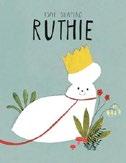
A pampered pooch yearns to explore the world beyond his garden. All hail Prince Ruthie, who enjoys pancakes for breakfast, wears sparkly butterfly clips, and lives in a “castle” (a modest brick house) with a doting queen, a paleskinned woman with platform sandals, unshaven legs, and poufy gray hair coifed in a matching style to Ruthie’s. Although Ruthie adores living in luxury with his queen, is her protective pampering holding him back from adventure beyond the castle walls? When the opportunity to escape presents itself, Ruthie sets off to find out what royal surprises await in the forest beyond his garden. But it soon becomes clear that the real world is different than his home—and certainly smellier—and Ruthie discovers that the animals he meets aren’t quick to obey his royal commands. The journey home to his queen is full of quirky encounters, each animal’s dialogue begging to be read aloud in its own silly voice. Young fans of the fancier things in life will enjoy Ruthie’s princely observations and will be tickled by his goofy personality (and facial expressions). Both text and
the stylized, mixedmedia art, which often contradict each other to delightful effect, are packed with charmingly odd details; this is a celebration of authenticity and friendship not to be passed up. Be sure to keep an eye out for a familiar fox friend from Shapiro’s Ooko (2016) throughout.
An eccentric royal adventure that will leave youngsters smiling. (Picture book. 3-8)
Short, Jackie | Illus. by Lucy Pickett Red Comet Press (32 pp.) | $14.99 March 10, 2026 | 9781636551715
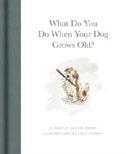
Short considers the greatest gift we can give our pets: loving and supporting them as they age.
“What do you do when your dog grows old? // When their feet are tired and their pads are worn.” This tenderhearted picturebook poem considers the shifting dynamics between owners and their elderly pets. One of the greatest sorrows of owning animals is watching them grow old and eventually die, but Short, who crafted this text while reflecting on the time she still had left with her beloved service dog, urges readers to embrace their aging fourlegged friends: “You love them. // You rub the feet that carried them by your side. // You praise them louder and harder; you show them your pride.” Each line is accompanied by an expressive watercolor illustration of a dog, set against a splash of color in
front of a stark white background. Pickett depicts a variety of breeds, many with white or gray muzzles, resting or playing, all sweetfaced and winsome. Author and illustrator have created a sentimental, straightforward tale to buoy anyone who’s ever confronted a pooch’s demise. While some may find the story on the schmaltzy side, parents seeking books to share with youngsters about older pets will find comfort in the tender, uncomplicated sentiments expressed here—as will many adults. A simple, uplifting look at the emotional realities of loving an aging canine companion. (author’s note) (Picture book. 3-6)
Sitja Rubio, Cristina | Trans. by Cristóbal León | Kids Can (44 pp.) | $21.99 October 7, 2025 | 9781525313806
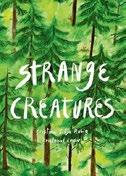
Natural habitats and the constructed world clash in an imaginative conflict.
A cluster of critters, content in their sylvan surroundings, notice a poster alerting them to a party and happily decide to attend. Bears, bunnies, foxes, and birds in party hats dance and eat cake, but when the celebration’s over, it’s really over. Upon returning to the forest, the animals find that their trees have been razed for timber! In their place are mountains of humanmade detritus. The animals try to repurpose this tangle of old chairs, televisions, and other castoffs, ominously etched in red lines, into shelters, with little luck. They resort to retaliation, enlisting assistance from the humans’ small guardians (their pets) to get their people to attend a party. The wild animals reclaim their homes while the humans are making merry, finally sparking understanding and working out their issues with a treeplanting truce. Visually, this Portuguese import is lovely—playfully paced and gleefully odd. Animals ascend a surreal trash heap, humanoid
rabbits gnaw fruitlessly on shoes, and a bear dons a terrifically terrifying human mask. The intentionally offkilter look of the watercolors and shaky pencil lines recalls Maira Kalman’s whimsically absurd style without mimicking her. The narrative struggles by comparison, resolving the challenges of conservation with a clean cut conclusion that simplifies a very real problem, falling short of the book’s visual expansiveness. A stylish, strange story with a somewhat overly simple conclusion. (Picture book. 4-8)
Slater, Dashka | Illus. by Laura Hughes Candlewick (33 pp.) | $18.99 April 7, 2026 | 9781536233377

New things can be scary, but they also contain the potential for unexplored fun.
Kayla, who narrates this tale, is thrilled to be visiting the beach. Equipped with a swimming tube shaped like a pink dolphin, the youngster cheerfully bobs in the water until a jagged shell pierces the tube. Kayla’s relegated to the sidelines, but Daddy gently coaxes the child into the water. The waves are rough, but swimming feels less scary when Kayla visualizes the two of them as various aquatic pairs: “You be a rock…and I’ll be a basking seal.” “You be the harbor…and I’ll be a fishing boat.” With more encouragement from Daddy, Kayla grows in confidence and even feels empowered to swim independently in the ocean blue. Following the same family from their previous work, Wild Blue (2023), Slater and Hughes have crafted another lovely look at the unease of trying something unfamiliar—and the joys of finally triumphing. Slater’s lyrical, firstperson text centers Kayla’s emotions and sensory experiences (“the deep blue sea touches my toes with frothy fingers”), while Hughes’ expressive acrylic ink illustrations
capture the unpredictability of both childhood emotions and of ocean waters with their crashing waves, as well as the gentle stillness that pervades the tale as Kayla enjoys an undersea dive. Kayla and the family are tan skinned; an older family member uses a cane.
A playful, empathetic look at a common first childhood experience. (Picture book. 4-7)
Tentler-Krylov, Victoria | Abrams (40 pp.)
$19.99 | March 3, 2026 | 9781419756696

With rare verve, a trained architect surveys some of the innovative and ingenious ways that 13 cities worldwide are making themselves greener and coping with changing climate conditions. As noteworthy for the lush, lively illustrations as for the initiatives and projects that they depict, this overview offers a range of successes both large and small that are bound to get wouldbe urban designers’ creative juices flowing. The book opens with views of gardens planted on the tops of buses and bus stops and on tall buildings in Singapore and closes with a look at skyscrapers made of laminated timber going up in Vancouver. In between, TentlerKrylov highlights a floating park made from recycled litter in Rotterdam, huge gates that rise up in the lagoon of Venice to minimize storm flooding, and a park landscaped to divert floodwaters in Bangkok away from
streets and into a retention pond to draw on in the dry season. Curious readers will appreciate the frequent smaller inset pictures, which supplement the lucid verbal descriptions with diagrams of internal mechanisms or other hidden details. Nor does TentlerKrylov neglect the human element, adding to nearly every scene colorfully dressed, multiracial crowds of pedestrians or crews of busy workers. Stimulating glimpses of local solutions to widespread and increasingly pressing environmental issues. (author’s note, bibliography) (Informational picture book. 7-10)
Theule, Larissa | Illus. by Teagan White Viking (32 pp.) | $18.99 | February 10, 2026 9780593528945

A woodland community rallies around a nervous newcomer. A bird lands in Holly the raccoon’s neighborhood, head bent and beak silent. When Holly approaches him, he hops into a hole in a tree, scared to interact. Holly understands: “Life is heavy sometimes.” She responds with instinctual kindness, collecting ribbons, yarn, trinkets, and sticks from other forest dwellers, including a majestic moose, a minuscule moth, and a pair of elegant cranes. Using their offerings, she knits the bird a sweater for warmth and, with help from the other animals,
A playful, empathetic look at a common first childhood experience.
DEEP BLUE
helps him shore up his dwelling. As winter descends, the animals hunker down in separate homes, missing one another and wishing for spring, which arrives with the gift of the grateful bird’s sweet song. Spare, thoughtful prose accompanies the interactions of playfully imagined, cozily dressed animals. Seasonal transitions are reflected in falling leaves and bare branches but appear even more powerfully in shifting shades of sunlight. Late autumn is a hazy blue orange, winter a palette of brittle pink, and the spring sun’s goldenpeach emergence communicates a visceral sense of relief to readers. The message of a community’s strength, even in isolation, echoes expressions of Covid19 era solidarity, but the hope and care each loving interaction exudes has a timeless quality, too. An enduring reflection on seasons of togetherness and separation, in nature and in life. (Picture book. 3-8)
Kirkus Star
Thomas, Isabel | Illus. by Daniel Egnéus
Bloomsbury (48 pp.) | $19.99 January 13, 2026 | 9781547618200
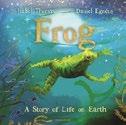
Thomas and Egnéus explore the history of the universe through an appealingly simple lens: a single frog.
As a tanskinned child observes frog eggs in a pond, Thomas poses a fundamental question: “Where did the first frog come from?” What follows is an extraordinary journey backward through billions of years, from the Big Bang through the formation of stars, the creation of our planet, the emergence of life, and evolution’s long march toward amphibians. Thomas’ poetic text maintains scientific accuracy while remaining comprehensible, explaining complex concepts such as atomic formation and cellular evolution without overwhelming youngsters. The refrain “but there
were no frogs yet” provides both structure and a sense of anticipation as readers follow the progression from cosmic dust to living creatures. Egnéus’ illustrations are stunning, moving seamlessly from swirling galaxies and exploding stars rendered in deep blues and fiery oranges to microscopic life forms dancing in jewel tones. His mixedmedia approach combines painted textures with digital elements, creating images that feel both scientifically grounded and dreamlike. The book beautifully circles back to modern frogs, connecting their life cycles to the entire cosmic story. Like the duo’s previous collaboration, Fox (2021), this work uses a familiar animal to illuminate profound concepts, though here the scope expands from life cycles to the universe itself. While ostensibly about frogs, this is fundamentally a creation story for the scientific age.
An awe-inspiring introduction to cosmic evolution that makes the universe’s story feel both intimate and infinite. (afterword) (Informational picture book. 4-8)
Thomas, Peggy | Illus. by Tonya Engel Calkins Creek/Astra Books for Young Readers (40 pp.) | $19.99 January 27, 2026 | 9781662680892
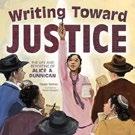
A thoughtful account of Alice A. Dunnigan (1906 1983), the first Black female journalist to receive Capitol press credentials.
Growing up in Kentucky, the daughter of a sharecropper, young Alice railed against injustice such as segregation, but upon realizing that no one could “care about something they didn’t know was going on,” she vowed to fight through the written word. In clear, passionate language, Thomas follows Alice’s journey from child writer to
educator to poorly paid but resolute reporter. Committed to telling stories that white journalists weren’t, Alice received a press pass, a major feat. After a chance encounter allowed her the opportunity for a candid interview with President Truman, Alice was recognized as a tireless voice for the “countless people [who] struggle.” An author’s note reminds readers that “a book can never hold a person’s entire life,” but Thomas’ choice to focus on Alice’s pioneering career keeps the plot tight. Specific dating would help clarify the timeline, since generic allusions like “a dark cloud loomed over the nation” (likely referring to the Great Depression) could be potentially confusing to a young audience. Engel’s impressionistic backgrounds painted with acrylic and oil glazes accentuate graceful portraits, and luxuriously bright colors make the work feel less like a historical piece than a celebratory retrospective. A word representing a core tenet of Alice’s success is spelled out in each illustration; the subtle artistic placement is nifty. A timely reminder about the power of words. (author’s note, timeline, list of other noteworthy women, bibliography, photos, picture credits) (Picture-book biography. 7-10)
Thompson, Alexandra | Putnam (40 pp.) | $18.99 | February 24, 2026 9781984813244
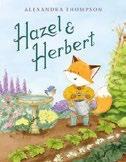
A young anthropomorphic fox is surprised when the egg she’s planning to eat for breakfast produces a feathered friend. Before Hazel takes home the egg she finds lying under a bush, she looks for its nest. That thoughtfulness infuses this sweet story, as do gentle humor and perfectly complementary watercolor art. When Hazel can’t find a nest, she takes the egg home, where her bespectacled, aproned father readies a frying pan for her favorite breakfast, softboiled egg with “sourdough
soldiers.” Just then, the egg—cushioned in a cloth on the countertop—suddenly cracks open. “A baby bird stared up at Hazel. Well, this was inconvenient. How was she supposed to dip her soldiers in that?” Hazel’s unenthused when Papa says the bird will stay with them, but she rallies when given the chance to name him: Herbert. A series of adorable illustrations, paired with succinct text, depict Herbert as a loving but often irritating younger sibling to Hazel’s flattered but beleaguered big sister. After Herbert accidentally ruins Hazel’s artwork, she shouts, “I WISH YOU WOULD JUST GO AWAY!”
The text switches briefly to Herbert’s point of view when, late that night, he sorrowfully follows Hazel’s heated suggestion. The next day, Hazel’s relief at finding Herbert gone swiftly turns to worry. Eventually, Hazel and Papa head outside in yellow slickers as they search a raindrenched forest for the runaway. The warmhearted ending reinforces the idea that friendships are complicated, conciliatory, and ultimately gratifying. Unfailingly tender. (Picture book. 4-8)
Tinn-Disbury, Tom | Random House Studio (32 pp.) | $18.99 | February 17, 2026
9798217122448

Despite disasters and detours, hapless homebody Duck is determined to do his greatgranduck proud and tackle adventure headon.
Though his great granduck encourages him to “spread [his] wings” (the first of many birdrelated puns), Duck seems destined to fail. In three quick panels, the thirdperson narration makes it clear that despite good intentions, Duck generally doesn’t follow the wise advice of his elder: “Pay attention.” “Don’t panic.” “Stay positive.” Accidentprone, anxious, and emotionally volatile, Duck doesn’t seem like a great fit for the Feather Force Delivery Service. Still, he lands a job there and
Exceptionally strong: delivers thrills and chills in equal measure.
THE CLAIMING
immediately tackles his first assignment. Given the pleasantly predictable plot, readers won’t be surprised when things go wrong, but that won’t prevent them from cheering Duck on as coincidence, luck, and some unbelievably speedy skiing enable him to meet his goal. The journey is clearly the point, and Duck’s circuitous route provides plenty of silliness and laughs. Flat, cartoonstyle illustrations amplify the humor of the exaggerated action and include details that add to the fun. (Don’t miss the shopping snail who reacts with shock to Duck’s tantrum in the grocery store—a tiny but hilarious detail.) The font has a loose, handdrawn look that matches the conversational tone of the tale, but it’s occasionally difficult to read when placed against some of the darker colors.
Young listeners will quack up at this put-upon hero’s antics. (Picture book. 4-7)
Warga, Jasmine | Illus. by Naomi Franquiz Scholastic (240 pp.) | $17.99 | January 6, 2026 9781546162841 | Series: The Last Resort, 2

This sequel dives right in where Erin Entrada Kelly’s series opener, The Last Resort (2025), concluded, with Teddy, Lila, and Caleb facing off against a murderous spirit known as the Fire Maiden. Shifting from Lila, the thirdperson narration in this entry centers
on Teddy’s point of view. He and Lila will soon be starting seventh grade at Castle Hill Middle School; Lila’s math whiz brother, Caleb, will be in fourth grade. Though he’s deeply knowledgeable about the supernatural from hanging out on his favorite forum, Phantom Hunters, real life proves more difficult for Teddy, who has a hard time fitting in at school. When popular girls befriend Lila, who arrived in Castle Hill over the summer, Teddy is left wondering how he now fits into her life. Plagued by recurring nightmares from past trauma, Teddy soon realizes that many locals who have family ties to the 19th century circus fire involving the Fire Maiden may be at risk. The danger grows as Halloween draws near, and Lila’s new friends plan a seance at her parents’ haunted inn. Newbery Honor winner Warga’s imaginative installment is eerily delightful, skillfully balancing the angst of tween friendships and the sheer creepiness of ghosts. Franquiz’s haunting illustrations are interspersed, marking points where readers can use their smartphones to interact with the ghosts. Teddy is Jordanian and implied white, and the previous book established both Lila and Caleb as Filipino and white. Exceptionally strong: delivers thrills and chills in equal measure.
(Paranormal. 8-12)

Kirkus Star
Troubled Waters: A River’s Journey
Weatherford, Carole Boston | Illus. by Bryan Collier | Bloomsbury (40 pp.) | $20.99 January 20, 2026 | 9781681198187
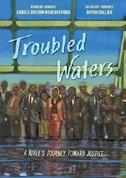
The Alabama River tells its story—a tale as long and wide as the waterway itself. Reminiscent of Langston Hughes’ The Negro Speaks of Rivers, illustrated by E.B. Lewis (2009), this elegantly wrought, firstperson telling is both human and natural history. Lines from Negro spirituals that sing of rivers, like “Wade in the Water,” appear between Weatherford’s stanzas in a scriptlike font. The Alabama describes its size (“318 miles long, fifty to 200 yards wide, / and from three to forty feet deep”) and notes that its Choctaw name means “Thicket Clearers.” It also recalls enslaved Africans hiding in its waters as they sought freedom and the Cherokee people who passed its banks on the Trail of Tears. Throughout, Collier’s signature collage illustrations add richness, depth, hope, and light to the river’s weighty story. Weatherford never flinches from the horrors of oppression: victims of lynching thrown into the river, civil rights protesters beaten as they made their way across the Edmund Pettus Bridge on March 7, 1965. But Collier’s paintings emphasize Black and Native Americans’ determination to survive and triumph. The inclusion of blue spheres—a motif that pops up in many of the illustrator’s works—suggests that the downtrodden, like air bubbles, will rise. Weatherford’s extensive historical
timeline will give budding historians much to consider and research further. A gorgeously illustrated, truthfully told history that no collection should be without. (Informational picture book. 8-12)
Kirkus Star
Barbed Wire Between Us
Wenjen, Mia | Illus. by Violeta Encarnación Red Comet Press (48 pp.) | $19.99
March 31, 2026 | 9781636551920
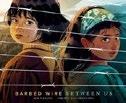
Japanese Chinese American author Wenjen and Cuban American artist Encarnación have created a sobering, stupendous reminder of recurring injustice.
Wenjen’s reverso poem “tells a story in verse, and then uses the same phrases, but in reverse, to tell a different story.” “In this land of promise, / we hoped to find a place to belong,” she opens, a promise betrayed by the U.S. government’s ignominious World War II imprisonment of Japanese Americans. The Japanese American story ends with release—“From behind barbed wire, new life will begin”—pivoting into the journey of new migrants crossing borders in search of new opportunities. But history repeats itself as they, too, are imprisoned behind barbed wire, even as they continue to cling to the potential of a “place to belong.” In the backmatter, Wenjen reveals that the setting is Fort Sill in Lawton, Oklahoma, which for roughly 150 years has been the site of unjust incarceration: Chiricahua Apache tribe members in the 1880s, Japanese Americans during WWII, and separated immigrant children since 2014. Encarnación affectingly balances looming fear and
violence with quotidian joy (kids jumping rope, playing baseball, and listening to storytimes). She integrates folded cranes, a Japanese symbol of hope, into vibrantly saturated spreads—the contemporary protagonist even discovers a WWII newspaper crane. Small details, particularly the chipped blue nail polish on a child’s bandaged hand, add wrenching realism. A significant portrayal of ongoing U.S. civil rights violations, exposed through the experiences of young children. (historical note, definition of reverso poem, author’s note) (Picture book. 7-10)
Kirkus Star
Westera, Bette | Illus. by Henriette Boerendans | Trans. by David Colmer Eerdmans (56 pp.) | $18.99
February 17, 2026 | 9780802856524
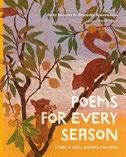
In this Dutch import, Westera presents 16 seasonally arranged poems representing 13 separate verse forms. Each section begins with a scenesetting haiku, nestled against four repeating, multicolored woodcut spreads whose farmhouse, field, pond, and trees reflect seasonal changes. Westera employs traditional and modern forms and invents one herself: the stacking poem, “in which words are stacked upon each other.” The four haiku embody the Japanese form’s crystallizing turns of phrase and traditional focus on nature. “Ice forms on the pond / It can grow thicker or thaw / Winter will decide.” The rondel, the pantoum, the tanka, and the sonnet all appear, reflecting poetry’s crosscultural roots. Playful modern forms include the double dactyl (invented in 1951 by two American poets) and the diamante, a diamondshaped form created by another American, Iris Tiedt, in 1969. A Dutch form, the elevenie, is just as it sounds: 11 words in a specified sequence. (In a note, translator Colmer explains that, in consultation with Westera, he substituted certain forms, such as December’s
limerick, for those less familiar to Englishspeaking readers.) April’s “Spring Fever” is an acrostic whose lines’ initial letters spell “Vincent Van Gogh.” The middle stanza reads “Velvety bees / Attack the almond blossom, / Nectar sweet as honey.” Boerendans’ facing woodcut is a distinctive homage to Van Gogh’s Almond Blossoms, and her work throughout is masterful. The book’s design is innovative, while the verse is thoughtful and immersive. A remarkable collaboration. (information on verse forms) (Picture book/poetry. 5-9)
Yang, Kao Kalia | Illus. by Seo Kim Carolrhoda (32 pp.) | $18.99 February 3, 2026 | 9798765619858
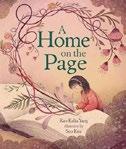
A fter a shattering racist incident, a Hmong American girl defines her own sense of home.
A vicious message scrawled on the mailbox, “ASIANS GO HOME,” understandably upends Nou’s sense of safety. She watches her mother’s failed attempts to wash off the angry words; her father then covers the letters with white paint. Nou longs to go to “a place where people want us,” but Dad quietly reminds her that “America is your home.” Their people, the Hmong, “have no country,” Nou knows. Dad finds home in his songs, Mom in her garden, big sister Houa in her Fourth of July soccer tournament and in Hmong New Year, and Pog Pog (Grandmother) in the traditional story cloths she sews. Microaggressions at school further alienate Nou: “The words people say weigh me down,” particularly the “Eeewww. Gross” reaction to the delicious zaub nyoj she brings in for lunch. Her own search for home takes shape on the page, “a place where I am accepted.” In filling her notebooks, “little by little, I create a place where I belong.” Yang and Kim have reunited after collaborating on A Map Into the World (2019), the book visible on Nou and Houa’s nightstand. Kim’s zoomedabove perspectives for numerous spreads are clever reminders to
take a wider view beyond difficulties. Her artful adaptations of the “fantastical things” Nou depicts in her notebook release wondrous swirls of healing energy. Nou’s community is diverse. A resonating, inspiring story that encourages creative resilience and strength. (author’s and illustrator’s notes, glossary with pronunciation guidance) (Picture book. 5-10)
Yaskina, Natalia | Flying Eye Books (40 pp.) $17.99 | January 6, 2026 | 9781838740603
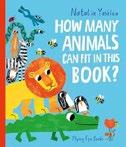
There’s just enough room in this counting book for one ant, but a bevy of animals manage to squeeze their way in, too.
As the story opens, the ant prepares to bite into a delicious apple. “You want to know how many animals can fit in this book?” our diminutive protagonist asks. “I’ll tell you. This book is perfect for 1 ant!” Suddenly a lion pushes its paw in: “2 lions can fit in here, too!” Despite the ant’s reservations, the big cats stick around. Along come three crocodiles, four zebras, and five meerkats. Finally, 10 ladybugs shove in, and the ant shouts, “That’s ENOUGH!” The ant bites one of the lions, the bustling scene is cleared as the other animals are frightened away, and the ant is alone again. Readers will love the clever ending, in which the ant decides to find an empty, quiet book, and the crew of animals lumber along, too. Yaskina’s simple illustrations serve the dual purpose of engaging little readers in a seekandfind while also encouraging counting practice. The animals appear in different positions, running, prancing, and hopping with each turn of the page. All have simple block coloring and a twodimensional appearance; their wide eyes have black centers. Ripe for rereading, the text follows a predictable, repeated pattern of question and answer that’s pitchperfect for the toddler crowd, while the contrast between the curmudgeonly ant and the
blissfully unaware animals is laughoutloud funny.
Playful and silly. (Picture book. 2-4)
Yoon, Jessica | Illus. by Michelle Lee
Make Me a World (40 pp.) | $18.99
February 3, 2026 | 9798217027262
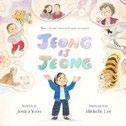
After learning a Korean word that doesn’t easily translate into English, a young girl explores its meaning with her grandmother. As Luna helps her toddler brother, Joey, put on his boots, Halmeoni (Grandmother) compliments her using the word “jeong.” Luna doesn’t understand, and Halmeoni doesn’t quite know how to explain the term. In her author’s note, Yoon states that jeong is “rooted in collectivism—a cultural belief [that] everyone in the community is connected and looks out for each other.” Heavy stuff, but she finds childfriendly ways to convey the concept to her young audience. At the park, Luna chases down a family to return a toy that their young child has dropped. She shares the last of her cookie dough with Halmeoni and gives her mother a thoughtful gift. All are examples of jeong—actions that reflect kindness, connection, and understanding. She realizes that jeong is also her feeling of homesickness when Halmeoni reminisces about her homeland—a place Luna’s never visited but dearly loves all the same. Jeong is connection with “family and strangers, with home and places unknown, with things as common as a blanket or as unique as Korean culture.” As Yoon takes great care to clarify this word, Lee fills the pages with gentle, pillowy illustrations that evoke a sense of tenderness. Korean symbols along with Korean phonetics appear, opening up the world of translation to readers. In this empathetic work, small acts of kindness crystallize into a rich understanding of Korean culture. (notes from the author and from Make Me a World founder Christopher Myers) (Picture book. 3-8)
WHY SHOULD TEENS read nonfiction? We hear a lot about how reading fiction promotes empathy (which is, of course, important). But equally valuable are the critical thinking and comprehension skills that nonfiction cultivates— skills that everyone needs to possess in order to participate in community life in an informed and responsible way. Between homework and extracurriculars— not to mention socializing, gaming, and smartphones—teens have less uninterrupted time than ever before. How do you get an overscheduled teen to read nonfiction that isn’t assigned by a teacher? Two things help: Offer them a book on an intriguing, attention-grabbing topic and make sure it’s one that
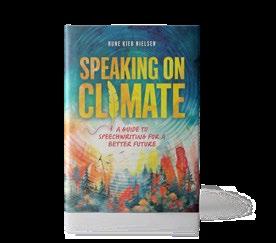
they can dip into and read in small chunks.
The following books cover a wide range of subjects, but they share a combination of accessible language, visually appealing design, and formatting that works equally well for reading cover to cover or browsing as time permits.
Climate change is an overwhelming and terrifying topic, but Rune Kier Nielsen—a Danish speechwriter, anthropologist, and global climate expert— helps readers learn how to effectively channel their concerns in Speaking on Climate: A Guide to Speechwriting for a Better Future (Zest Books, April 15). This handbook for persuading others to join you in taking action is concise, practical, and thorough, while teaching broadly applicable skills.


In Ban This!: How One School Fought Two Book Bans and Won (and How You Can Too) by Christina Ellis, Renee Ellis, Edha Gupta, Ben Hodge, Patricia A. Jackson, and Olivia Pituch (Zest Books, September 16), readers learn the inspirational story of one successful community effort to stop censorship. The authors— teachers and former students from the Pennsylvania school district in question— share their template for organizing young activists in a slim, well-structured, and compelling package.
Creating an inviting, globally focused, centuriesspanning work is a remarkable feat, and Black History for Every Day of the Year, written by David Olusoga, Yinka Olusoga, and Kemi Olusoga, with illustrations by Kemi Olusoga (The Experiment, September 30), introduces readers to a rich array of individuals, events, movements, and cultural phenomena. Anyone who picks it up will learn


something new, and the interplay among subjects supports readers in making deep, nuanced connections.
Fascinating Fungi: Nourishers, Killers, Connectors, and Healers by Karen Latchana Kenney (Twenty-First Century/ Lerner, October 7) is an original, multidisciplinary work featuring dramatic color photos that will pique the curiosity of a broad readership. From therapeutic uses of psilocybin for mental health to training your dog to hunt truffles, experiments with plasticeating mushrooms, and the poisoning of the Roman emperor Claudius, this work contains a plethora of fascinating tidbits.
An anthology honoring the 10th anniversary of Shout Mouse Press compiles works by teen workshop participants, helpful writing prompts, excerpts of works by YA authors, and reflective conversations on craft. Bright Before Us, Like a Flame: Igniting a New Generation of Writers, edited by Sasa Aakil and Kathy Crutcher (October 8), offers teens— whether they aspire to write professionally or just want to better express themselves for their own satisfaction—a supportive, celebratory guide.

Laura Simeon is a young readers’ editor.
Hoping for sanctuary, a teen assumes another’s identity. When a 16-year-old queer runaway is brought in for shoplifting, he spots a missing-person flyer for a child named Nathaniel Beaumont, and something clicks. Buoyed by his uncanny resemblance to the image that’s been age-progressed to show what the boy would look like today, he decides to borrow “Nathaniel’s name, just for a bit.” He’s conflicted about the lie, but he doesn’t want to go to jail—or worse, be returned to the parents who were about to send him to conversion therapy.
After their blood types prove to be a match, the Beaumont family brings home to Chesapeake Bay the son who’s been missing for nearly a decade. Nate’s mother is overcome with joy, but his father and brother are skeptical. Miles, the cute neighbor who has a true crime podcast, knows right away that the new arrival isn’t the actual Nate, and the boys make a deal to work together to find out what really happened. As their bond deepens and they fall for each other, increasingly disturbing events occur. This thriller calculates the costs of denial, propelling

the story to its dangerous, page-turning edge—and readers won’t be able to look away. At the novel’s heart is unconditional love, which even in the face of questionable morality offers a salve that heals broken people. Major characters read white.
A grisly, unflinching, and twisty page-turner that takes an honest look at human nature. (Thriller. 15-18)
Katie Bernet
Erik J. Brown
Jumata Emill

Teens will be engaged by this fast-paced and suspense-filled page turner.
Apelian, Robert Mgrdich | Penguin Workshop (304 pp.) | $25.99 | $17.99 paper
January 20, 2026 | 9780593658895 9780593658901 paper
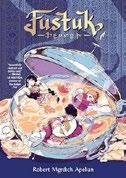
Seventeen-yearold Katah lives in the Pars Empire, in a family whose dynamics center around cooking—something he has little talent for or interest in.
Katah’s Hye family is part of a marginalized minority. His late father was a much-lauded chef, and older brother Garo clings to his traditional Hye recipes, while older sister Noori embraces Pars cuisine. Katah feels caught in the middle of this strained relationship. When their mother falls ill and Katah’s vivid dreams lead him to unearth a magical creature called a div, a chain of events is set off that forces him to confront his family history and find a way to heal their fractured present. This visually rich graphic novel inspired by Armenian and Persian mythology explores memory, identity, and cultural inheritance through food, magic, and family ties. Apelian’s worldbuilding is ambitious, but early chapters offer little orientation, which may challenge readers. Once the narrative finds its rhythm, however, it’s easy to be swept into the siblings’ relatable squabbles and affection and Katah’s arc of self-discovery. Each chapter is titled after food, and the siblings’ culinary choices offer a metaphor for their relationships to their heritage. The art is the standout feature: The carefully controlled palette guides readers through shifting timelines while
decorative panel borders add to the magical element of Katah’s visions. A heartfelt, visually inventive debut that captures the complexities of cultural heritage and the desire to belong. (content warning, map, author’s note, glossary) (Graphic fantasy. 12-18)
Aristeo, Mariposa | Enclave Escape (272 pp.) | $24.99 | November 18, 2025 9798886052343 | Series: Chronicles of Twinsbane, 1
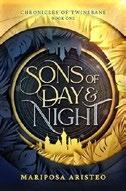
In the country of Twinsbane, everyone believes that King Daccias is the “only living soul without a twin.”
But is he really? Fifteen-year-old Waruu, an orphan who’s part of a group of Separatists, is also sure that he doesn’t have a twin. Twins’ fates are intertwined: If one dies, so does the other. The people of Twinsbane want to sever this connection and live freely. Two hundred years ago, King Langhorne used a potion called the Separator to ensure that kings don’t have doubles. Waruu is trying to steal the Separator when, by chance, he stumbles across a painted portrait of the king hanging in the castle. To his shock, they’re each other’s Night and Day doubles. With help from fellow Separatists, Waruu kidnaps the king and takes his place. But when the deadly Midnight Plague reaches Twinsbane, the situation becomes desperate. Waruu’s running out of time to save everyone. Can he convince King Daccias to tell them
where to find the Separator? In a kingdom shaped by secrets and folklore, uncovering the truth is the only path to freedom. Debut author Aristeo’s worldbuilding is solid, and her characterization has depth, with both primary and secondary characters having believable motivations for their actions. Daccias and Waruu, both cued white, alternate narrating this action-packed, mystery-filled story. A great beginning to a new fantasy series that explores what divides and connects us. (map) (Fantasy. 13-18)
Barnes, Jennifer Lynn | Little, Brown (432 pp.)
$20.99 | July 29, 2025 | 9780316481311
Series: The Grandest Game, 2

Romantic and familial bonds are strained as the next phase of the Grandest Game commences with Grayson, Lyra, Savannah, Rohan, and Brady competing for the win. Picking up directly from the events of the last book, this sequel to The Grandest Game (2024) hits the ground running. As the competitors race to the finish line, newfound allies and dueling loyalties are tested, especially as the final five weigh the possibilities of their budding connections against their own complex motivations, which include power, money, settling scores, uncovering the truth about the past, and protecting loved ones. Complicating the competition are unknown outside forces—people with ulterior motives who continue to try to influence the outcome. Under the watchful eyes of their hosts, the Hawthorne brothers, and the heiress Avery Grambs, the contestants navigate an increasingly dangerous and high-stakes game that’s powered by machinations beyond their understanding or control. Despite a dark throughline of family secrets, grief, and revenge, the story is brought to
life through alternating points of view and lightened by Barnes’ signature humor and witticisms. Readers will love working out the next puzzle alongside the characters as each action-packed chapter provides new clues, red herrings, and a tangled web of mysteries and motivations. The first book coded most main characters as white, and cued Rohan as South Asian and Brady as Black. An absorbing sequel that revives the thrills of its predecessor while hooking readers for the next entry. (Thriller. 14-18)
Kirkus Star
Beth Is Dead
Bernet, Katie | Sarah Barley Books/Simon & Schuster (400 pp.) | $19.99 January 6, 2026 9781665988698

High school junior Beth March is dead, but not from the effects of scarlet fever. Instead, at the start of this modern Little Women –inspired novel set in Concord, Massachusetts, the “doe-eyed” Beth appears to have been murdered. Everyone is a suspect (until they aren’t) in this twist-filled tale told from the perspective of each of the white-presenting March sisters: Meg, a Harvard student; Jo, a writer with big aspirations; misunderstood high school sophomore Amy; and even gentle, musically gifted Beth herself. Fans of the Louisa May Alcott original will appreciate the presence of supporting cast members like Sallie Gardiner and the Hummels even as they wonder which of the characters they know well is capable of homicide—including the March sisters’ bestselling author father, who’s cancelled for his tell-all coming-of-age novel about them and goes into hiding. The book thoroughly explores the characters’ possible motives, from jealousy to the quest for fame. In
addition to the four narrators, the story moves between the past and present in shifts that could be dizzying, but debut author Bernet makes it work. She does a masterful job of preserving the distinct personalities and ambitions of the classic characters, transporting them to a contemporary setting and making them fresh and relevant for today’s readers. Even teens who don’t know Little Women will be engaged by this fast-paced and suspense-filled page turner.
A thrilling take on a beloved story that will keep readers riveted.
(Thriller. 12-18)
Bonin, Caroline | Feiwel & Friends (352 pp.) $19.99 | January 13, 2026 | 9781250384614
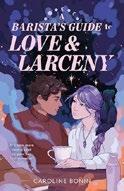
A college student grapples with her unusual magical powers as she tries to pull off a heist against a shady corporation. A first year at the magical Fox’s Leap University, purple-haired Dani Lionet is a typical student in many ways: She works as a barista to supplement her partial scholarship, and she likes a boy who comes to visit her at the coffee shop. But she’s hiding a secret. Throughout her life, other people have shared more information with her than they meant to. Because her parents used her ability to aid their cons and scams, Dani has become petrified by the thought of others finding out about her powers. But when a visiting professor from Italy picks up on Dani’s ability, she doesn’t report or blackmail her; instead, Professor Silva recruits Dani to investigate OneiroLabs, a company that manufactures magical sleep aids—and whose new product may have dangerous side effects. At first, Dani’s happy to help—but as she gets drawn further into the operation, and as Silva increases the stakes by wanting to steal the product’s formula, Dani
must decide how far she’s willing to go. Although some readers may find the worldbuilding shaky and the ending wrapped up a tad too neatly, Dani’s abilities provide an interesting moral quandary as well as a solid vehicle for the author to explore agency and free will under capitalism. Main characters are cued white.
Cute, cozy, and clever. (Fantasy. 14-18)
Clare, Cassandra | Knopf (464 pp.) | $24.99 December 2, 2025 | 9798217225705
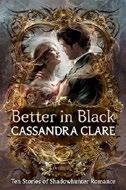
Ten short love stories starring Shadowhunter couples (and one throuple). Clare starts off strong with “The Good Storm,” which brings back the beloved Will and Tessa Herondale of the controversial Infernal Devices love triangle. Their Parisian honeymoon is interrupted when a spell cast upon Will makes him lose all his painful memories but also forget his love for Tessa. Meanwhile, Luke Garroway’s letter to Jocelyn Fairchild in “Who the Wolf Loves” is filled with an incredible yearning that will devastate readers. But there are some fun, action-packed romps, too. “Zachary’s Day Out” follows Thomas Lightwood and Alastair Carstairs as they chase down the latter’s baby brother, who then magically transforms into a middle-aged man, and “City of Broken Hearts” centers on Simon Lewis and Izzy Lightwood, whose bickering is caused by some sort of demonic influence. Clare, a romantasy legend, depicts a spectrum of love stories that are rich in diversity, including the beautiful Sapphic romance between Ari Bridgestock and Anna Lightwood and the iconic polyamorous relationship involving Mark, Cristina, and Kieran. The author even offers a glimpse into the unsettling relationship between the Seelie Queen and Sebastian Morgenstern. Readers who are deeply familiar
with the Shadowhunters universe will enjoy reuniting with many of their favorite characters, who vary in hair, skin, and eye colors. The ultimate fan service for Shadowhunter loyalists. (Fantasy short stories. 14-adult)
Cozzi, Jessica L. | Delacorte Romance (304 pp.) | $12.99 paper | January 13, 2026 9780593904855
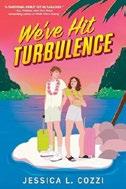
Two former sweethearts are thrown together under awkward circumstances that may give them another shot at love.
High school senior Olive Austin has always had her life perfectly planned, but when her boyfriend, Jack Cameron, starts acting distant, she impulsively leaves New York one week early for her spring break trip to Honolulu, where she’s joining Jack, a freshman at the University of Hawai‘i. She didn’t expect to end up spending the 11-hour flight sitting next to Tyler Ferris, the ex-boyfriend whose heart she broke. Ignoring intuitive, easygoing Tyler becomes impossible, and Olive ends up facing her role in the complex ending of their relationship. Despite this bumpy start to her vacation, Olive makes the most of her stay in Hawai‘i. Although the setting is superficially developed, the narrative is strong in its exploration of the characters and their interactions: Olive and Tyler have a deep connection and they’re interesting together and compelling as individuals. Flashbacks gradually and effectively add details as the story progresses, supporting the characters’ growth, particularly in the case of Olive, who ultimately learns to embrace her strengths and weaknesses. In her debut novel, Cozzi shows how forgiveness can be as beneficial for us as it is for others.
Olive and Jack are cued white. Tyler’s father is from Boston, and his mother is from Maui; it’s unclear whether she’s Native Hawaiian. A second-chance romance that’s elevated by strong character development. (Romance. 12-18)
Davidhizar, Megan | Delacorte (352 pp.)
$19.99 | January 13, 2026 | 9780593705711

In the wake of a family tragedy, a teen puts herself in danger while investigating its cause.
When Ella arrives at her aunt’s house for a last-minute babysitting job, she smells gas and finds her aunt and two cousins unconscious. Ella speaks to a 911 operator and tries to get everyone out before she succumbs to the fumes; she passes out and wakes up in the hospital. In the days that follow, she learns that rather than being a horrible accident, the gas leak was deliberately caused by someone who was intent on murder. As she investigates—with the help of handsome Dominic, who lives in Aunt Julie’s neighborhood—Ella follows a trail of clues that lead in multiple directions, but because her recently diagnosed brain tumor causes symptoms including debilitating migraines and (possibly) hallucinations, she isn’t sure whether she can trust her own perceptions. And when a shocking event requires her to rule out one of her key suspects, Ella’s search for the truth becomes even more urgent.
Employing a medically based variation on the device of the unreliable narrator, Davidhizar’s fast-paced sophomore novel is packed with twists and red herrings and will please fans of Karen McManus, Holly Jackson, and Jennifer Lynn Barnes. Main characters present white. A twisty tale that will keep thrill-seekers riveted.
(educator guide) (Thriller. 12-18)
Davis-Featherstone, Rachael Wednesday Books (320 pp.) | $20 January 13, 2026 | 9781250342300

A prospective Oxford student must solve her best friend’s murder before she becomes the next target. Seventeenyear-old Eva Dawkins, who’s the mixed-race Black daughter of a police inspector, is about to realize her—and her late mum’s—lifelong dream: attending Oxford University. Even better, once she and George Danvers, the white boy who’s her best friend, ace Beecham College’s interview week, they can finally become official and take their relationship to the next level. But George, typically spirited and unbothered, starts acting strangely, even more so after the arrival of rival interviewees from the ultra-posh private school Reapington Manor College. He’s hiding something, but before she can figure out what, Eva finds George dead in front of the controversial statue of the alumnus,
Emill deftly portrays the intersection of race, religion, and homophobia.
I DON’T WISH YOU WELL
an enslaver and sugar plantation owner, that stands in Beecham’s quad. As secrets come to light, Eva starts questioning everything she thought she knew about George. But when the police target her as the prime suspect in his murder, Eva must race to find the truth. The premise is intriguing, but the story stumbles in execution due to the inconsistent and sometimes surface-level writing and onedimensional characters who often feel like they exist in service of the plot. Themes about grief, racism, and classism are underdeveloped, although Davis-Featherstone handles an incident of sexual assault with care. While the story gestures toward dark academia, its core leans more toward Gossip Girl , and readers who like drama may enjoy this. Disappointingly shallow. (Mystery. 13-18)
The Rebel and the Rose Doyle, Catherine | McElderry (528 pp.)
$21.99 | December 2, 2025 | 9781665955140
Series: The City of Fantome, 2

Old flames reunite to unravel a saint’s prophecy in this sultry, explosive sequel. Three months after the events of The Dagger and the Flame (2024), Seraphine Marchant and her friends are secreted away in the countryside, where they’re establishing the Order of Flames. Sera is fearful of the saint-imparted powers that call to her. Her estranged lover, Ransom, has taken over leadership of the rival Order of Daggers, which uses the power of Shade magic to bend shadows to the murderous whim of the highest bidder. With growing unrest directed against the corrupt king and rumors of others imbued with powers like Sera’s, the king brings the rivals together to seek out those with saintly magic and help determine the future of Valterre—and being thrown together rekindles their love. Doyle develops
her rich worldbuilding as the adventure moves beyond the city walls, and the blending of prophecy and divination with a dash of dark academia deepens the fantasy lore. Action sequences and well-timed reveals keep the pace brisk and pages turning with an extensive body count that will challenge the squeamish. The enriched character development infuses the steamy romance with maturity and sincerity. While the dialogue is stronger in this entry, the heavy reliance on expletives feels like a substitute for creative word choices. The conclusion positions the story for a sequel. Most characters are cued white. A thrilling and promising second series entry. (map, character list) (Fantasy. 16-adult)
Emill, Jumata | Delacorte (400 pp.) | $19.99 January 20, 2026 | 9780593811023

Over summer break, a college student researches a series of murders in hopes of recording a podcast. When the brutal killings of four high school football players rocked his small Louisiana town five years ago, the motive the police gave for the attacks didn’t convince aspiring journalist Pryce Cummings. There was a homophobic backlash against the victims’ closeted classmate Deuce— who supposedly carried out the murders to avoid being outed by the victims and then killed himself. This hostility kept Pryce from coming out until he entered historically Black Whitmore University. When new evidence casts doubt on the identity of the Trojan Mask Killer, Pryce convinces Dr. Morrison, Whitmore’s student media director, that investigating the new lead would make a perfect podcast. He’s also secretly hoping that
proving Deuce’s innocence will help convince his own parents to accept his sexuality. Pryce teams up with Izzy, Deuce’s ex-boyfriend, to uncover the truth, but they learn there are more buried secrets than they imagined. The more they dig, the more dangerous the situation becomes, and they have to decide whether finding the truth is worth it. Pryce and Izzy are well-crafted characters; there’s a moving honesty to their experiences as gay Black men. Emill deftly portrays the intersection of race, religion, and homophobia. This complex novel also shines a light on familial abuse, ugly aspects of Southern football culture, and the lengths people will go to maintain their power and privilege. A tense, thrilling mystery featuring two unforgettable queer sleuths. (Mystery. 14-18)
Lost Girls of Hollow Lake
Faubion, Rebekah | Delacorte (384 pp.) $19.99 | January 27, 2026 | 9780593900437
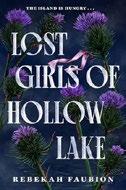
Eight girls sneaked away from their high school field trip. Five came back—and one is telling her story. Eighteen-yearold Evie Williams is supposed to leave her small Pacific Northwest town of Shady Cove for college in Seattle, but events from her recent past keep haunting her, her friends, and other townies. Three months earlier, Evie and some of her classmates left their Hollow Lake National Park campgrounds to explore Dead Refuge Island. Some say the island is “nothing but myth and legend”; no one has ever been able to photograph it, and everyone who sets out to find it disappears or dies. The story unfolds through these alternating timelines (both told in Evie’s firstperson present-tense narration). Shades of I Know What You Did Last Summer and Yellowjackets come through as the current-day girls and other locals (as well as Evie’s beloved dog, Tiger) are
stalked by a mysterious knife-wielding killer, while, in the earlier timeline, the girls struggle to survive and to escape an island that seems to be demanding a sacrifice. Short sentences and breathless declarations try to evoke an aura of suspense and melodrama, but the Mad Woman, a haunting wooden figure that floats menacingly around the island, goes underexplored. The romance between Evie (the white daughter of a sheriff) and fellow survivor Sunny Park (a bisexual Korean American cheerleader) feels tacked-on. Ultimately, the thin worldbuilding and character development limit the story’s deeper emotional stakes.
Atmospheric but not compelling. (Thriller. 14-18)
Gregson, Marc J | Peachtree Teen (528 pp.)
$22.99 | January 13, 2026 | 9781682637081 Series: Above the Black, 3
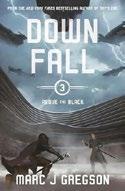
Conrad’s battle against his tyrannical uncle reaches its climax in this conclusion to the Above the Black trilogy. At the end of Among Serpents (2025), King Ulrich of Urwin conducted a brutal purge. Now he’s casting his nephew, Conrad, and 1,000 soldiers who are deemed disloyal into the perilous Below. Presumed dead, Conrad resurfaces under an assumed name, gathering ships, new allies, and old friends as he works toward an inevitable showdown with his uncle. Themes of leadership, sacrifice, and the cost of power thread through the narrative as Conrad grapples with the balance between mercy and strength as embodied by his mother’s pacifism and his father’s warrior ethos. He also relies heavily on the loyalty and quick thinking of his companions, who pull him out of danger time and again. Sebastian makes another appearance as a recurring villain, but his lack of growth renders him flat. The
importance of trust and friendship remains central, with the found family crew providing both comic relief and heartfelt moments. The political purges and tests of loyalty echo contemporary conflicts, lending the fantasy a sharp edge. Unfortunately, the novel is bogged down by its length and pacing issues; too great a percentage of the book is devoted to monster battles in the Below that become tiresome. There’s some racial diversity among the supporting characters surrounding the white-presenting central cast. A fittingly epic but overstuffed finale weighed down by repetition. (Science fiction. 14-18)
Griffin, Rachel | Sourcebooks Fire (448 pp.) $19.99 | February 17, 2026 | 9781728256184

An 18-year-old’s encounter with the pale, mysterious, goldeneyed Starmaker transforms her from hamlet girl to magical apprentice. Aurora Finch discovers she possesses the rare ability to channel sunlight—magic essential to the survival of snow-covered Reverie, her mountain village, “with peaks so high the Sun [cannot] rise above them.” Now she faces a harsh choice: Leave everything behind to train at the Starmaker’s enchanted castle or die as the untapped magic destroys her from within. Griffin excels at worldbuilding; the story is filled with elements and characters that feel both whimsical and real, from Tilly, a living snow angel who’s searching for herself, to Constance, an immortal rabbit. As the antagonism between Aurora and the cold, centuries-old Starmaker melts, their love story, which forms the heart of this tale, crackles with tension. Aurora emerges as a compelling hero—stubborn and brave—who refuses to be diminished by the overwhelming responsibilities thrust upon her. The romantic storyline proves both strong and emotionally involving as the author
brings fresh twists to familiar elements, exploring the power of stories and how they shape our understanding of the world. White-presenting Aurora faces a devastating truth that creates urgency and heightens the emotional stakes that drive the story to its conclusion. This satisfying, sparkling fantasy will capture hearts with its well-developed setting and captivating love story.
A delicious winter romance that shimmers with classic fairy-tale magic. (author’s note) (Fantasy. 14-18)
Horne, Maggie | Feiwel & Friends (336 pp.) $19.99 | January 27, 2026 | 9781250377371

When a revenge plot goes south, a teen must turn to an unlikely ally for help. Tired of feeling invisible, best friends Freddie and Stella hatch a plan to dethrone their former friend turned popular girl, Levi, and prevent her from winning their school’s prestigious scholarship award, which she’s coveted for years. They adopt new “hot girl” personas, weasel their way in with Levi’s friends, and engage in sabotage to bring Levi down. But when Stella takes things too far, Freddie realizes that the plan is spiraling out of control, and she must turn to Levi for help. As Freddie and Levi spend more time together, old feelings between them rise to the surface, and Freddie faces new questions about her friendship with Stella and what she wants for herself. The novel is witty and, delightfully, draws upon beloved movie tropes, which film-obsessed Freddie points out on-page. Freddie’s journey to becoming her own person outside of her friendship with Stella is satisfying and includes a swoonworthy slow-burn romance with Levi. Unfortunately, the ending feels rushed, with all the conflicts neatly (and unrealistically) resolved. Horne
introduces themes of power and privilege but doesn’t fully explore them. Freddie, Stella, and Levi are queer and cued white; there’s some racial diversity among the supporting cast. A fun, banter-filled story about getting revenge and finding love— and maybe yourself—along the way. (Fiction. 14-18)
Jackson, Ketanji Brown | Bright Matter Books (368 pp.) | $20.99 | January 20, 2026 9798217117772

In this young adult adaptation of her 2024 memoir, U.S. Supreme Court Justice Jackson recounts how her lofty dreams became a reality. Jackson, whose African first and middle names, Ketanji Onyika, mean “Lovely One,” was raised to trust in and value the transformative power of knowledge. She is the daughter of parents—an educator and a school board attorney—who emphasized the importance of determination and Black cultural pride. Growing up in Miami in the ’70s and ’80s, Jackson balanced academic excellence with personal development, from piano lessons and public speaking to chess club and creative writing. Her path to the nation’s highest tribunal began after she read a magazine article about Constance Baker Motley, a trailblazing civil rights activist who in 1966 became the first Black woman to serve as a federal judge. Motley’s achievements inspired 11-year-old Jackson and guided her goals through high school, Harvard College, Harvard Law School, two federal clerkships, marriage, and parenthood. When she faced challenges, including battling first-year anxieties in college and the mental and physical demands of Big Law culture, Jackson drew upon her resilience. Narrated with resolve, her story spotlights a journey propelled by duty
This sparkling fantasy will capture hearts with its captivating love story.
THE SUN AND THE STARMAKER
and grit and the navigation of a system that’s inherently stacked against Black women. With clear-eyed authority, Jackson addresses how racism and inequities shaped America’s history; nevertheless, optimism fueled her climb to unprecedented heights.
Self-aware and sincere; a tribute to authenticity, integrity, and faith in a profound vision. (photo credits) (Memoir. 13-18)
Karlie, Logan | Christy Ottaviano Books (352 pp.) | $22.99 | August 26, 2025 9780316588157 | Series: The Shadow Weavers Duology, 1

In this duology opener, darkness is “devouring dreamers’ souls” in the Kingdom of Noctis and one 18-year-old is trying to save them all.
Esmer Havenfall’s family have always been Absolvers—chosen by the Light Bringer to distribute a life-saving elixir and protect their town from dreaming, a state that leaves people vulnerable to demons. But now, more people are being taken. After losing her parents and sister, Esmer is imprisoned for her ability to wield shadows, the force controlled by the Shadow Bringer and the source of Corruption. Esmer makes a pact with the Light Bringer to keep the Shadow Bringer’s mortal body sealed in his tomb; she believes she’s fighting for good. But as she enters the Dream Realm alongside the Shadow Bringer, she begins to question the stories she’s always believed. Through
their journey, Esmer realizes that history changes depending on who tells it—and that good and evil may not be so easily defined. What begins as a mission to end Corruption transforms into a deeper quest for truth and identity, and Esmer and the Shadow Bringer realize their bond runs deeper than either of them imagined. Karlie’s debut, which was originally selfpublished in 2023, is a bloody and terrifying gothic fantasy. The complex worldbuilding and numerous cast members can be hard to track, although both are powerfully developed. The main characters are cued white. Dark, exciting, and filled with dread. (glossary, locations) (Fantasy. 14-18)
Karthik, Anahita | Harper/HarperCollins (336 pp.) | $19.99 | January 27, 2026 9780063341142

A botched first kiss sparks a summer of self-discovery. Indian American Krishna Kumar’s summer in Mumbai takes an unexpected turn when her flight home gets canceled, launching her into a cross-country road trip with Priti, the cousin she was once close to, and Rudra, the brooding boy who’s Priti’s new best friend. Krishna is on a mission to secure her first kiss from her crush, Amrit: He’s attending a family wedding in Goa, and he texts her in a promisingly flirty way. Surprisingly, Priti agrees to help out, getting Rudra to drive them the 11 hours to the wedding. But in keeping
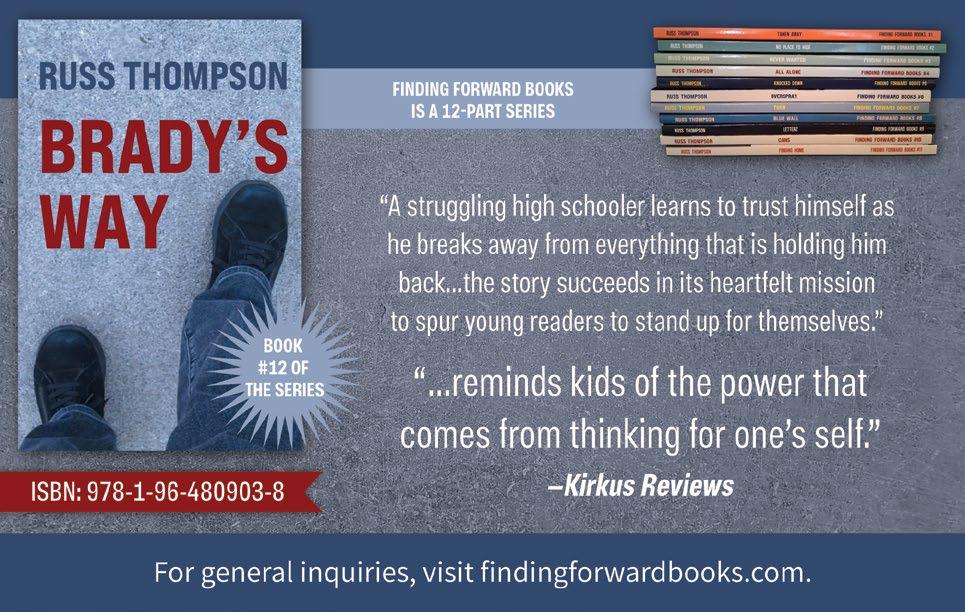
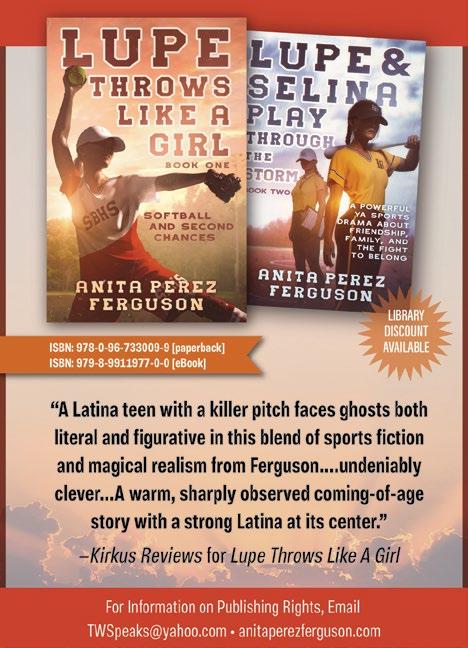
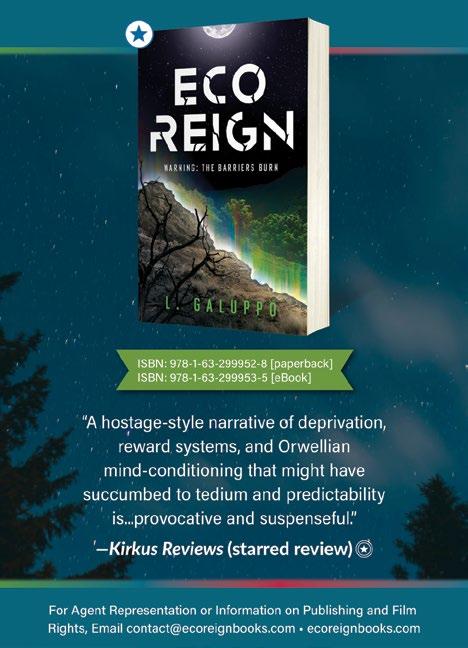




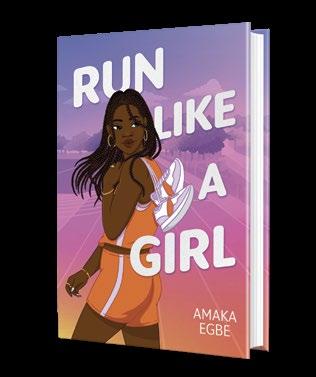


with Krishna’s filmi flair–filled life, much Bollywood-style drama ensues. Suddenly, Krishna’s perfect romance plan becomes a choice between what she came for and a surprising pull toward Rudra. Karthik’s novel debut deftly explores diaspora identity, capturing Krishna’s struggle between her Indian and American selves without resorting to easy answers. Hindi, Marathi, and Gujarati phrases in their original scripts are naturally incorporated (and defined in footnotes), part of the worldbuilding that grounds readers in contemporary Indian settings from Mumbai traffic to Goan beaches. The portrayal of Krishna’s romantic awakening and growth from cautious perfectionist to embracing uncertainty feels earned, elevating the work, but Rudra’s inconsistent character development is a weakness. The over-reliance on Bollywood references becomes intrusive, often overshadowing other cultural insights. The plot also suffers from convenient coincidences and a rushed, overly neat resolution. A sharply observed but unevenly executed exploration of love and belonging. (Romance. 14-18)
Linde, K.A. | Bloom Books (544 pp.) | $19.99 January 6, 2026 | 9781464253553
Series: Royal Houses, 2
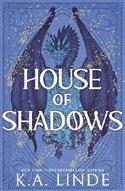
A dragon rider who’s half-Fae and half-human navigates uncharted territory in this sequel to 2025’s House of Dragons
Things are turning around after the dashing of Kerrigan’s dreams of becoming a dragon rider for another house. Through her relationship with Fordham, heir to the House of Shadows, she’s found belonging. To finalize her membership, she’ll have to travel home with him and be accepted by his father, King Samael Ollivier—but the House of Shadows is known to be especially cruel to humans and the half-Fae. In addition to swearing fealty to the king and developing a necessary
(but inexplicably missing) bond with her dragon, Tieran, Kerrigan must also complete a year of training with Tieran. She also has to outrun the machinations of the Red Masks, a terrorist organization hellbent on erasing humans and half-Fae from society. The plot has many threads to follow and features few action scenes and a preponderance of dialogue that doesn’t always further the story; much of the time, the dragons aren’t central to either the conversations or the situations. As in the previous book, there’s a questionable age gap between teenage Kerrigan and an adult man she’s in a romantic relationship with (Fordham’s age is ambiguous, but Kerrigan assumes that he isn’t “as young as she” is). This element, a lot of alcohol-fueled partying, and some explicit sexual interludes make the intended audience difficult to identify. Kerrigan and Fordham read white. Frustratingly slow. (maps, pronunciation guide, houses) (Fantasy. 16-adult)
Markum, Samantha | McElderry (352 pp.)
$20.99 | January 27, 2026 | 9781665973076
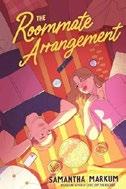
New college student Blair had everything figured out, but the old friends she was supposed to share a house with tell her at the last minute that she can’t live with them after all.
A week before she enters Central Florida State University, Blair needs to find cheap housing. Her parents will never let her live off-campus with strangers, and if she’s forced into the dorms, she won’t be able to afford the sculpting class taught by her idol at a nearby studio. Desperate, she takes the only option she can find, forging her stepdad’s signature on the lease. But to her horror, she discovers that Jamie Atwater, her antagonistic older brother Sawyer’s best friend, is one of her new roommates. When Jamie threatens to reveal her secret, Blair strikes a deal: She’ll help Jamie with his coding project, and he won’t tell her brother
where she’s living. But the more time Blair spends with Jamie, the more she unravels his mysteries and realizes that he sees her as more than his friend’s sister. Equal parts funny, emotionally charged, and heartwarming, this is a feel-good story about finding your inner strength and pursuing your passions that’s well-paced and strongly characterized. The cast members’ endearing bonds liven the world and enhance the story’s relatability. The leads are cued white, and the supporting cast is broadly diverse. Blair deals with anxiety but is confident in her fat body.
A sweet enemies-to-lovers romance with a healthy dose of empowerment. (Romance. 15-18)
Prince, S.G. | Godwin Books (368 pp.) $19.99 | January 20, 2026 | 9781250406460
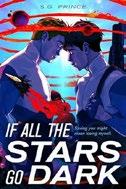
A freshly recruited gunner and his unwilling fighter pilot partner team up to uncover the truth about a deadly threat to the galaxy. Three years ago, Keller Hartman ran away from an orphanage on the volcanic planet Venthros to pursue his dream of joining the Legion as a gunner. For Keller, earning a spot in the elite Sixth fleet means more than fame or a high-profile career—he yearns for a family of his own. His expectations plummet when his new partner, Lament Bringer, refuses to fly with him. After his last gunner and best friend died during a mission five months prior, Lament doesn’t care about orders from their sergeant or even Keller’s ARCAN Aviation Academy records. Recklessness and desperation to belong thrust Keller into Lament’s under-the-table investigation of the mysterious toxic mist that killed Lament’s friend. Meanwhile, the spread of the controversial movement called Determinism occupies the Legion’s attention; the leader of the Determinists, Ran Doc Min, is dropping hints of a
galaxy-wide catastrophe. This story starts off with suspense and a fast pace, but lackluster characterization, thin worldbuilding, and a villain whose motivation and influence strain believability all detract from the initial appeal and intrigue. Additionally, a stock side character’s fixation with the romance between the leads, who are cued white, veers uncomfortably toward fetishization, and some of the in-world references evoke real-life racial stereotypes. A crash landing at hyperspeed.
(Science-fiction romance. 14-18)
Quindlen, Kelly | Roaring Brook Press (400 pp.)
$22.99 | $14.99 paper | January 27, 2026 9781250377371 | 9781250414472 paper

In Baton Rouge, Louisiana, in 2012, two best friends attempt to hide their feelings for each other from their strictly religious families and friends.
Hannah and Baker are part of a close-knit friend group at their Catholic school. As their senior year goes on, Hannah finds herself unable to deny her growing feelings for Baker—and she’s sure Baker feels the same. As the deadlines for responding to college acceptances approach, and the seniors confront the reality that they won’t all be together after graduation, they must dig deep to face their feelings and the pressures of their strict Catholic upbringing. Though originally selfpublished in 2014, this book remains relevant. Quindlen crafts a genuine narrative of the unlearning required after growing up queer within the Catholic church, writing Hannah’s inner turmoil—confronting her acquired beliefs versus her growing awareness of her sexuality—with a sense of authenticity and vulnerability. Readers witness Hannah’s and Baker’s struggles to confront their feelings of attraction and their attempts to conform to societal expectations. The numerous references to the Bible and Catholic beliefs will
resonate with readers from similar backgrounds and indicate the author’s understanding of the characters’ perspectives. The side characters are fleshed out as the story follows them throughout their last semester of high school, allowing readers to get to know each one and understand the group dynamics. Main characters read white. An authentic story of navigating queerness as a young Catholic. (author’s note) (Romance. 14-18)
Ralph, Vincent | Wednesday Books (256 pp.) $13 paper | January 20, 2026 | 9781250372123
Series: Bleak Haven, 1
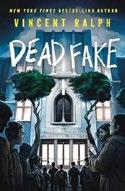
A teen races to find the culprit behind a series of deepfake murder videos. Ten years ago, Ava’s Uncle Miles murdered three people—although one fought back, inflicting a fatal stab wound before he died. Ava struggles to reconcile the monster people believe her uncle to have been with the unconditionally loving man she knew. When a QR code for a quiz on the app Swipe to Die appears on school bulletin boards, Ava’s classmates can’t resist answering the questions. Soon after, videos appear that show students (who are alive and well) being brutally murdered. Ava is unsettled, while others brush them off as harmless—until victims end up really being killed in the same fashion as their “dead-fakes.” Ava believes the videos might be connected to Uncle Miles’ alleged killing spree, and with her best friends, she tries to find the person behind the app. The thrilling premise explores the dangers of AI, but the central storyline is weighed down by subplots that create a disjointed narrative. In addition to investigating the murders, Ava is intent on proving her uncle’s innocence, hopes to date someone who doesn’t know her family history, and navigates a changing relationship with a close friend who has a new
boyfriend. Bleak Haven’s grisly past repeatedly arises with no real explanation. The end reveal is intriguing, but the culprit’s motives don’t hold up to scrutiny. Most characters present white. Fast-paced and original but marred by a disjointed plot. (Horror. 14-18)
Ralph, Vincent | Wednesday Books (240 pp.) | $13 paper | January 20, 2026 9781250372147 | Series: Bleak Haven, 2

In this standalone follow-up to Dead Fake (2026) that is set in 1987, nearly 40 years before the series opener, Noah and his classmates fight to uncover the truth about their town’s cursed past.
The mayor of Bleak Haven holds regular nights of remembrance for those who have been killed in the town. This latest event also celebrates the nearly 15 murder-free years since the Lullaby Man kidnapped and killed five local babies. He would have claimed six, but Grace’s father caught him standing over her crib. The constant reminders of these crimes cast a pall of fear over the population, and some residents feel it’s time to move on. When the mall bookstore Noah works in becomes the target of a search by armed people wearing balaclavas and seeking the Burning Book, the alleged source of the town’s curse, he learns what really lies behind Bleak Haven’s ghost stories. Aside from using the same town setting and lore, this entry departs dramatically from the first, technology-centered volume, leaning fully into supernatural horror. Ralph explores the different ways people process fear and grief, especially as teens, and delves into the town’s history, examining how some distort the truth to fit their ideals. First-person narrator Noah’s inner monologue offers readers glimpses into his vulnerability and anxiety, building the story’s tension, before everything wraps up in a slightly too tidy ending. Most characters read
white, apart from Grace and her family, who are cued Latine. Fast-paced, claustrophobic small-town horror. (Horror. 14-18)
Rubin, Lance | Harper/HarperCollins (368 pp.) | $19.99 | January 6, 2026
9780063330368

Carter Cohen just turned 16—again.
On the morning of Carter’s 16th birthday, his family delivers some unbelievable news: This isn’t the first time. Technically he’s 22—and his “little brother,” Lincoln, is 19. Every December, when Carter is supposed to turn 17, he instead loops backward; any physical changes and his memories from the previous year are erased, while the rest of the world keeps going. Carter is now on his sixth loop, and doctors haven’t been able to figure out what’s causing his unusual condition. Meanwhile, Maggie Spear, Carter’s girlfriend from the previous loop, is devastated that he no longer remembers her. She decides it’s better to pretend their relationship never happened than to risk heartbreak again. Despite Maggie’s efforts to move on from Carter, the two find themselves drawn together again. As Carter’s next birthday comes closer, he and Maggie question what their future will look like when there’s no guarantee that Carter will reach 17. Rubin offers an original take on the time-loop trope, deftly exploring the complexities of relationships and what it means to change. The novel alternates in perspective between Carter and Maggie, who have distinct voices, resulting in a delightfully banter-filled love story. Carter
is Jewish, and he and Maggie both read white. There are queer and racially diverse characters among the supporting cast. An engaging time-loop love story with a unique spin. (author’s note) (Romance. 14-18)
Schroeder, Rebecca | Twenty-First Century/Lerner (64 pp.) | $35.99
$14.99 paper | January 1, 2026
9798765644218 | 9798348029586 paper
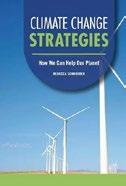
A concise guide that reminds readers that it’s not too late: There are real actions, big and small, that we all can take to combat climate change.
“The time is now. Climate change will impact everyone on Earth.” With this urgent declaration, Schroeder emphasizes the necessity of immediate strategies to slow global warming and mitigate its effects on the planet. She identifies human-caused greenhouse gases as a primary culprit and asserts that the most effective responses focus on reducing these emissions. The book opens by addressing the energy sector—“transportation, heat and electricity, buildings, manufacturing, and construction”—which accounts for 75% of global greenhouse gases. The subsequent short chapters explore carbon capture and storage technologies, sustainable agriculture, thrifting and recycling, and practical daily measures, such as purchasing energy-efficient appliances and growing one’s own food. Text boxes provide added context, from the history of electric vehicles to explanations of carbon cap and trade systems and farmer’s markets, offering
An engaging time-loop love story with a unique spin.
readers deeper insights without overwhelming the approachable and engaging central narrative. Clearly captioned photos break up the text nicely. The author doesn’t just cover important factual information but also exhorts readers to join the movement for a healthier planet. The conclusion underscores the positive message that “individual actions are very important in fighting climate change.”
A timely, practical, and reassuring look at collective actions against climate change. (glossary, source notes, selected bibliography, further information, index) (Nonfiction. 12-18)
Scott, Emma | Bloom Books (432 pp.) $14.99 paper | January 20, 2026 9781464243370 | Series: Lost Boys, 2

Troubled rich boy Holden Parish and star quarterback River Whitmore are an unlikely pair, who find themselves longing to be together the more they push each other away. Fresh out of treatment at a sanitarium in Switzerland and haunted by his traumatic past, Holden goes to stay with his aunt and uncle in California. He’ll spend his senior year at Santa Cruz Central High School. In an effort to distance himself from painful memories of the conversion therapy in Alaska that his parents forced on him—and that necessitated the year of recovery in Geneva—Holden drinks and spends profligately. River is the last person Holden expects to be closeted—and when the two are together, there are undeniable sparks. What starts with simple attraction builds to a secret romance and steamy encounters, ultimately forcing both white-presenting teens to face their own demons before they can build a meaningful, lasting relationship. River and Holden, who were secondary characters in the first book, take center stage in this second entry in the Lost Boys series. Though
they have diverging stories of coming out as gay, some of their most tender and vulnerable moments involve their coping with similar feelings of loneliness and grief. Their life circumstances are extraordinary—Holden’s parents are billionaires, River is considered NFL material—but Scott highlights their humanity. This compelling story, which follows its leads beyond high school, will appeal to romance fans.
An absorbing love story. (playlist, content warning, author’s note with resources) (Romance. 16-adult)
Setian, Victoria | Illus. by Savanna Ganucheau | Abrams Fanfare (224 pp.)
$26.99 | January 13, 2026 | 9781419762635
Series: When Monsters Wake, 1

Mysterious happenings plague the small town of New Whitby, and one teen reporter is on the case.
Introverted teen photographer Mina finds herself in the wrong place at the right time when, during a bike ride, she witnesses a shipwreck. Running to help (and snapping some photos, naturally), she encounters wolves bursting from a crack in the hull. On board there are wooden crates filled with dirt, and horrifyingly, a single human— the ship’s captain, who’s dead, with strange marks on his neck. Mina, who was recently pushed into joining the school newspaper, is determined to pursue the story. Meanwhile, a mesmerizing transfer student arrives from Romania. He holds the other students in his thrall, including Mina’s effervescent best friend, Lucy, who reads Black in a largely white-presenting cast. After one person goes missing and another is hospitalized, it’s clear there are monsters in their midst, and the stakes couldn’t be higher. Can Mina and her friends get to the bottom of things before they meet their own doom? Setian’s debut is well-paced and fun. The character development is light; Mina’s backstory is teased, and readers will anticipate learning more in the
next series entry. The story realistically portrays high school crushes and drama, delightfully updating Bram Stoker’s characters as modern teens. Ganucheau’s moody artwork is visceral and evocative, making strong use of the natural setting. A compelling and atmospheric modern take on a classic horror story. (map) (Graphic horror. 13-18)
Sharma, Nisha | Union Square & Co. (384 pp.)
$18.99 | October 7, 2025 | 9781454947776
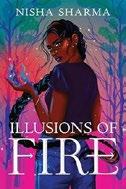
When fire runs in your blood, destiny will always strike a spark. Eighteen-yearold Laila Bansal, a descendant of Draupadi (from the Hindu epic the Mahabharata), lives with her three immortal rakshasi aunts and is bound by her bloodline to bear a child before age 25 in order to maintain the cosmic balance. Laila’s masis raised her in remote areas—Mauritius, forests in Indonesia and Germany, and now, a winery in upstate New York. She longs for normality, scrolling social media and envying her friends’ college experiences (she’ll be attending college classes online). Laila’s world explodes when Karan Singh, “descendant of warrior and demigod Karna,” arrives, hunting an asura, or supernatural monster—and their forbidden connection triggers apocalyptic consequences. Sharma authentically integrates Hindu mythology into contemporary settings, drawing from oral traditions and regional variations. The romance develops organically despite the leads’ star-crossed origins, and a late revelation adds layers of tension and tenderness. Central themes of autonomy versus destiny emerge through Laila’s struggle against predetermined motherhood, echoing Kate Chopin’s The Awakening, which is her favorite book. The story also explores grief and inherited legacies through sharp dialogue and vivid action sequences. While the pacing occasionally slows during exposition-heavy sections, and the third-person narration
feels distant at times, Laila’s journey to self-acceptance and the explosive finale provide readers with a satisfying resolution. A fiery fantasy that proves that sometimes the most dangerous battles are the ones within. (content warning, author’s note) (Fantasy. 14-18)
West, Kasie | Delacorte Romance (272 pp.) | $12.99 paper | January 6, 2026 9780593897720
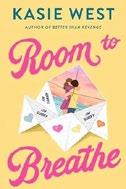
A teen’s world turns upside down when her father is accused of fraud. Prior to the investigation into her lawyer father, Indy Blair began a normal junior year of high school with loving parents and a tight-knit group of friends—Ava, Caroline, and Beau. Indy is especially close to Beau, the boy with the crooked smile that causes her heart to flutter. She performs well in school and works at a tutoring center. But the accusations against her father strain her home life, especially when Indy begins to doubt his innocence. Her grades slip; she dyes a strip of her brown hair black, quits her job, starts hanging out with a rebellious skater boy, and makes poor decisions that drive her friends away. Just as life feels completely overwhelming, Indy and Beau accidentally get locked in a school bathroom, forcing them to confront past mistakes—and their deeper feelings for each other. Moving back and forth in time, the novel unfolds through “Then” chapters, chronicling the months before Indy’s father’s investigation, and “Now” chapters, revealing the consequences in the present. The split timeline mirrors Indy’s own fractured identity, which is shaped by the events surrounding her father. The deepening connection between Indy and Beau, which follows classic romance novel beats, has charm. Most of the leads are white, and Ava is Asian American.
A graceful weaving of first love and the quiet strength found in growing beyond our missteps. (Romance. 12-18)
THE NOTION OF youths being magically whisked away to a fantastical destination is a staple of classic middle-grade and young adult literature; think of the Pevensie children accessing Narnia via wardrobe, or Meg Murry “tessered” to various outré locales in A Wrinkle in Time Intrepid Dorothy Gale is probably the most famous example. Once a girl has seen the Emerald City, what could keep her down on that dreary Kansas farm? A clutch of recent Indie titles features young people traveling not just through space, but time as well—it’s an effective conceit, allowing young readers to easily identify with the contemporary protagonists and authors to draw upon rich stores of history and lore to fill in their fictional worlds (and maybe even smuggle in some educational value).
In Culver’s Cove: The Trapiche Emerald by D.M. Glover, tween siblings Heath and Hadden find themselves zapped into the past after discovering a glowing gem in a cave. They land in Massachusetts in the year 1776, on the very day the American colonies gain independence from Great
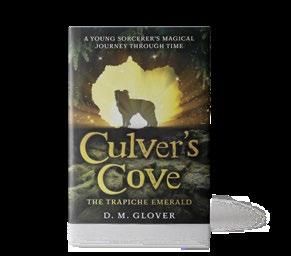
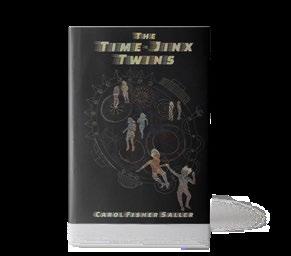
Britain. The brothers navigate non-flushing privies and butter churns, aided by their new friend, young John Adams (give that name a second look). Glover entertainingly juxtaposes the traveler’s bemusement over 18th-century customs with the natives’ horrified fascination regarding the future the brothers represent. John’s mother, for example, is poleaxed to learn of the two upcoming world wars. As our reviewer writes, “the author’s love of history is apparent.”
Carol Fisher Saller adds the irresistible element of mismatched twins to her time-travel tale; The Time-Jinx Twins follows newly reunited identical (on the outside, at least) siblings Ellie and Kat, who are transported, via a mysterious device built by their mother, from 2020 back to the groovy 1970s (now there’s a nifty way to avoid


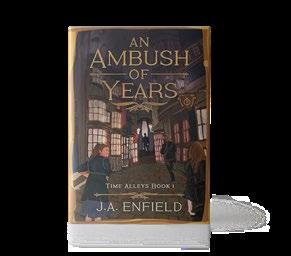

the pandemic). Athletic, outgoing Ellie and quiet, studious Kat must learn to depend on one another and combine their unique qualities and skills (Ellie’s a parkour whiz; Kat’s an ace researcher) to find a way back home. Our reviewer deems the yarn, which eschews “the clutter of time-travel logistics that might alienate the young target audience,” to be “an endearing and engaging middle-grade adventure.”
J.A. Enfield’s Time Alleys trilogy has been a consistent delight—the second volume, The Flickering Bridge, earned a Kirkus star. An Ambush of Years, the series’ inaugural entry, establishes the concept of “time alleys,” otherworldly conveyances that thrust people into the past. Contemporary 10year-old Chicagoan Mick Conway runs into one during a family picnic and is deposited in 1853 London,
where other time-displaced kids, under the aegis of the mysterious Forsyth Institute, show Mick the ropes and help him to adjust (the time alleys only provide one-way trips). Our reviewer praises Enfield’s “intriguing premise,” “relatable characters,” and “vivid descriptions.” The followups, The Flickering Bridge and The Fires of Birth, continue Mick’s story as he learns more about the Institute, the time alleys, and his new 19th-century European home. Our reviewers note the novels’ “fantastical, grounded worldbuilding, presenting a historically accurate London populated with rich, diverse characters” and the way Enfield “boldly tackles themes of imperialism, colonialism, and racism.” The more things change…
Arthur Smith is an Indie editor.
In Basran’s novel, emotions run high as families prepare for an extravagant wedding. An ornately bordered, two-page-spread invitation opens this novel about the impact of a lavish wedding on two extended Punjabi immigrant families in British Columbia, Canada. The bride, Devi Dosanjh, is a high-strung perfectionist who has helped to rebrand her parents’ produce business; her fiancé, Nanak “Baby” Atwal, the namesake of his family’s candy shop, is an easygoing people-pleaser who has just finished medical school. The wedding plans are extravagant—there is a week-long series of events leading up to the big day, a thousand expected guests, a DJ flown in from Mumbai, a signature cocktail, and Swarovski crystals and gold decorating the bride’s garments. The exhaustive
preparations have consumed the participants, straining emotions and finances (both families have recently overextended their businesses); almost everyone is putting up a good front while harboring secret misgivings. As the wedding date approaches, Devi flirts by text with her brother’s bad-boy friend Jessie, and Baby has a hard time recalling exactly what it is he loves about Devi. Are these warning signs, or just normal prenuptial jitters? Basran writes with vivid eloquence: One man’s “entire demeanour was a mouse-like apology,” another is “a hand talker, conducting and directing the conversation.” The leads are both flawed and endearing, and their relationship feels realistic. The interplay of multiple perspectives creates depth as chapters move between

Basran, Gujinder | Douglas & McIntyre 224 pp. | $16.95 paper | May 27, 2025 9781771624169
multiple points of view, including those of the young couple, their friends and relatives, and the wedding stylist and photographer. The author’s skillful interweaving of themes and connected backstories makes for a compelling narrative. Basran deftly highlights the ways in which each generation affects the others and how all are concerned about keeping up appearances,
from guests engineering Instagram-ready moments to a woman “acting disappointed when all she felt was relief.” The novel also offers astute social observations (people “[heart] posts as if it meant something”; “People had put love on a checklist; it was a task, something to execute”) and keen insights into traditional gender roles.
A warmhearted, entertaining, and recognizable family saga.
Asher, Diana Harmon | PJ Publishing (260 pp.)
$9.99 paper | September 1, 2025
9798992481839
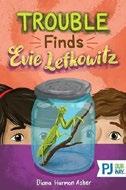
Asher’s middlegrade novel offers a story of familial bonds, unexpected courage, and the remarkable possibilities that unfold when people lift each other up. Things haven’t been going well for seventh grader Evie Lefkowitz. Ever since her father died two years ago, she’s successfully kept her mother away from every potential suitor—until now. Her mom is suddenly over the moon about an upcoming date with Mr. Mitchell, the assistant principal at Evie’s middle school. As if that weren’t awkward enough, her mother volunteers her to tutor Joey Ceraco, a boy to whom she hasn’t spoken since kindergarten. Joey, along with his best friend, Tommy Halliday, is notorious for making trouble. Evie’s life as the cantor’s daughter at Temple Shir Shalom has kept her far away from kids like Joey, and she usually sticks with her more responsible friends, Spencer and Rachel. A questionable science project and a classmate’s scheme to release the lab’s praying mantises sweeps Evie into a whirlwind of shifting friendships, unlikely alliances, and a daring after-school rescue. Amid the chaos, she begins to realize that sometimes, making a little trouble is necessary to stand up for what’s right—and to discover who one is meant to be. Over the course of this novel, Asher delivers a warm, sharply observed middle-grade tale that effectively captures the turbulence of early adolescence, as well as the power of unlikely connections. It’s a satisfying story that offers a clear message that it takes real courage to stand up for one’s beliefs: “That’s rare, you know,” says social studies teacher Mr. Fish at one point. “Hardly anyone is brave enough.” Evie’s first-person narration is relatable throughout, and the novel brims with authentic
characters, pitch-perfect dialogue, and emotional truth, making it a story that young readers will want to revisit. A lively tale about the unexpected magic that comes from helping one another.
Black, Bill | Camp Street Books (249 pp.)
October 15, 2025

Bl ack’s hardboiled detective novel, part of his Erica Banks series, features a contract killer and a baseballfixing scandal. Assassin Erica Banks returns to New Orleans to execute a series of high-profile hits contracted by a Cuban drug ring. Banks is a highly experienced professional, and at first, the murders leave law enforcement baffled. Lawyer Harry Barnes, a fixer who doesn’t always stick to the right side of the law, gets involved when an ex-girlfriend asks him to help clear the name of her uncle, who was one of the victims: Chick Charbonnet, the umpire who “handed the World Series to the wildly underdog New York Mets” over the Red Sox. Accusations of game-fixing have been stirred up again by his gruesome murder. Barnes enlists his colleague, astute hacker Rhonda Dickerman, to help him look into Chick’s past, and they begin to uncover a much larger conspiracy involving high-rolling gamblers, the international drug trade, and an assassin. While this is technically an Erica Banks novel, with her perspective included, the protagonist of this series installment is very much Barnes. With connections to every major player in town, he robustly fulfills the well-connected, straight-shooting noir stereotype. Barnes’ previous activities are often described in a bit too much detail—the first handful of his reminiscences adequately establish his bona fides, but later inclusions become repetitive as he exhaustively details every meal and drink he consumes. While many of the restaurants visited are New Orleans institutions and furnish local
color, the effect loses impact after so many interchangeable iterations. Though Barnes is the primary narrator, chapters from the perspectives of Banks, Dickerman, and several other supporting players provide necessary context and add compelling variety to the narrative. While readers may put together a few heavy-handed clues before Barnes does, the mix of action and investigation will appeal to fans of James Patterson and David Baldacci.
A colorful suspense novel with deep New Orleans roots and an intriguing cast of characters.
Blanchard, Sarah P. | Self (290 pp.) | $32.99 October 15, 2025 | 9798999692221

Two sisters discover a startling manuscript in their late mother’s house that has devastating ties to their present in Blanchard’s thriller. Cassie Bousquet has been estranged from her mother, Marla, and her twin sister, Ana, for years, ever since her marriage to Marsh, a wealthy California businessman. After her mother’s death, she returns to rural Connecticut to help her sister settle their mother’s affairs. While cleaning Marla’s house, they find a manuscript left for them written by their mother’s best friend, AJ Porter, about the unsolved murder of their mother’s distant cousin—the killing occurred in 1985, the year the twins were born. As they read the story, both sisters learn shocking secrets about the mother they thought they knew and begin to repair their relationship (“We need to sort this out, okay? This thing between us”). Cassie questions her marriage, finding something horrifying on a storage drive that her husband gave her; it transpires that she and Ana are in danger, and their family’s dark past is coming full circle. Blanchard’s novel is a masterfully constructed work, balancing the story within the story with excellent pacing. The connection between Cassie’s adult
life and her mother’s past is a little far-fetched, but it effectively brings the plotlines together for a nail-biting showdown. Marla and AJ are vividly brought to life in the flashback section; the twin sisters are less distinctive. After all the years Cassie spent floundering in an abusive marriage, only to have her world upended by two massive lies, she seems a bit too together at the end. Ana also seems one-note—she’s initially presented as the ‘good’ twin, and the story makes no effort to subvert that trope. Marsh is too obviously villainous at first, but his portrayal ultimately strikes a perfect balance between menace and craven vulnerability. Any weaknesses in the characterizations are forgivable in light of the satisfying conclusion. A dark, satisfying thriller perfect for readers who love family drama and scandalous secrets.
Breslin, Ned | Wild Rising Press (142 pp.) $15 paper | June 25, 2025 | 9781957468433
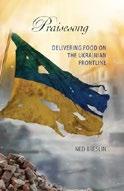
Breslin, a humanitarian aid worker, presents a poetry collection that offers a moving portrait of the ongoing tragedy of the Russian invasion of Ukraine. This set of poems follows aid workers delivering food on the front lines of Ukraine during the ongoing Russian incursion. Breslin, who directed a nationwide food accessibility project there, attempts to fill the gaps of what has been taken away by this conflict. The theme of things missing or lost— a destroyed building, an impassable road—establishes that unique creations are not replaceable, and these losses often coincide with terrible losses of human life. His works often focus on destruction, employing images of people cut off from others as they live “in dispirited houses with open lesions / along gutted roads desperately clinging to frail bridges /
A set of works that finds light amid the darkness of war. PRAISESONG
barely connected to the rest of Ukraine” (“Every Spark Is Gathered”). The poet also effectively zeroes in on the human cost of war at a time when endless news coverage of devastation and ruin can numb those who observe it from far away. The longer works, especially, such as “Thanksgiving in Kyiv” (“A day in Ukraine’s capital / flooded in tears / ringing in shock”), offer in-depth documentation of the suffering in a war-torn country. The Thanksgiving poem, for instance, shows how helpers from across the globe have set a “table that smells of welcome / amidst the sorrow / and the stench / calling out to counter the horror / with love,” and begin the process of healing from unimaginable grief. Overall, the collection is a taxing read, but it offers a sense of understanding that makes small moments of human care and connection all the more powerful. It also depicts how resilient humans can be when others lend a hand.
A set of works that finds light amid the darkness of war.
Chase, Annabel | Red Palm Press (336 pp.) | $17.99 paper October 2, 2025 | 9798999775306
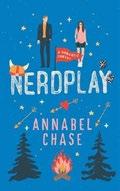
A lawyer trying to dispossess the proprietress of a sleepaway camp ends up falling for her instead in Chase’s fizzy romance. She’s Cricket Abernathy, owner of the run-down Camp Abernathy by gorgeous Lake Willa in the Poconos; he’s Charlie Thorpe, a Philadelphia lawyer tasked with convincing her to
sell the camp to his real-estate developer client—with a promotion to partner riding on his success. When Cricket rejects the offer, Charlie decides to look for secrets that could force her to sell by signing up for the two-week-long Comic-Camp for adult nerds who are into everything from Star Wars to Lord of the Rings. Cricket knows about his subterfuge, but lets him in anyway because of his granite jaw, muscular chest, and adorable dimples. Other campers include Adam, who plays a Sith Lord; Stefan, who dresses as a Viking; Hunter, who portrays a zombie from an apocalypse-set game; 11-yearold Olivia, who’s a dead shot with foamtipped arrows; Angela, a cougar on the hunt for a fourth husband; and Esther, an old lady who crochets plushie penises as gag bridal gifts. Charlie, who is basically a nice guy and a good sport, bonds with these oddballs and, smitten by her toned physique and infectious humor, falls in love with Cricket. Cricket reciprocates Charlie’s ardor, and their relationship escalates from flirty banter to Cricket inspecting Charlie’s genitals for ticks, thence to skinny-dipping and…nature taking its course. Complications arise when Cricket’s old flame, Patrick, shows up. The situation worsens when Charlie discovers a lien on Camp Abernathy, giving his client leverage to take the land—and threatening Cricket’s home and livelihood.
Chase’s yarn follows a classic screwball-comedy formula, pairing a nervy heroine with a manly but menschy hero amid a constellation of lovable eccentrics in a narrative that’s full of blithe, energetic contrivances. It’s also a valentine to nerdishness and the pop-culture icons it feeds upon, spoofing them but also acknowledging their moral seriousness and relevance. (“Peter becomes a hero when he
develops a genuine connection with others,” Adam explains to Charlie in a rather pointed interpretation of Guardians of the Galaxy.) The romantic leads are complicated and unfinished, with Charlie needing to release the emotions that his judgmental parents forced him to suppress and Cricket unable to break free from the safe but isolating cocoon of Camp Abernathy. Chase writes vigorous, evocative prose that crackles with smart and salacious repartee (“Your hand is on my ass, Charles Xavier Thorpe….[e]ither that or this lake has a small octopus”) and makes her characters, unlike many of the bland protagonists who populate romances, feel quirky, colorful, and alive. (“The memory of Cricket’s laughter rings in my head. It was a wicked, bawdy laugh that ought to belong to a gangster’s moll and not the bespectacled woman in the Tree of Mordor or Gondor or one of the ’dors T-shirt”). Readers will heartily root for Cricket and Charlie to get together and save their geeky paradise. A sparkling love story with richly depicted lovers and a sly comic sensibility.
Daab, Justin | Self (175 pp.) | $19.99 July 20, 2025 | 9798292943259
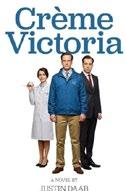
In Daab’s novel, two half-brothers battle to take control of their father’s megasuccessful cosmetics company. Initially, the two brothers are unaware of each other’s existence. Kenny Baines is an eighth-grade science teacher at the local junior high school in Middlebury, Vermont. He is going about his ordinary morning routine when he hears that a man sharing his last name—the CEO of one of the UK’s largest privately held companies, Victoria Cosmetics—has died. Almost immediately, he is whisked away to London, where he learns that this man
was his father, who decided to leave his entire estate to his “most deserving son,” either Kenny or the ultra-posh, spoiled Alistair Baines. This revelation shocks both brothers, especially Kenny, who did not know he had a sibling or a living father—his mother had told him that his father died when he was young. As stipulated in the will, both brothers are appointed Co-Vice Presidents of Innovation at the company for one year, after which time the board will vote to determine which brother “exhibits the greater ability to make the world ‘a more beautiful place.’ Winner takes all.” Kenny receives his father’s Aston Martin and a new Savile Row wardrobe, though it doesn’t quite suit him: “There I was. Kenny Baines, newly minted co-owner (sort of) of a cosmetics empire, proud possessor of a car that cost more than my house, and about as comfortable as a cat in a washing machine.” From the start, the deck is stacked against him; the board is considerably unenthused about an American taking over their company (especially one with no business experience). To make matters worse, Alistair’s half of the company contains the profitable part of the business, while Kenny’s portion “could best be described as, the dregs.” Kenny’s odds of winning are estimated to be roughly one in a million, but he eventually finds an ally in Thaddeus Wong, the owner of a Hong Kong–based cosmetics company and the second-largest shareholder in Victoria Cosmetics after the brothers. With Wong’s guidance, Kenny adopts the practice of MBWA, or “management by walking around,” meeting with employees lower down in the company hierarchy to gain a clearer picture of operations. From these conversations, he begins to piece together a plan that might give him a real chance to succeed.
While the set-up reads like that of a classic 1980s slobs-versus-snobs comedy, Daab throws enough curveballs into the mix to keep the story from becoming too formulaic. There are fun and fully-realized side characters, like Nelly, the blind busker and comedic soothsayer; Mrs. Bellingham, who memorably
describes herself as “one part ninja, one part Aunt Jemima, with a splash of Walter White”; and Lily Watson, a mad scientist in the R&D department who has developed a new, unconventional cosmetic line that makes skin appear younger and fresher. Daab deftly mixes Kenny’s witty first-person narration, funny back-and-forth dialogue, and deadpan observations (“It was about profit. About maintaining the status quo. About selling more stuff, even if that stuff wasn’t as good, or as clever, or as genuinely useful as it could be. It was, I realized with a sinking feeling, a business”), keeping the laugh rate high even if the momentum dips a little in the final third.
A consistently funny and breezy read.
DeVito, Vincent J. | Self (200 pp.) | $12.95 paper | July 23, 2025 | 9798985445169
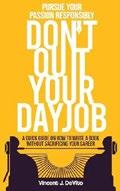
A self-help guide for aspiring writers navigating the reality of maintaining a full-time job.
Drawing from his own career as a software developer filled with “kickme-when-I’m-down kind of day[s],” the author here shows how creative ambitions can coexist with corporate realities. Each chapter follows a standard format, complete with summaries and takeaways, with DeVito frequently punctuating his points with humor (“Office Space, anyone?” he ruefully asks, wishing day jobs could be avoided altogether). The author focuses on pragmatism, reminding readers that the day job, which provides structure and money, is both the greatest obstacle to and a necessity for continuing their creative work. His thorough accounting of everything a writer working another gig needs to thrive ranges from micro-goals, such as writing for five
minutes a day (“you will end up writing for more than five minutes,” he promises), to big-picture planning, to keeping the worlds of work and writing separate. DeVito aims to inspire readers by delving into his own story and those of numerous other writers who have defied the odds to get their work published, highlighting what is possible (“If you want it bad enough and for the right reasons, you cannot fail”). Though much of the advice here is standard fare for books on writing (including chapters encouraging writers to be patient and set goals), DeVito’s voice is that of a trusted confidant, offering not just one solution but many. The book truly shines in its specificity, especially in chapters about keeping writing separate from work obligations, navigating company policies, and hiring help (such as editors or ghostwriters). The author even addresses best practices for using AI. Budding writers will find the frank discussions of costs and resources very helpful if they feel lost, and the author’s bright optimism will leave them ready to tackle the true demands of balancing creative endeavors with a career.
Personable and specific advice offering real help for writers struggling to find a practical path forward.
Step-by-Step Guide to Making $250,000 Per Year from Airbnbs with One Up-Front Investment
Faeth, Bill | Amplify Publishing (168 pp.) $19.95 paper | October 7, 2025 9798891387096

Entrepreneur Faeth presents a no-nonsense guide to investing in shortterm rentals.
This manual, which aims to help readers hoping to make “$250,000 Per Year from Airbnbs with One Up-Front Investment,”
presents a healthy balance of serious, well-structured investment advice alongside simple pep-talk. The opening vignettes—which present readers with meditations on building wealth as a craft, the legacy of the author’s childhood in Bakersfield, California, and his mother’s kitchen-table accounting lessons—are brief and effectively establish the author’s credibility without dwelling excessively on his fortunes. The book’s central thesis is that anyone, with clarity and discipline, can forge a path to generational wealth, and it centers on his “250 Plan”—a strategy to scale five properties in five years, each yielding $50,000 in net annual income. Faeth asserts that success hinges on more than cash flow, although it is one of his “Four Pillars,” which also include appreciation, paying down debt, and tax benefits. These four elements, he says, can be used together to transform ordinary rentals into “Super Properties.” He warns of the risks of government regulation and inconsistent guest experiences—which he characterizes as the two great hazards of the short-term rental field—and offers advice on proactive risk management and hospitality standards. He guides readers through market selection, underwriting, financing tactics, pricing optimization, and the application of technology for automating marketing and booking. A sprinkle of cautionary tales, addressing such things as expenses for missed snow removal and lackluster property managers, gives the book some real-world color. Formulas, calculators, and anecdotes from the author’s protégés further underscore that the book features not armchair theory, but stories from lived experience. Overall, it’s a brisk, colloquial, and straightforward investment manual. Faeth delights in skewering lazy investors and bland, Ikea-furnished listings; he names names and shares secrets, demystifying a volatile, overhyped sector without dampening its possibilities. Readers may wish for more examples of what happens when things don’t work out, but aspiring investors who prefer a clear path over vague promises will find what they’re looking for here.
A property investment manual that appealingly puts candor before gloss.
Fern, Jessica & David Cooley
Thornapple Press (336 pp.) | $24.95 paper October 31, 2025 | 9781990869709
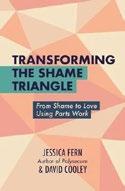
An accessible framework for understanding shame—both within oneself and within relationships. This book begins with some personal comments from authors Fern (a trauma and relationship expert and psychotherapist) and Cooley (a professional restorative justice facilitator and diversity awareness trainer) explaining where the ideas for the titular “Shame Triangle” originated. Fern recalls an anecdote from her personal life in which her “competing needs” reminded her of how often she thinks about herself in terms of “parts” that seem to have their own “concerns, priorities and desires.” What follows is a breakdown of the authors’ views on the key components of shame and its impact on people and relationships. They posit that shame is viewable through a triangular framework based on psychiatrist Stephen Karpman’s Drama Triangle, which includes the roles of Victim, Persecutor, and Rescuer. Fern and Cooley’s Shame Triangle, however, includes slightly different roles, as it applies to both internal and external conflicts; these roles are the Inner Critic, Shame, and Escaper. The authors detail the strategies and behavioral impacts of each part of the triangle: Where do they come from? Why do they exist? How can we begin to address them? Each of these ideas is effectively supported by humanizing personal anecdotes and peer-reviewed academic literature. Fern and Cooley have prepared this book with accessibility in mind, seeking to ensure that even readers with limited knowledge of psychology and medicine will be able to use these strategies to start the
journey toward self-understanding. They make it clear that the goal is not necessarily to change the self, but rather to work with natural inclinations to find healthier ways to resolve conflicts, both within and outside the mind. This book will be appreciated by anyone searching for new ways of understanding shame and trauma, especially for the purpose of enhancing mental stability and relationships. A fresh, insightful take on one of our slipperiest emotions that offers readers workable pathways forward.
Fern, Melora | Sibylline Press (374 pp.) $20 paper | May 16, 2025 | 9781960573803

A young trombonist embarks on a journey of self-discovery when she joins a lively touring troupe of female musicians in Fern’s novel.
In March of 1924, 19-year-old Bertha (Birdie) Stauffer has just finished playing trombone in a musical and dramatic presentation at a West Chester, Pennsylvania, ladies luncheon with her older sister, Lydia. An acquaintance of Lydia’s approaches the pair to compliment them and introduce her niece, Helen Wilcox, a classical pianist. Much to Lydia’s displeasure, Helen encourages Birdie to audition for the locally famous Westdale Chautauqua touring company, but Lydia has other plans for her sister. Birdie lives with Lydia and her husband, Gerald, and they have agreed it is time for Birdie to find a local eligible gentleman to
marry. With Lydia finally relenting, Birdie goes off to the audition, and although she isn’t initially accepted, Helen tells the group manager that in addition to being able to sing and play the piano, Birdie has another talent: She is a gifted whistler, able to mimic bird calls in perfect pitch. Nicknamed the “Versatile Quartet,” with Birdie’s addition it becomes the “Versatile Quintet,” and next thing you know she’s off for a life-changing adventure that takes her all across the eastern United States and even into Canada. The five multitalented women—Birdie on trombone and Helen on piano, plus Florence (Flo) Armstrong on harp, Mary Brewer on violin, and Adelle Rowley on banjo—vary widely in personalities and temperaments, adding to the challenges and confrontations of life on the road. Written in breezy, easy-flowing prose, the novel captures the excitement of the emergence of the Roaring ’20s, with the characters eagerly embracing the new styles and colloquial wordplay (“I’m a hoofer” “We’re all chums”) popular at the time. Fern packs the pages with interesting behind-thescenes details of the quintet members creating innovative musical arrangements, problems with the circuit manager, production complications, romantic entanglements, and even a frightening assault on one of the women. Although there are many descriptions of Birdie’s avian calls and tweets, the most interesting of these come when her birdcalls are described while accompanied by harp and violin. Most satisfying is watching Birdie’s development from obedient underconfident younger sister to fully fledged adult, learning to define her own life. A pleasant showbiz coming-of-age beach read that gives an evocative taste of America’s Jazz Age.
Flakus, Christopher | Franklin Publishers (95 pp.) | $14.99 paper | August 20, 2025 9798893247756

Flakus, in his self-described “latinopunk” novella, crafts a cyberpunk adventure about a cybernetically enhanced outlaw on a distant planet. Ryu Ruiz is a “runner—a cybernetically enhanced outlaw who harvests and transports Starflesh, a mysterious fungus with mystical hallucinogenic properties that transforms its users mentally, but also physically. For example, one prominent user’s “hair fell out, leaving him completely bald. He looked ten years younger…. His skin became a golden color which seemed to emanate a soft light in complete darkness.” Running is incredibly dangerous, and police patrol the city of Cuetlaxochitl, the seedy major port city on the remote and dangerous planet Xochipili, the only place in the galaxy where Starflesh grows. Xochipili’s history as a penal colony for undocumented immigrants on Earth makes the far-flung futuristic galactic setting feel immediately timely and relevant. Ryu runs Starflesh both because it’s his only career option and because he’s in love with Miriam, the head of the runners’ guild. Her bar, the Dos Santos Cantina, conceals the Chicxulub, the eponymous spaceship that Miriam plans to use to return to Earth after one last big score. The book, which is deeply infused with Latine language and culture, is at its best when it follows Ryu’s thrilling exploits, his simmering relationship with Miriam, and his friendship with fellow runner Felix. It’s slightly less effective, though, in an extended digression told from the perspective of John Praetor, a police officer from Earth who’s come to enforce the law on Xochipili because of the promise of a big payday. Luckily, the plot quickly returns to the runners and their richly drawn world with its own complex culture and struggles. The
story bounces deftly from SF to action-oriented thrills and eventually to a kind of transcendent mysticism. Flakus maintains a strong narrative voice and a clear vision, and shows deep care for these characters and their relationships along the way. The result satisfies all the expectations of the genre while feeling wholly original and exciting. Readers who enjoy exciting actioners set in unique but still recognizable futuristic settings will find a lot to like here.
A thrilling SF tale driven by likable outlaw heroes.
Kirkus Star
Galuppo, L. | River Grove Books (326 pp.)
$19.95 paper | March 18, 2025
9781632999528
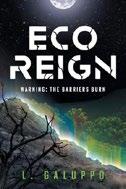
Vastly powerful space aliens hijack Earth and abduct and imprison humans. Following a power outage, our adolescent narrator, Lauren, her younger brother, Matthew, and their mother are among the masses of humanity literally swept up by powerful, godlike space aliens and jailed in rather conveniently available hangars in town. Deadly energy barriers keep people contained, and troublemakers die hideously. Eventually, the Invaders show themselves. The gaunt, robed, elongated humanoids declare that humankind’s endless ravaging of Earth’s environment must end immediately. The planet will be rehabilitated whether they like it or not. Earth’s inhabitants, meanwhile, will suffer an indefinite period of “atonement...and…enlightenment.” Small liberties are soon granted to the prisoners. Ultimately, Lauren finds herself corralled with the other children separated from their families, and she’s trained by a pair of Invaders (one female and kindly, the other male and harsh).
The aliens seem to have other ET species working in subservient positions, and as long as Lauren cooperates, she’s permitted access to the Invaders’ impressive technology, which allows for the revival of extinct animals and restoration of Earth as a biodiverse paradise. But cruel mistreatment of humans persists, and Lauren wonders if the Invaders have a more selfish, sinister agenda. Galuppo’s YA debut is akin to The War of the Worlds and not unlike recent bestsellers, like Rick Yancey’s The 5th Wave. But rather than spectacular destruction and action, the novel emphasizes stifling confinement and slow, crafty indoctrination. A hostage-style narrative of deprivation, reward systems, and Orwellian mind-conditioning that might have succumbed to tedium and predictability is actually provocative and suspenseful. Invaders are allowed to remain nonhuman enough that their overwhelming menace does not feel merely like a nasty caricature of Homo sapiens’ “green” movements. An open ending and fertile story threads indicate Galuppo has more than a few seedlings for a sequel in the girl-vs-Goliath mode.
Vicious alien conquest and oppression drive this provocative YA/SF thriller.
Giesler, James | Self (388 pp.) | $24.95 paper August 2, 2025 | 9789893631201

Giesler’s book offers a history, aimed at a general audience, of the remarkable Spanish government official Francisco de Saavedra. Francisco Arias de Saavedra y Sangronis was born in 1746 in Seville. As an adult, he joined the army and was soon recognized in the higher echelons of government; José de Gálvez, minister of the Indies, recognized his talents and sent him to that jurisdiction to tend to
Spanish affairs there. Captured by the British, he was taken as a prisoner to Jamaica, which he realized was an excellent opportunity for espionage. After talking his way out of incarceration, he made his way to Havana, the Spanish base of operations in the Caribbean. The Spanish allied with the French, hoping to drive the British out of the area, and Saavedra, a genius in money matters, financed his lifelong friend Bernardo de Gálvez’s successful rout of the British from Pensacola in British West Florida. At this point, the dispirited and nearly bankrupt Americans turned in desperation to their allies, the Spanish and the French. Saavedra wrangled loans in record time from far and wide to pay for the Battle of Yorktown in 1781—a decisive conflict that effectively sealed the independence of the United States of America. From there, he went from strength to strength, even reluctantly becoming the Spanish prime minister for a time. Ever a modest man, he once said, “In one way or another this contrast between my true and apparent merit is one of the keys to my life.”
In a book that fairly bristles with endnotes and indices, one might expect to encounter very dry prose, but Giesler proves to be a graceful and often lively writer. This biography of Saavedra engagingly addresses all the momentous affairs in which he had a hand, and Giesler relies greatly on Saavedra’s diaries and letters. The author points out that his subject was not only savvy in financial matters but was also a talented administrator. The situation in Havana, for example, often pitted the old guard, who not only jealously guarded their privileges but were also overly cautious in military matters, against the young and rash— Bernardo de Gálvez being a good example of the latter. Saavedra, the author establishes, was the perfect go-between, compromiser, and schmoozer, who could handle people set in their ways and young fire-eaters. The powers back in Madrid, including his patron, José de Gálvez, saw the Central American colonies as simply cash cows—but Saavedra, the man who was actually there, in Cuba, in Mexico, and later in Venezuela, realized that the colonists had legitimate grievances and deserved respect and audience. Giesler
reveals his subject’s prescience in realizing that if the colonists didn’t get that respect, they would eventually rise in revolt, which is, of course, exactly what happened. Saavedra died in Seville in 1819, perhaps the most respected man in all of Spain at the time—a man for whom the term “national treasure” is fitting. A lively account of tumultuous times and a memorable man.
Gillespie, Anusia | Resonance Press (302 pp.) $12.99 paper | October 7, 2025 | 9798999320513
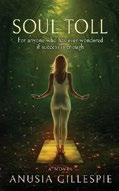
Gillespie’s supernatural tale mixes motivational ideas with fantasy elements. In an office above Boston Harbor, lawyer Ember Brooke often works into the night, following the lead of her parents, James and Cynthia, also hard-driven attorneys. Attempting something different, Ember begins yoga instructor training, but has an unsettling experience during meditation: The vision starts peacefully, but turns dark as her inner light approaches a giant prism on a mountain peak. Setting aside this episode, Ember returns to the work grind, and her parents die in a car accident. James and Cynthia’s business partner, NP Dunn, organizes their “Celebration of Life” ceremony, but Ember senses negative vibes from Dunn. Returning to her parents’ house, Ember is transported via her mom’s yoga mat to Resonance, the mysterious place she saw during her class: “a realm of pure light and creation.” There, she meets Breathers, residents who travel between Resonance and the real world, and confirms her instincts about Dunn—he controls the Prism, making it absorb, not emit, light. Those who’ve tried to challenge Dunn have failed, resulting in a population of mindless Wanderers. A discovery fuels Ember’s determination to reclaim power; with Breathers Jade (a former neurosurgeon) and Derek (a tech product developer), Ember journeys up the
mountain and into battle. Gillespie’s flowing narrative propels readers forward, buoyed by numerous engaging dialogues and simple yet smoothly constructed sentences. While readers don’t get much sense of Boston, the world of Resonance is richly imagined and described. There’s a palace made “of shimmering gold cascading from the mountain itself,” venomous shadows burst out of hovering orbs, and there’s mist “curling around the group like unseen hands.” The characters are likable (including Frank, Derek’s dog), but sometimes seem underdeveloped; for example, Ember is horrified by the prospect of infertility as a “Soul Toll,” but seems otherwise unconcerned about her childlessness, and Jade, the former neurosurgeon, is always trying to take everyone’s pulse. Ultimately, Gillespie makes a convincing case that the “woo-woo” ideas Ember initially rejects are worth pursuing.
An imaginative, genre-blurring novel.
Godoy, Manuel | Black Sands Entertainment (118 pp.) | $19.99 March 17, 2026 | 9798989884100
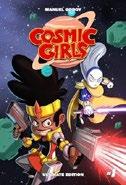
Godoy presents a middle-grade SF comic collection that follows the adventures of a 13-year-old bounty hunter and her alien companion. Corina, a war orphan, tracks criminals on behalf of the Galactic Empire of Earth, partnered with Durasi, a formidable alien from a clan of warriors. Godoy introduces the two while they’re hunting pirates, with Corina using her digihawk, a device on her wrist capable of hacking any tech with the push of a button, while Durasi fights; Corina must often remind her not to kill anyone. Deadpan humor punctuates the high-stakes missions, including Corina’s observation that “Just like in the classic movies,…the local cantina will be best bet to get a lead on the target!” The first issue is brisk and action-heavy with very little
dialogue, employing manga-influenced, brightly colored visuals, bursting with FWOOOSH!s and BOOM!s. The pace slows in the second issue as Corina and Durasi investigate, showing more of their interactions and the worlds they navigate. The narrative picks up, though, as they pursue a target named Logi Kami, with the illustrator having fun depicting alien life forms in a bar, à la Star Wars. Flashes of backstory reveal past losses, giving depth to the characters’ motivations and decisions, while quieter moments highlight Corina’s sharp wit and resourcefulness. By the end, the duo’s personalities are fully established: a clever, brave young human paired with a steadfast alien ally, confronting the galaxy’s most notorious villains. Godoy and illustrator Joshua Bullock craft a visually striking, action-packed tale that balances perilous adventure with genuine character development, showing readers not only the thrill of high-speed pursuits and clever gadgetry but also the bonds and loyalty that define the main players’ partnership. Some readers may wish for more text alongside the action, but many won’t quibble with the fast-paced action. There’s also plenty of potential for more adventures in future installments.
Fun and funny hijinks for young comic fans.
Harrison, Alan | Changemakers Books (272 pp.) | $20.95 paper | December 2, 2025 9781803419770

An exampledriven new map to success in the realm of nonprofit theater.
“What good is a program without results that show impact?” asks theatrical director and producer Harrison, a 30-year industry veteran who’s spent decades thinking about the essential questions people involved in nonprofit theater should be asking, such as, “What can my nonprofit theater do today to make my community a measurably, quantifi-
ably, and tangibly better place to live?”
In this latest installment of his Scene Change series, the author once again looks at various organizations that are pursuing what he views as the essential mission of community arts, which is to improve the community, using theater and other arts as means to that end.
Harrison contrasts this vision of nonprofit arts organizations with the way they’re too often seen by the people who run them as for-profit commercial enterprises in which box office revenue is the most important thing. In these pages, he first breaks down the logistics of how nonprofits work and should work, from the nuances of marketing to the nitty-gritty of IRS filings. The author then examines the working methods and cultural impact of some nonprofits that’ve shaken off what he views as wrongheaded priorities and are both serving and challenging their communities. The Louisville Orchestra receives a good deal of attention, with Harrison noting that “The music is dynamic, contemporary, and bespeaks the lives of the people of the commonwealth in ways that cannot be adequately described as words on a page.” He also discusses other programs, like Out of Hand Theater (“there is no better example of using theater as a tool for community impact”) and Out of Hand’s Creative Kids program (“They’re not bussed to some fancy, frighteningly off-putting monument”), in detail.
Harrison is glowingly enthusiastic about all of this, the perfect ambassador for introducing the world of nonprofit arts to newcomers; he’s also the perfect blend of cheerleader and tough-love coach for those already in the nonprofit world who may not be keeping their priorities straight (or may not quite know what those priorities should be). Harrison’s prose reflects his expertise but is often light and humorous. He can sometimes get hung up on trivialities, as when he notes that, “for a real debate to happen and to expose local and American issues for what they are, it would have to include the niggling disagreements such as how close the word ‘niggling’ is to a vulgar one.” But the author is refreshingly willing to ask hard questions about the realities of nonprofit art groups today, reminding readers that, in addition to
their missions, nonprofits have their own rules and responsibilities. Harrison’s analysis of the root of nonprofit problems— he believes they too often devolve into entities to please big donors (which “begets toxicity among donors, executives, and board leadership, and provides an elitist barrier to participants”)—is astute and characteristically pulls no punches. The author is equally frank in addressing the social issues that affect community projects, including the Black Lives Matter movement and the Covid-19 pandemic. Anyone involved in the nonprofit arts world will gain immeasurably from reading this book (and its two enjoyably opinionated predecessors).
A punchy, outspoken argument for how nonprofit arts organizations should be run.
Joyce, Samantha | Entangled: Teen (400 pp.) $15.99 paper | November 4, 2025 9781649378767
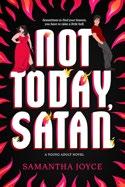
In Joyce’s YA novel, breaking a human out of Hell isn’t easy— even for Satan’s teen daughter. Devica will one day take over for her father, the infamous demon who runs the Underworld. She’d rather forge her own path, but Satan insists she hone the skills she’ll likely inherit, like conjuring fire. Devica has no sympathy for the suffering human souls (called shadelings once they reach Hell), as she only sees sinners who deserve punishment. But the handsome, 17-year-old new arrival, Nate Reynolds, catches her eye; he says he’s innocent of the murder that sent him to Hell, but, of course, many of the shadelings make similar claims. Devica, however, starts to
question her dad’s possibly flawed method of judging sin by mere sight. When Devica uncovers a startling secret about the mother she’s never known, she plans a trip to Earth—specifically, Los Angeles, Nate’s former home. He can help her get around LA if she can manage to lead a condemned shadeling across the Underworld’s four precarious cities to reach the exit. Joyce’s swiftly paced, demon-narrated tale is, in essence, a lighthearted romance. Periodic screams of agony come from the tortured shadelings, but the violence is mostly subdued and not graphic. The focus is on Devica and Nate, who develop a closeness organically as they help one another through Dante-inspired “lots” (Lot Eight: Greed). There’s plenty of entertaining wordplay, from demon “souldiers” to such expressions as, “What the here?” The serious moments are just as rewarding; readers will sympathize with Nate, who was an orphan on Earth, as well as Devica, whose friendships crumble because every demon, it seems, is terrified of her father. While the latter half leads to a predictable plot turn, there’s also abundant suspense, choices with severe consequences, and a particularly insufferable demon who makes for a great villain.
This romantic fantasy proves as thrilling as it is delightful.
Kane, Poe | Illus. by E.E. Burton Solander Press (40 pp.) | $21.99 August 14, 2025 | 9781966675273

In Kane’s picture book, a young boy is the only one in his village who doesn’t fear the nearby Spooky Forest.
A small village is nestled on the edge of a scary wilderness, where trees have red eyes and shadows move by
This romantic fantasy proves as thrilling as it is delightful.
themselves. The adults are too scared to enter it, but a boy named Leo isn’t frightened; he wants to explore the forest with his dog, Snaggle. One night, the pair wander into the woods with a lantern, walk past the glowing eyes of trees and animals, and continue on; a whispering voice in the wind says that “only the brave” can enter a secret door, which leads to an unexpected place. Burton’s illustrations have a Germanic aspect, which may remind readers of such tales as “Hansel and Gretel.” The story has some spooky elements and images that may frighten very young readers, such as a green, smirking, elven figure, revealed as the keeper of the forest, and small animals with aggressively bright eyes. However, the tale’s message is positive and light, urging readers to be kind and brave, and to be aware that not everything that seems frightening is necessarily nefarious; sometimes, even scary creatures can be silly and kind. (Leo is portrayed with pale skin; other villagers have a range of skin tones.)
An initially frightening fairy tale with an upbeat message.
Knecht, Susan | Sea Crow Press (240 pp.) $19.95 paper | October 21, 2025 9781961864320
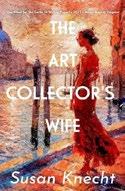
Knecht braids Holocaust survival, art-world skullduggery, and the perils of youthful defiance into a sprawling multigenerational family saga and debut novel.
Knecht’s novel begins in 1945, and the setting is Poland’s infamous Auschwitz extermination camp, where prisoner Lila Lesser miraculously carries her son Leo out alive (who is later tragically shot and killed) after the Allies liberate the camp. By the 1960s, Lila is raising her granddaughter Isabel in Venice, keeping close ties to her lifelong friend Miriam. Haunted by her husband Albert’s betrayals and
his celebrated art collection (along with its murky legacy), Lila remains stubbornly silent about the past. Isabel, restless and daring, grows determined to uncover her family’s secrets—and finds herself entangled with Niccolo, the son of a brutish upholsterer with criminal ties. Their relationship leads her into the dangerous orbit of Signor Gritti and the mysterious “Corbeau,” men whose designs on the Lesser Collection threaten both Isabel and her inheritance. Knecht situates Isabel’s adolescent rebellion against the backdrop of stolen masterpieces, forbidden romances, and Venice’s fading grandeur. The novel adroitly explores, among other themes, how memory and trauma shape survival. Lila reflects on the legacy of the art collection Albert once guarded: “‘You must show them but never sell them,’ Albert said long before the SS discovered her….And Lila hasn’t sold the art, not ever, not even to repay her business debts.” The collection becomes both burden and salvation, a symbol of promises broken and loyalties tested. Knecht excels at evoking atmosphere: At one point, Isabel imagines “willing herself and the woman and the three little dogs to be the royal subjects of a lush Renaissance painting.” Yet the beauty of Venice contrasts sharply with its underbelly of deceit, greed, and lingering antisemitism. Lila’s character, however, is the most resonant; her mixture of stoicism and bitterness grounds the narrative. Isabel’s voice, though sometimes melodramatic, captures the turbulence of adolescence. Secondary figures like Miriam and Morgenfeld add depth, embodying different modes of survival—warmth, denial, and complicity. A richly atmospheric debut that confronts how art, memory, and silence shape families in the long shadow of the Holocaust.
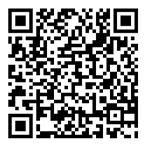
Korga, Adam | QuackFoundry Books (300 pp.) $24.99 | $14.99 paper | September 30, 2025 9783000838255 | 9783000838248 paper

For more Indie content, visit Kirkus online.
An irreverent insider’s guide to the world of IT. In his nonfiction debut, Korga, who’s “spent an alarming number of years in DevOps, Platform Engineering, and other forms of YAML-based masochism,” writes on all aspects of the IT experience, from the language of dealing with customers and clients to establishing companies to dealing with AI (“Welcome to the age of artificial everything – accuracy sold separately”). He employs thousands of single-sentence paragraphs and tables of information instead of lengthy prose to convey his own wry approach to all these aspects of the industry. A frequent theme is his wariness about the actual customers and their perception of what IT does and doesn’t do. “When technical disasters threaten mission objectives and stakeholders demand explanations, fixing issues becomes secondary to narrative control,” he writes. “You don’t fix the bug – you weaponize it.” Repeatedly, Korga presents handy tables that decipher, for example, an HR phrase (“Let’s revisit this in the next cycle”), what that phrase sounds like (“maybe later”), and its actual meaning (“never”). In all of this, sarcasm seasons the book and is often deliciously deadpan (“Finance doesn’t block your requests because they hate you,” he writes. “They block them because they don’t even remember what you do”). The author’s thoughts on the stupidity (and cupidity) of tech startups (dubbed “Startupistan”) are particularly withering. For example, “In Starupistan, the regime does not fail; it simply enters a Glorious New Phase of the Revolution .” Readers who know nothing of tech support might find
all this insider snark impenetrable, but even newbies will appreciate the chuckles.
A funny, subversively venomous look at the vagaries of IT support.
Kowey, Peter | Heliotrope Books (264 pp.) $20 paper | September 23, 2025 9781956474695

Kowey presents a collection of case studies illustrating the failures of the U.S. healthcare system. The author, a physician with decades of experience, here issues a stern warning about his profession, which, he asserts, has been “torn down and thoroughly disrespected by people who have no idea what being a doctor really means” and is consequently in danger of “falling from its lofty place in our society to a job on the assembly line, widgets replaced by patients.”
Kowey illustrates these failings with a series of stories about the problems encountered by patients experiencing the whole range of medical treatment, from unexpected ER visits to extended care for prolonged conditions. Each history is presented in great detail, followed by a “Case Explanation” and a “Conclusion” in which the author pinpoints the cause of the problems and offers some potential solutions. Readers learn about a Mrs. Lynch, for instance, who began experiencing an irregular, racing heartbeat and underwent an ablation to cauterize the arrhythmic area. But her atrial fibrillation continued, perhaps prolonged by the ablation itself, and Kowey contends that, given her otherwise young and healthy state, the ablation was “inappropriate.” In the case of 75-year-old Mrs. Lopez, the issues are more interpersonal than medical: The hospital staff is coldly indifferent, her discharge is likely early, and the
hospital’s “patient experience specialist” seems more concerned with a good rating than anything else. “It is maddening,” the author writes, “that hospital leaders have chosen to spend money foolishly on administrative salaries, worthless marketing, failed initiatives, and ancillary services that bring little value to the routine care of hospitalized patients.” As the percentage of the U.S. population that can afford health care of any kind rapidly shrinks, readers will find these stories of miscommunication and administrative bloat recognizable, and the author’s professional experience gives them extra heft.
A knowing and detailed diagnosis of some of the institutional ills of U.S. medicine.
LePan, Don | Broadview Press (184 pp.)
$29.95 paper | October 31, 2025
9780994747440

L ePan presents a collection of charming watercolor cityscapes accompanied by commentary in this retrospective of his three-decade career.
This monograph of wet-on-wet watercolor paintings features dynamic urban scenes in which light operates without conventional logic: “Broad swaths of light sweep and swoop down and across and up and away,” lending skyscrapers, bridges, and monuments “a friendly but fierce and almost otherworldly energy.” The artist’s loose, gestural approach offers a refreshing departure from the rigid linear representations that typically characterize urban landscapes. LePan’s “mind’s-eye painting” philosophy— in which visual perception mingles freely with emotion and memory— is reminiscent of artists like David Hockney, Raoul Dufy, and Oskar Kokoschka. The approach yields consistently vibrant results; outstanding examples include his breakthrough Chicago (1994), in which the Sears Tower and Merchandise Mart pulse
with raw metropolitan energy, and New Orleans (2007), which captures both post-Katrina devastation and the city’s irrepressible vitality through bold color contrasts and flowing forms. While the majority of works depict North American cityscapes and baseball stadiums—the artist’s twin passions—the collection also includes more intimate European city scenes and occasional bucolic landscapes that demonstrate his range beyond urban subjects, though the author’s text accompanying the images proves uneven. It provides valuable historical context about urban development and architectural history, enriching readers’ understanding of landmarks from the Woolworth Building to Calgary’s Petro-Canada Centre, and its insights into the artistic process offer genuine illumination for those interested in watercolor technique. However, the autobiographical framework grows repetitive, with frequent accounts of conference travels and hotel stays. Compelling personal details— family relationships, career tensions, emotional responses to urban environments—rarely cohere into insightful reflections. Readers will want to learn more about how the artist sees his personal life and experiences reflected in his work.
A volume of visually engaging work that falls short in its artistic analysis.
Levy, Francis | Cogito (220 pp.) | $24.99 October 14, 2025 | 9798992368802

In Levy’s darkly comic novel, a depraved man at the end of his rope stumbles upon a secret society that allows him to travel through alternate dimensions.
In the East Village in New York City, a man steals a french fry, gets into a fist fight, takes drugs, and has a depraved tryst with a sex worker behind a dumpster—all in the first
few pages of this debaucherous satirical comedy. Rusty, a sex-addicted man with erectile dysfunction, spends his days (and nights) pursuing demeaning, degrading sex. After a particularly haunting night spent debasing a woman named Sonya, Rusty decides to respond to an advertisement that promises to cure his erectile dysfunction. When he goes in for treatment, however, Rusty finds that the ad was actually a cover for a secretive and fantastical group called the Wormhole Society, “a secret society that uses wormholes to change people.” Availing one’s self of the wormholes comes with two risks: “losing the self and ending up lost in time.” With nothing to lose, Rusty thrusts himself through a portal (cleverly disguised as a sandwich board inside his favorite local restaurant) and hurtles through time and space. Somewhere in between masturbating in a crowded elevator on 9/11, having animalistic sex with Lucy, the first known human on Earth, and experiencing an orgasm as nothing but a subatomic particle in the Big Bang, Rusty begins to question who he is and how he can be a better man. (He also wonders if “doctors [he] saw in the parallel universe [would] be considered out-of-network.”) Via blunt, sharp prose and rough dialogue (“‘I wanted a ladyboy, but if you’re into extreme humiliation you can stay,’ I slurred as I cracked a popper and felt a wave of warmth surging through my body”), Levy creates characters both deplorable and engaging. Throughout Rusty’s obscene and otherworldly journey, the author boldly tackles topics including human nature, self-worth, and relationships at their ugliest. Not for the faint of heart, this dark comedy is “terminally unique ”— and wholly compelling.
A heinously humorous exploration of addiction and self-worth.

Manchester, Tess | Self (272 pp.) $12.99 paper | November 22, 2016 9781966920021 | Series: True Time, 1
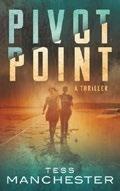
Manchester’s series-starter mixes a crime thriller with elements of time-travel SF.
When readers are introduced to Blake Everhart, she is reeling over the murder of her brother and grappling with her recent suspension from the U.S. Marshals for punching a fellow deputy. In need of an agent with her particular skill set, Blake’s superiors call her back into action to help resecure an especially dangerous fugitive named Robert Canton. The convoy transporting him goes awry, and after a pulse-pounding action scene in which Blake dispatches a crooked cop and nearly recaptures Canton, he escapes into the woods. Acting fast, Blake organizes a search and is provided with a new team—but this one comes with a “monitor” named Rivas, who’s there to make sure Blake doesn’t go off the rails again. They track Canton to the small town of Pacific, Tennessee, where Blake seeks answers at the hospital where he was treated. Once there, she is drugged by Thomas Lancaster, a doctor sympathetic to Canton, only to wake up and discover she has traveled back in time—or “pivoted,’” as the title has it—to earlier that morning, giving her the chance to “do-over” her decisions of the last few hours. Returning to the hospital, she makes an unlikely ally of Dr. Naomi Preston, who happens to be Lancaster’s ex-wife. The narrative then proceeds much in the way stories in this genre often do, with Blake discovering a criminal enterprise far larger and more sinister than anything she had previously imagined. While the plot certainly isn’t groundbreaking, it moves at a pace that makes the novel compulsively readable, and Manchester’s vivid rendering of Pacific evokes a sort of cloistered small-town setting that provides a welcome juxtaposition to the requisite action (“walking trails slither through Sugar Creek Park with the occasional wooden bench. Battered and damp, the sign pointing out each trail barely
resists the punishing weather. Deserted, the disc golf course glistens under the rain as the chains rattle with each gust”). Blake herself may have some tropey characteristics, but she displays enough individuality to carry the action in these pages with aplomb. A snappy, exhilarating first installment in a genre-bending series.
McAfee, Aaron | Self (158 pp.) | $14.99 paper | July 12, 2025 | 9798292222644
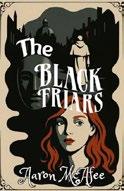
A Dominican friar gets pulled into a murder investigation in McAfee’s mystery novel. A woman is found dead in Oxford, England, and she is much on the mind of Father Thomas, a Dominican friar at a monastery near the location of the body. At first, her death appears to be the result of suicide, but Father Thomas hears a confession from a man who confessed to drowning her— but he leaves before the friar can get a good look at him. Father Thomas enjoys walking around Oxford and frequents pubs where students and faculty hang out. He befriends a student named Rita and enlists her help in solving the mystery of the dead girl, though he doesn’t initially reveal the source of his investigation. Father Thomas visits the crime scene and finds a pagan symbol carved into a tree, and suspects it’s related to the murder. A detective comes to the monastery and confirms the confession—someone drowned the dead woman, who had similar pagan symbols branded onto her body. Father Thomas stays quiet about the confession, choosing instead to focus on the symbols. As he puts the clues together, Father Thomas begins to believe the dead woman was some kind of ritual sacrifice, and that the symbols may be connected to a secret society at Oxford called The Butlers. After the discovery of another body, Father Thomas fears he’s stumbled into an even greater mystery—which he resolves to unravel himself. The novel is short and well-paced, with a narrative that brings to mind works like The Name of the Rose (1983), with its focus on the protagonist’s
faith and the way Father Thomas wrestles with modernity and grief (“at times I wondered whether my faith in God was rather a distrust in myself”). There is an air of detachment to the story, perhaps because the key to the mystery lies in the odd symbols Father Thomas keeps finding; he doesn’t realize he is in danger until it is too late. The end is a bit of a gut-punch, but overall, it’s a gripping story. A lyrical, compelling mystery.
Mercurio, Peter | ACE Doe (258 pp.)
$19.99 paper | June 3, 2025 | 9798992637328
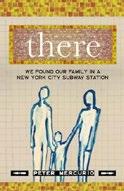
In Mercurio’s memoir, a gay couple’s lives change forever after one of them helps to rescue an abandoned child.
On August 28, 2000, New York City-based social worker Daniel Stewart found a baby boy, alone in a subway station. Instead of ignoring and walking past the child, as others were doing, he called 911 to get help. Mercurio, who worked at an advertising agency, was Stewart’s boyfriend at the time, and this incredible first-person account documents the mind-blowing surprises, coincidences, and moments of sheer luck that led to the men to adopting the baby and giving him a loving home. It’s a must-read for anyone who’s been told that a home is incomplete without a mother and a father—and for anyone who holds such a view: “The trappings of a ‘women do this, men do that’ mindset didn’t apply to us,” Mercurio writes at one point. There’s much to learn from the author’s candid account of his initial doubts about becoming a parent, and the open communication between him and his partner. It’s also moving to read about how professionals at the family court and the adoption agency always prioritized the baby’s best interests, and how friends and family members chipped in to help the
couple. The book does a splendid job of tying the personal to the political by weaving legal developments related to marriage equality and adoption into the narrative. The couple are white and their adopted child is a person of color, and Mercurio is open about the various challenges that their son faced because of his peers’ curiosity about their unconventional family. The author’s background as a theater producer, director, and playwright also helps him to craft tense moments that will keep the reader hooked: “The idea of my northeast, liberal, Catholic, and gay rights-advocating parents hosting his Bible-belt, conservative, Southern Baptist parents made me anticipate a potentially long and uncomfortable weekend.” However, there are plenty of funny moments, as well, that effectively relieve the intensity.
An engaging celebration of queer joy and diverse families.
Mulvahill, Karen | EnvelopeBooks (296 pp.) $18.95 paper | March 7, 2025 9781915023582
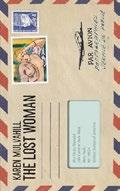
In Mulvahill’s debut novel, a socialite/philanthropist hires an art historian/detective to retrieve paintings that Nazis pilfered from her family’s Paris art gallery during WWII.
Nicole (née Cassin), the protagonist of this labyrinthine tale, was an outspoken Parisian girl who hated the occupying Nazis with a passion. The Cassins were Jewish, so it was only a matter of time before the Nazis took away her father and her mother. Despite the Gestapo’s constant presence, Nicole continues to work at the family gallery, now “Aryanized” and run by a small-time opportunist. The German occupiers are initially polite, but soon the brutality surfaces, which prompts Nicole to join the French Resistance. Eventually, the novel turns into a tense nail-biting thriller: Can she keep her membership
in the resistance a secret until the arrival of the Allied liberators? Meanwhile, in a postwar flash forward, decades later, art historian/sleuth Robert Ames, hired by Nicole, has managed to locate her former GI lover, Sam Popinski, in a Detroit retirement home. The interview does not go well, and Popinski dies that very night. But the real bomb drops when his son, seeing a snapshot of Popinski before his enlistment, says, “That’s not my father!” But there is an upside: At the retirement home Robert meets young staff psychologist Amy Wexford, and they soon become not just a team of sleuths but lovers. Do they recover the stolen paintings? Well, thanks to modern computer databases, Robert’s expertise, and Amy’s pluck, the search is not as hopeless as it might seem.
Mulvahill has a visual art background, which she uses to good effect throughout. She is also an imaginative writer capable of turning an original phrase now and again (a village’s destruction had been “meaningless as a domino to be toppled on the way to a pyrrhic victory”). In some ways, the Popinski subplot is even more intriguing than the search for the paintings. When it first begins to seem that there must be a lifelong Popinski imposter somewhere in the bosom of his family, the reader might wonder: How in the world is Mulvahill going to pull this off? We do find out that Robert came by his calling honestly, because his beloved grandfather had not only been a museum curator but also one of the Monuments Men at the tail end of the war, resulting in some moving vignettes and reflections on the futility of war. Robert is also a credible (if secretive) artist, and Amy encourages him to come out of the closet, as it were. The philosophy of art looms large all throughout the novel: Should it be valued as product or process? What about the venality of art dealers and collectors? At one point, Robert and Amy have a playful discussion about the value of a work of art versus a human life (to his credit, Robert says that no work of art is worth a human life). But later on, we find out that Robert and Amy’s silly parlor game prefigured a real and tragic choice that Nicole inadvertently had to make.
An ingeniously plotted fiction debut with well-drawn characters and plenty of historical depth.
Kirkus Star
Reid, William T. | Wren House Press (246 pp.)
$16.99 paper | September 12, 2025
9781967115174
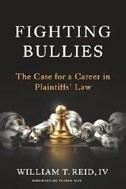
Reid sounds a call for passionate lawyering and issues a stern assessment of the modern U.S. legal profession. In his nonfiction debut, the author, a trial lawyer and former federal prosecutor, opens stark and strong: “Everything you’ve been told about being a lawyer is wrong.” He examines the negative press that tort reform has garnered over the years, characterizing it as a product of “corporate money and self-interest,” which Reid calls “propaganda.” Tort reform, per the author, has therefore led to changes that hurt ordinary people; “along the way, it’s poisoned the public perception of plaintiffs’ lawyers as well.” Reid aims to offer a corrective alternative in which the two typical goals of those attending law school—either landing a spot at a prestigious law firm or a job as a virtuous public defender—are understood to be far from the only or even the most attractive career choices for aspiring lawyers. “You don’t have to choose between making a difference and making a living,” Reid writes; you can choose plaintiffs’ law instead. He describes the standard funnel into which law students get sucked, starting with the on-campus interview, leading to law school (where, the author points out, most of the professors have never practiced law), and then to what he describes as “BigLaw” with little or no information given to other possibilities. Avoiding this “vicious cycle” can be done, but it’s tricky, and Reid is here to offer a road map. The centerpiece of his book is his advocacy for practicing plaintiffs’ law, which, he states, “laid the foundation for the modern Western world and America.” Though Reid passionately makes a case for this much-maligned branch of the profession, the book’s most memorable feature is its withering
condemnation of BigLaw, where the author describes awestruck clerks getting invited to partners’ homes where “they will sip cocktails … looking out over a lake, and earn more in a week than they’ve earned in a month.” This pitch-perfect scorn will likely convince more readers than the book’s central argument for finding a middle way.
A knowledgeable and compelling opinionated X-ray of the modern legal machine.
Reigns, Steven | Moontide Press (100 pp.)
$20 | $16.95 paper | September 30, 2025 9781957799360 | 9781957799377 paper
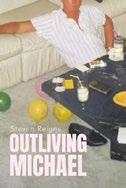
Reigns remembers a late friend in this bittersweet poetry collection. “I’ve outlived so many / of the men in my life,” the author writes. “The most painful has always been, / will always be, outliving Michael.” The book opens with an image of Michael as a Studio 54 bottle boy, “strawberry-haired, sweating, in / a white T-shirt, bar rag in his / low-slung jeans” on the dance floor. Readers learn that Michael, a quick-witted travel agent, was a deeply empathetic man, “a connoisseur of / crass and camp” in the drag community, and that he had a penchant for Judge Judy. The poems bounce around in time, evoking memories of Michael when he was “energetic, alive, and we / felt like there was nothing but time,” as well as after “The virus had crept in, betrayed his body. / robbed him of his looks, / held hope hostage, / murdered his lover, / absconded with his future.” HIV / AIDS haunts many other poems here as it claims friends and lovers alike. Reigns also shares turning points in his own sexual identity journey and his experiences with aging, survivor’s guilt, and grief as he continues “diving and forging into the past, / trying to bring every scrap of Michael / back to the surface.” The author paints a vivid, loving portrait of Michael in this heartbreaking and subtly humorous poetry collection. The vignettes are
intimate and endearing; after experiencing hair loss, Michael remarked to a young neighbor with cancer, “Looks like we go to the same barber.” The poet effectively conveys youth through a mature vantage point in lines like, “We were young, tough, defiant, laughing / in the face of death that was laughing back at us.” The book’s only flaw is its brevity; readers will want more time with the charming, enigmatic Michael, as well as with the author, whose backstory is hinted at but not fully fleshed out.
A tender and touching elegy that ends too soon.
Reynolds, Jeffrey L. | Self (264 pp.) | $23.99 July 22, 2025 | 9798896944911
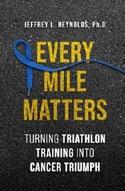
A debut author applies lessons learned in triathlon training to his battles with cancer in this hybrid memoir and self-help book. After completing his first five-kilometer race in 2010, which he haphazardly ran after a wine-fueled late night, author Reynolds was hooked. Gradually working his way through 10Ks, half-marathons, and marathons over the course of a few years, he got involved with triathlons—adding swimming in open water and high-speed bike rides to the mix. He trained with professional athlete Danielle Sullivan before completing Ironman Florida in 2021. At the time he completed the “epic race,” Reynolds writes that he was 55 years old and “in the best shape of my life.” Just months after being declared an Ironman, the author received a life-altering diagnosis: prostate cancer. Part medical memoir, the book surveys his treatment and victory over cancer, only to be diagnosed soon thereafter with advanced colorectal cancer. Reynolds felt that “endurance sports prepared [him] for cancer,” and he applied many of the same techniques used in endurance races to his treatment, such as persevering despite
physical pain and mental fog. The book blends engaging autobiographical vignettes, including the author’s work with HIV and AIDS patients in the early 1990s and nonprofit health and human services initiatives as CEO of Long Island’s Family and Children’s Association, with pragmatic wellness advice for readers, particularly those diagnosed with cancer. “Becoming more intentional about small mindset and lifestyle shifts,” he writes, “can dramatically alter the quality and quantity of your days.” These lifestyle shifts include balancing regular, but sensible, exercise with physical, mental, and social rest. Other tips include embracing gratitude and building a team of loved ones and friends whom you can trust as you endeavor to “make every mile matter.” With a Ph.D. from Stony Brook University’s School of Social Welfare, Reynolds bases his claims on researchbacked best practices; the book includes scholarly references.
An accessible, well-researched guide to applying the lessons of endurance training to battling cancer.
Rowen, Andrew | All Persons Press (454 pp.) | $34.95 | November 10, 2025 9780999196168
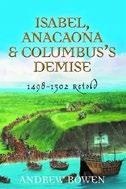
Rowen’s latest historical novel in a series offers a fresh, scholarly perspective on Christopher Columbus, focusing on his interaction with the Taíno peoples. With a plethora of controversial accounts of Columbus on offer, it’s easy to feel discouraged when picking up a new title about the era in which he lived. However, in this work of historical fiction, Rowen brings a fresh, inviting viewpoint on “the last years of Columbus’s governance and the initial rule of crown-appointed successors, from 1498 to 1502.” This narrative has the same scholarly weight as his previous two works—Encounters
Unforeseen: 1492 Retold and Columbus and Caonabó: 1493-1498 Retold —but can just as easily be read as a stand-alone. Immediately upon its opening, the author situated readers in the history of Columbus and the Taíno people with a sizable maps and notes section. The story is told through the perspectives of Anacaona, the perceptive, widowed sister and adviser of the Taíno leader, Behecchio, who must negotiate with Spanish colonizers; Spanish Queen Isabel of Castile; Adm. Cristóbal Colón (aka Christopher Columbus); and other leaders, enslavers, and enslaved people on both sides of the Atlantic. The book lays out the political intrigue and terrible violence that various characters encountered around the time of the brutal subjugation of Española (later known as Haiti). Throughout, quick bibliographic notations mark actual events, and the narrative frequently pauses to insert engaging historical clarifications, and an extensive source list is included at the end. Over the course of the novel, Rowen’s writing is clear and easy to read, despite the dense material, and can be enjoyed by laypeople looking for an engaging up-to-date perspective on this time period, or by scholars, who may appreciate the surface-level fictionalized narrative or a deep dive into the bibliographical contents. Despite all the exposition, the dialogue consistently flows well, which makes for an enjoyable, educational read; illustrations from multiple sources add substance and familiarity to lesser-known aspects of the past.
A refreshing, well-informed take on a less well-known period of history.
Serrano, Kim | Self (352 pp.) | $9.99 paper June 12, 2025 | 9798285418122 | Series: The Black Box, 1

In Serrano’s thriller, an aviation official contends with a potentially careerending conspiracy while desperately attempting to resist her attraction to a hotshot pilot.
Aurelia “Morgan” Delgado is dedicated to her job as Fleet
Director of U.S. Operations for Heritage Airlines—so, after a wild night with the ruggedly handsome pilot Kieran O’Hara, she does her best to put him out of her mind. But as the two get thrown together more often (both by happenstance and design), cracks begin showing in their defensive walls; Morgan struggles to recover from a relationship with an emotionally abusive ex-boyfriend as Kieran desperately attempts to help his depressed, college-aged kid, and the two become closer despite their determination not to. The possibility of making their complicated potential romance work seems to vanish when Morgan stumbles upon a conspiracy by Heritage Airlines to suppress information about serious mechanical issues affecting their newest airplane model. With only a handful of allies, including loyal friends from work and Kieran himself, Morgan’s crusade against a multi-million dollar airline seems hopeless—especially when it turns out that the airline’s scapegoat is Morgan herself. Serrano has crafted an intricate workplace thriller that focuses less on whether the company is guilty (it is) and more on the heroic underdogs’ efforts to take down the bad guys. Intermittent scenes of fairly graphic sex between the two very attractive leads reliably spice things up when the legal battle gets too heavy. While the staccato prose more than serves the story’s purpose, it can feel a bit abrupt at times: “She didn’t flinch. She didn’t engage. She let them talk until the air burned itself out. One hand around her coffee mug. The other flipping through the file like her own name wasn’t printed on the final page.” Morgan and Kieran are clearly two peas in a pod, with their fierce independence masking their respective emotionally traumatic backstories. Serrano’s skill is evident as the author makes readers care about the leads as fully fleshed out characters while still keeping the romance aspect at full throttle.
A scorching thriller that expertly balances steamy romance with corporate intrigue.

For more Indie content, visit Kirkus online.
Adélaïde: Painter of the Revolution
Strube, Janell | Acorn (491 pp.)
January 13, 2026 | 9798885281362

A fictionalized rendering of the life of Adélaïde Labille-Guiard, artist, feminist, and French Revolutionary. All Adélaïde had ever wanted was to be an artist. She began sketching as a child, and by the time she was a teenager, she aspired to one day see her paintings for sale in the Salons of the Louvre. On her 15th birthday, her mother, Marie-Anne, considers it time for the burgeoning artist to find a husband, a prospect that repels young Adélaïde. Fortunately, her father, Claude Labille, agrees that she was too young to marry, and later, he gives her a birthday present beyond her dreams: art lessons with their neighbor, Monsieur Vincent, an accomplished artist of miniature paintings. The year is 1766, and Adélaïde learns her way around miniature canvases and the Parisian commercial art world—where female artists aren’t typically welcome. Also working in Monsieur Vincent’s studio are his sons, François, the eldest of the two, and Alexandré. François will become the love of Adélaïde’s life, although their relationship will be fraught with obstacles and pain. In 1769, Adélaïde gains entrance to the Academy of St. Luke, a guild under whose license she is permitted to sell her paintings. But joy mixes despair. She must now honor a deathbed promise to her mother and marry the cruel aristocrat, Nicolas Guiard. Strube’s novel explores Adélaïde’s struggle to achieve independence and recognition as an artist, her relationship with Guiard, and her resultant poverty. It also examines how she secured sponsorship from members of the royal family and her support of—and later betrayal by—the French Revolution. Part romantic drama and part detailed history of the revolution, the novel depicts the plight of women of the era, with Adélaïde and her artist friends and students leading the charge to confront the legal and social barriers to equality. Strube’s engaging prose also captures the intricate subtleties of fine art, from the mixing of
paints and preparation of canvases to the portrayal of light and texture with extraordinary realism. Rich with historical detail and helmed by a formidable female protagonist.
Tourtelot, Emma | She Writes Press (256 pp.) | $18.99 paper | January 20, 2026 9798896360483

In Tourtelot’s novel, when a teenager’s grief over her best friend’s sudden death collides with her mother’s curated online persona, a family begins to unravel.
Told through the dual perspectives of Indie, a sharp and wounded teenager, and her mother, Kate, a real estate agent and lifestyle blogger, this novel explores themes of loss, belief, and the shifting ground of identity. The story opens with Kate driving frantically along the Taconic State Parkway, fearing for her missing daughter, Indie. From there, the narrative rewinds to the months following the sudden death of Indie’s best friend, Maddy, a loss that shatters Indie’s sense of safety and belonging. Indie’s grief takes the form of withdrawal and obsessive searching— into conspiracy theories, online gurus, and altered states of consciousness—as she struggles to make sense of life after Maddy. Meanwhile, Kate tries to hold her family together. She writes curated, witty posts for her online column (“And that’s how the sausage is made, folks”), projecting control and confidence to her readers while privately unraveling. Her marriage to Ethan deteriorates under the weight of unspoken resentments, while her connection to Indie falters as she fails to bridge the gap between her daughter’s anguish and her own pragmatism. As Indie flirts with dangerous influences online and in person, Kate confronts her own illusions about family, community, and marriage. By weaving together the mother’s and daughter’s perspectives, Tourtelot captures both the rawness of grief and the barriers to communication across generations. The
author excels at rendering the textures of small-town life, the absurdities of online performance, and the interior chaos of grief. The dual points of view and inclusion of blog posts, text messages, and other forms of media add richness to the text. Indie’s chapters feel raw and vulnerable, much like her teenage self; Kate’s chapters can at times feel overly polished, but this reflects the online persona that she has carefully manufactured. The pacing occasionally meanders when Indie’s philosophical digressions risk growing repetitive, but the short chapters generally keep the action moving.
An emotionally honest and captivating story about grief, family, and the stories we tell in this digital age.
Wesorick, K.A. | Self (252 pp.) | $14.99 paper | March 18, 2025 | 9781967441242
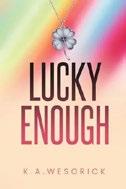
In Wesorick’s YA novel, an awkward teenager’s life changes for the better after she receives a piece of jewelry that appears to bring her luck.
Rebecca “Becks” Lewis is kicking off her first year of high school, and for this anxious, insecure teen, it’s a less-than-magical experience right from the start, when, after meeting up with her best friend, Trina, she realizes that her choice of outfit is all wrong: “Trina is wearing an army green vintage t-shirt and ripped jeans that just scream ‘cool girl’, and I’m over here in a unicorn dress that screams ‘middle school.’” Both girls have their hopes set on making the high school’s super-competitive dance team, whose members include their pal, Ally, but Becks feels like she can barely walk down the hallway without tripping over her own shoelaces. Add in a mega-crush who may or may not know that she exists, and upperclassmen who treat freshmen like free entertainment, and you’ve got the makings of a chaotic year. Then Becks’ grandfather gives her a four-leaf clover necklace, and, suddenly, things start looking up. Out of
nowhere, opportunities appear, and it feels as if the universe finally heard her wishes. The real mystery, though, is whether the necklace is truly magical or simply gives Becks the confidence she needed all along. Many young readers will find Becks’ struggles with insecurity to be relatable as she navigates the trials of adolescence, young love, and shifting friendships; she also encounters mentors who encourage her to claim her place in the world. The story explores self-doubt and the dangers of self-defeating thoughts with sensitivity and insight. Although the plot is somewhat predictable, the prose’s simple, straightforward quality effectively highlights the depth of the characters’ emotions. Readers will witness Becks’ gradual growth as she overcomes disappointment, sets boundaries, and confronts her fears.
A thoughtful glimpse into the everyday challenges and joys of growing up.
White, Mary Vensel | Type Eighteen Books (220 pp.) | $18.99 paper | November 11, 2025 9798992040579

White’s short stories observe everyday people at turning points in their lives.
The pieces that make up this collection provide revealing looks into the lives of their characters and quickly establish a sense of immediacy. In the title story, a highpowered architect fails to recognize signs in his own home indicating his relationship is failing (“She had ways of hiding things she didn’t want him to know about”). In “Cadmium,” a young man attending his mother’s second wedding learns to recognize her as a person separate from his relationship to her, and they begin to mend the damage she did to their relationship when he came out. In “Smoke,” a woman reckons with the remnants of her abusive marriage as her life literally burns around her. In the closing story, “What You Know,” an
aspiring writer can’t seem to write his way past his parents’ tragic deaths. While the narratives in the stories are disparate, the overall theme of growth amid turmoil unites the collection. The writing is compelling and personal, quickly drawing readers into each entry with robust, fully fleshed-out characters. Although intriguing, “The Love of Your Life Show,” which follows a woman on a dating game show, feels out of sync with the other stories—the slightly off-kilter, alternate-reality feeling of this story doesn’t mesh with the quotidian yet profound nature of the rest of the collection. Most of the stories are well-paced, although “Par Avion,” in which an older woman takes off for Greece without telling her children, could have imparted the same message more succinctly. The stories flow neatly into each other, with the intimate atmosphere providing an underlying commonality to the otherwise unconnected characters. Similarly, each narrative builds to a crossroads—some dramatic and some much more muted—and provides an effective hook to grab the reader’s attention.
A quiet but captivating collection of stories with an affecting view of the commonplace.
Wieland, Liza | Livingston Press (274 pp.) $19.95 paper | September 22, 2025 9781604894110
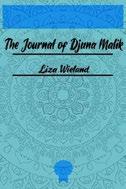
Violence rends an Indian American clan in this plangent saga of family, migration, and estrangement.
Wieland’s narrative opens with the murder of Djuna Malik, an Indian American freshman at the
University of North Carolina at Chapel Hill, and her two housemates by a racist man who lived down the street. Mourning her are her much older sister, Nisha, who raised her after their parents were killed in a terrorist attack in Mumbai, and her Lit professor, Liam McFadden, who feels she’s a talented writer and shows her class writings to Nisha after toying with the idea of plagiarizing them as material for his own novel. Liam and Nisha bond over Djuna’s journal and begin an affair. Nisha tells her own story to Liam, which includes her rape by an American youth in India, which led to further tragedy when her vengeful Indian lover at Harvard accidentally blew up himself, his brother, and uncle, with a bomb intended for Nisha’s attacker. She also ruminates on her tense marriage with Michael, a depressed white man with lots of guns and seething resentments. Meanwhile, Liam is wrestling with his own past growing up in Ireland. His father, a famous novelist, was so enraged that Liam’s mother published her own novel that she never finished another one, and he also plagiarized the work of Liam’s brother, Shamus, a talented and volatile poet. After he dropped dead of a heart attack during an argument with Shamus, more tragedy followed. Throughout, Nisha and Liam ponder the dead, while Nisha untangles yet more fraught relationships with Felicity, a friend and also the mother of Djuna’s killer, and Jamie, a troubled friend of Djuna’s.
Wieland’s novel works with big themes, including the experience of Indian immigrants eager to pursue the American dream but subject to racist affronts from microaggressions to homicide, and the problems of the story’s many angry men, with a first-term Donald Trump being a distant, presiding spirit who haunts the characters’ anxieties. It’s also an atmospheric portrait of the modern university, capturing the classroom torpor, the energetic zeal of its protest culture, the flurry of squabbling and empty-nest sorrow that surrounds Nisha’s relationship with
A harrowing tale of loss and remembrance.
THE JOURNAL OF DJUNA MALIK
Djuna as she leaves home, and the central role that prestigious degrees play in shaping the identity and self-esteem of the professional classes. (Djuna is distraught when her dream colleges reject her and she must settle for Chapel Hill, still one of the best schools in the country.) These are big themes, and Wieland explores them with psychological nuance and exactitude in prose that sometimes has a lyrical stillness and other times opens out into harsh, raw feeling (When tragedy strikes, Nisha’s “wailing afterwards was so loud and so long it seemed the sound came from the hospital building, out of the walls and floors, the drywall, the pipes, the wiring, the invisible Internet signal”). Wieland handles this sometimes unbearably dark material with evocative writing that packs an emotional wallop.
A harrowing tale of loss and remembrance, often bleak but also lit with a hard-earned wisdom and grace.
Wilson, Bill C. | Self (264 pp.) | $15.99 paper August 9, 2025 | 9798998873010
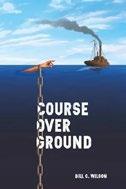
Wilson offers an American Civil War novel set on the high seas. The conflict between the Union and the Confederacy is now in its third year, and social and economic costs are accumulating on both sides of the battlefront. As supply chain issues limit Union boat production and the Confederate government seizes private watercraft for the war effort, Sims & Gordon Shipyard in Mobile, Alabama, must shift its focus from boat manufacturing to ferrying loads for the Confederates. Alan Chambers, the anti-slavery head supervisor of Sims & Gordon, finds himself piloting the recently built Azalea on her maiden voyage to her new owners in Glasgow. He soon realizes he has more than Union blockades in the waterways to worry about; when Confederate agent Tom Sable boards the ship on secret, official business,
Chambers begins to suspect that something other than cotton is in the ship’s holds. Meanwhile, at home in Alabama, Chambers’ daughter, Josephine, and her maid, Anya, encounter a riot that suddenly turns violent, and Anya is abducted. Battling storms on and off the ship, Chambers and chief mate Hilt O’Callen must risk their lives and work fast to unravel a web of lies and deceit, before it’s too late for them and for Anya. Over the course of this historical survival story, the author offers insight into life during a tumultuous period. Wilson uses his experience as a career merchant mariner effectively, ably braiding technical naval details into the storyline: “The implementation of iron in ship construction brought with it a significant impact on the marine compass, as it could interfere with the compass’s internal magnets and cause it to deviate from a true reading.” This experience adds legitimacy to some of the more nuanced aspects of travel on international waters, allowing readers to trust the narrative and fully immerse themselves.
A dramatic tale that effectively blends maritime adventure with an exploration of justice and human resilience.
Zhang, Allison | Self (166 pp.) | $16.50 paper July 18, 2025 | 9798999585707
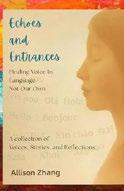
Z hang, a Chinese American writer and the founder of a nonprofit that assists Englishlanguage learners, explores “what it means to live in translation” in this multi-genre work.
Drawing from her own experience and that of other ELLs, the author considers how ideas of language and self interact with concepts of home, school, and society at large. The book’s first part focuses on living, speaking, and dreaming across languages through poetry, fiction,
and stage plays. Poems such as “Field Guide to Survival in English” and “Glossary for the Newly Displaced” capture the tension of straddling cultures. “A Fictional Portrait of Immigrant Fluency ” is an endearing snapshot of a man who’s diligently learning what terms like “run an errand” mean with his daughter’s help. Shame about using imperfect English is a recurring theme: The speaker of “The Language Between Us” describes rewriting her mother’s notes to teachers and editing her mother’s texts before forwarding them on. A series of “Search History” poems reveal what multiple family members are Googling, such as “how to understand my daughter’s jokes,” and “can school punish if parent makes mistake in form.” The book’s second half widens the scope, analyzing legal and systemic factors affecting ELL students through essays and interviews, but it’s dry and academic compared to the rest of the book and lacks emotional impact. The epilogue includes a letter in which Zhang tells her younger self, “Just don’t give up.” At its best, Zhang’s lyrical language often cuts to the core of the immigrant and ELL experiences in lines such as “In our apartment, the walls were made of air and disappointment. / You could hear other families loving each other louder. Our / family loved in lowercase, in leftovers.” Her experimen-tation with form is also bold and effective in pieces such as “What We Google Instead of Ask,” framed as a group chat interspersed with searchengine queries. Her compassion for ELLs is also evident throughout: “Child, / are you listening? / The most beautiful part / of your voice / is the part you thought was wrong.” An often powerful depiction of learning a new language.

For more Indie content, visit Kirkus online.


B





Your patrons don’t want to wait – and neither do you.
IngramExpress® ensures you get the books you need when you need them.
IngramExpress Benefits
In-Stock inventory
Fast, free shipping
Order from any distribution center
No order or shipment minimums
Competitive discounts
Discover IngramExpress at ingramcontent.com/express

Sign up Today: Save up to 40% on books over $16.99 through January 31, 2026.